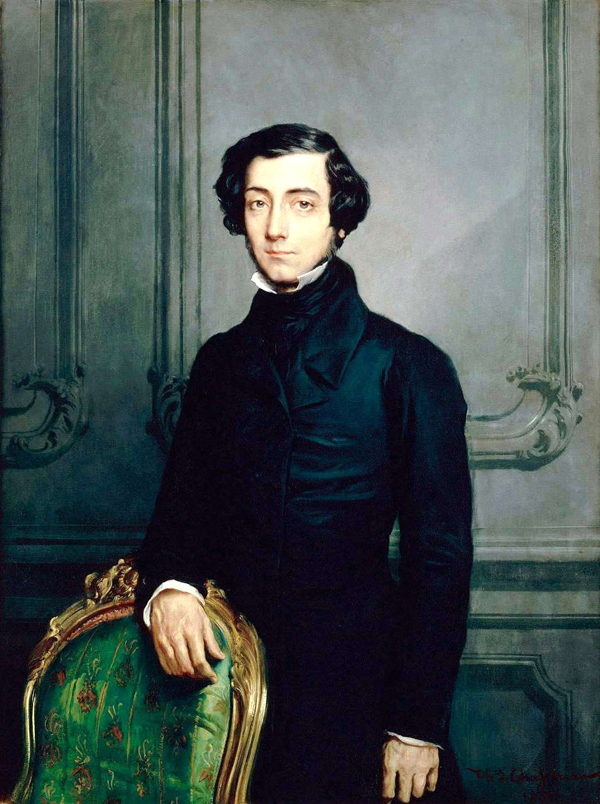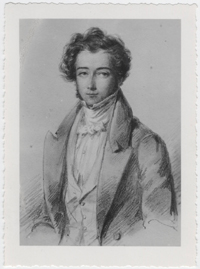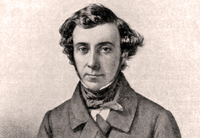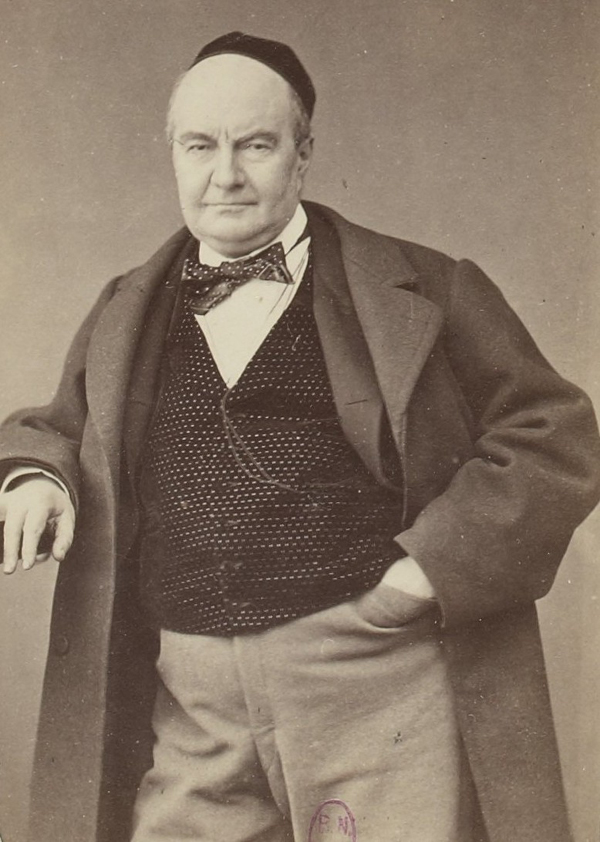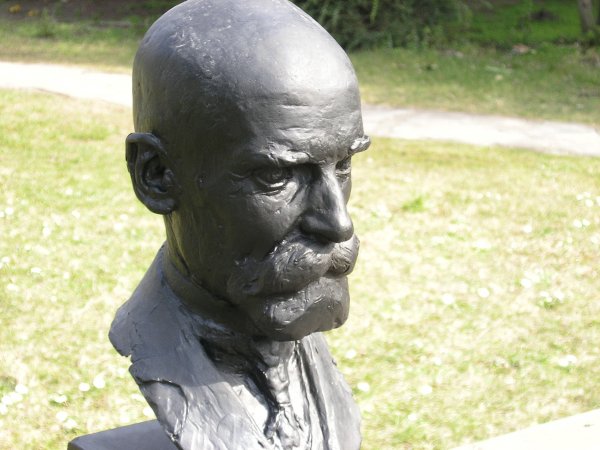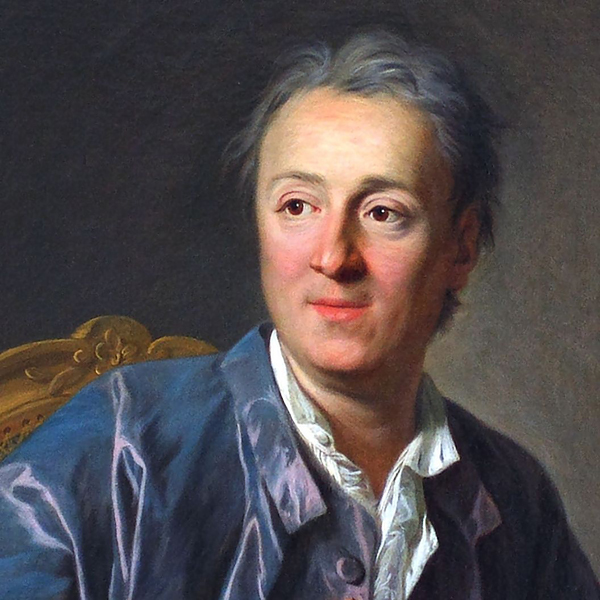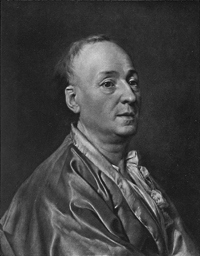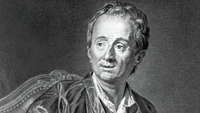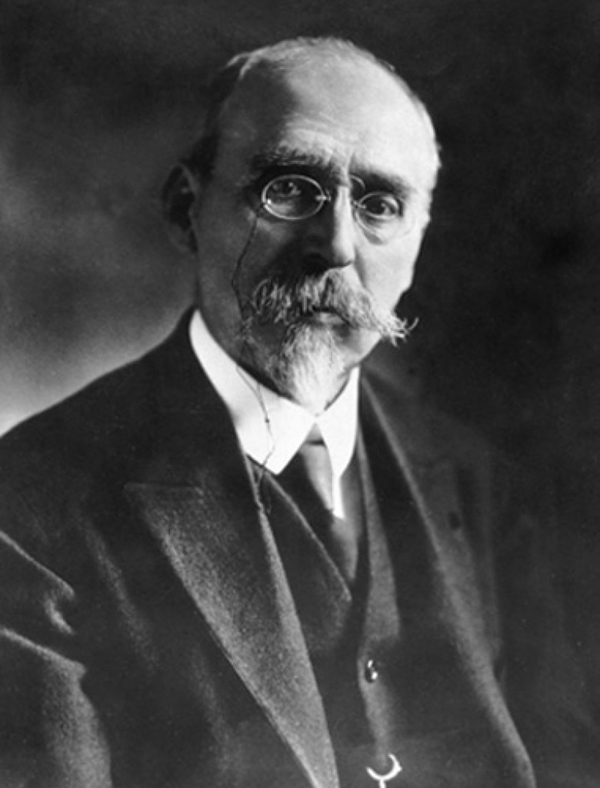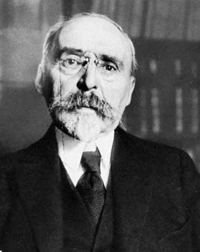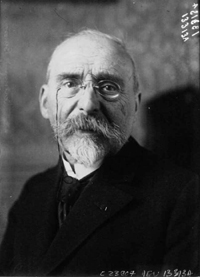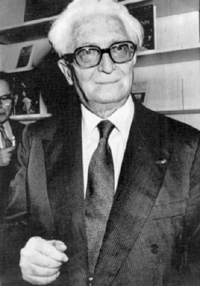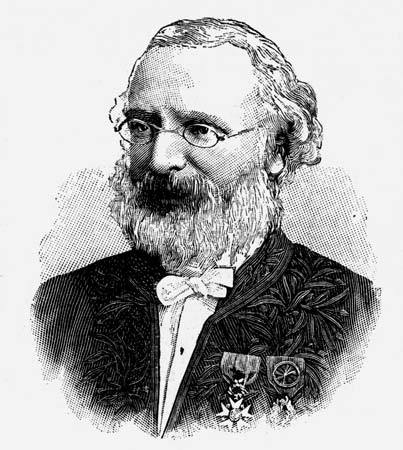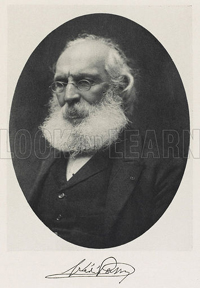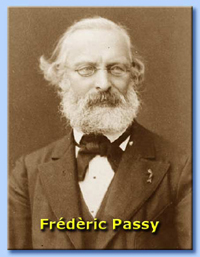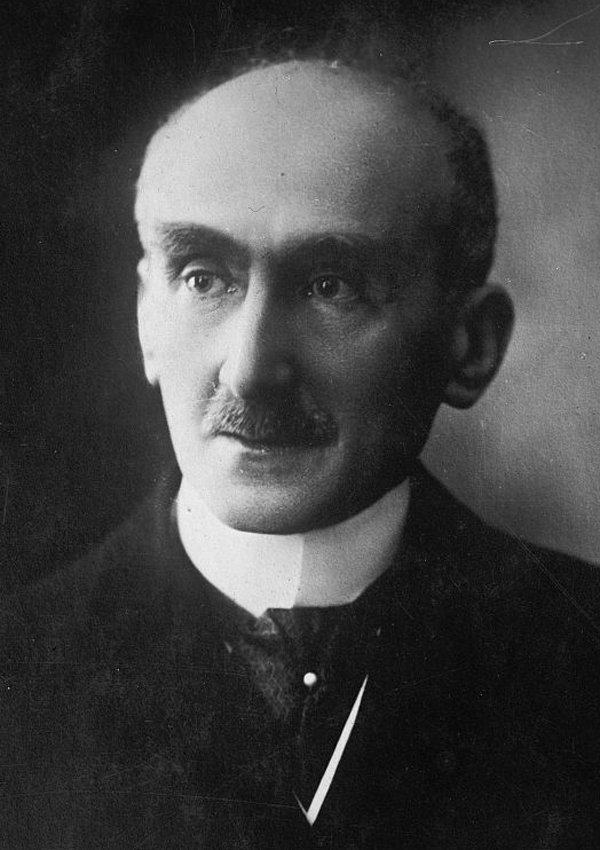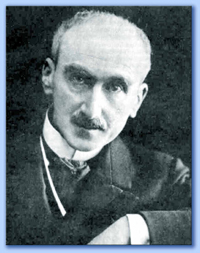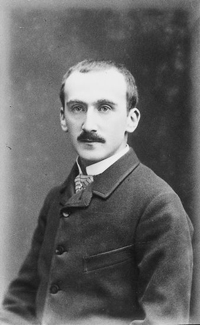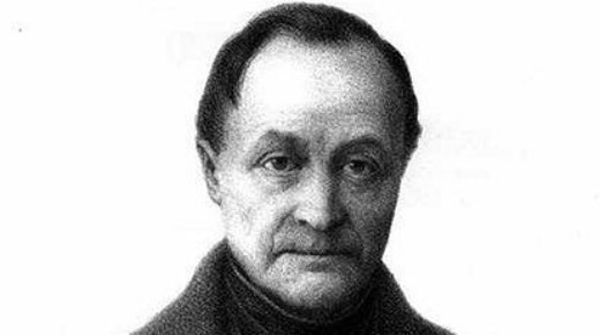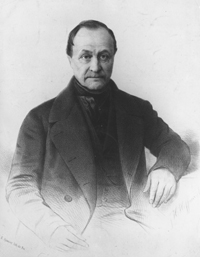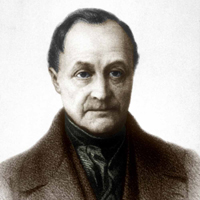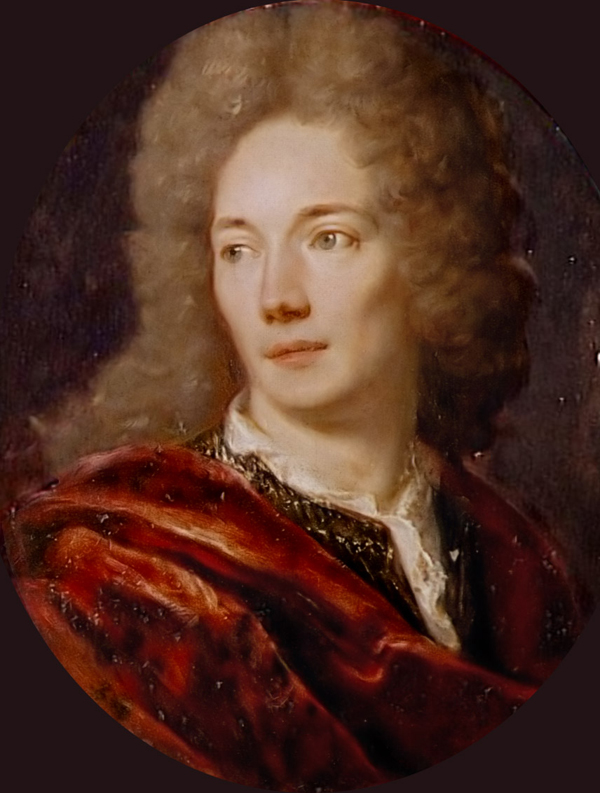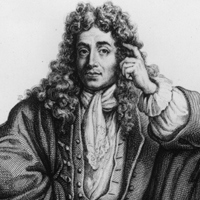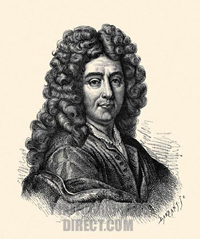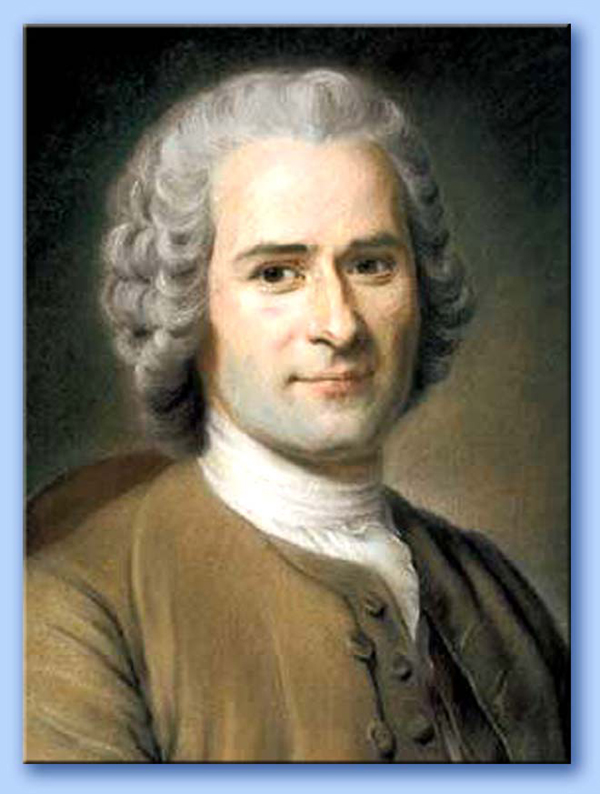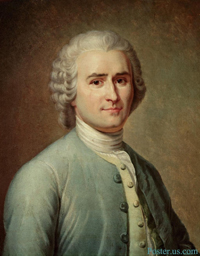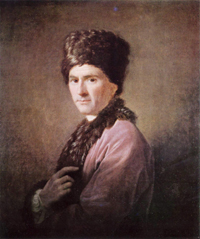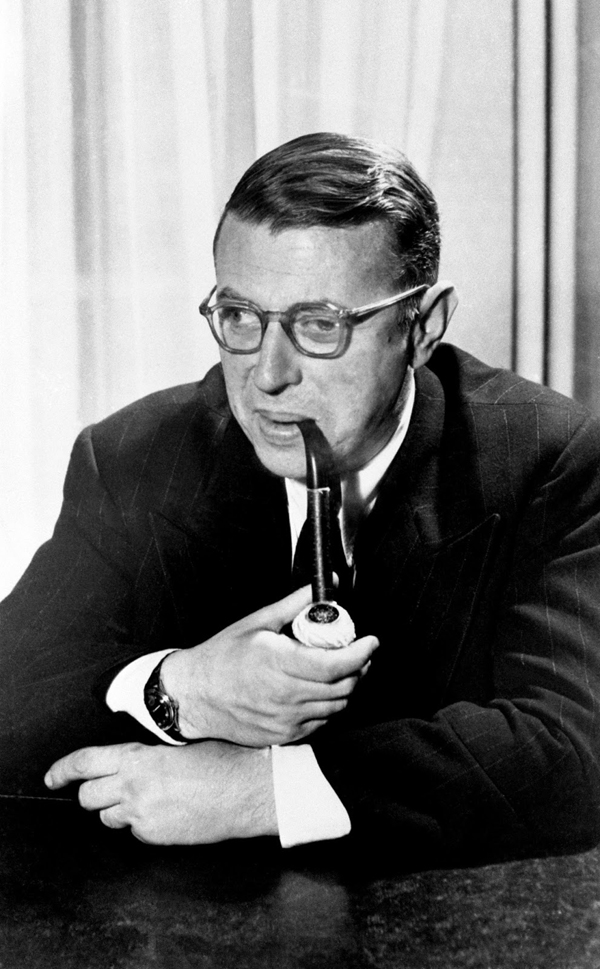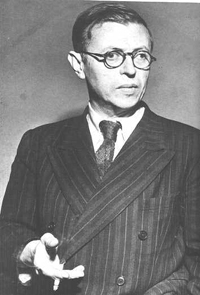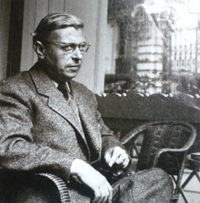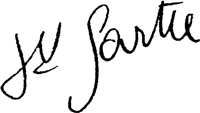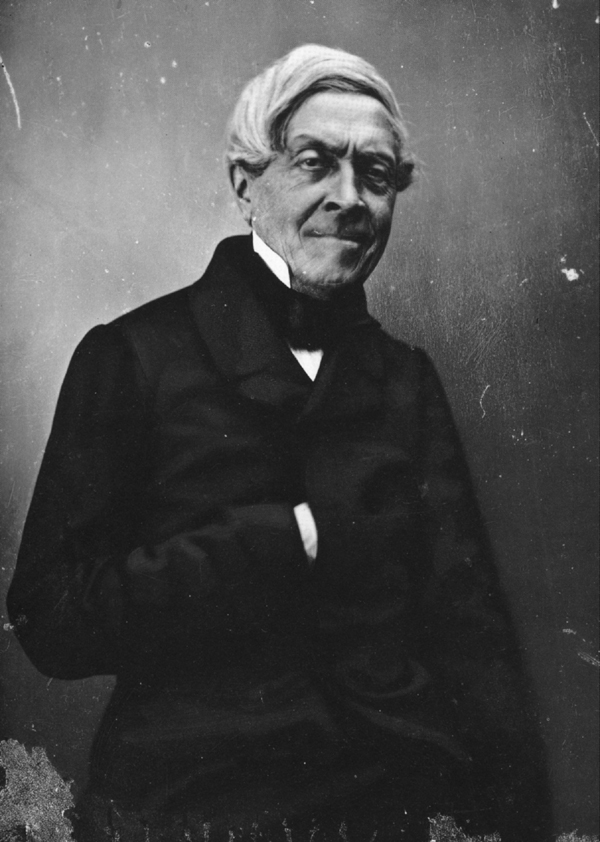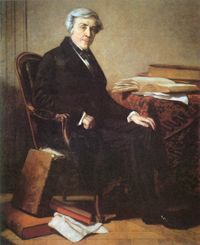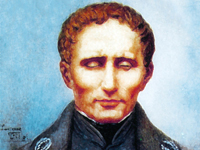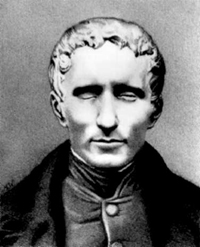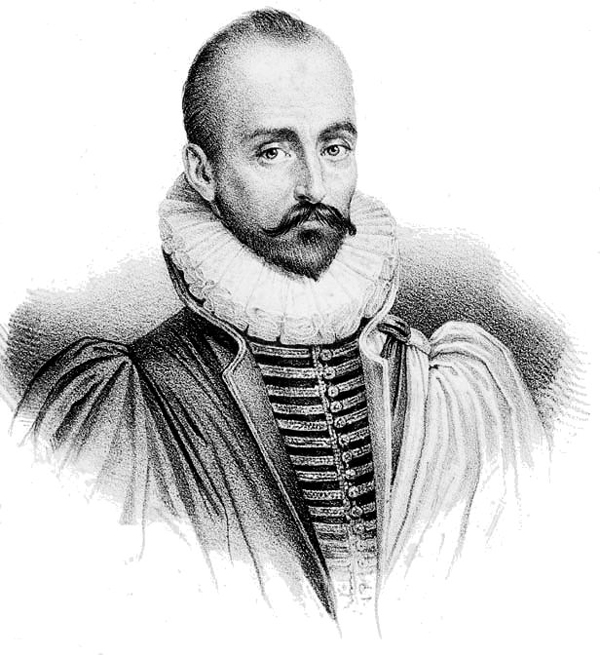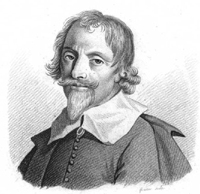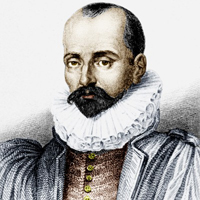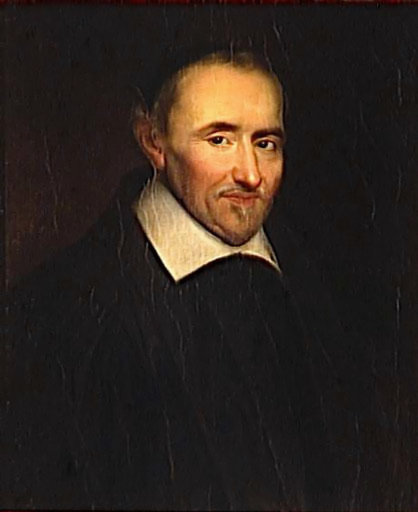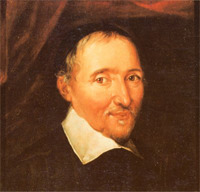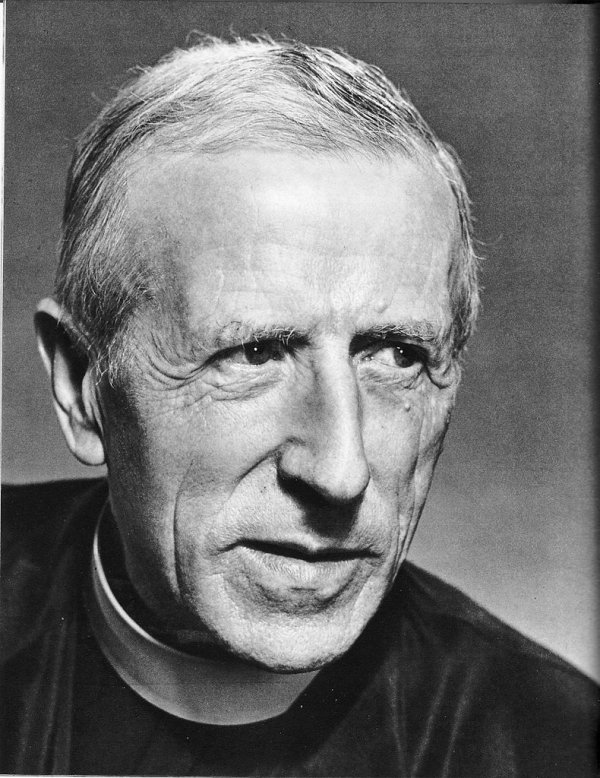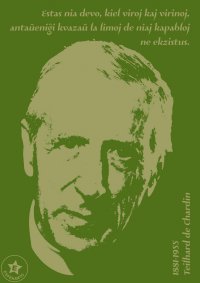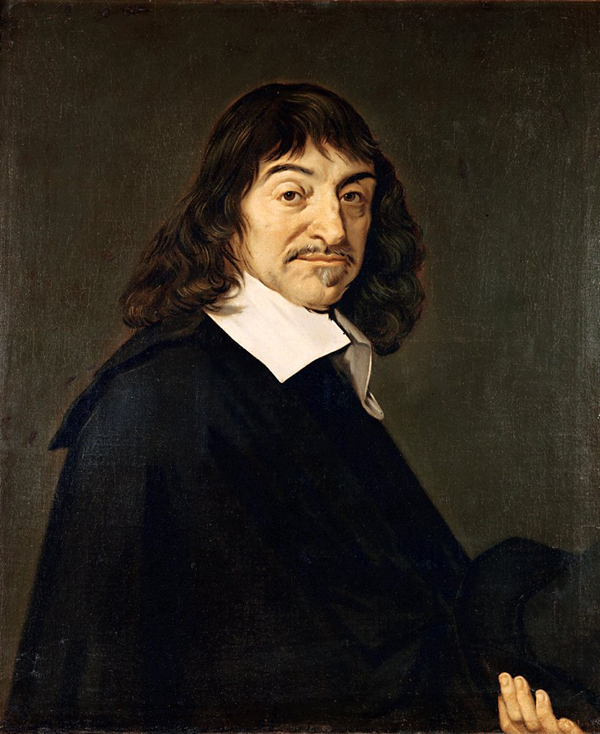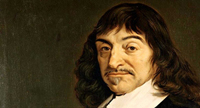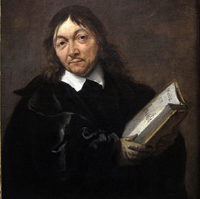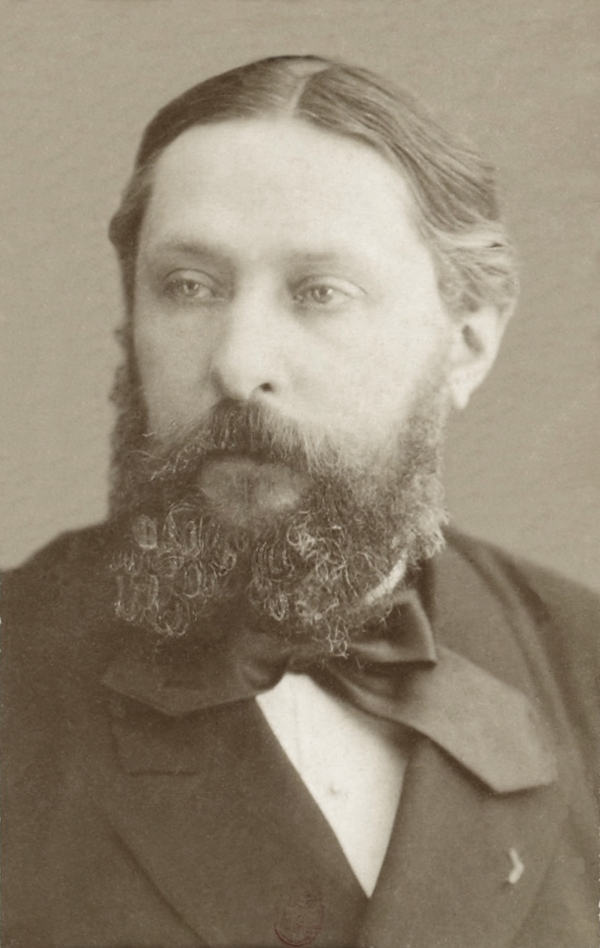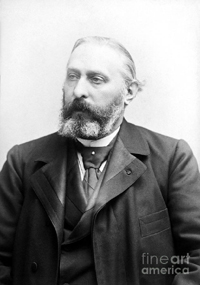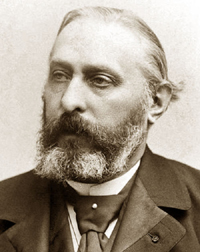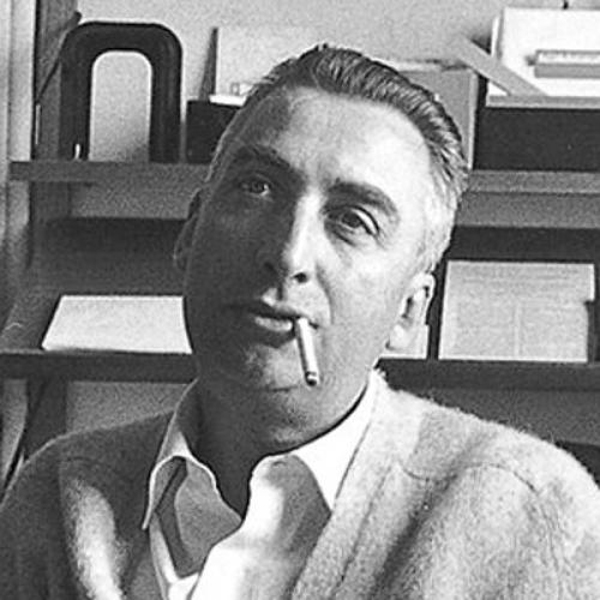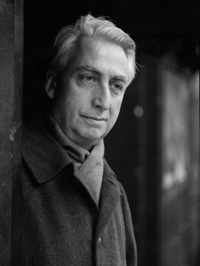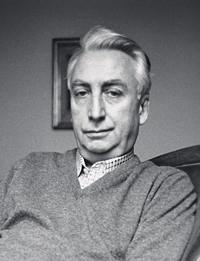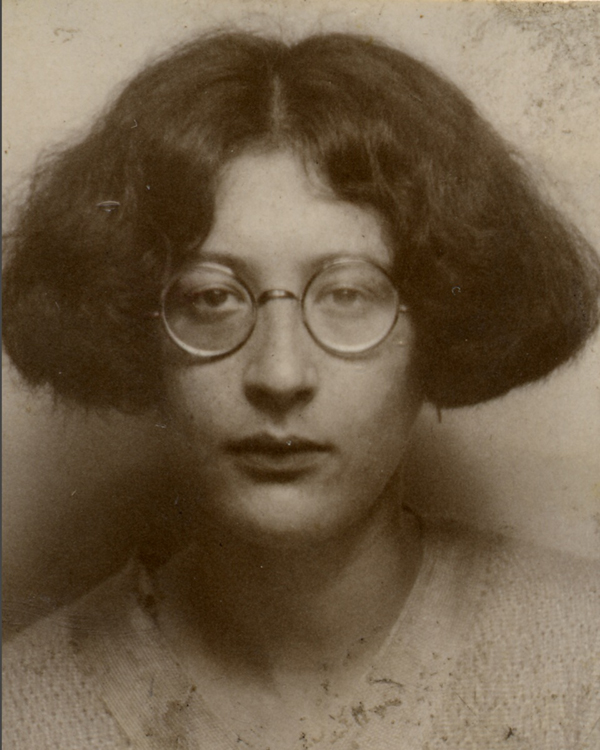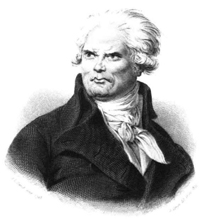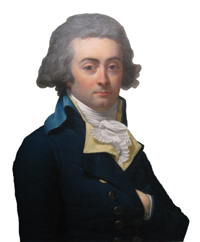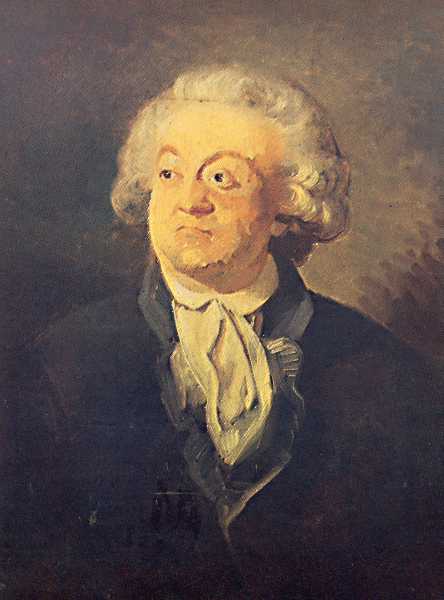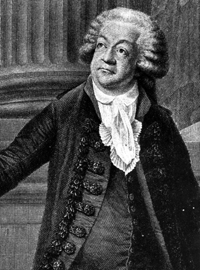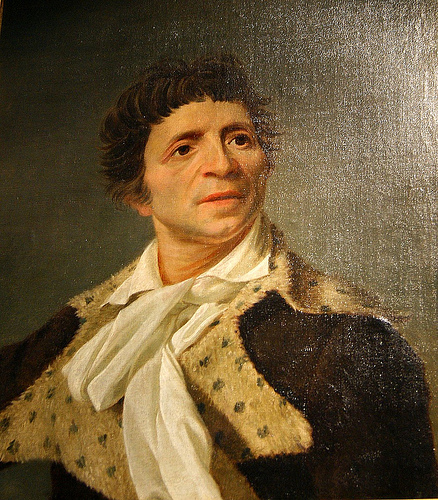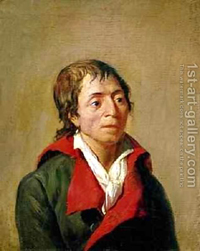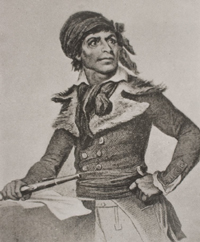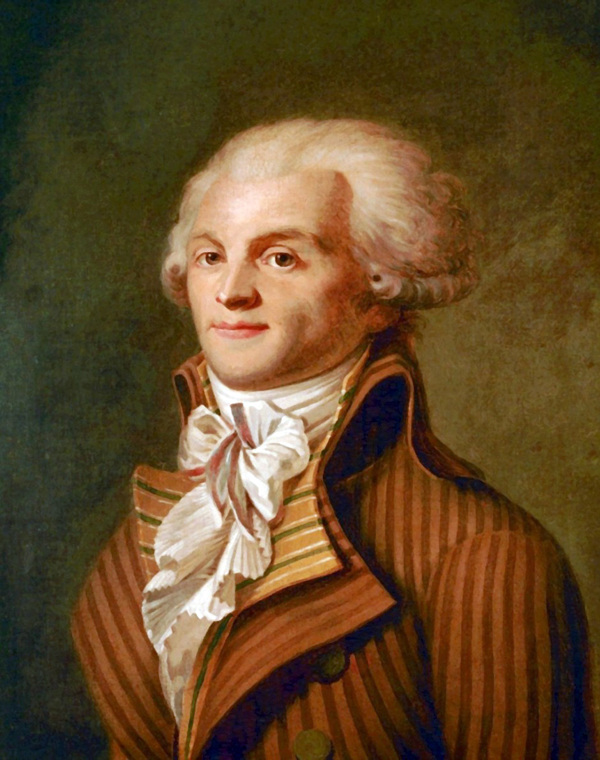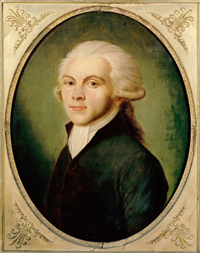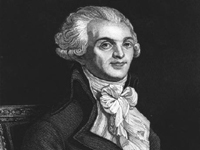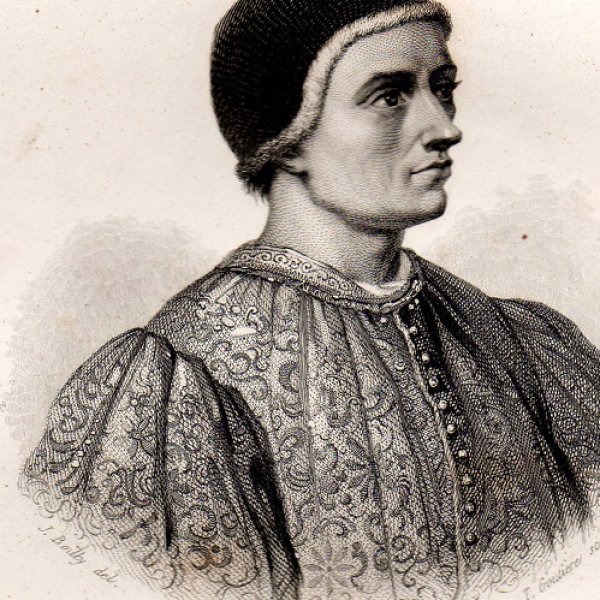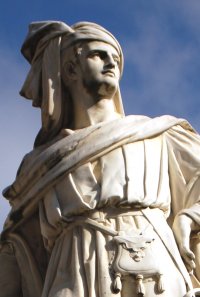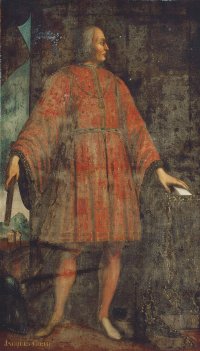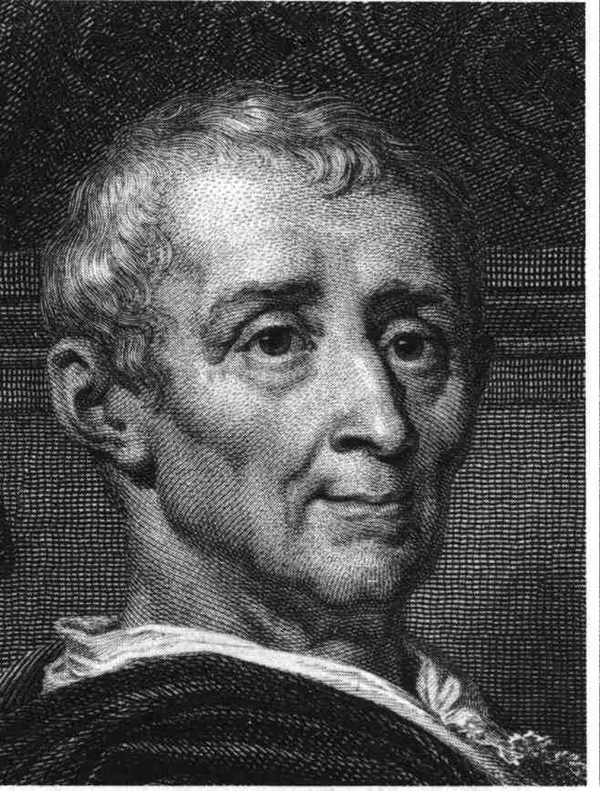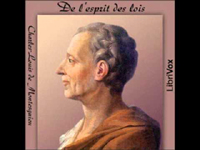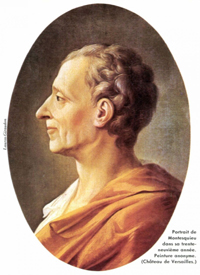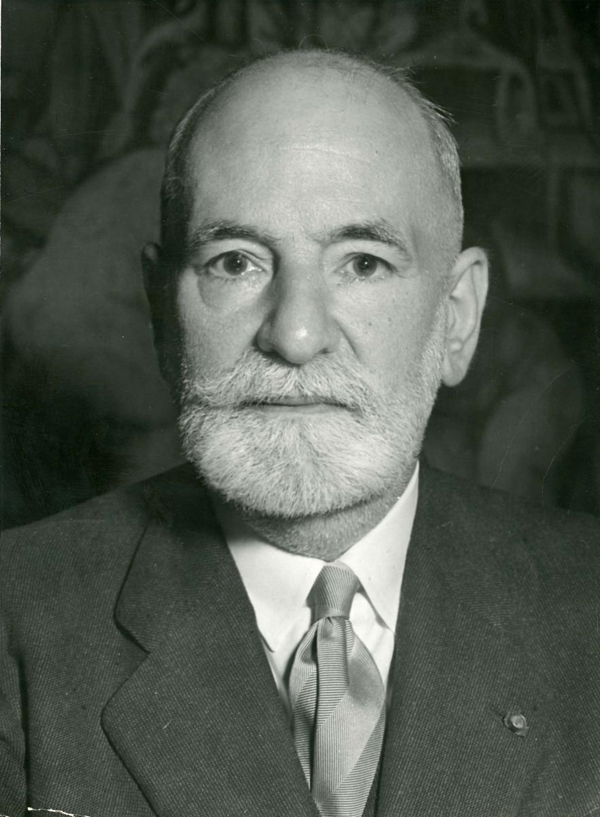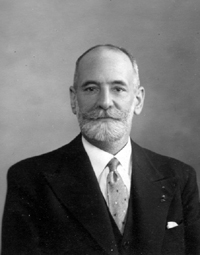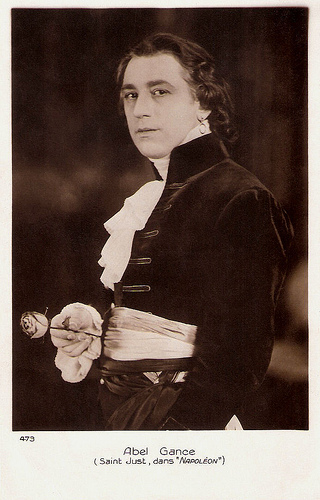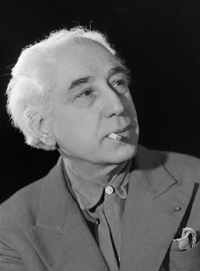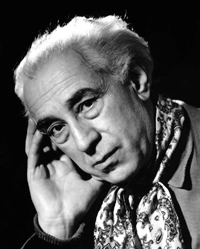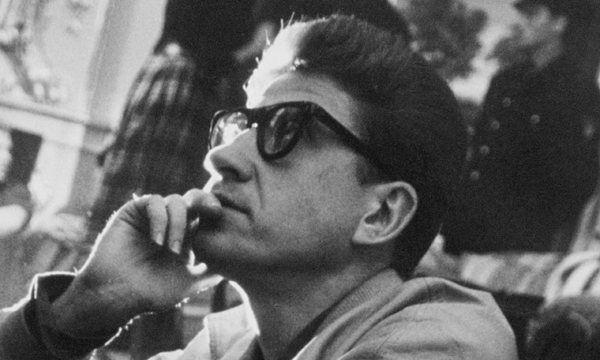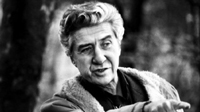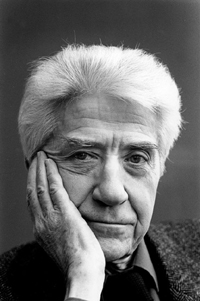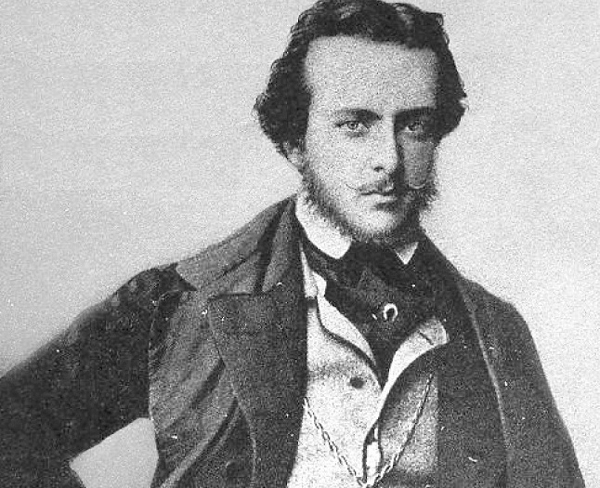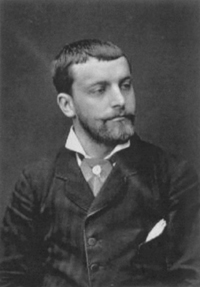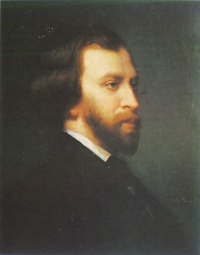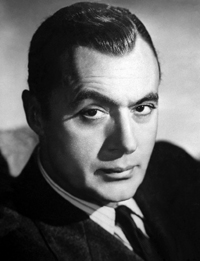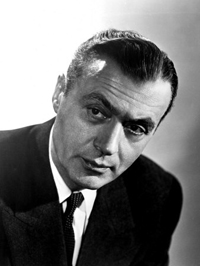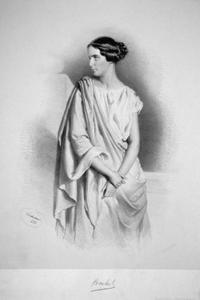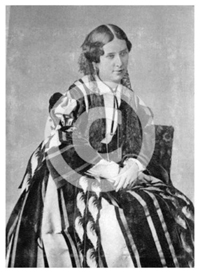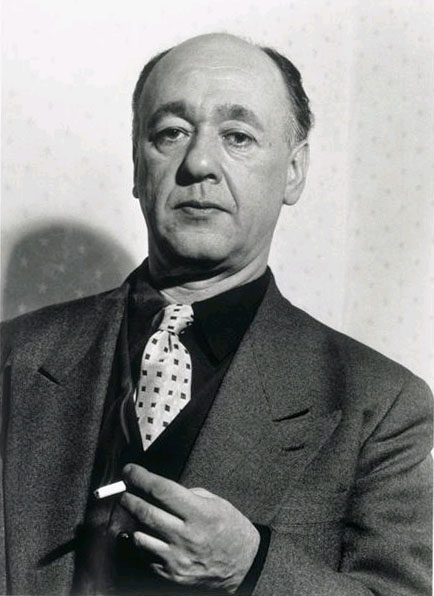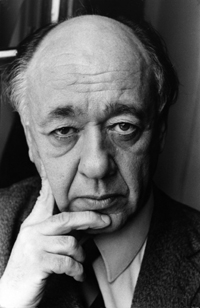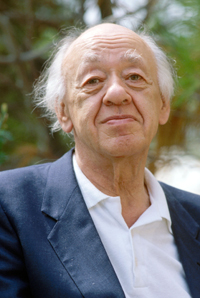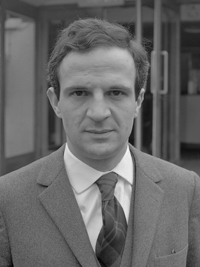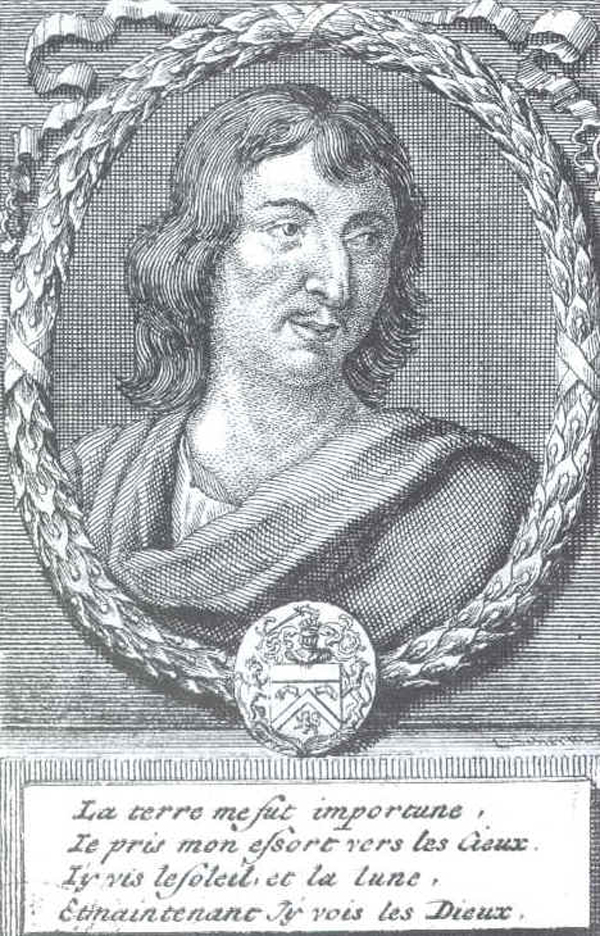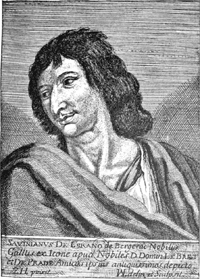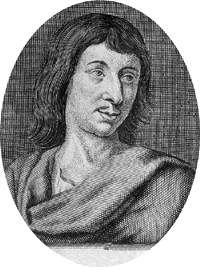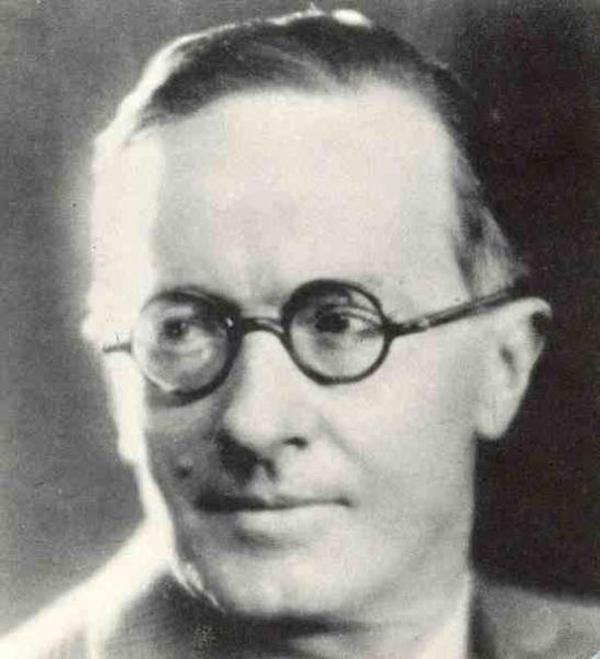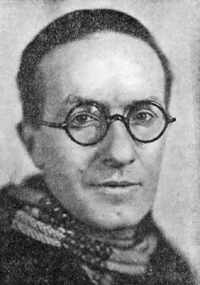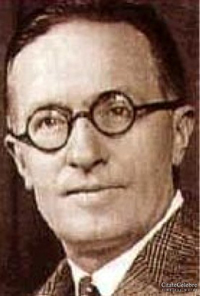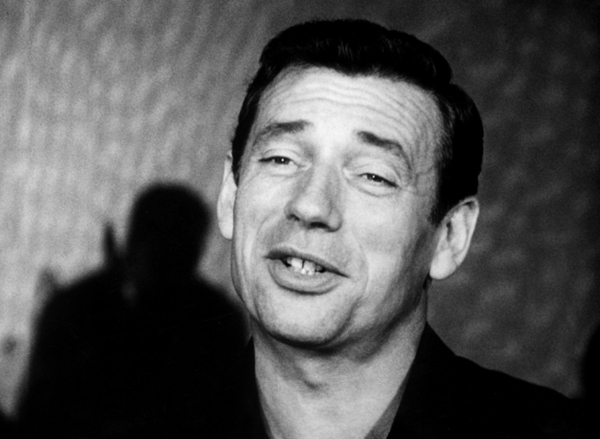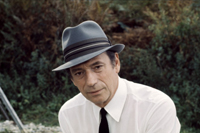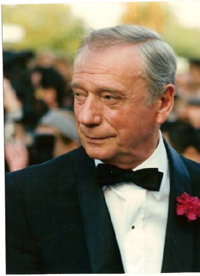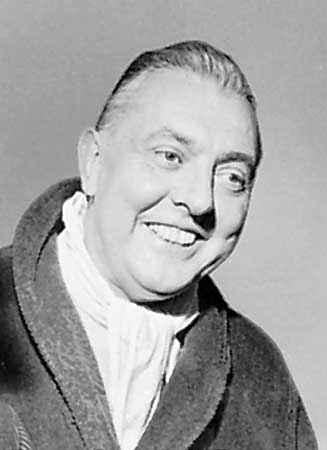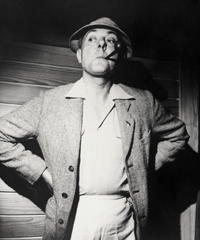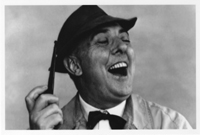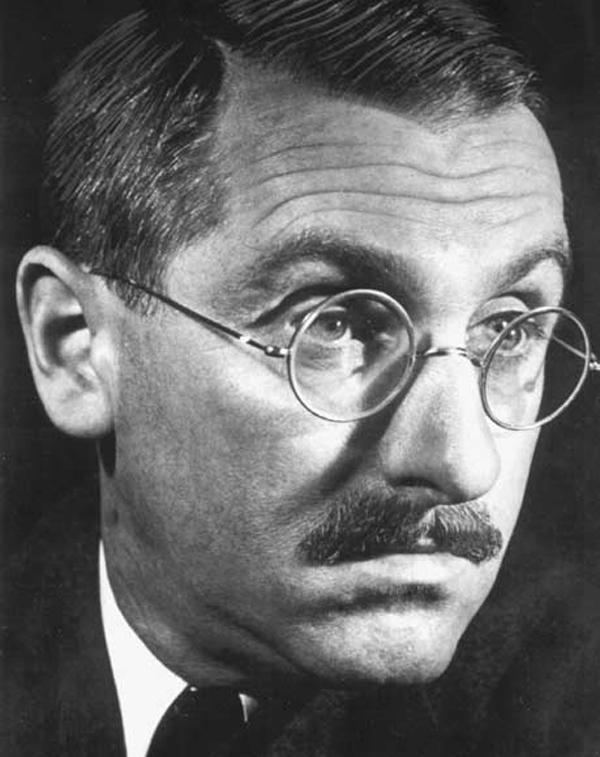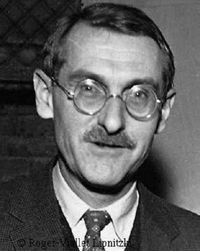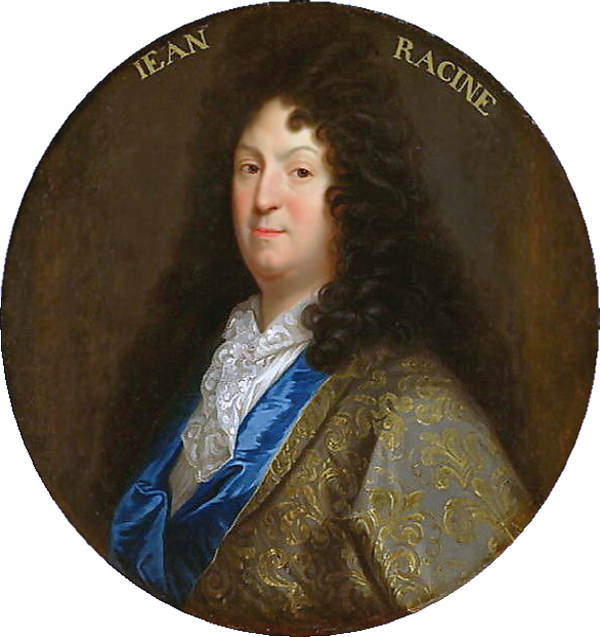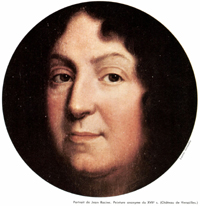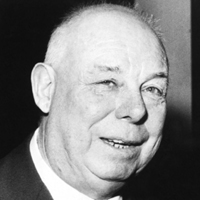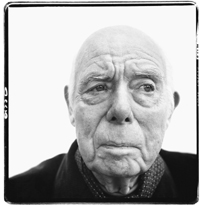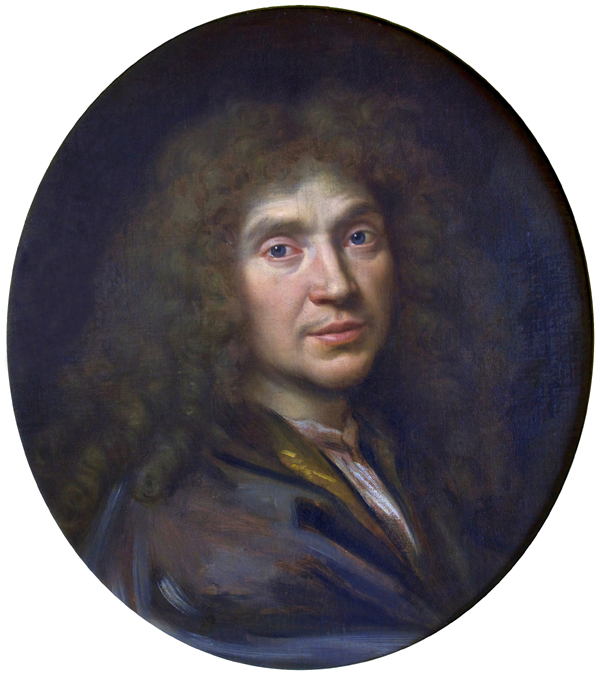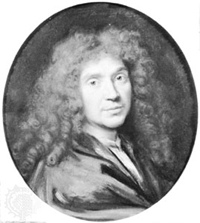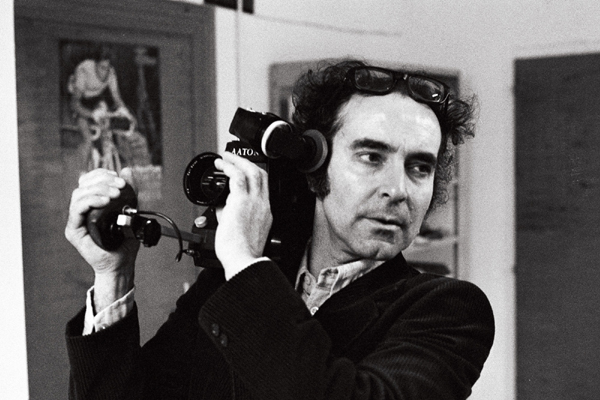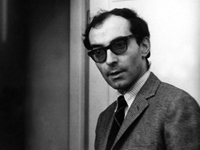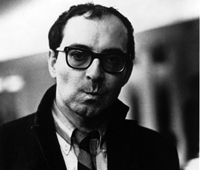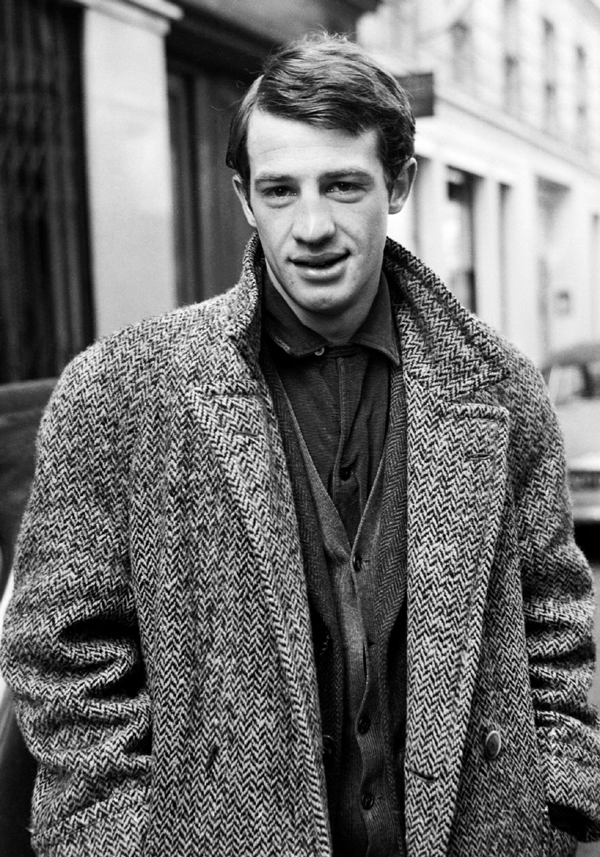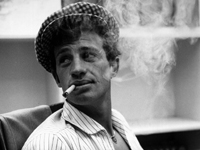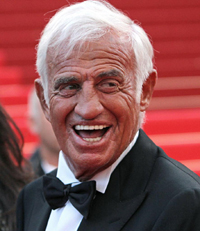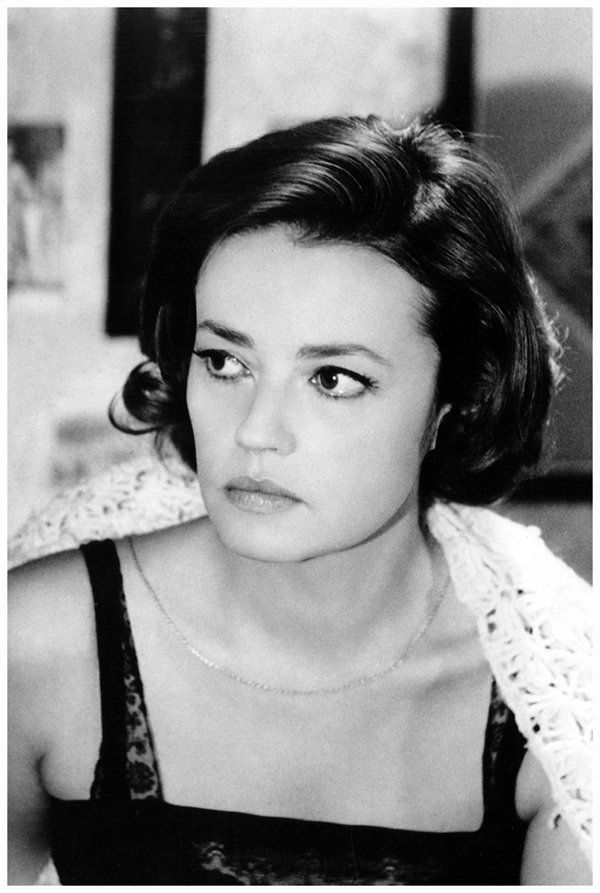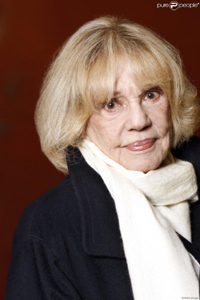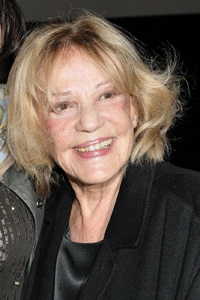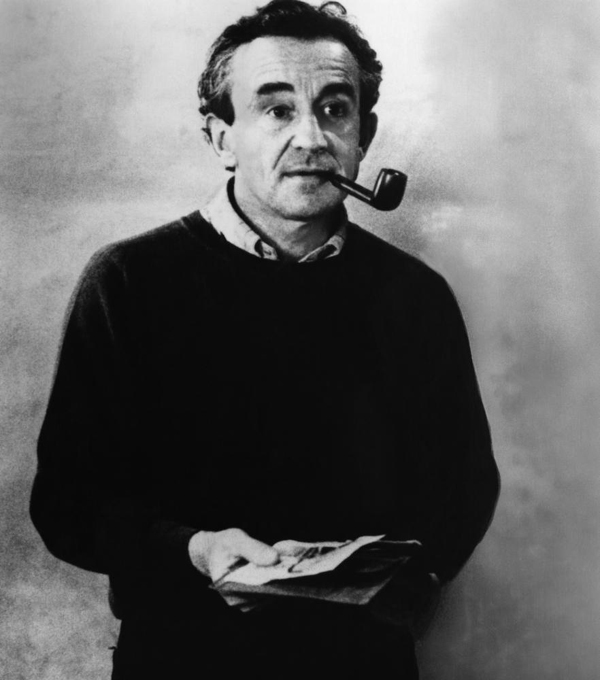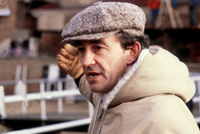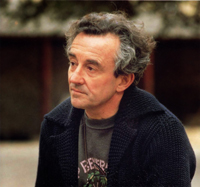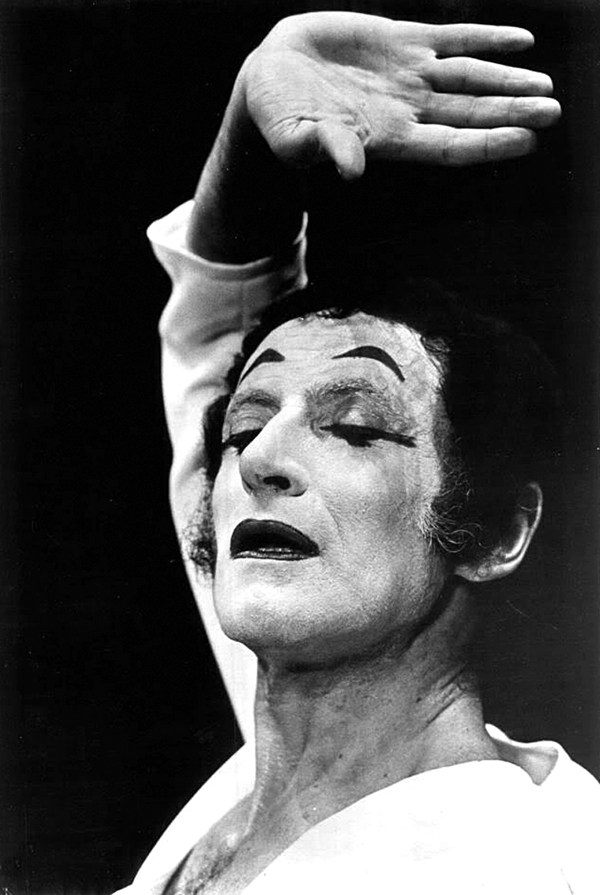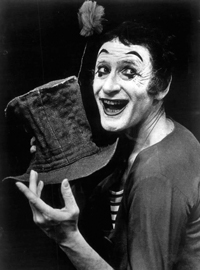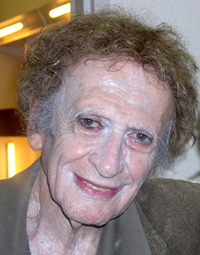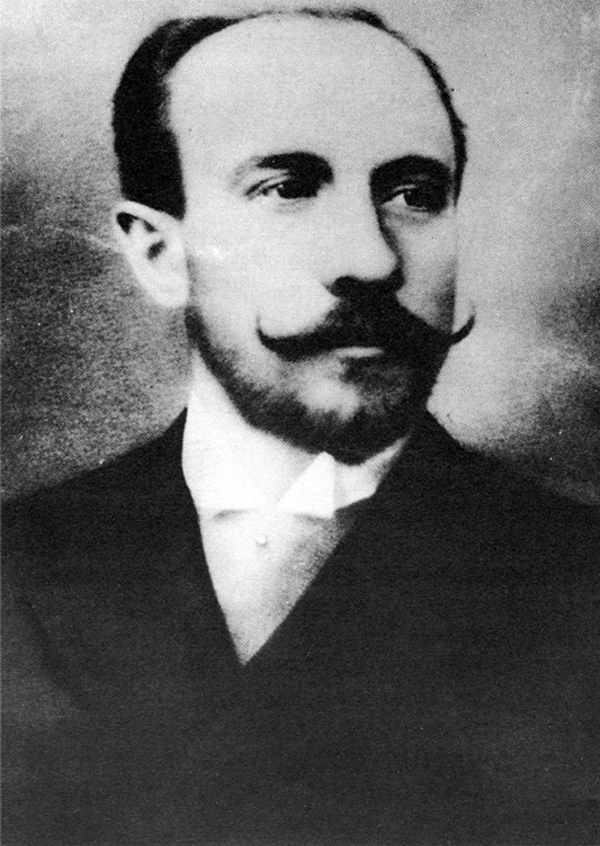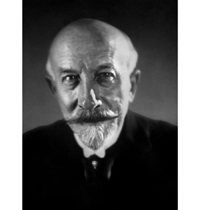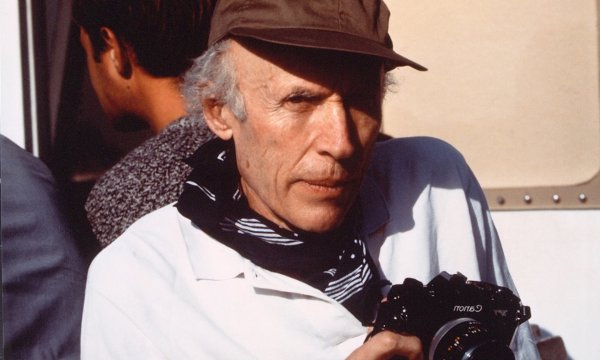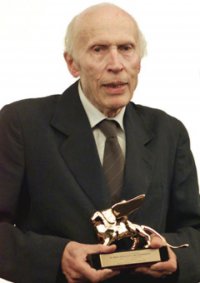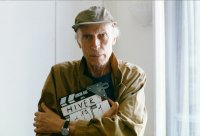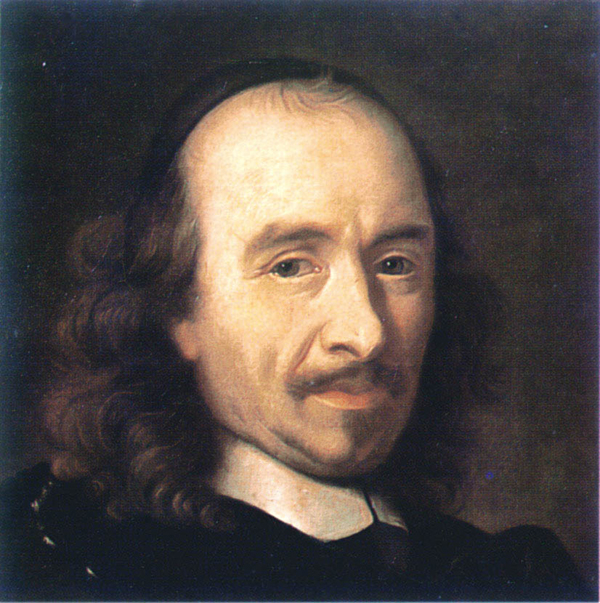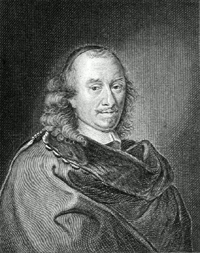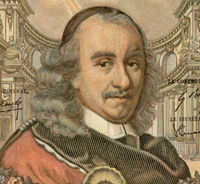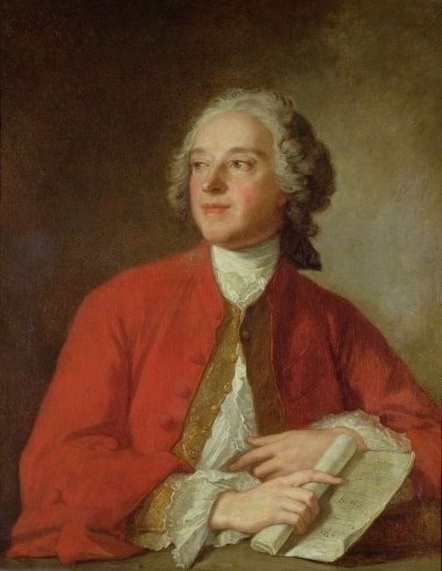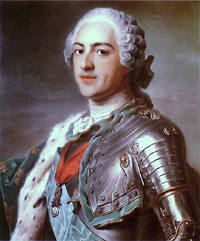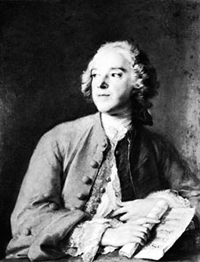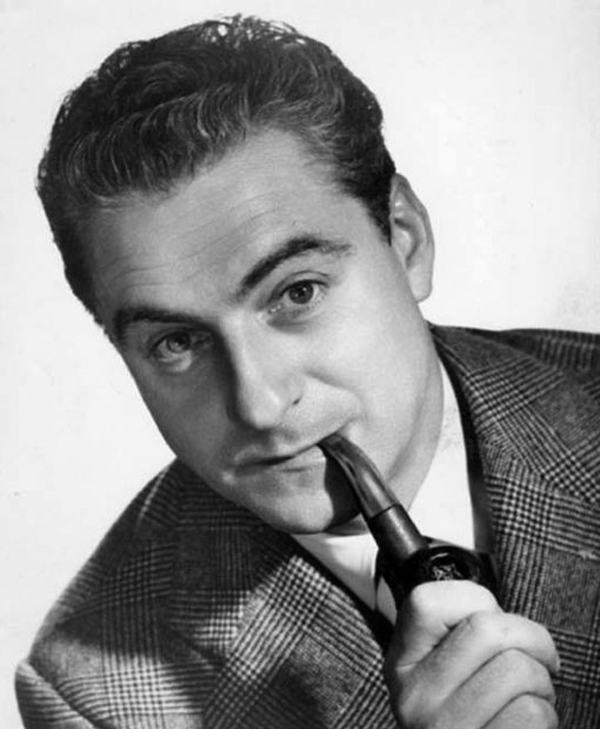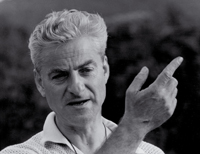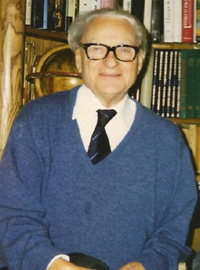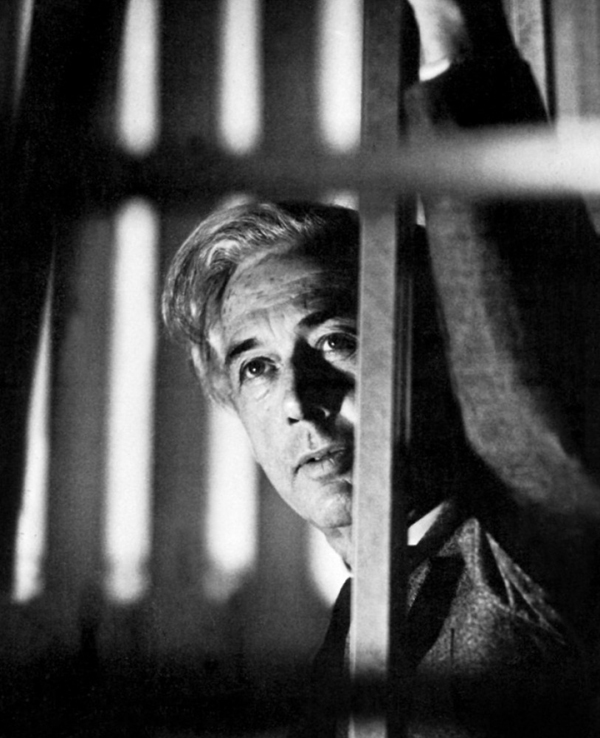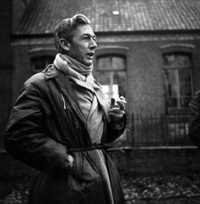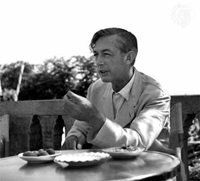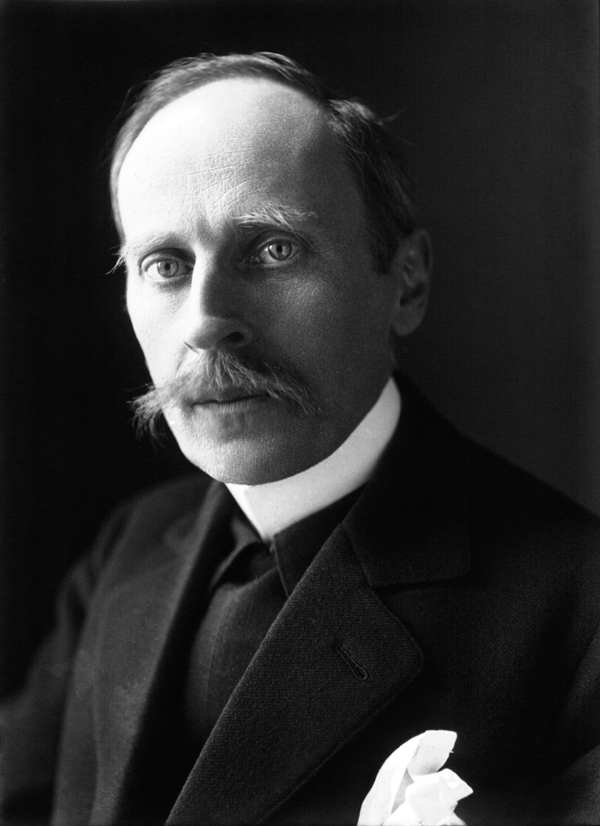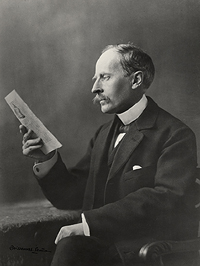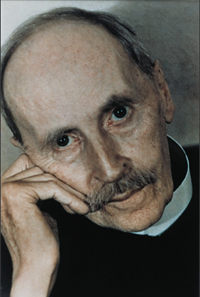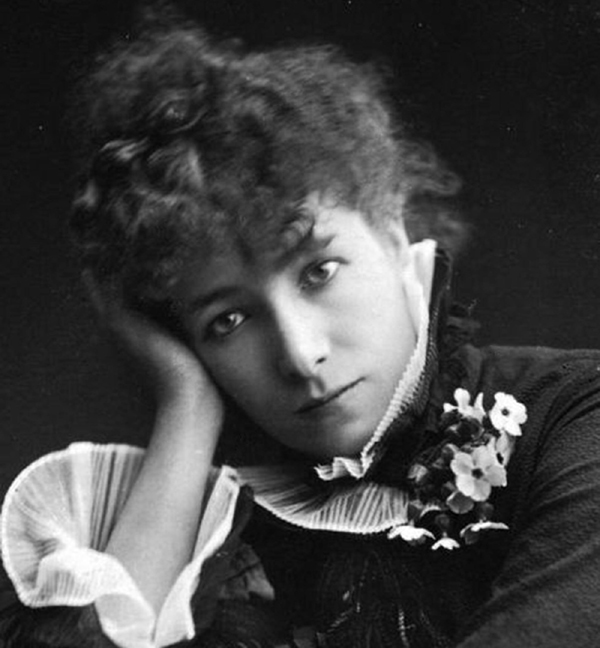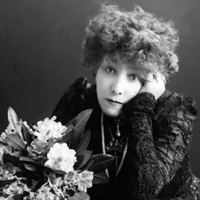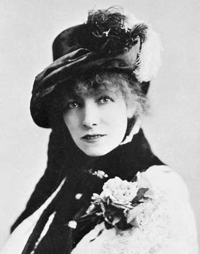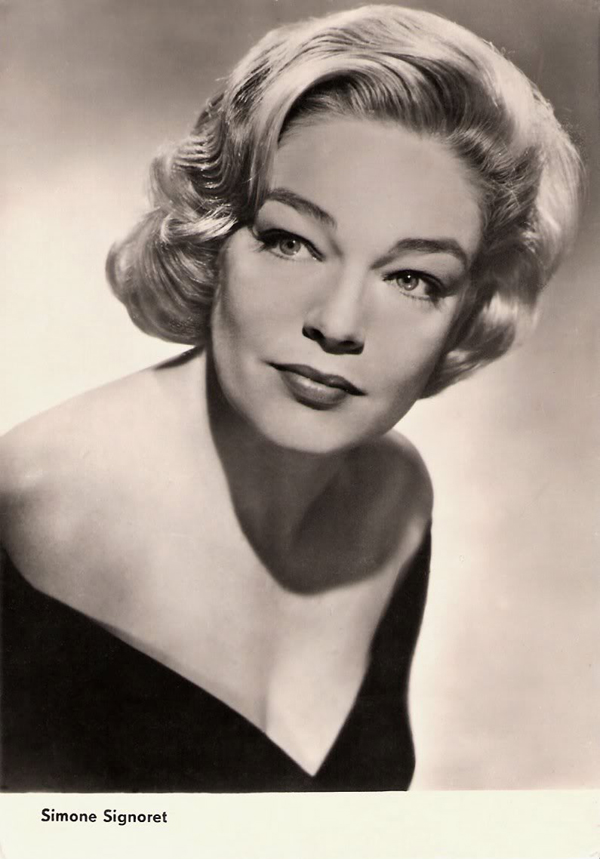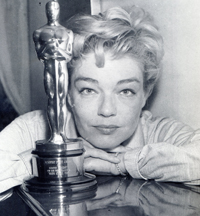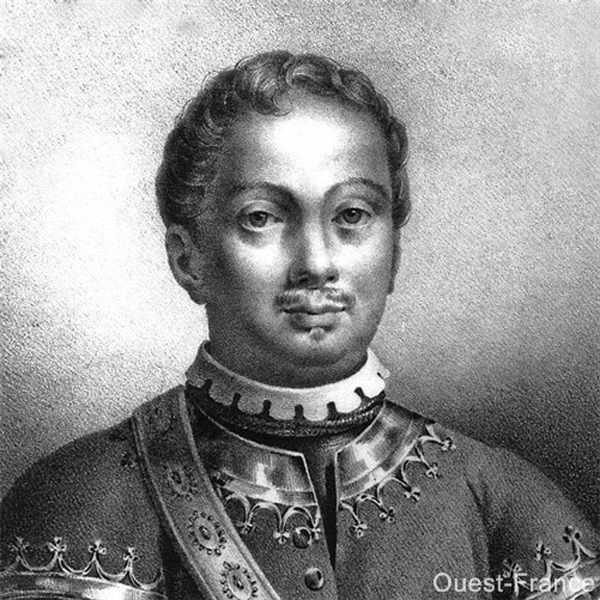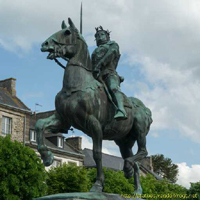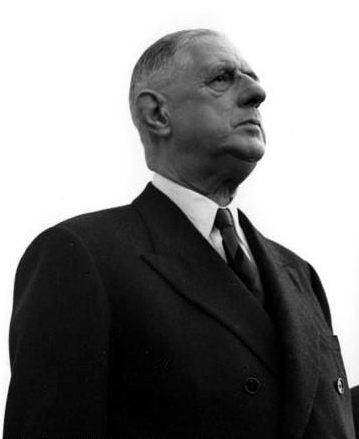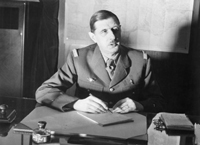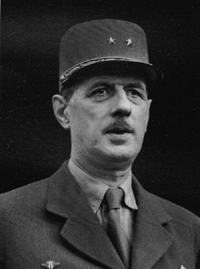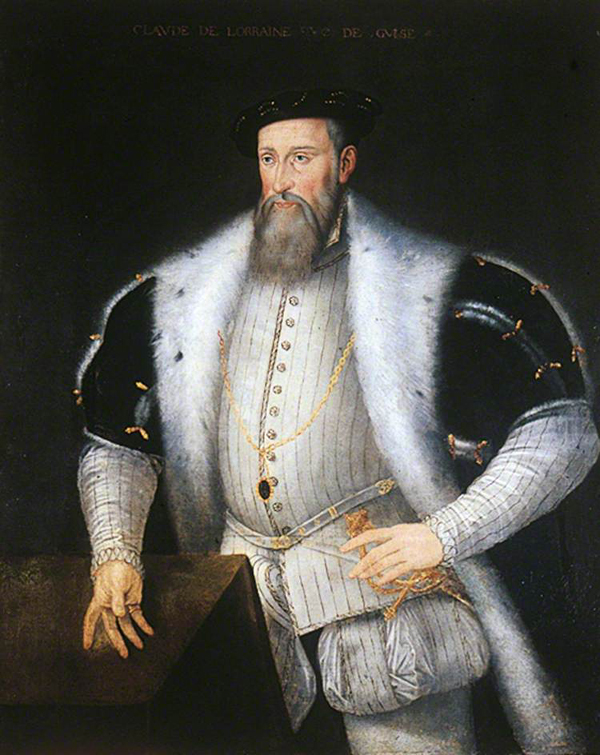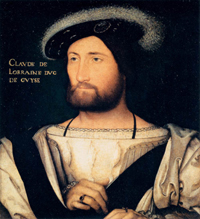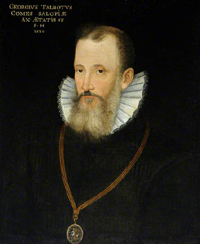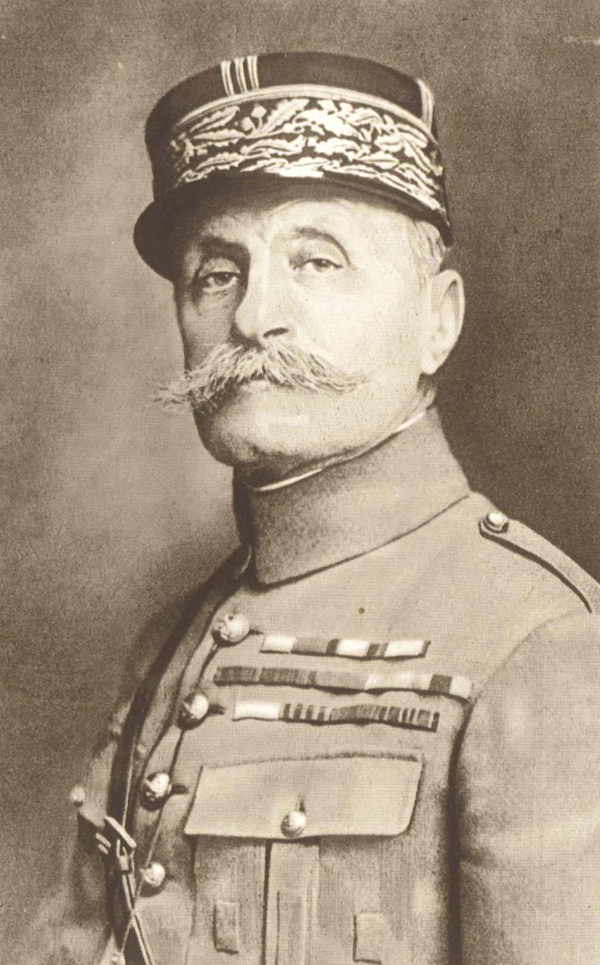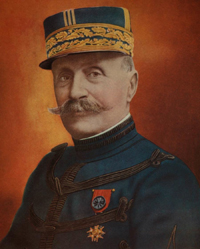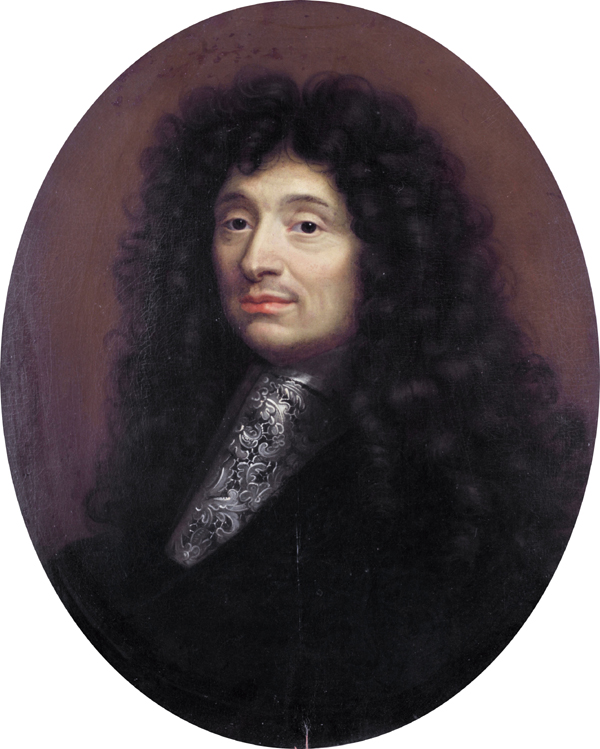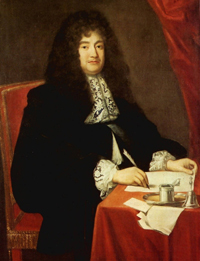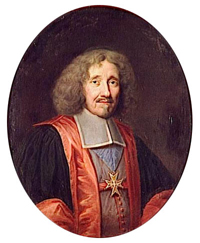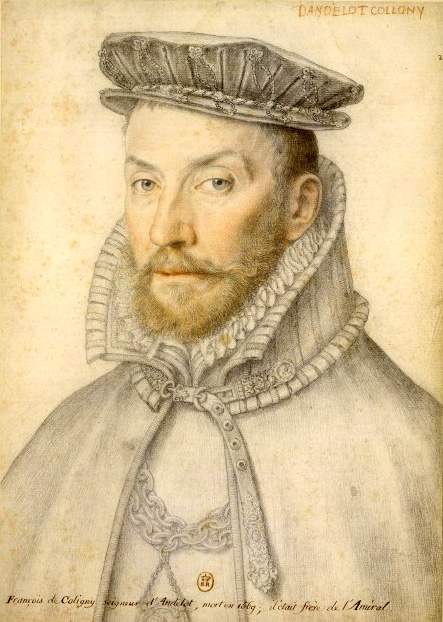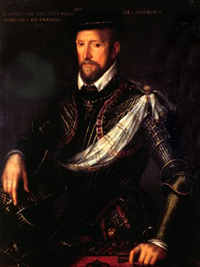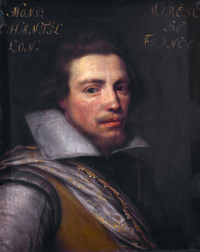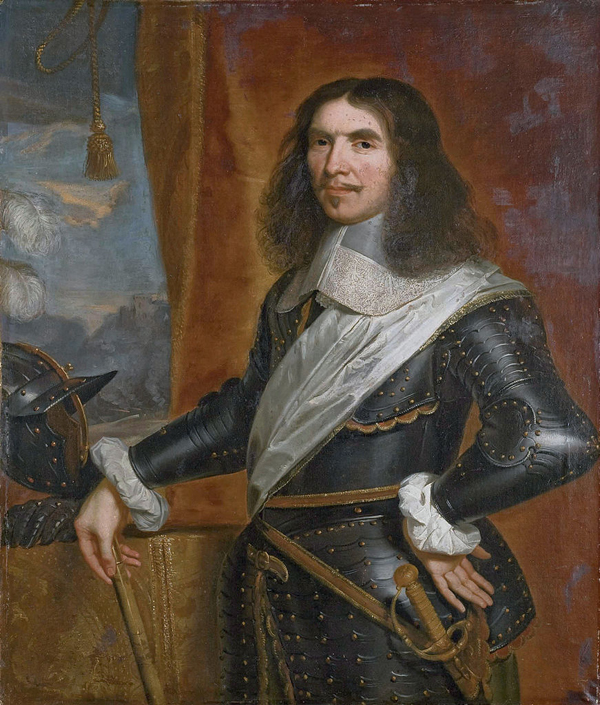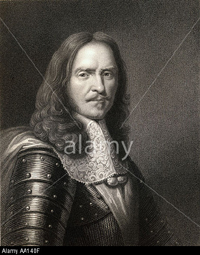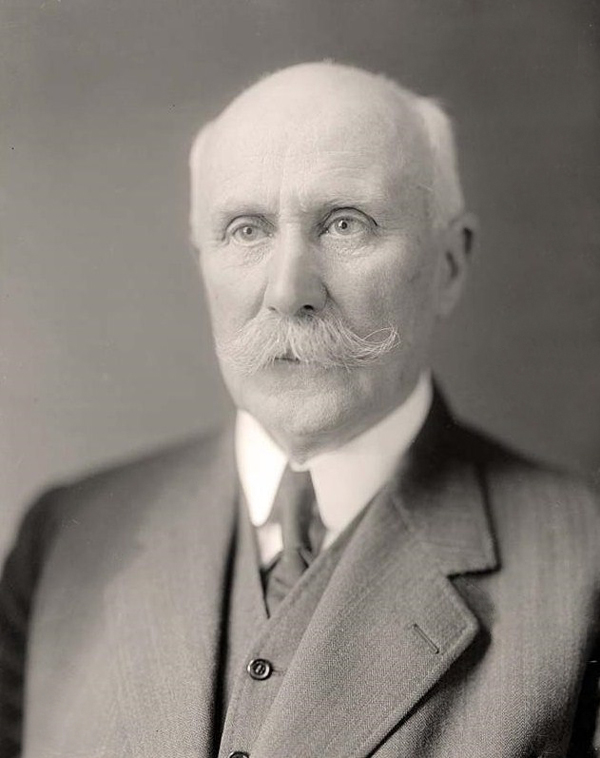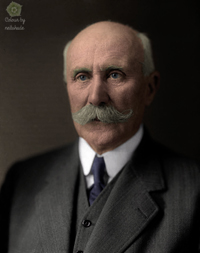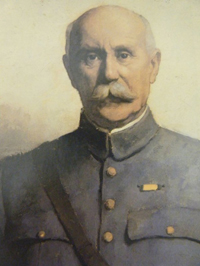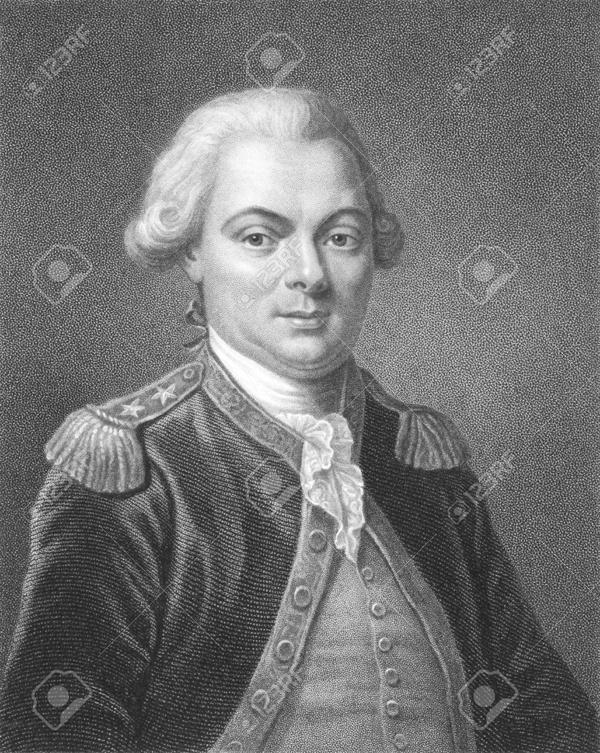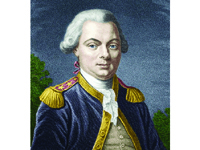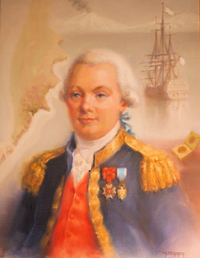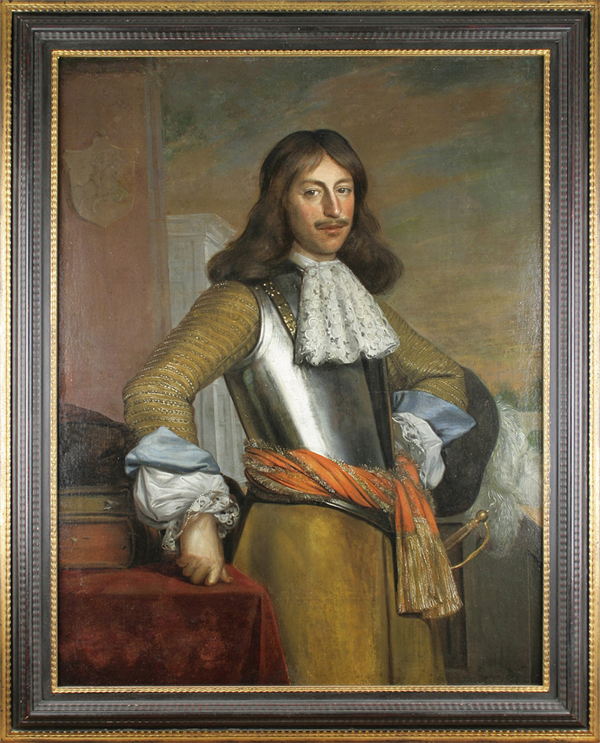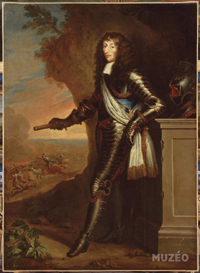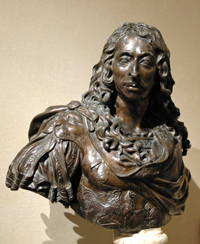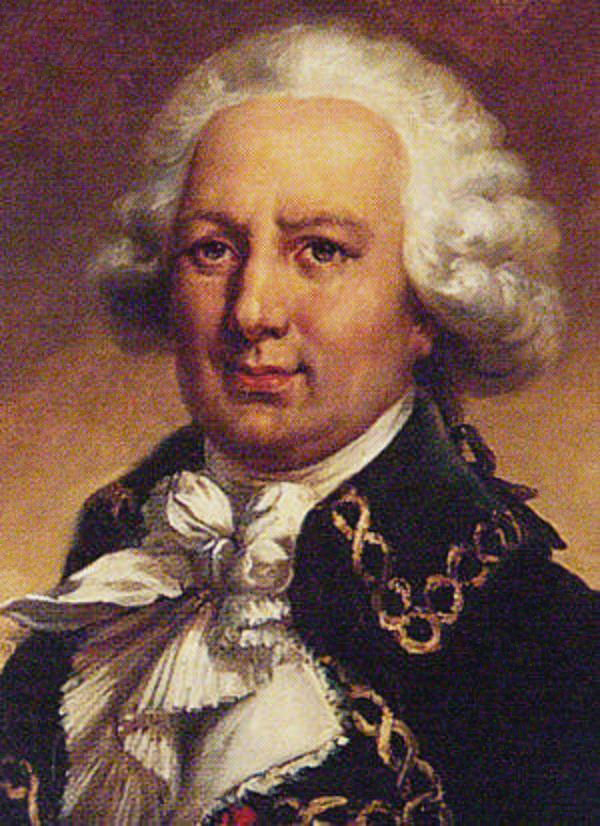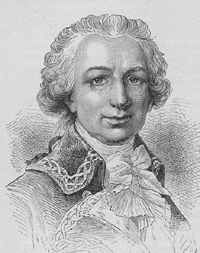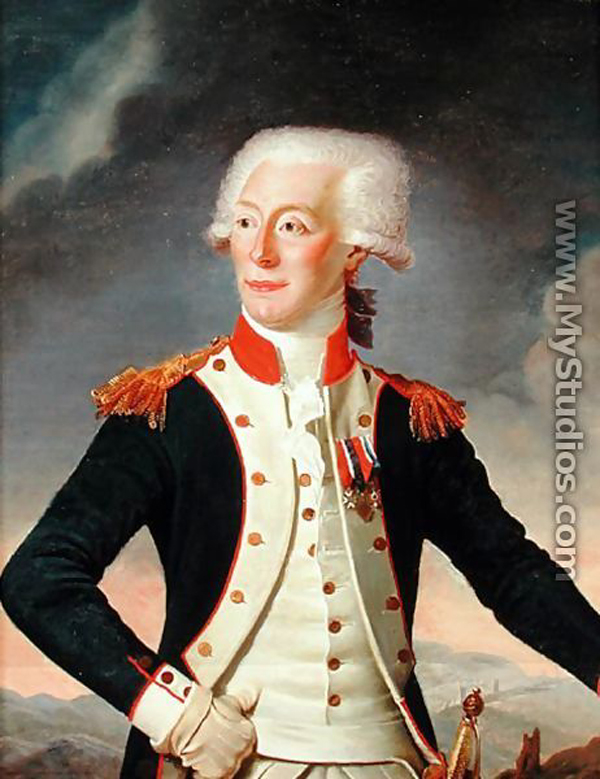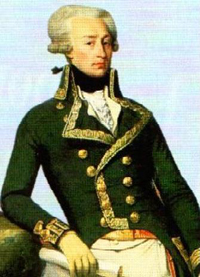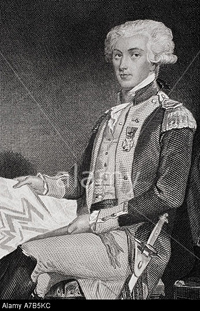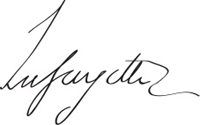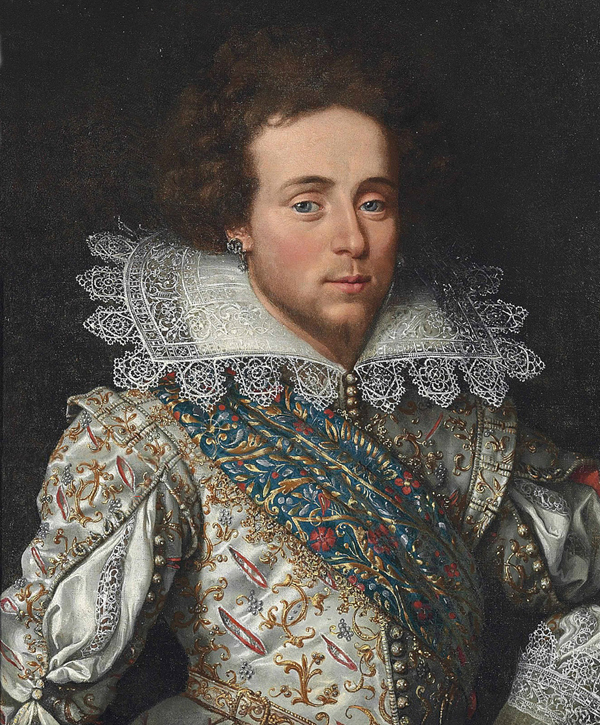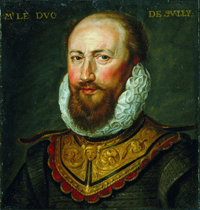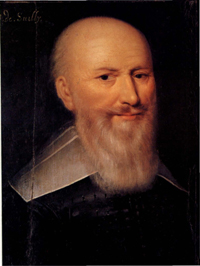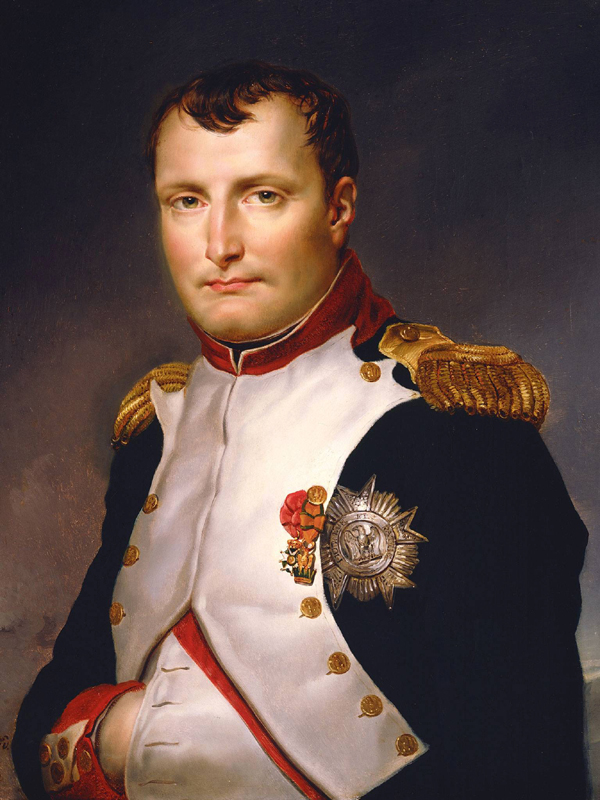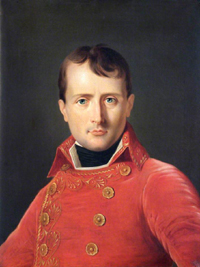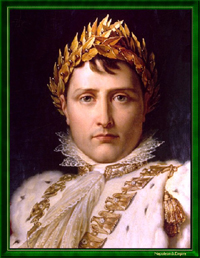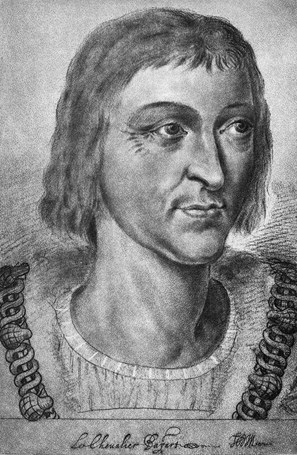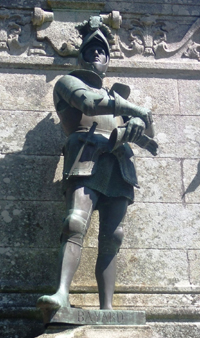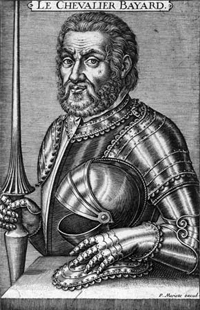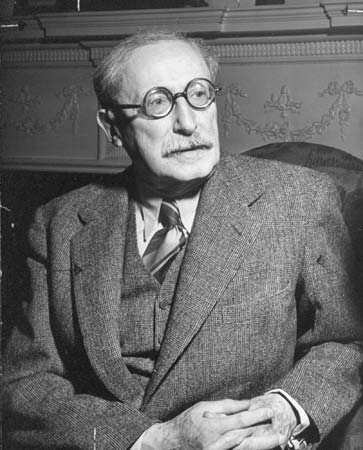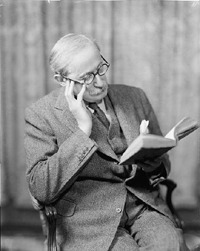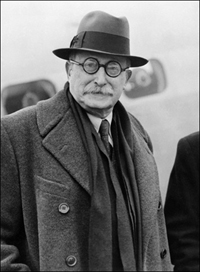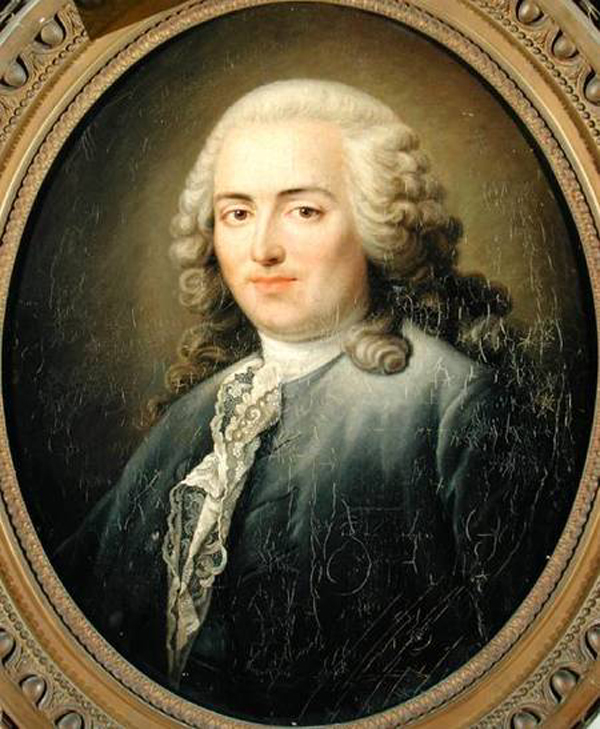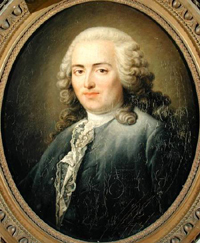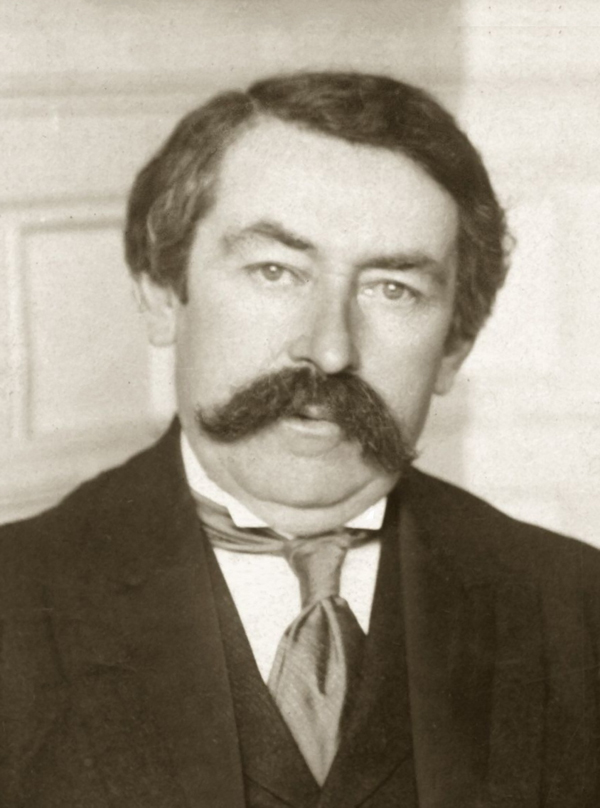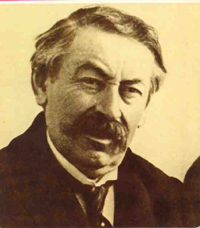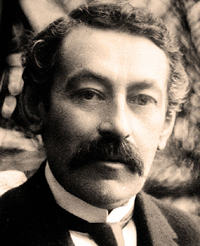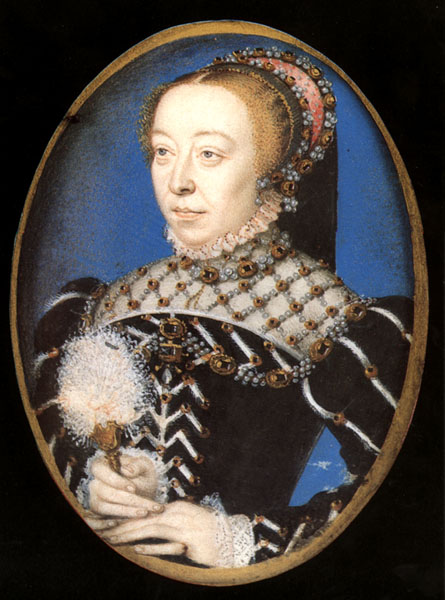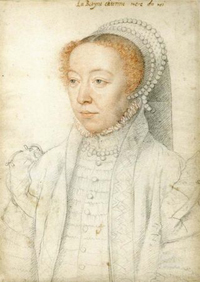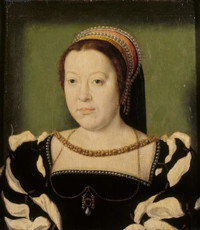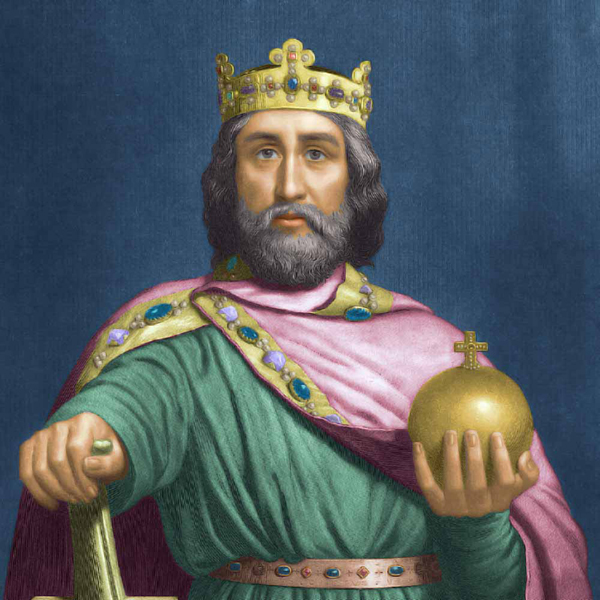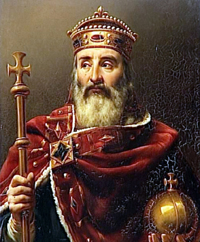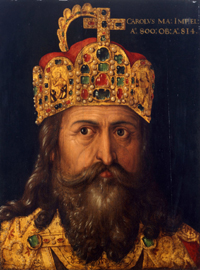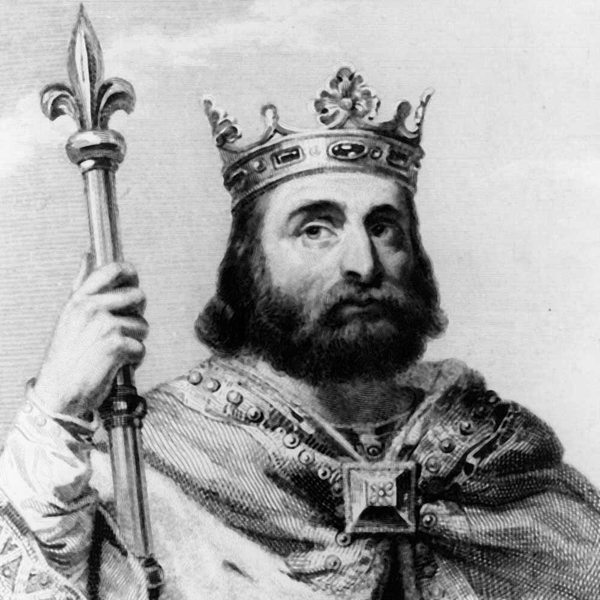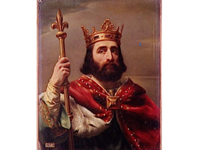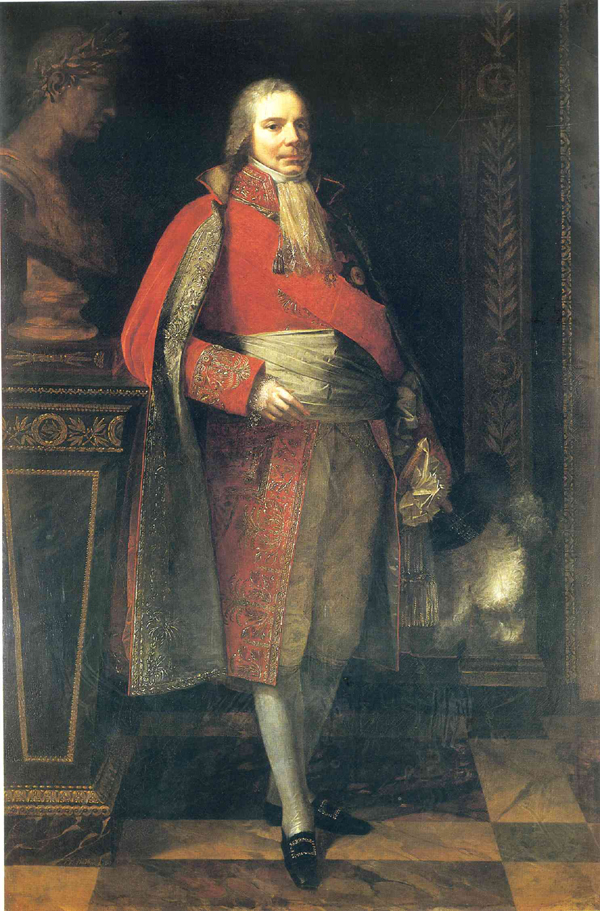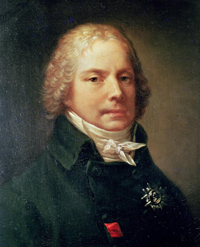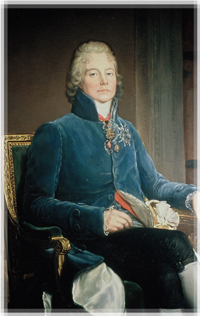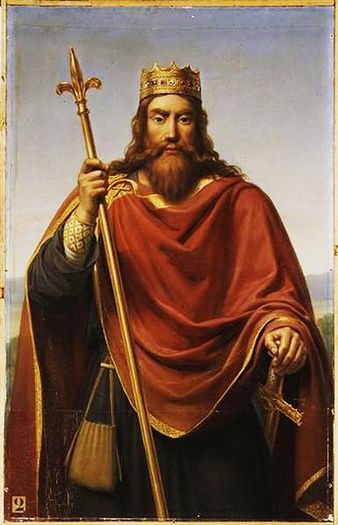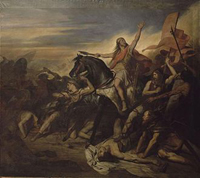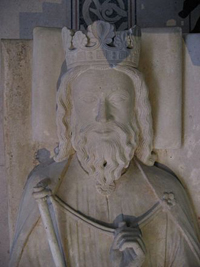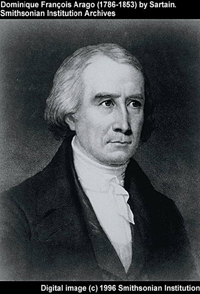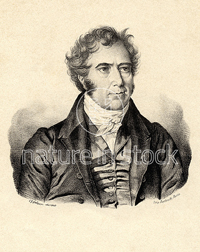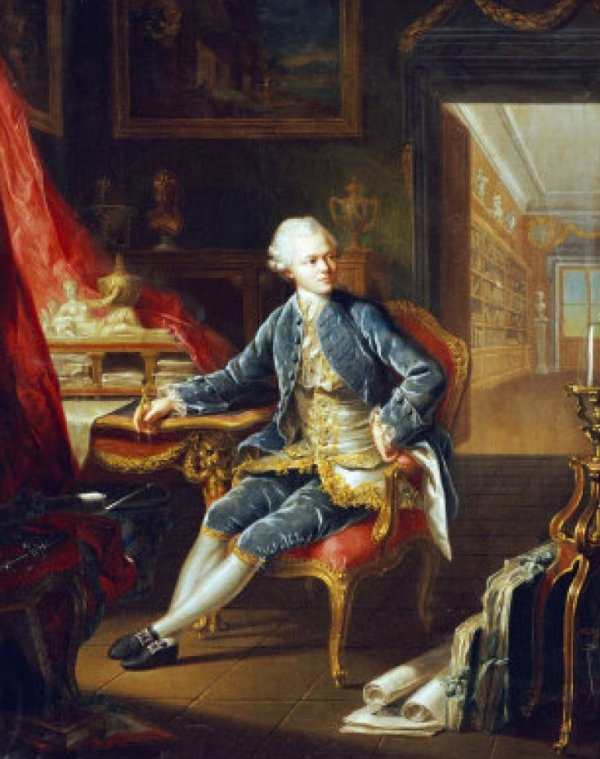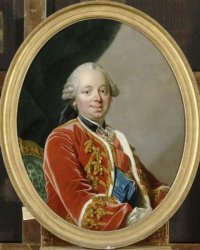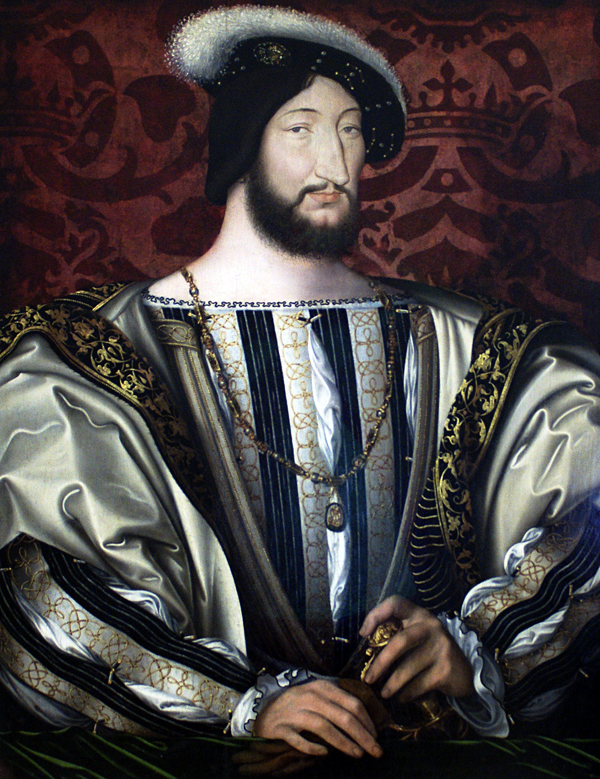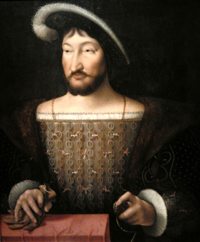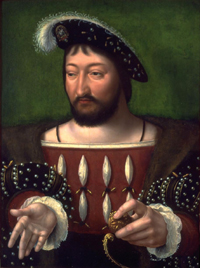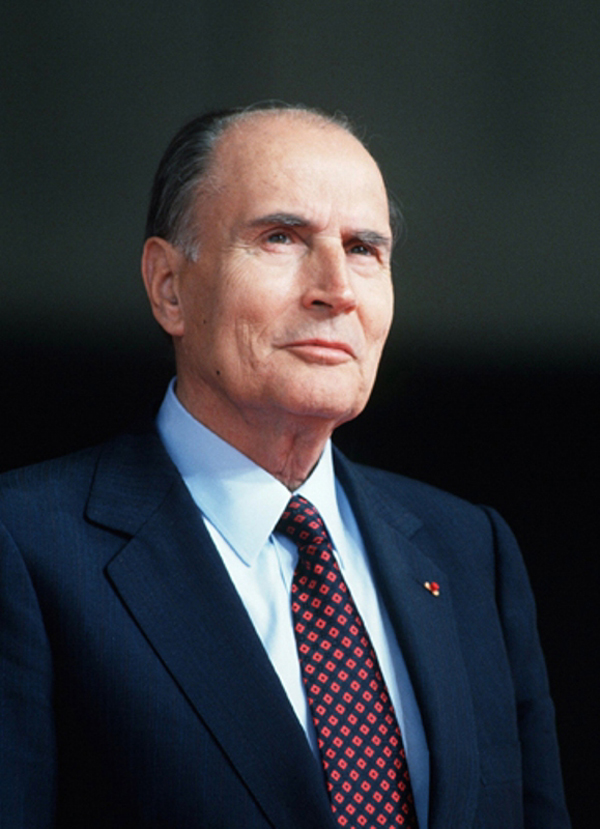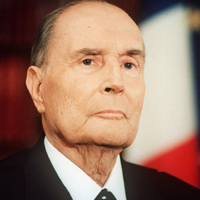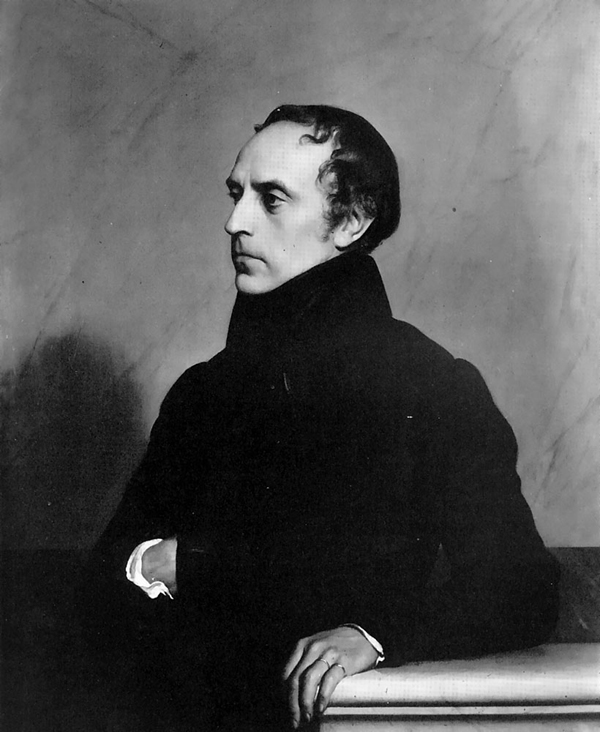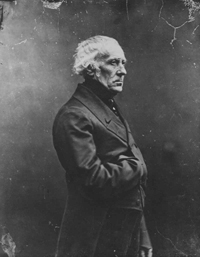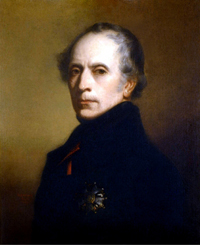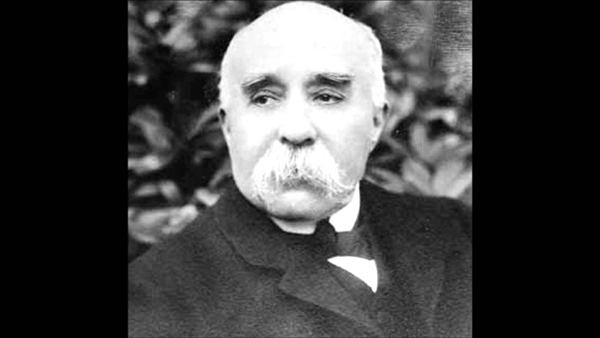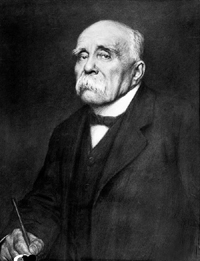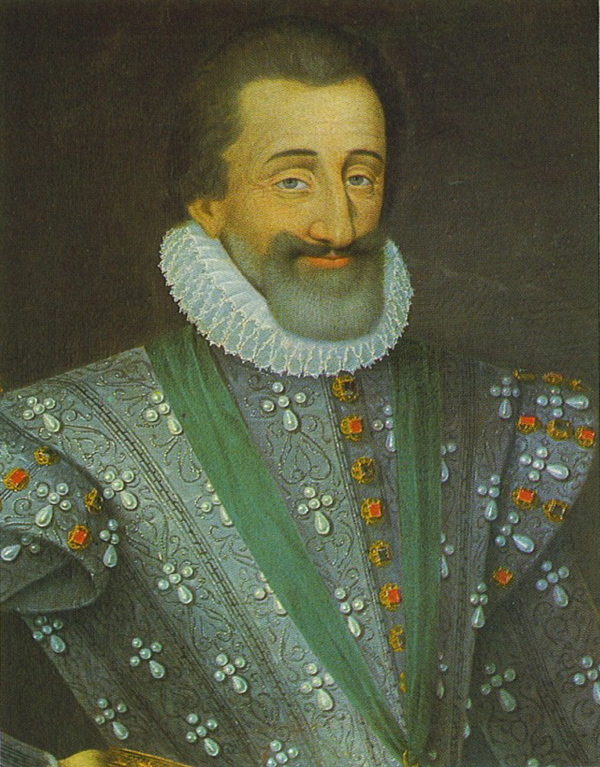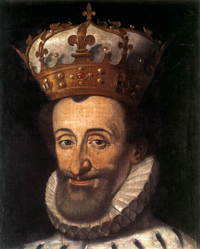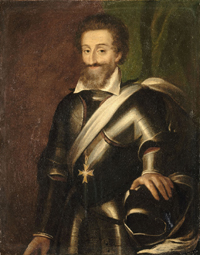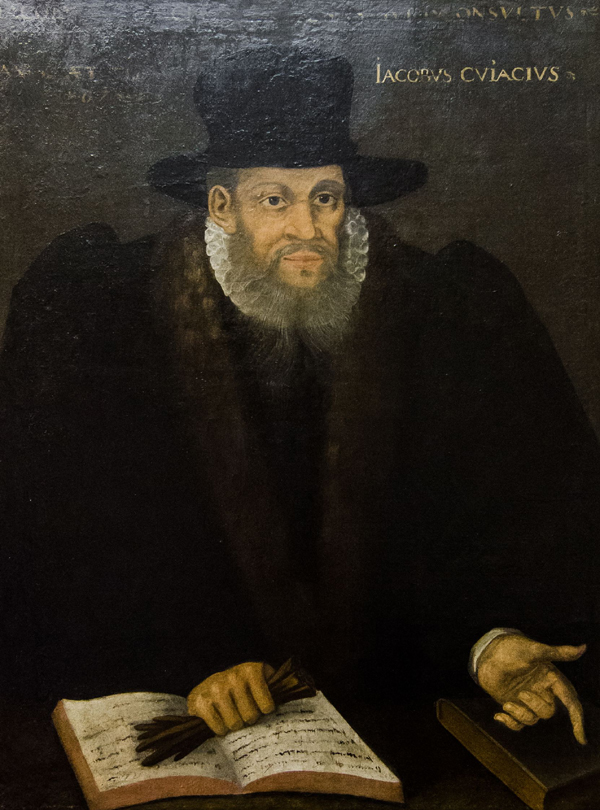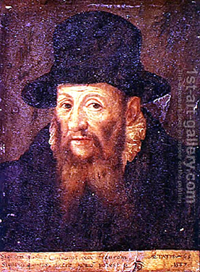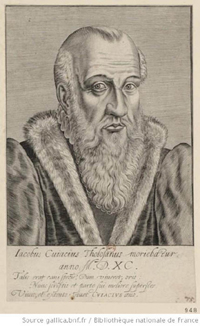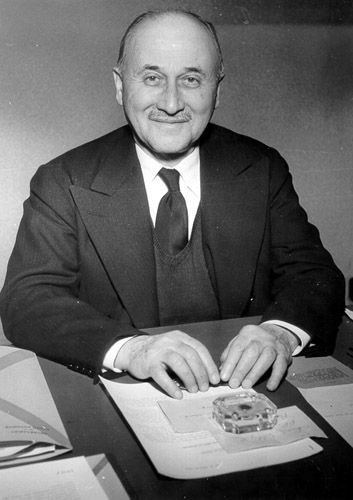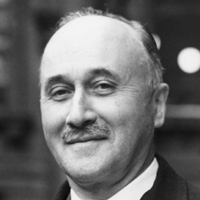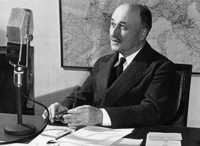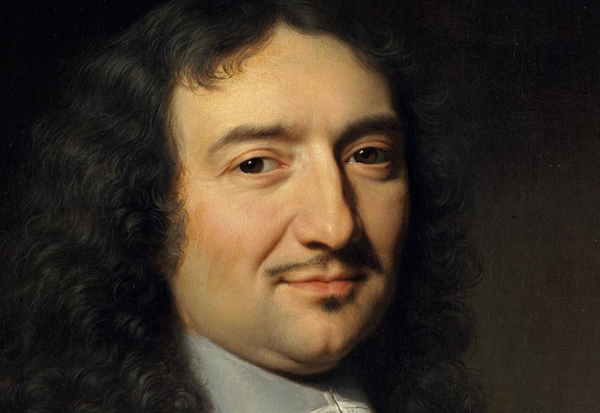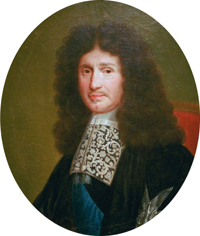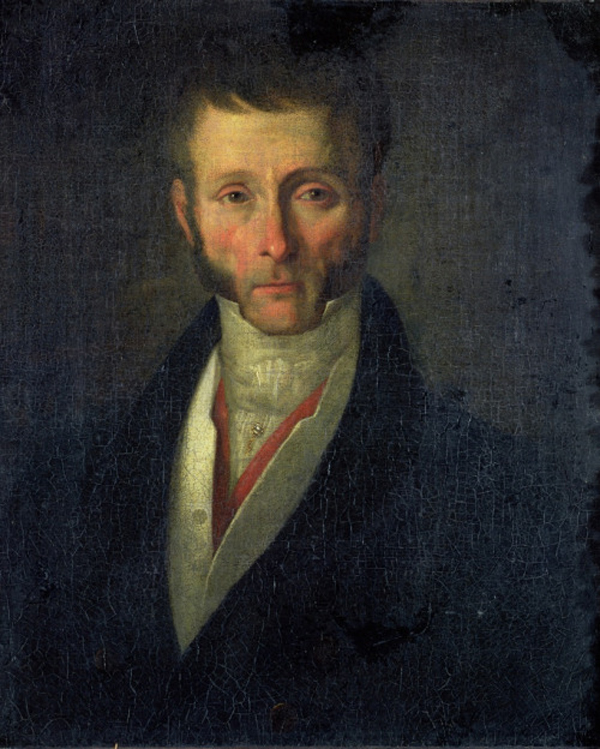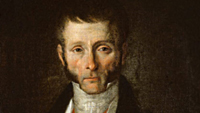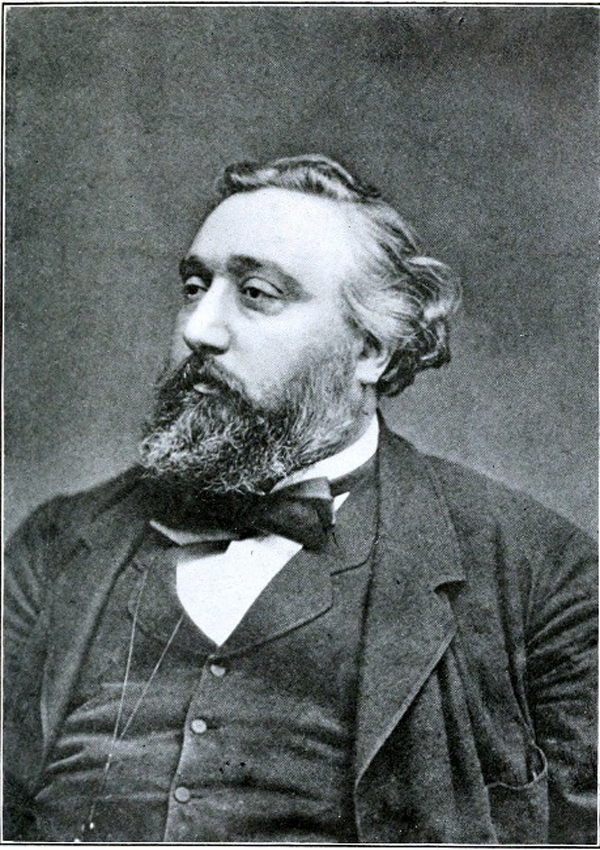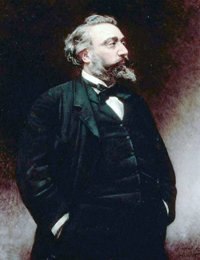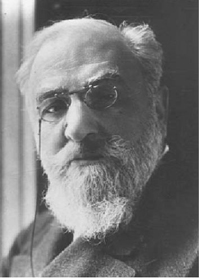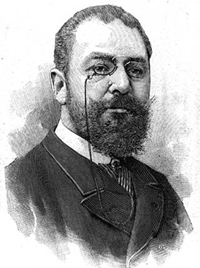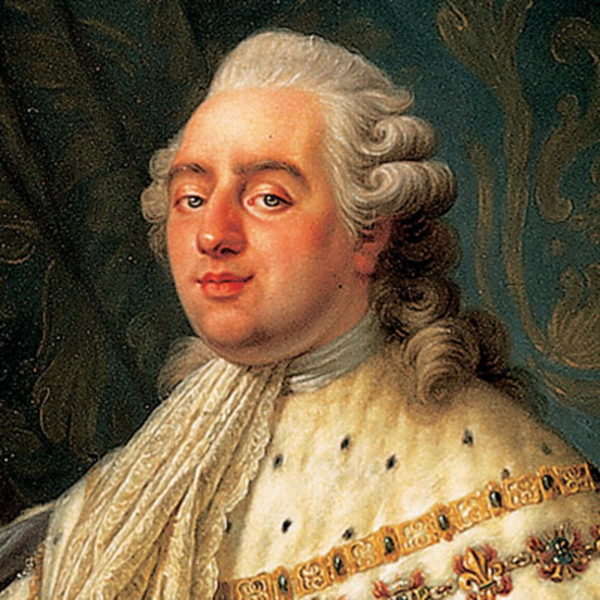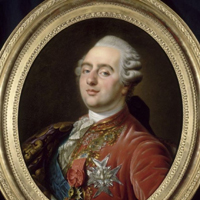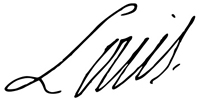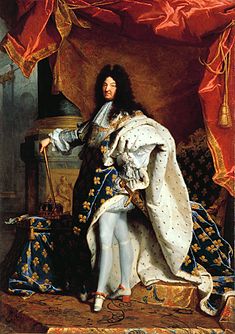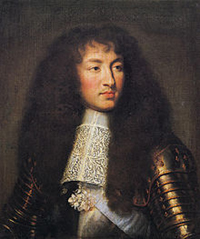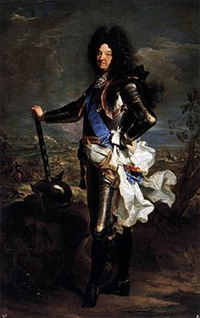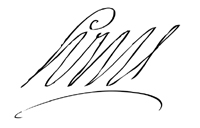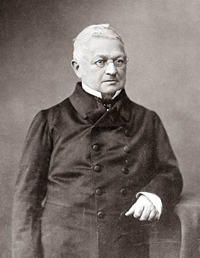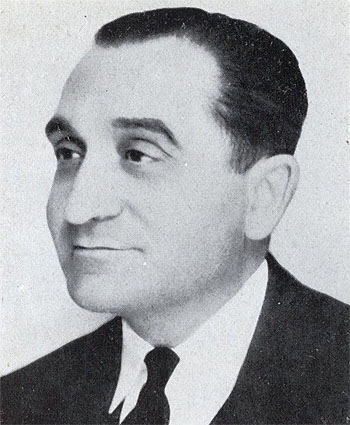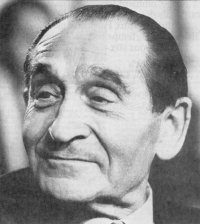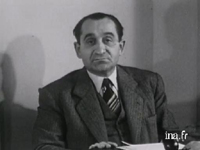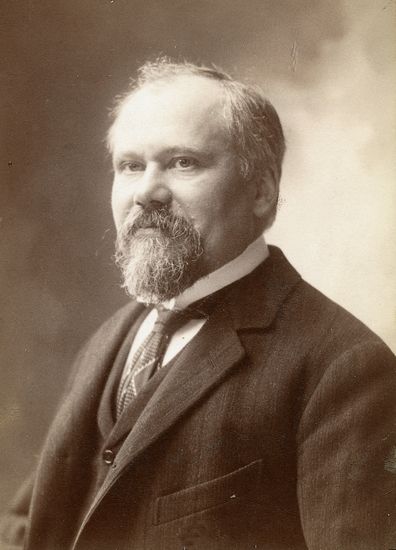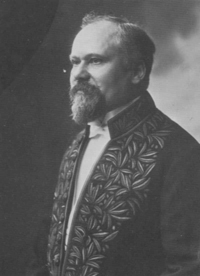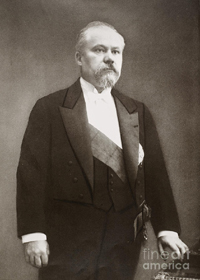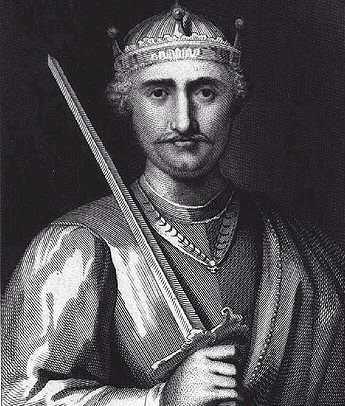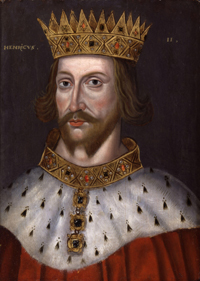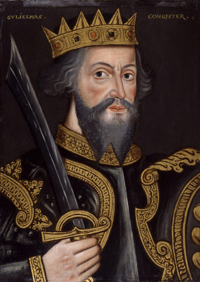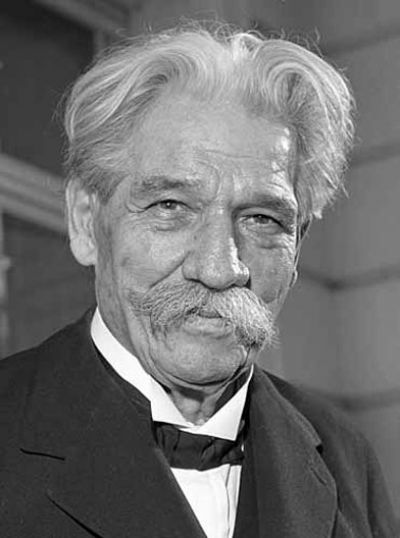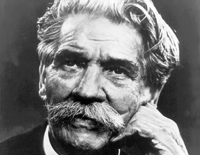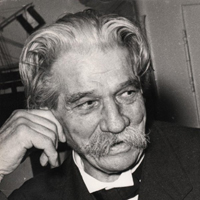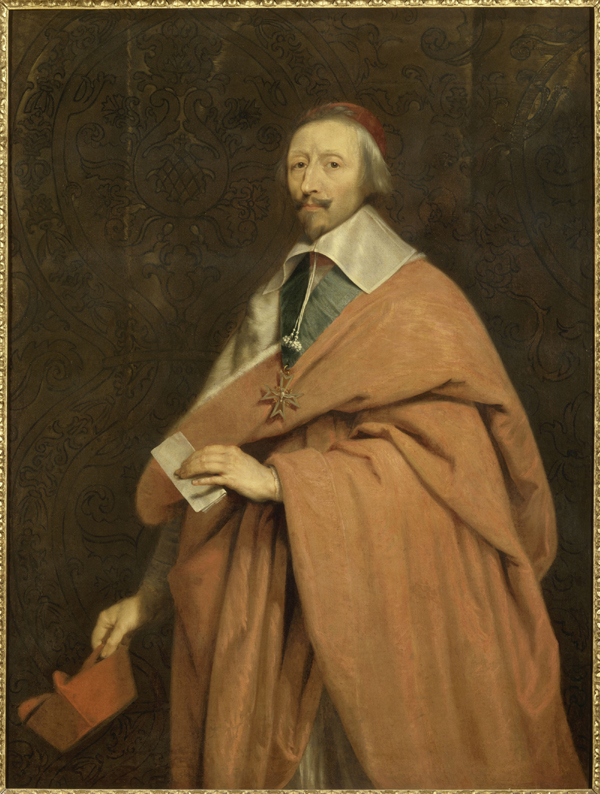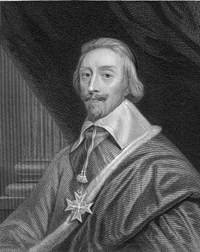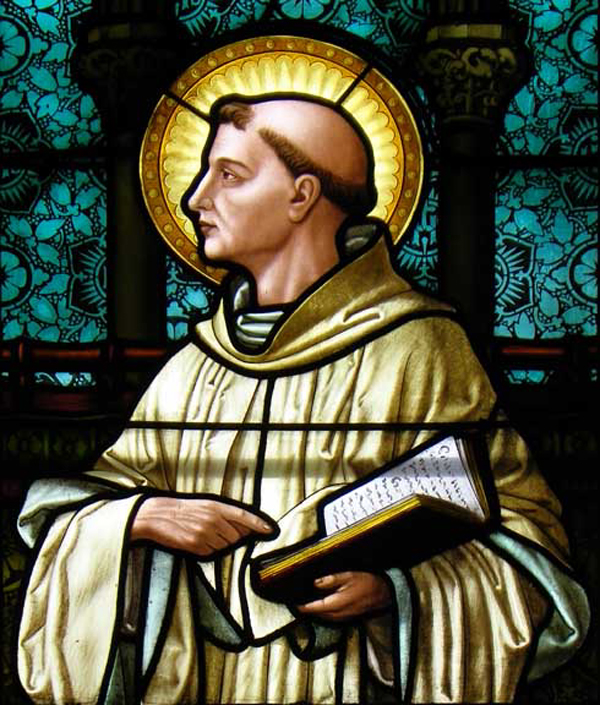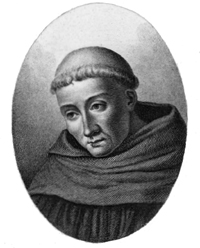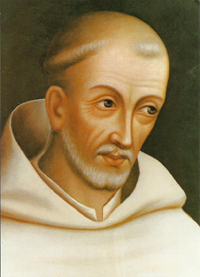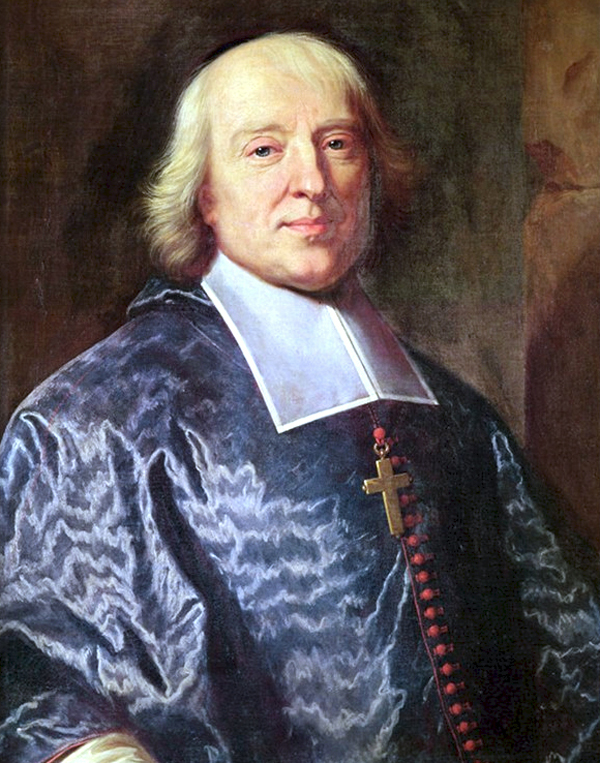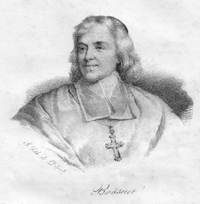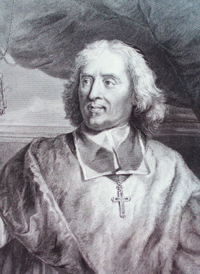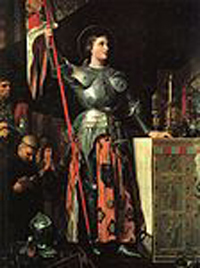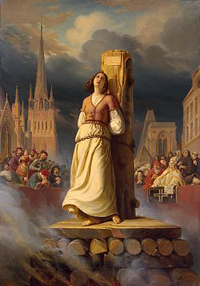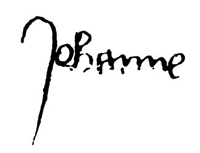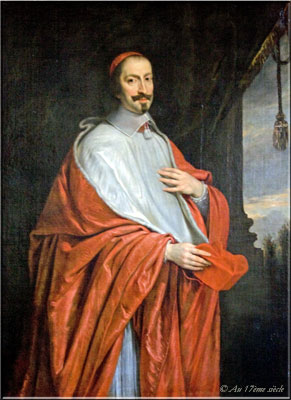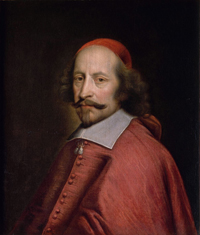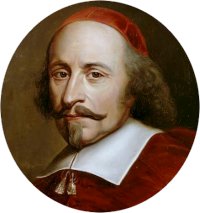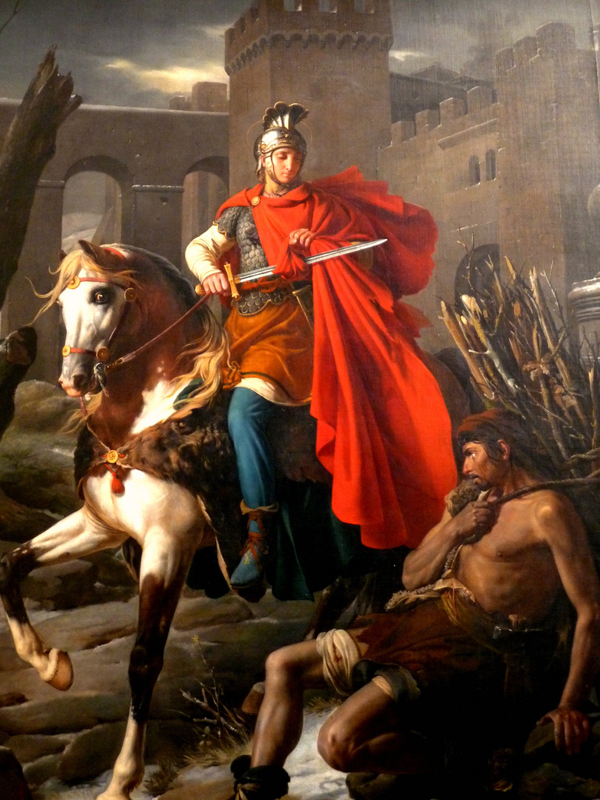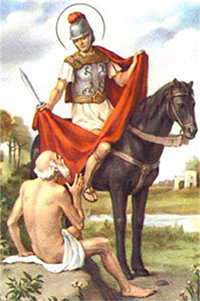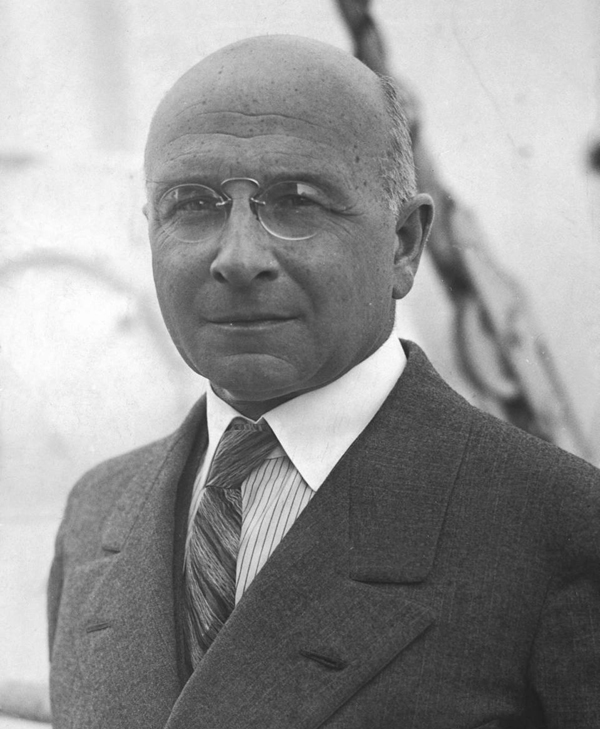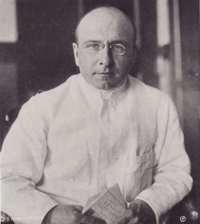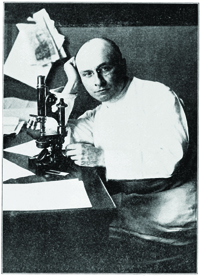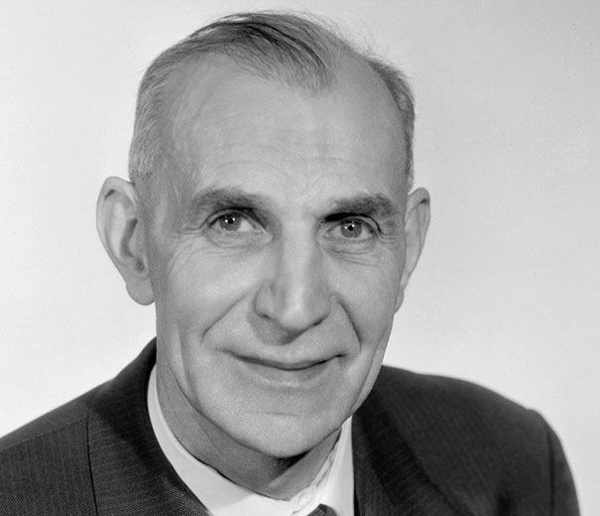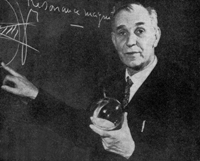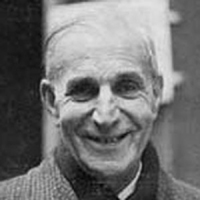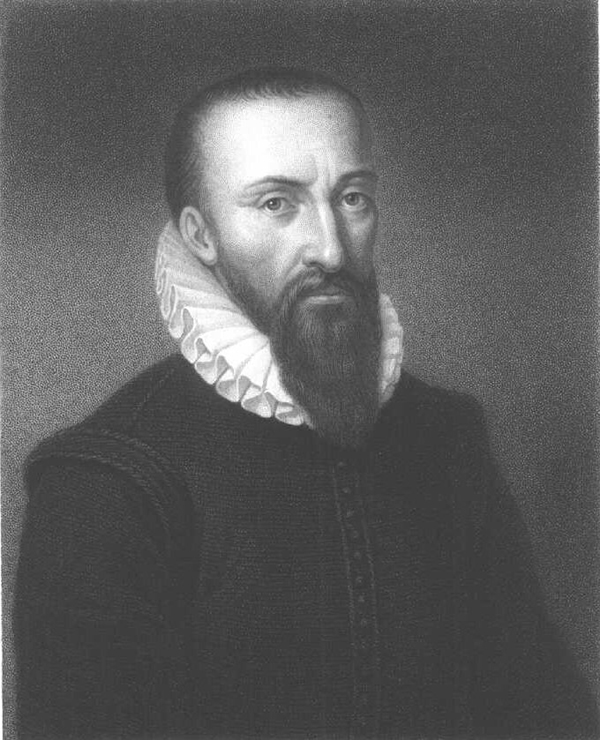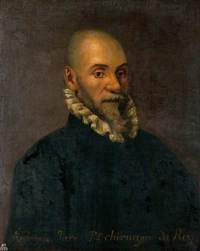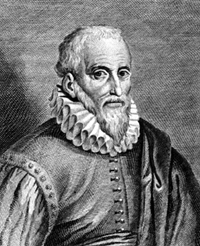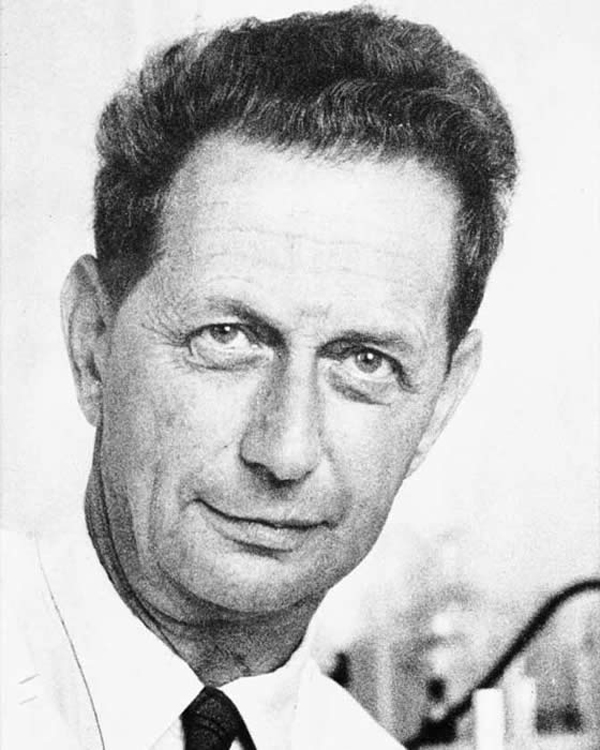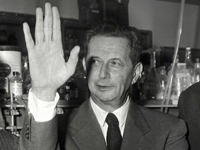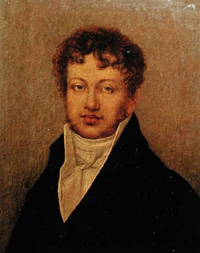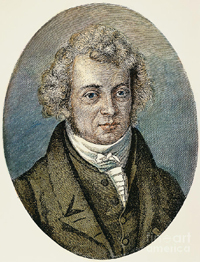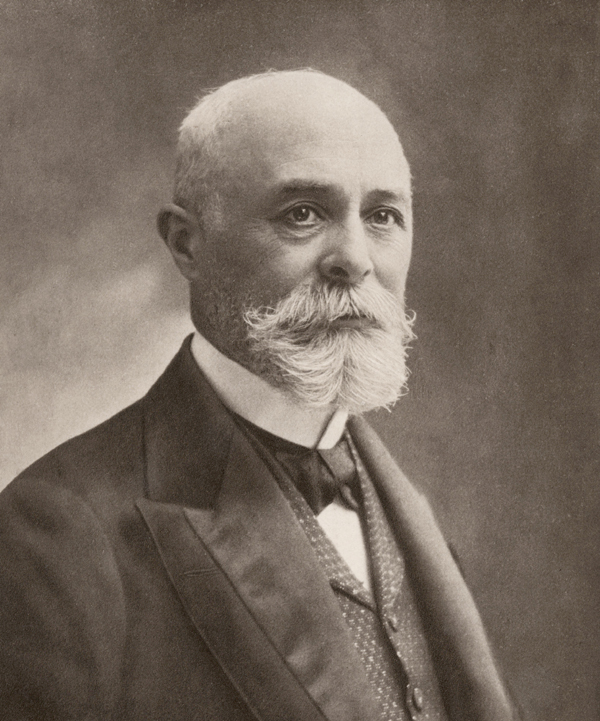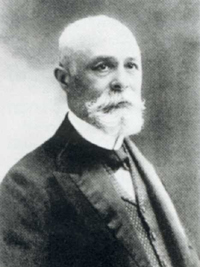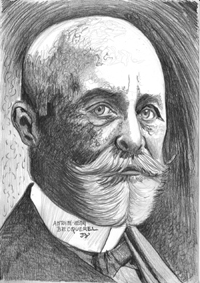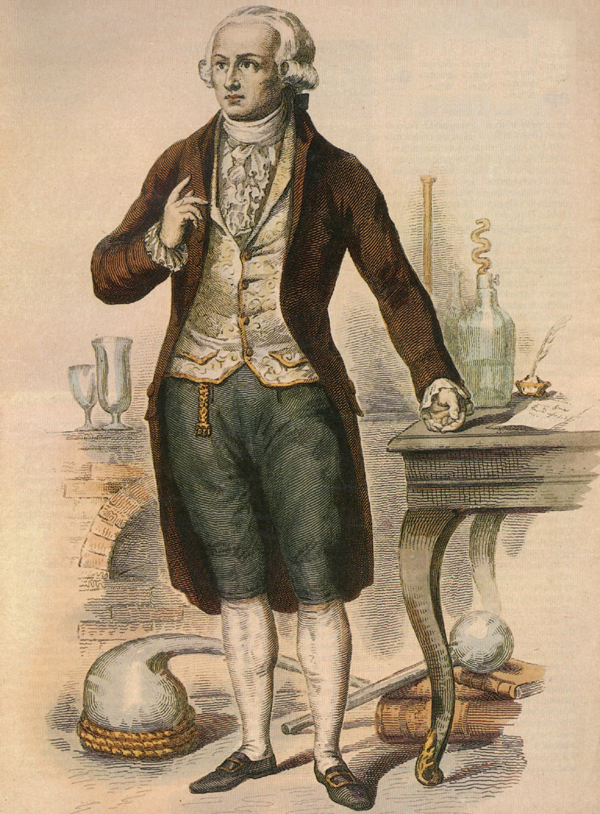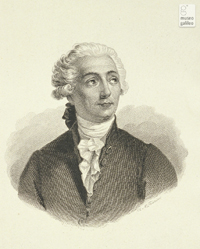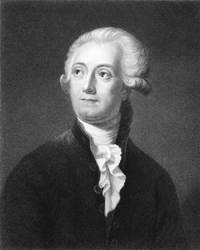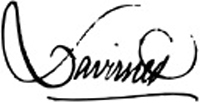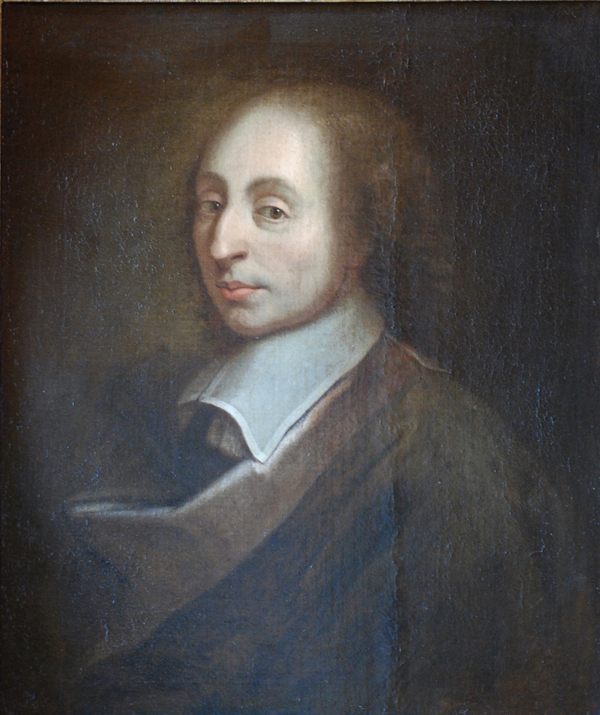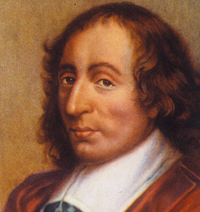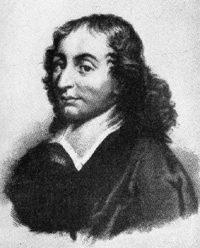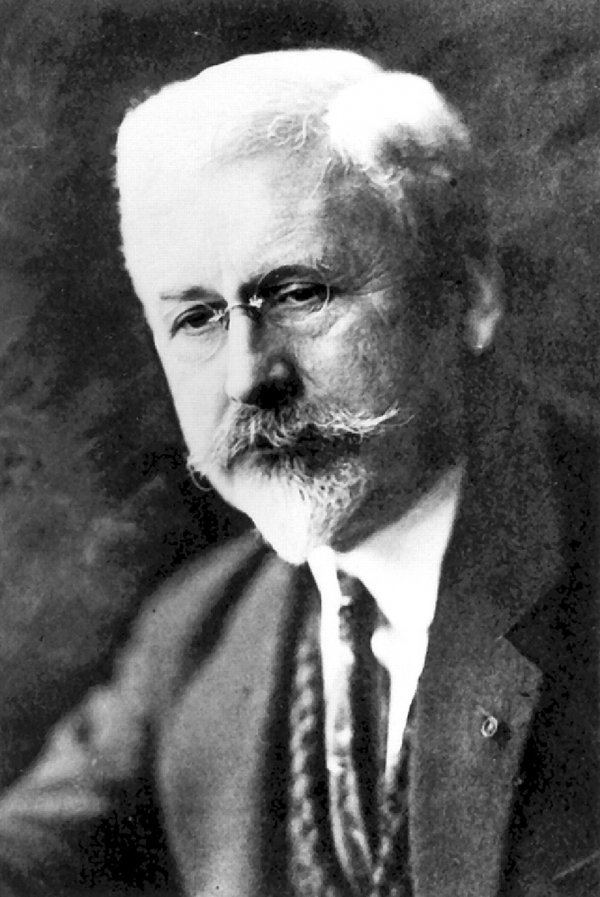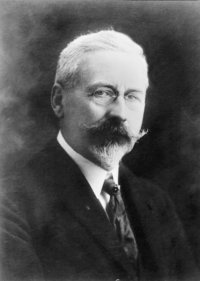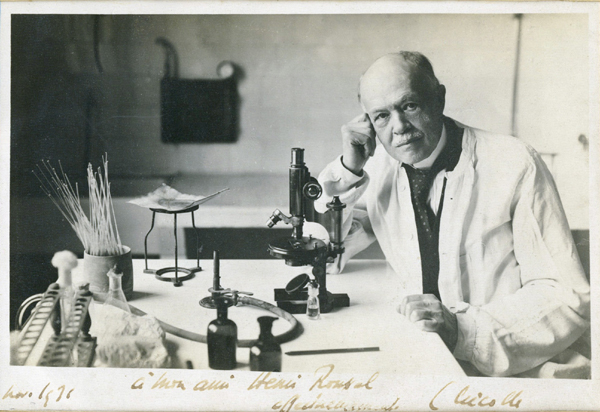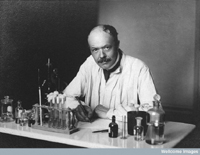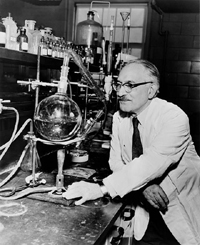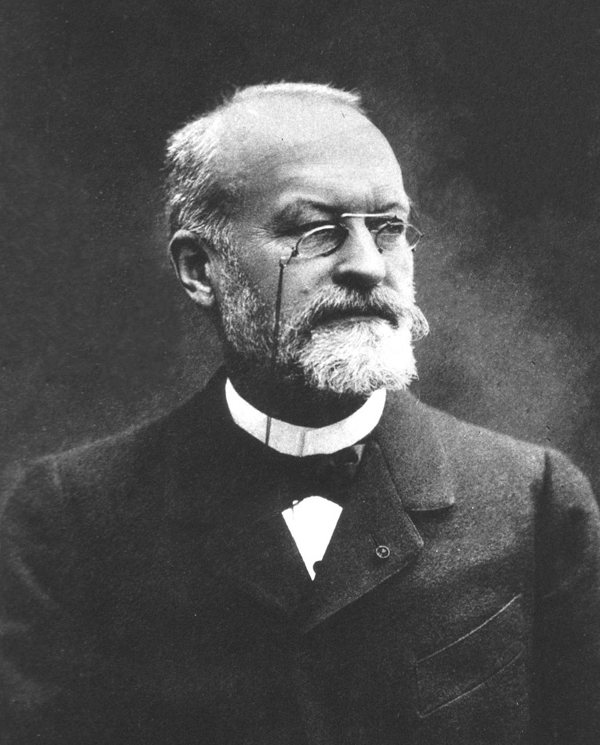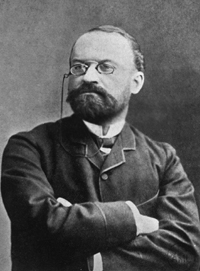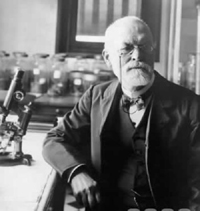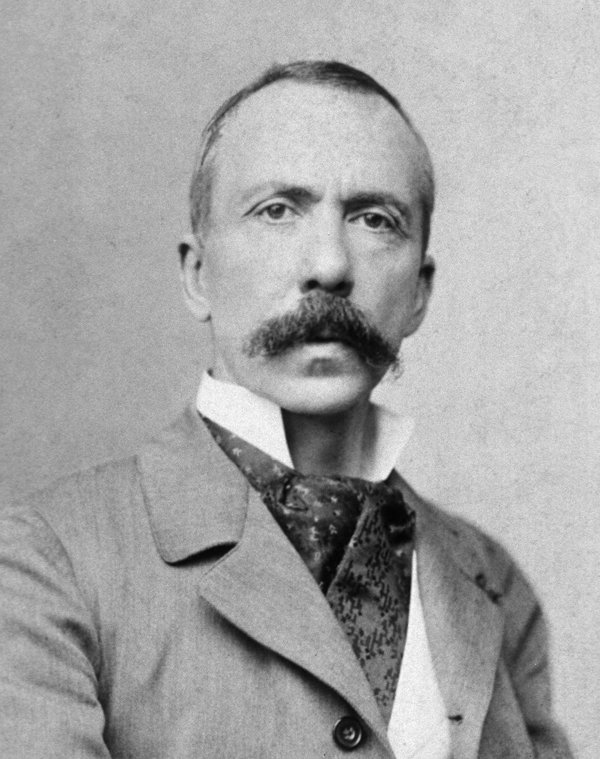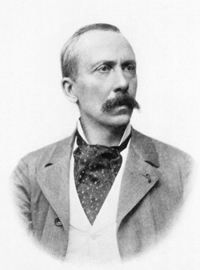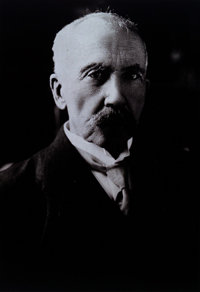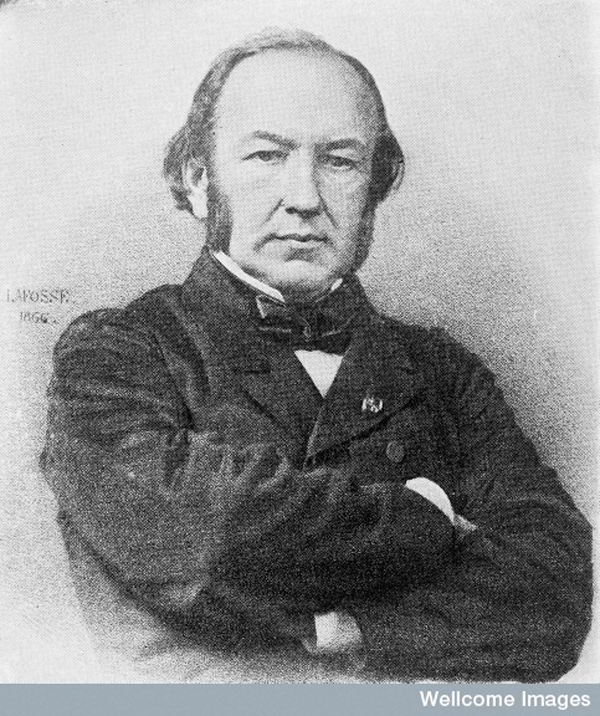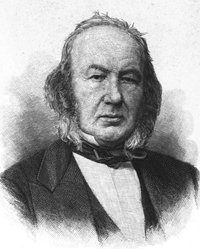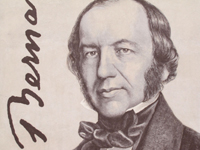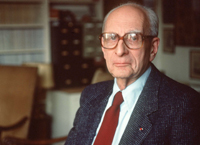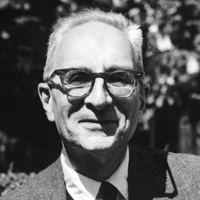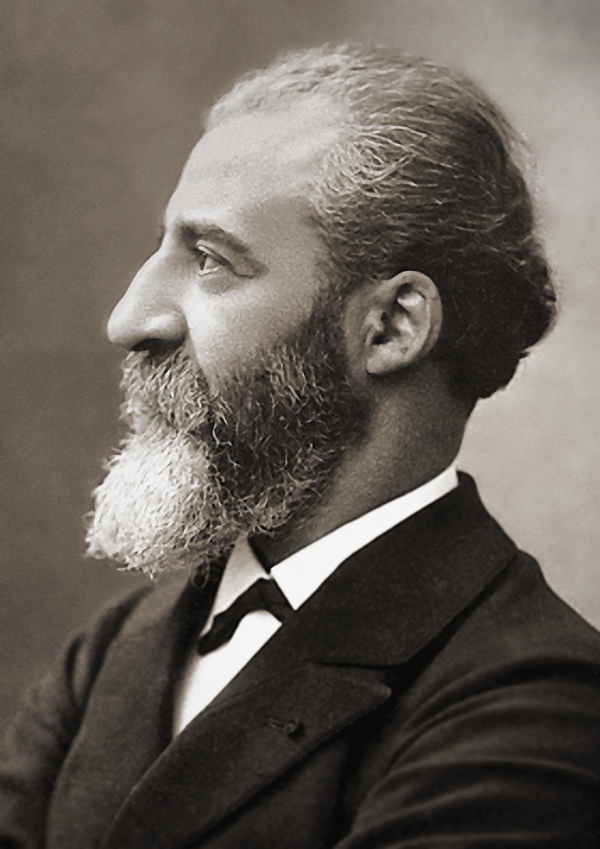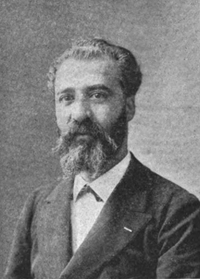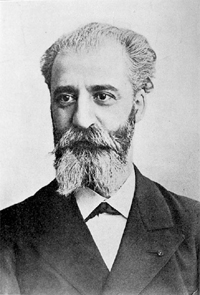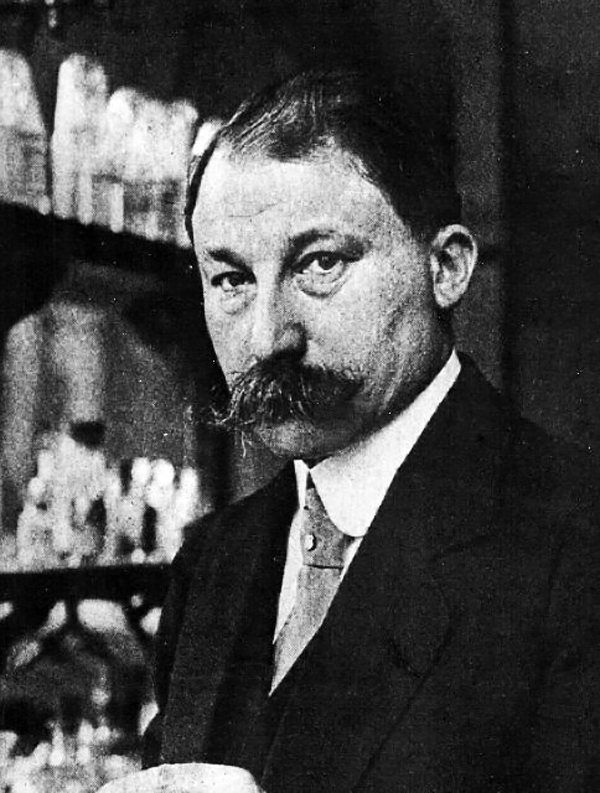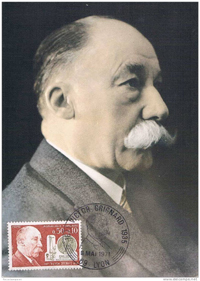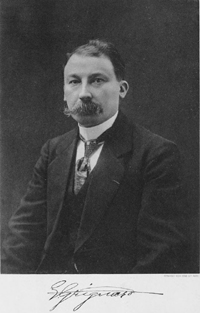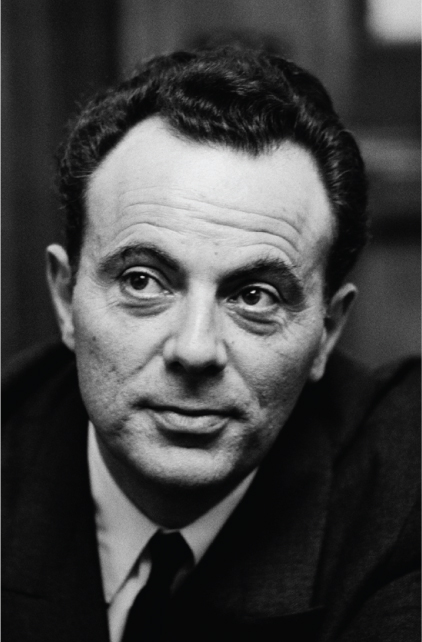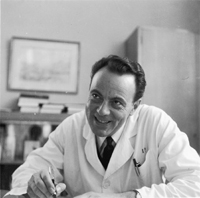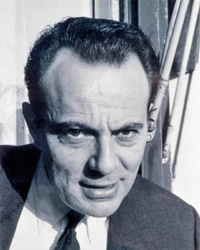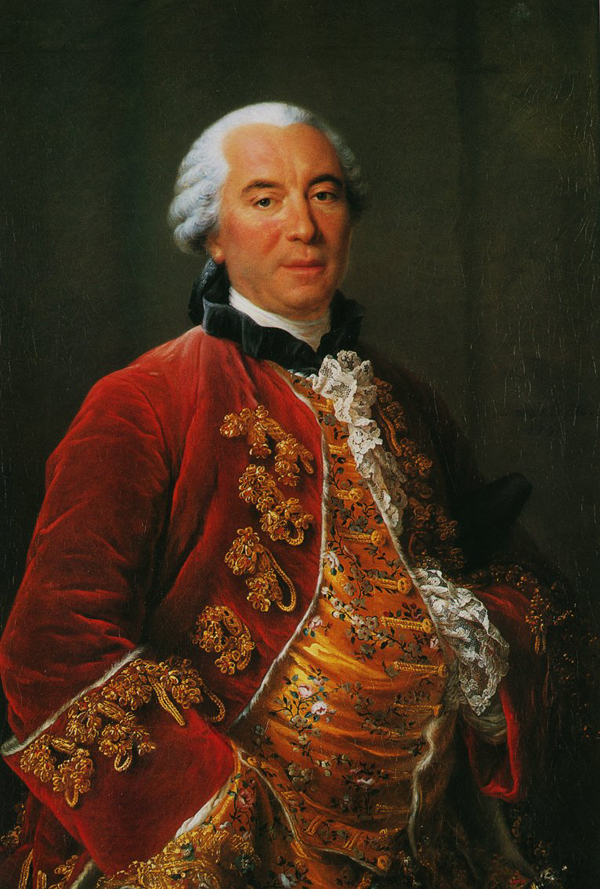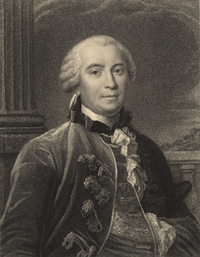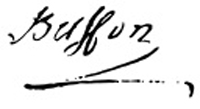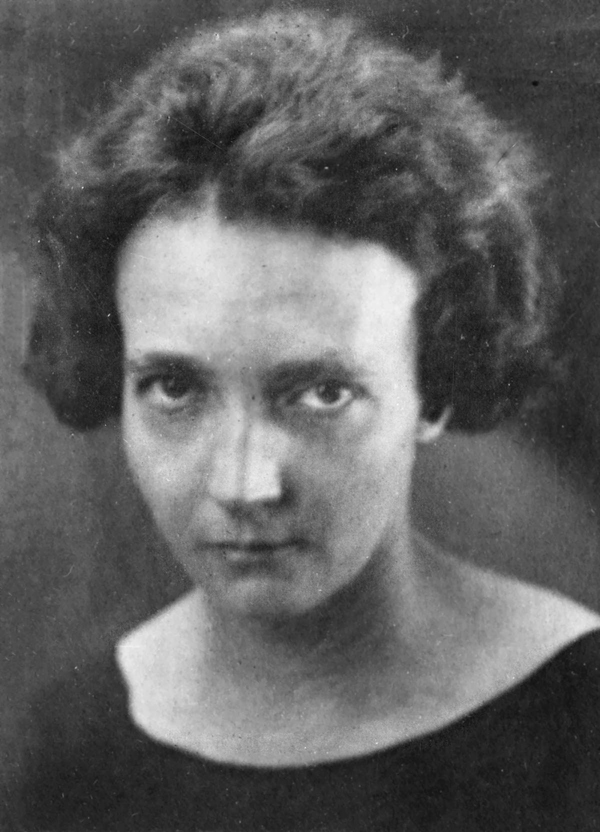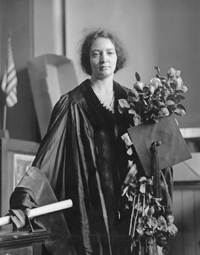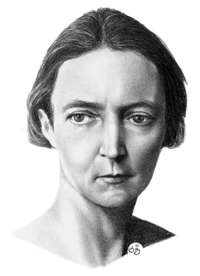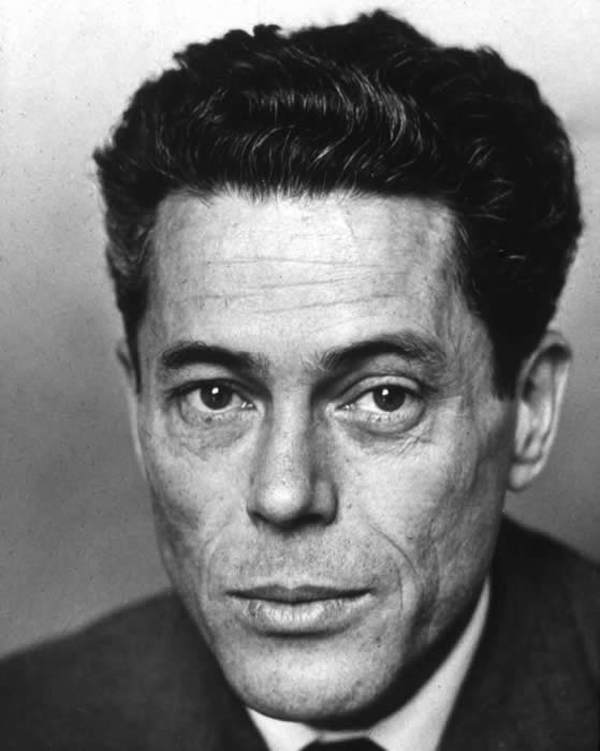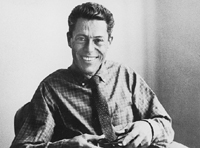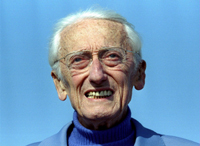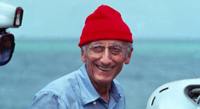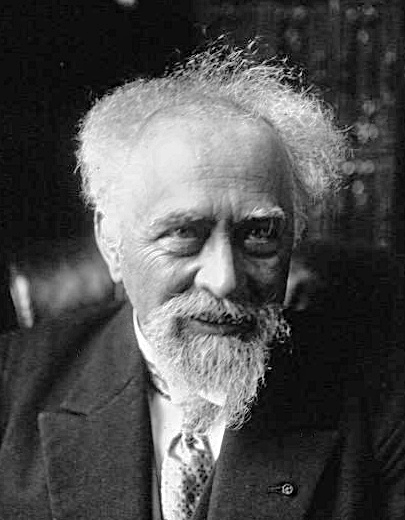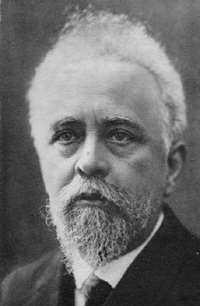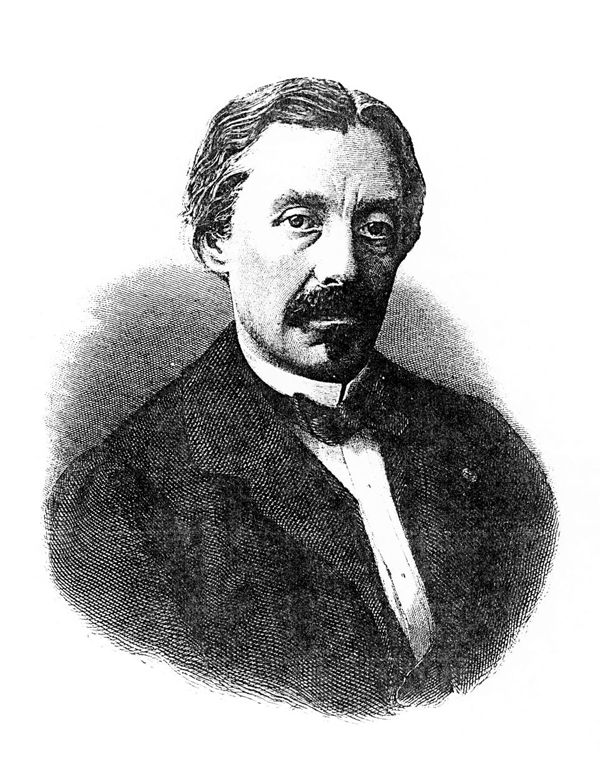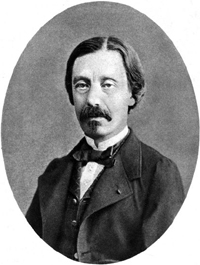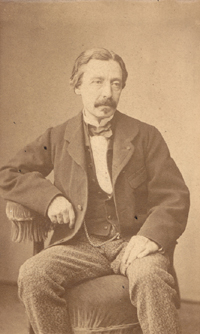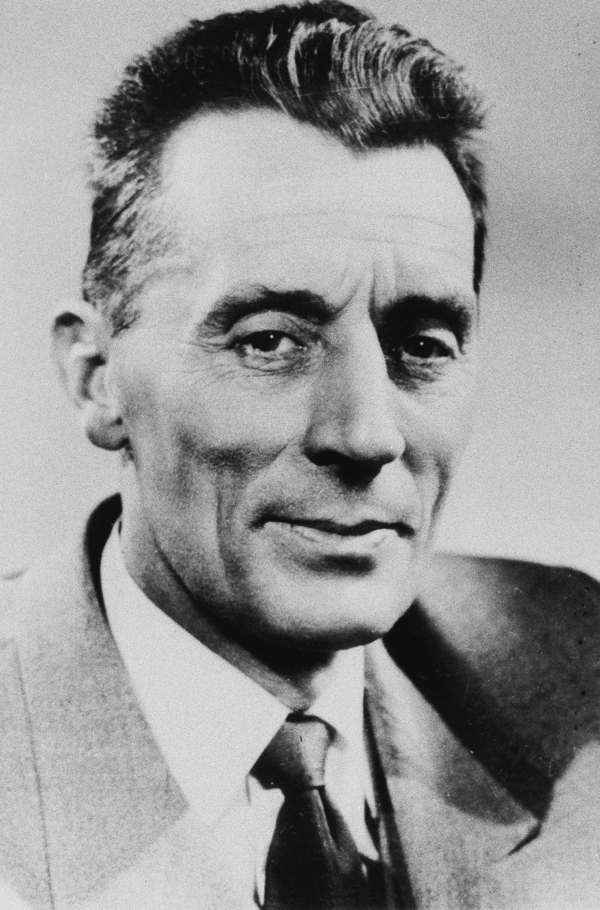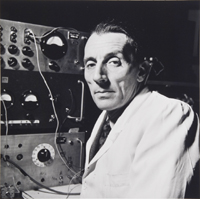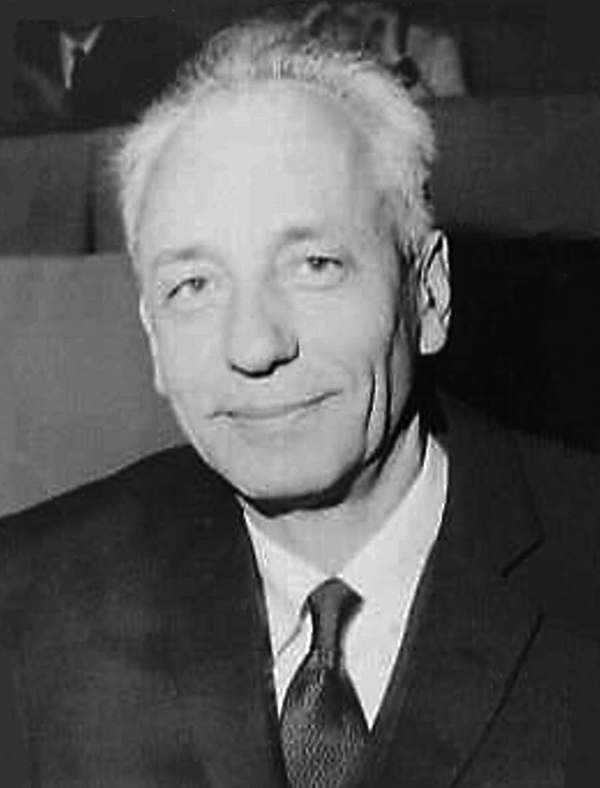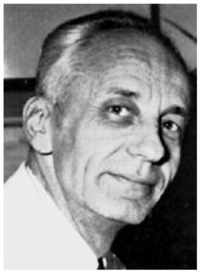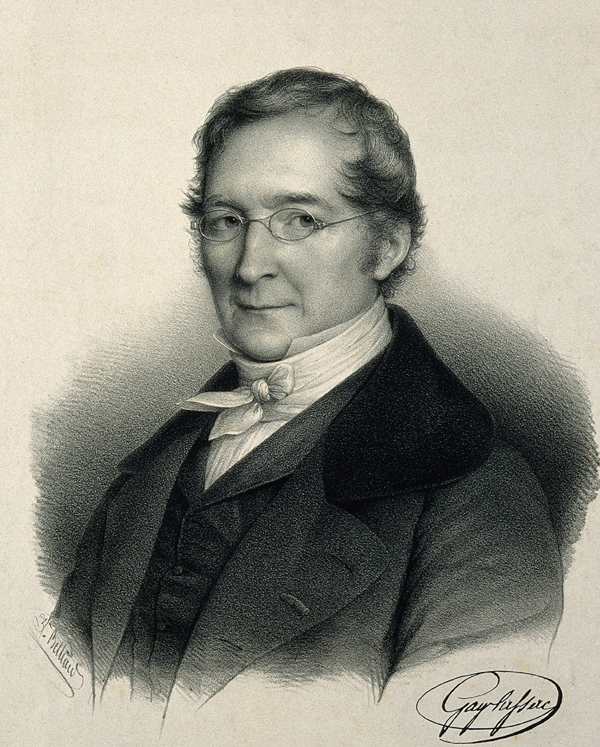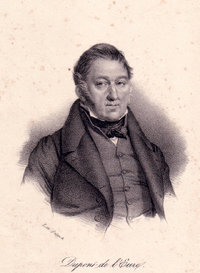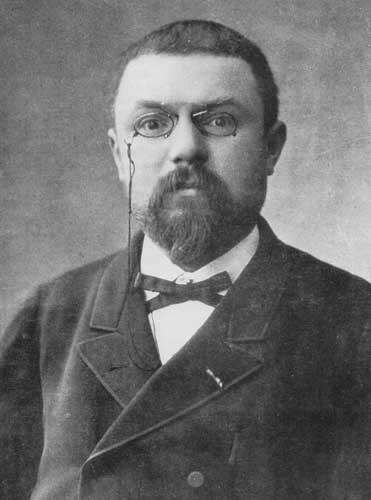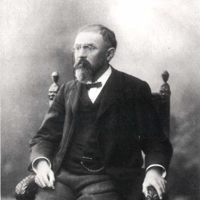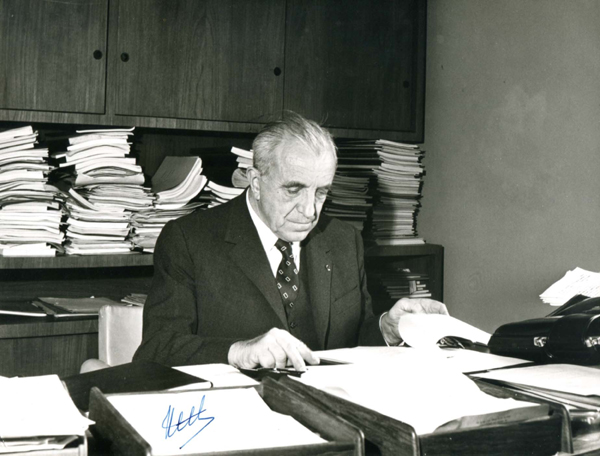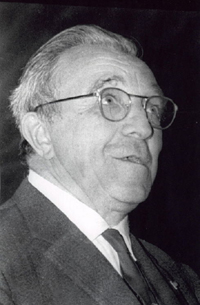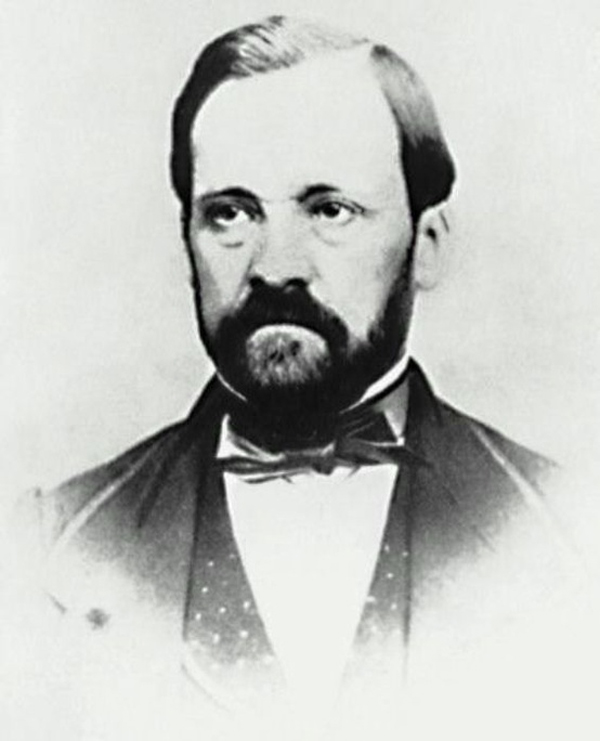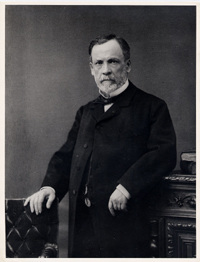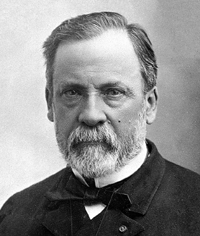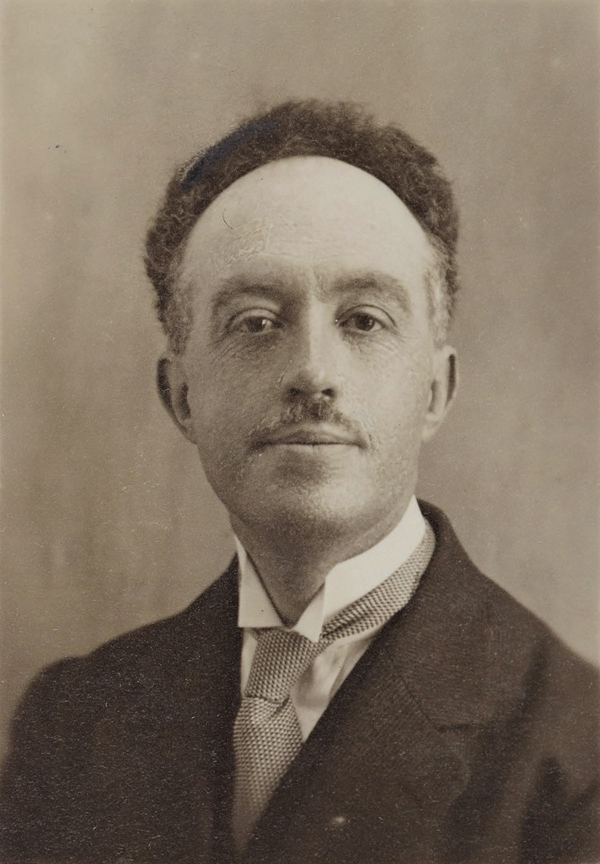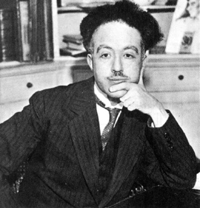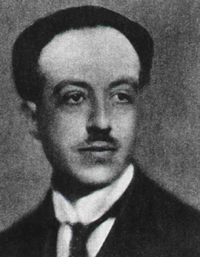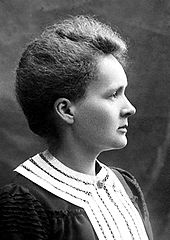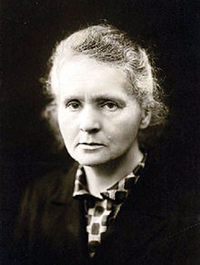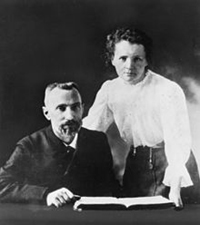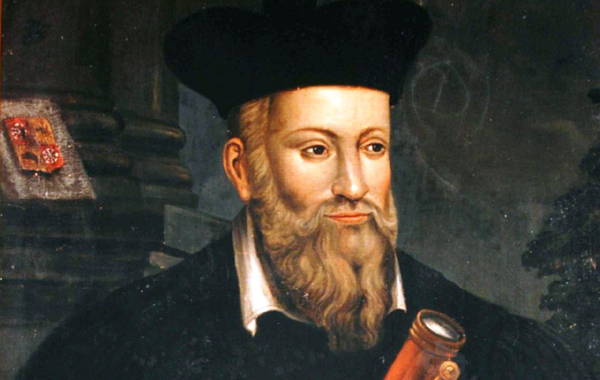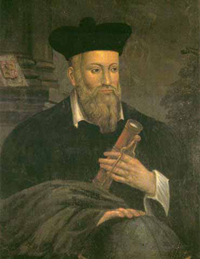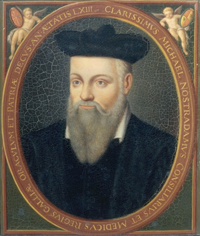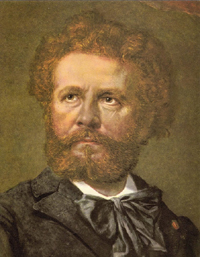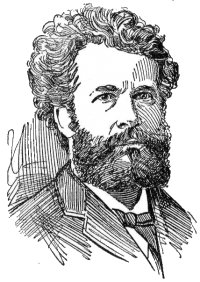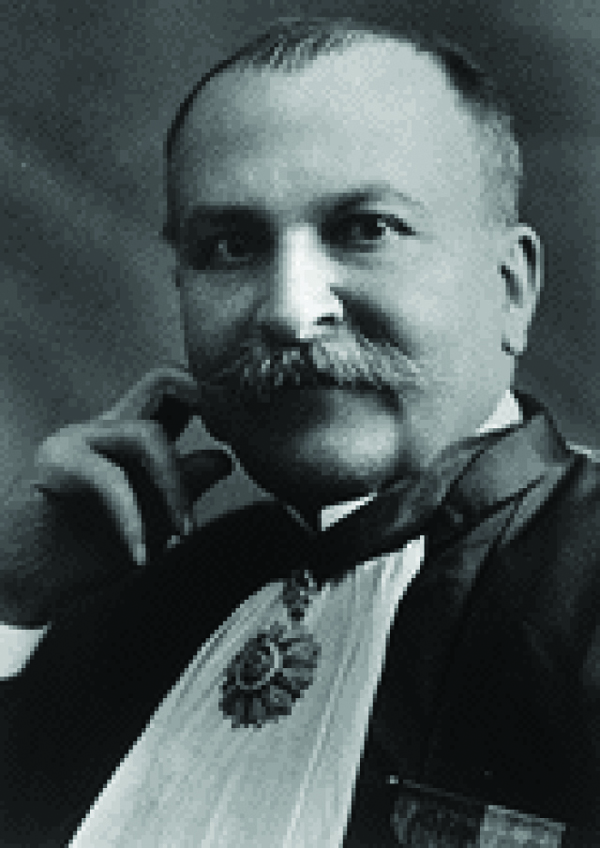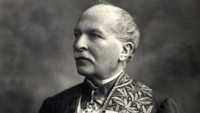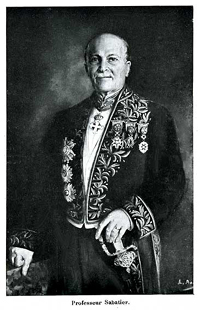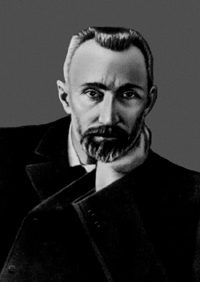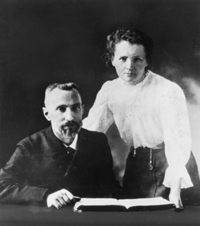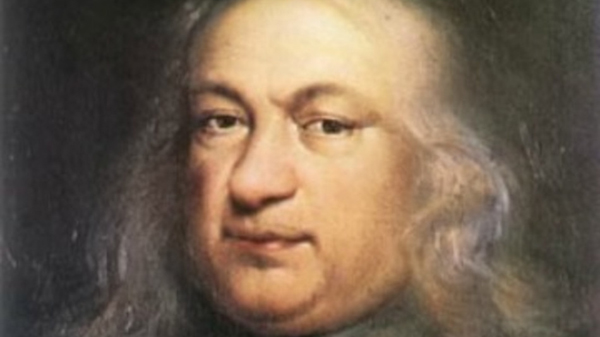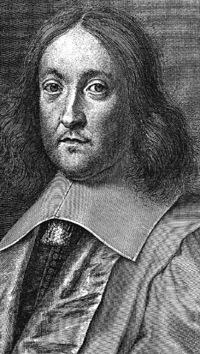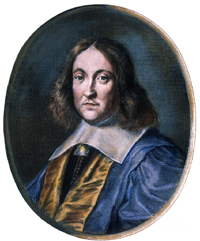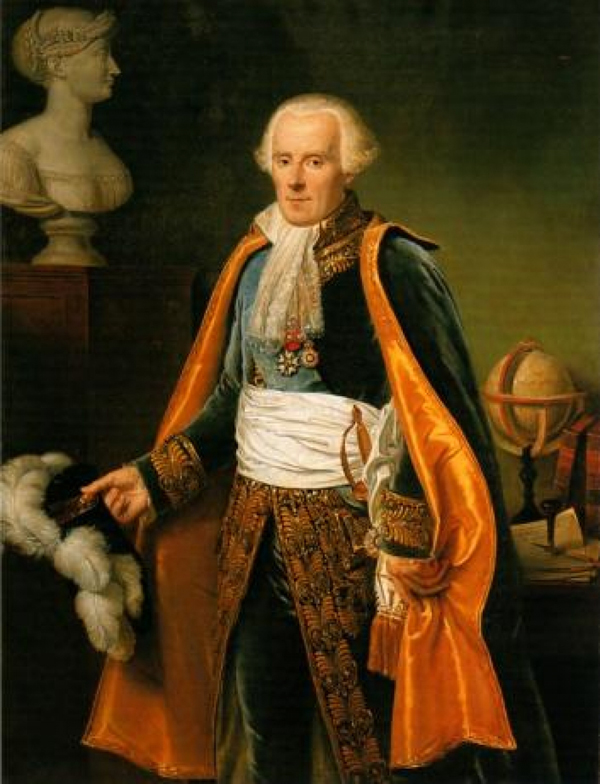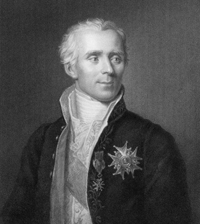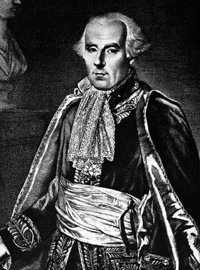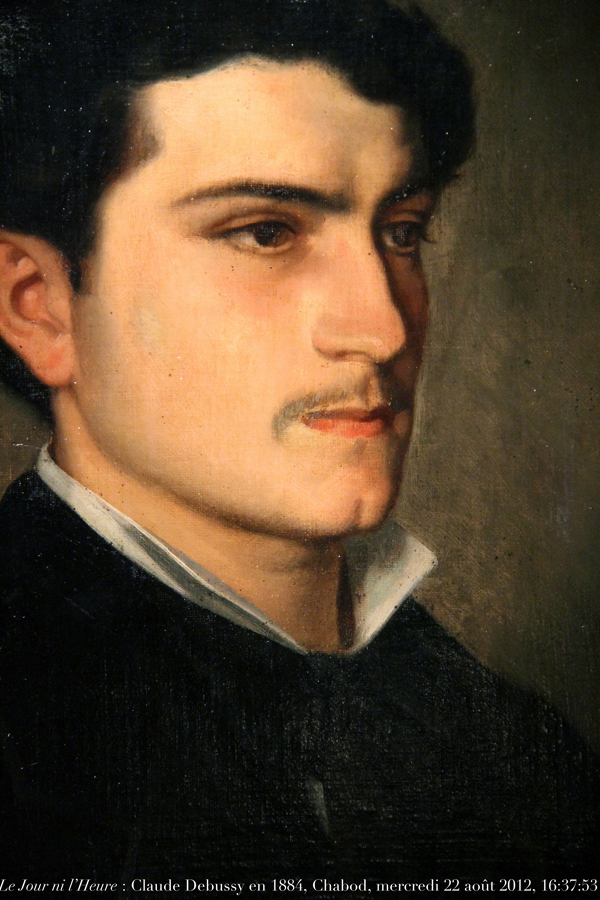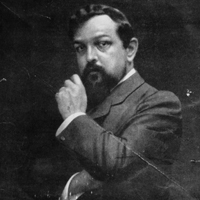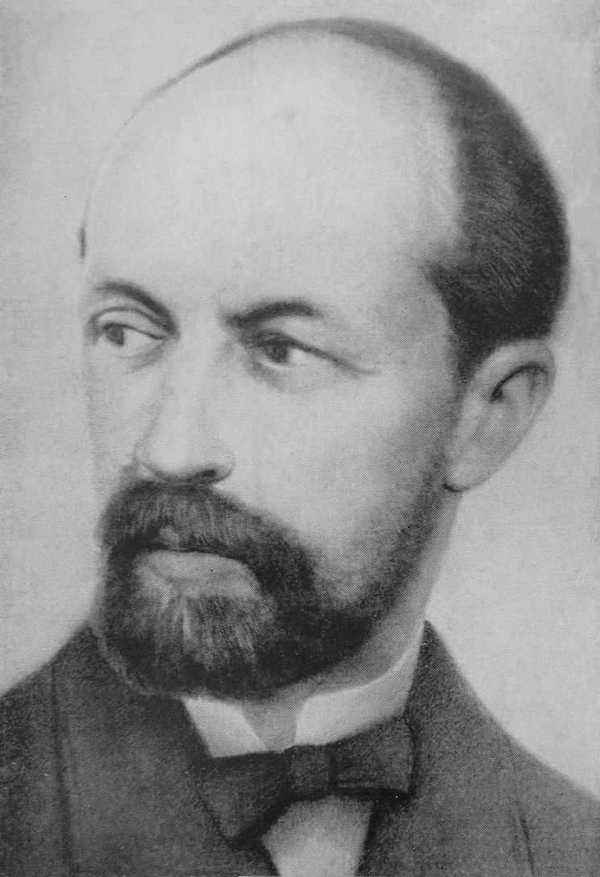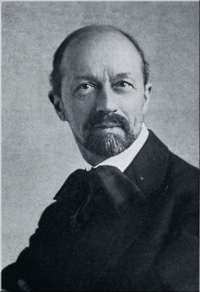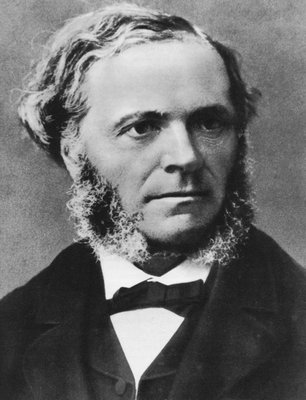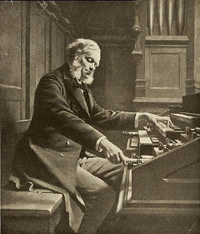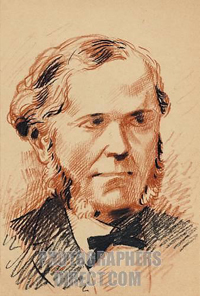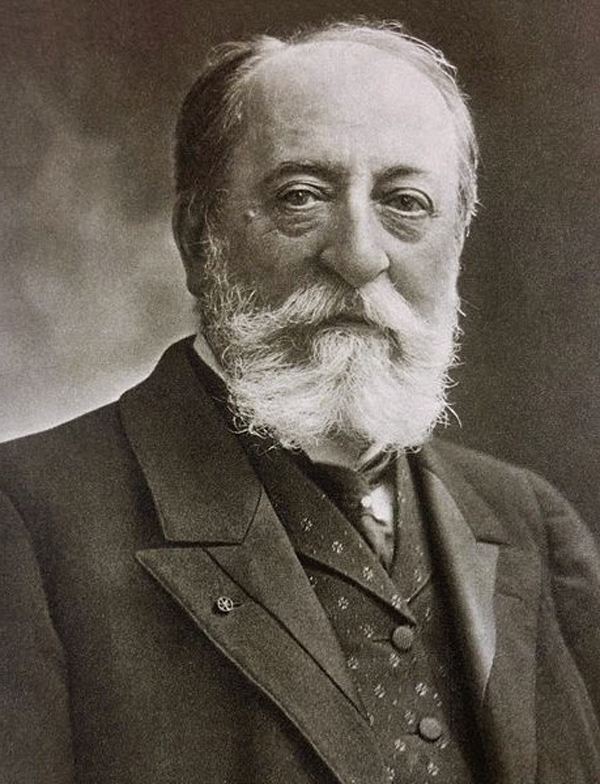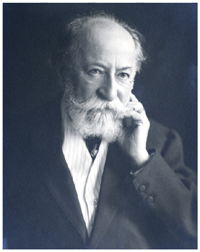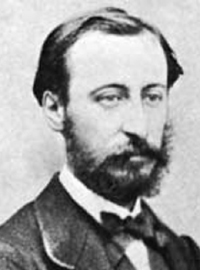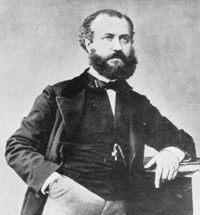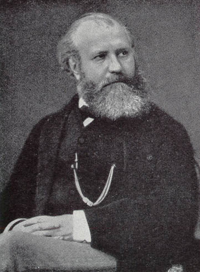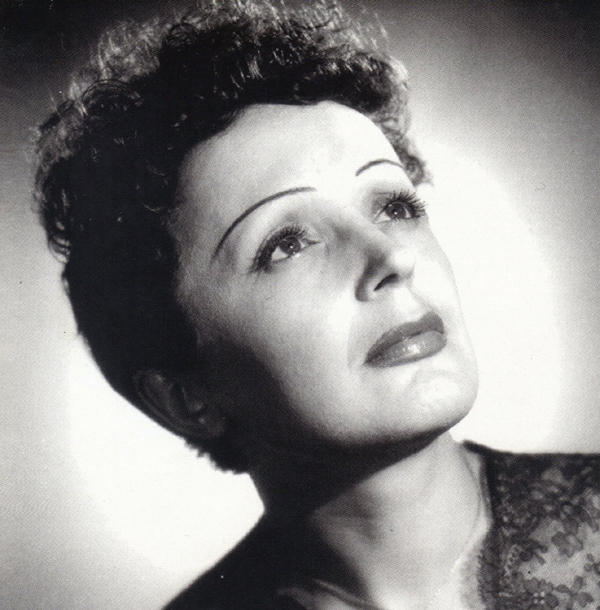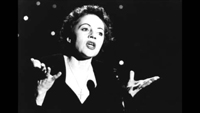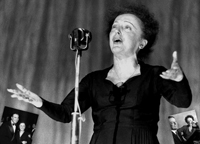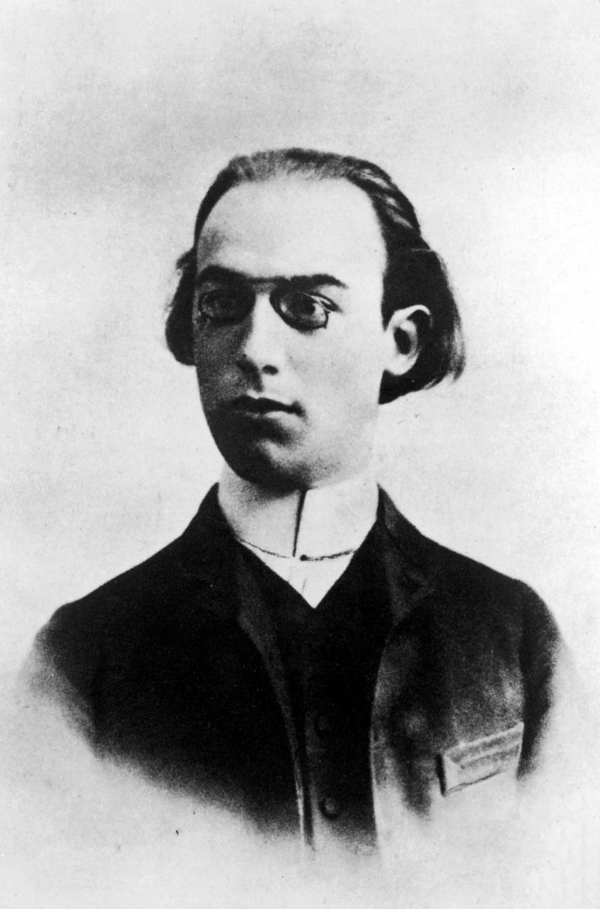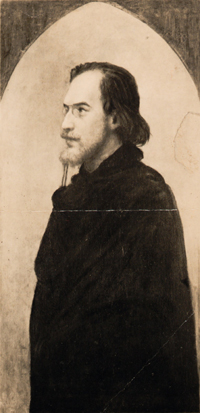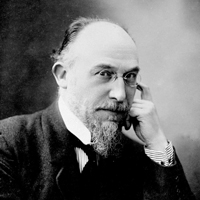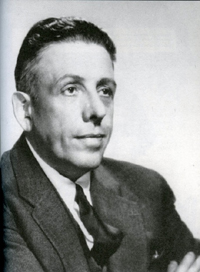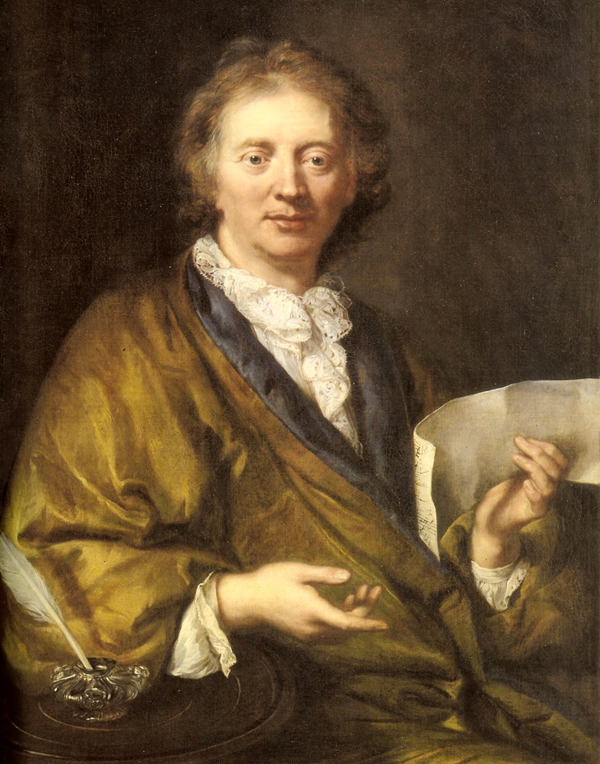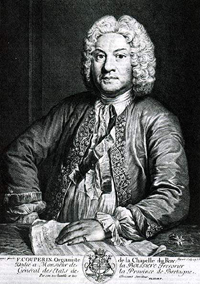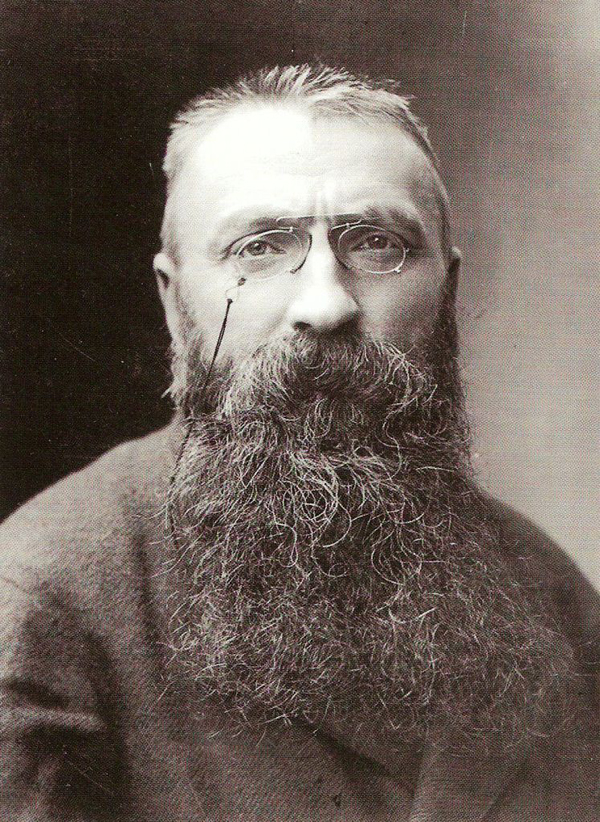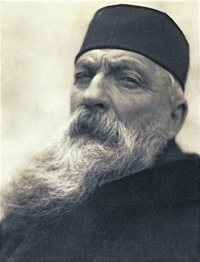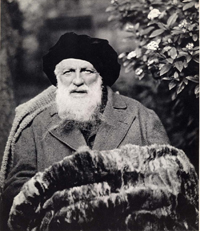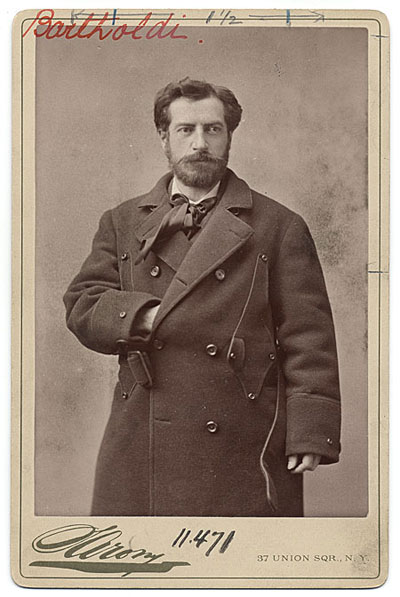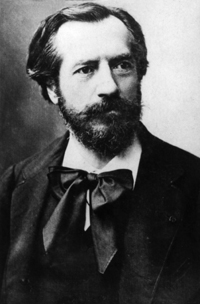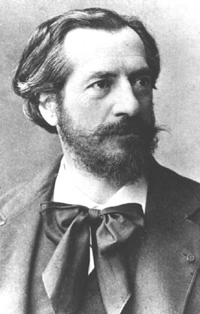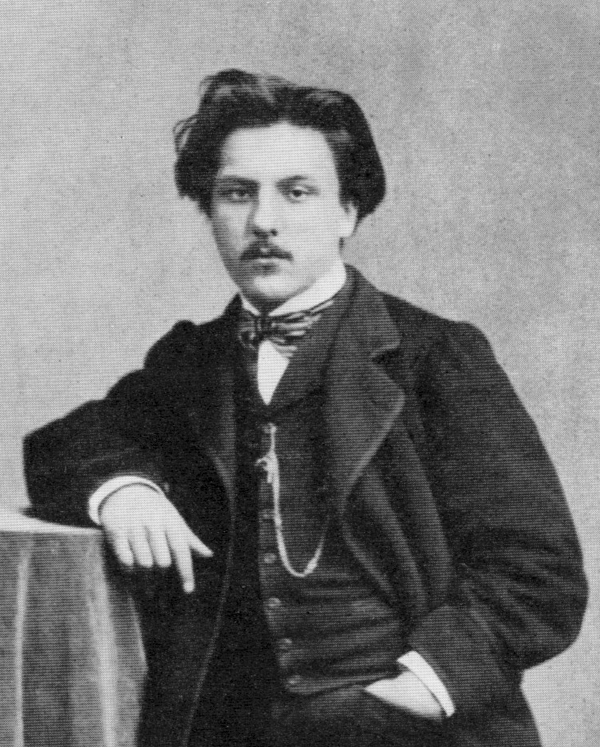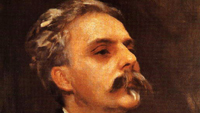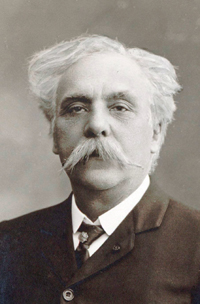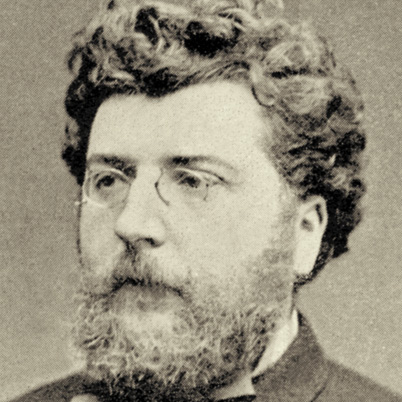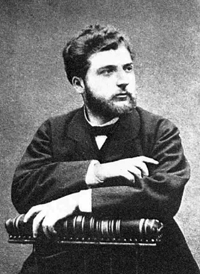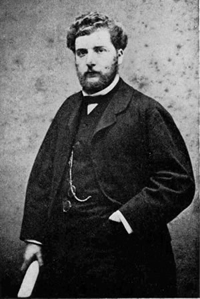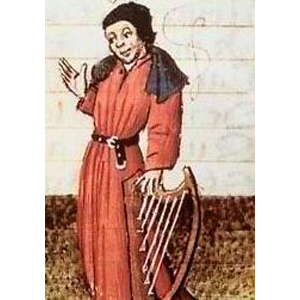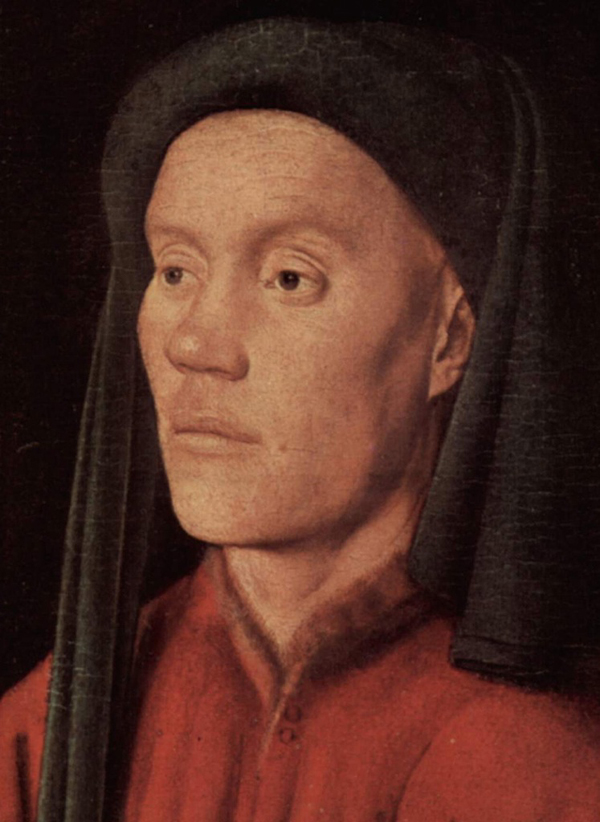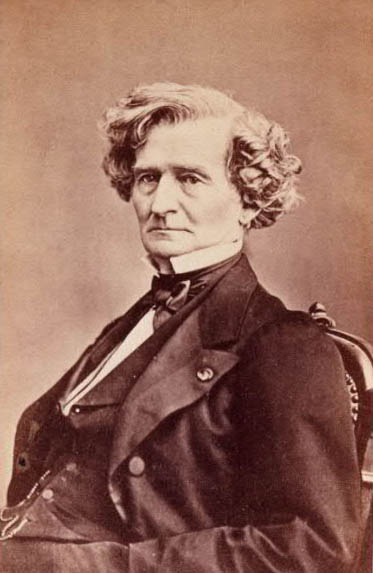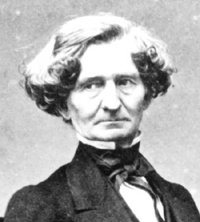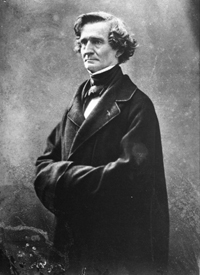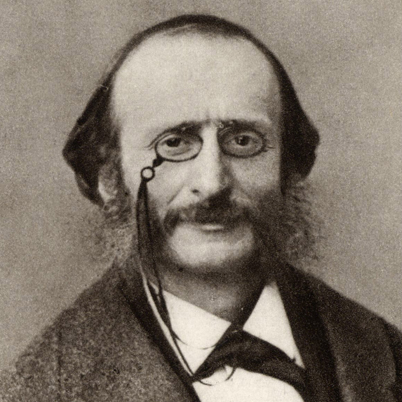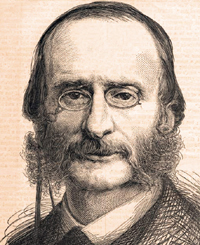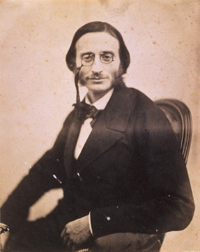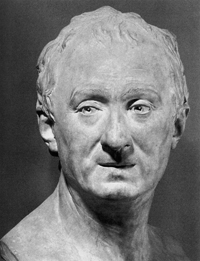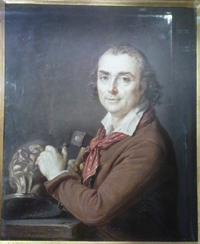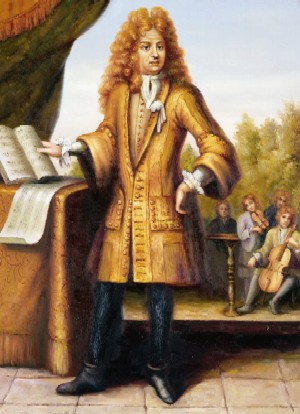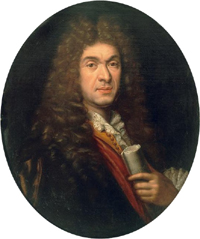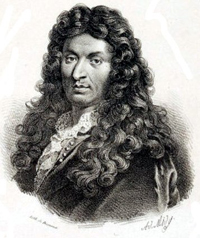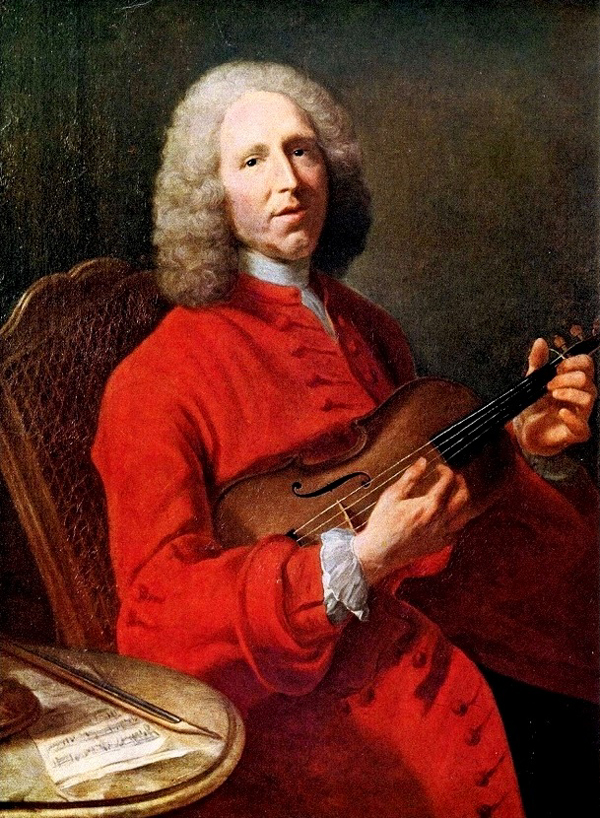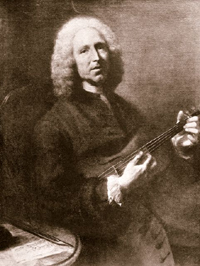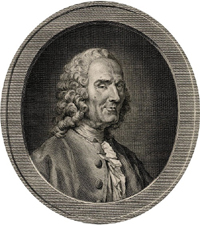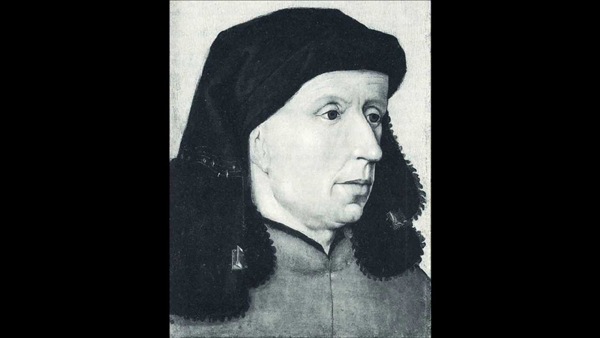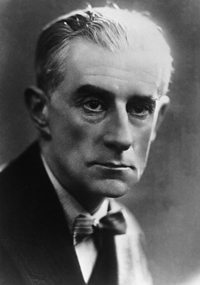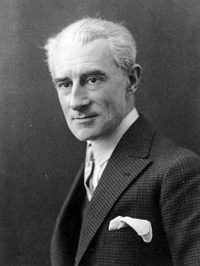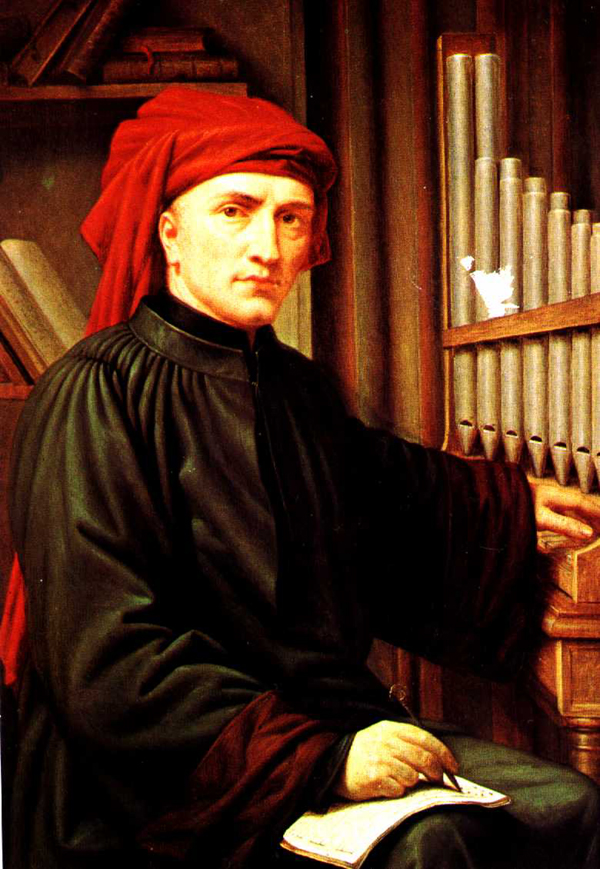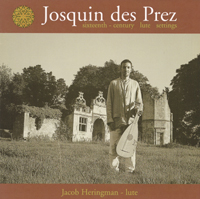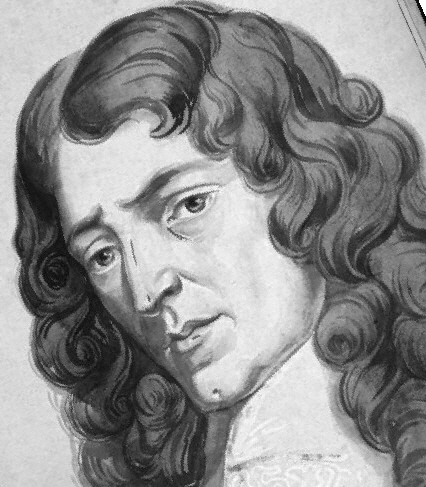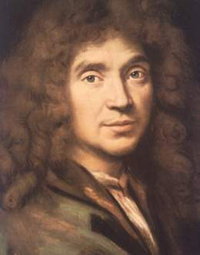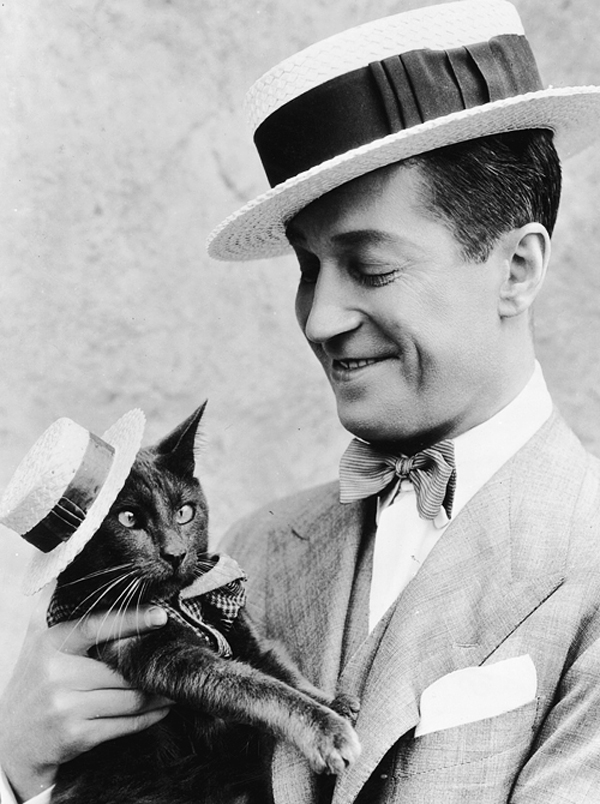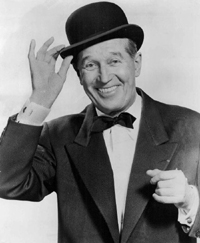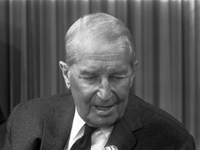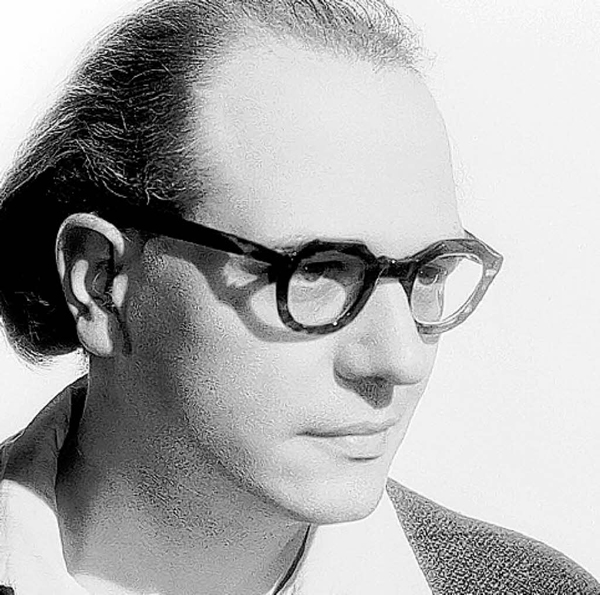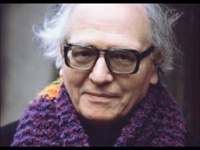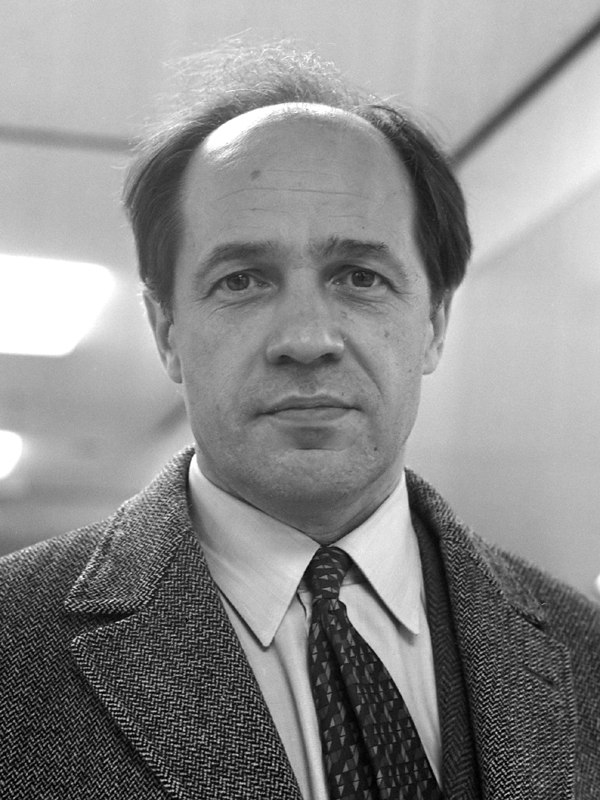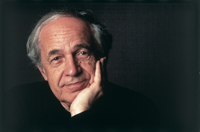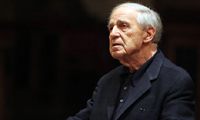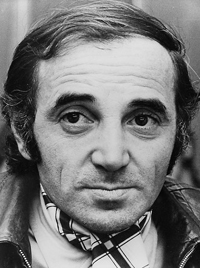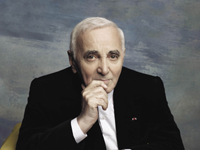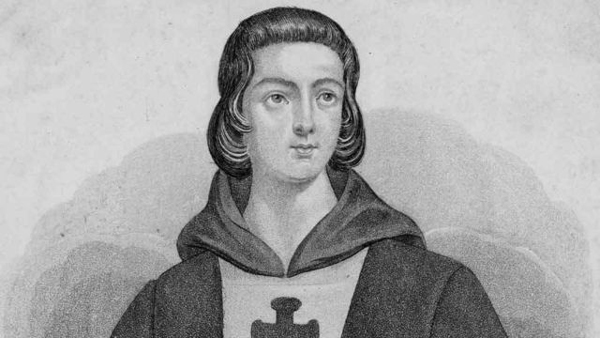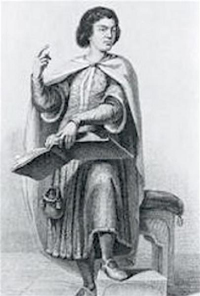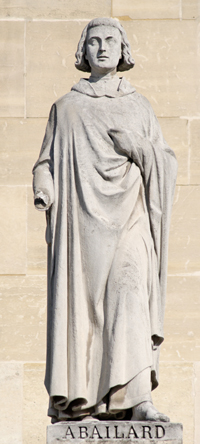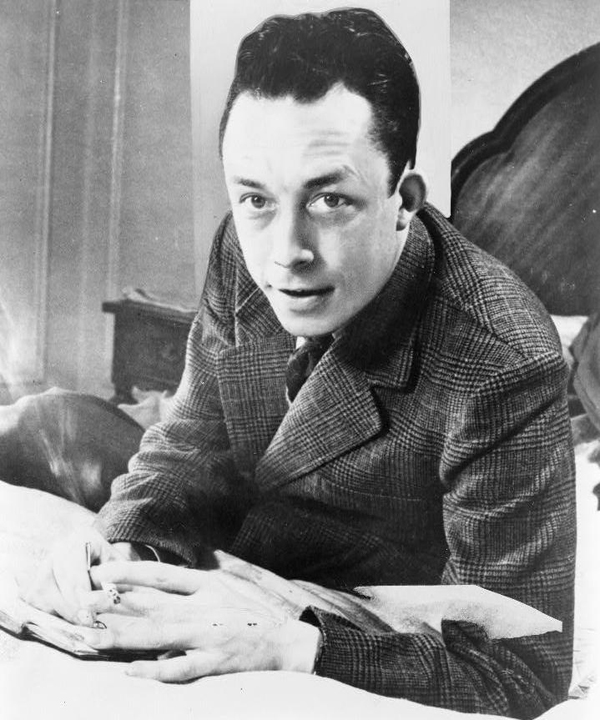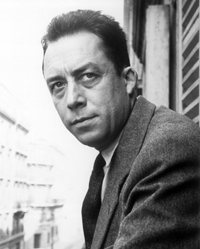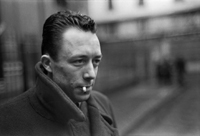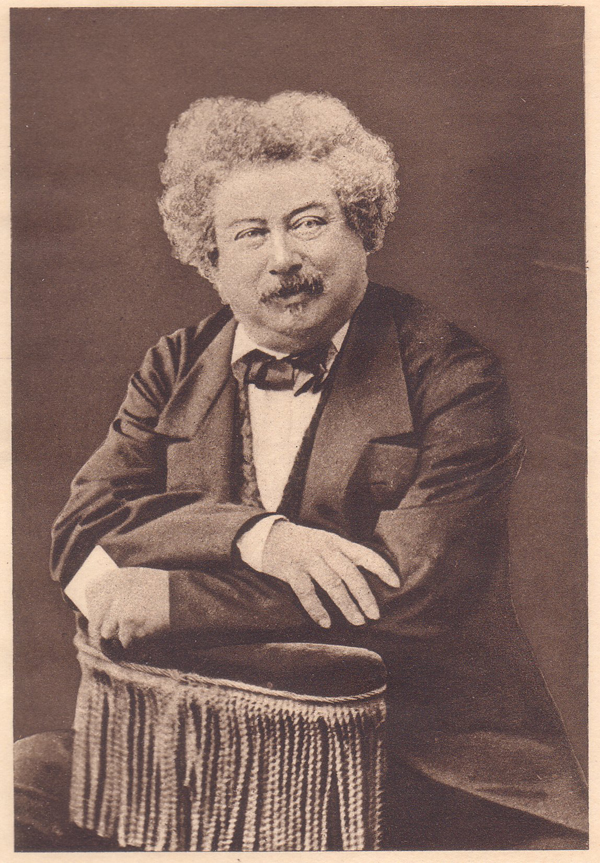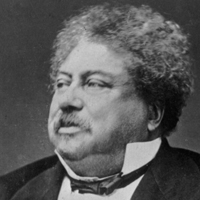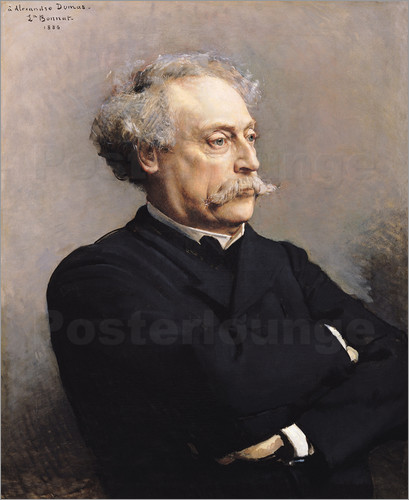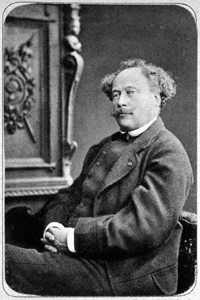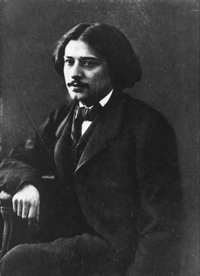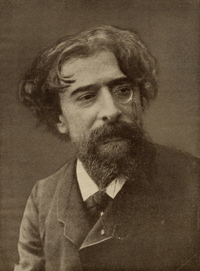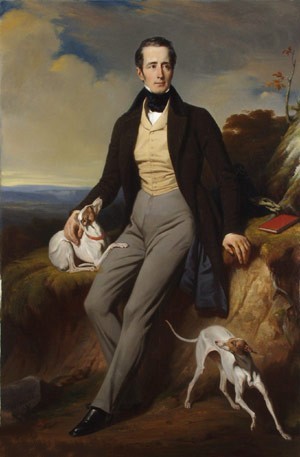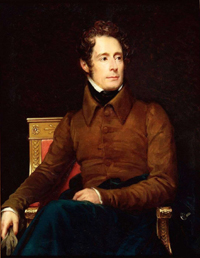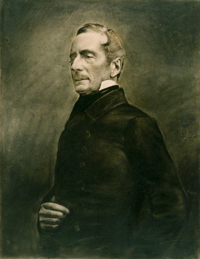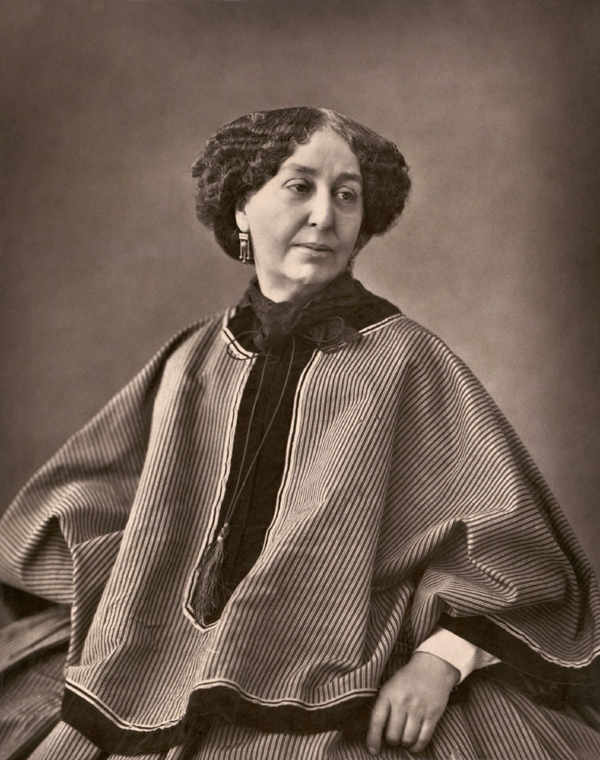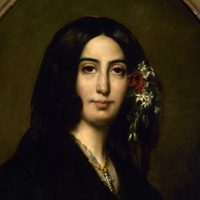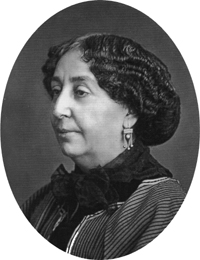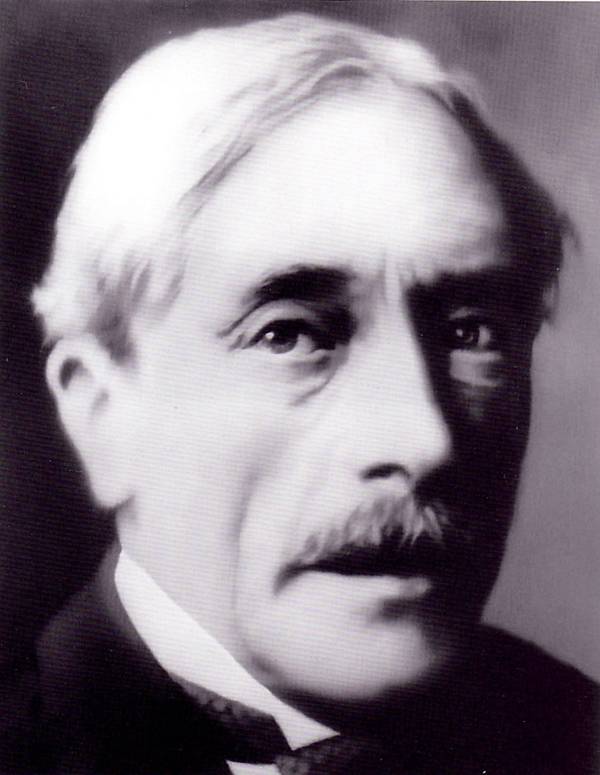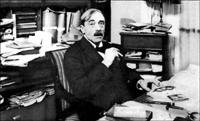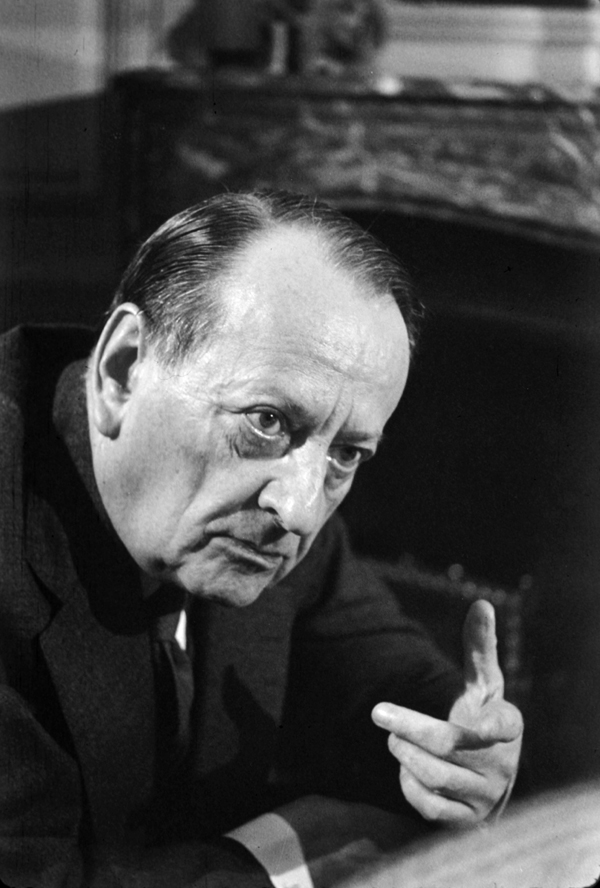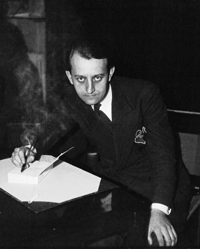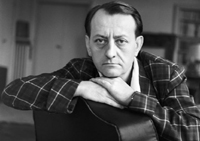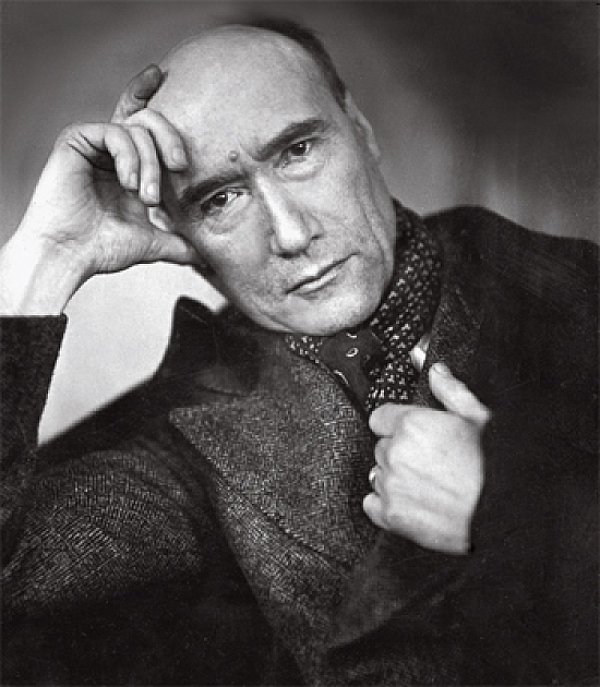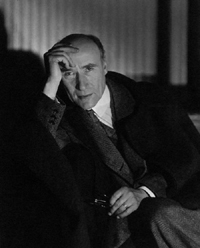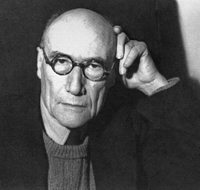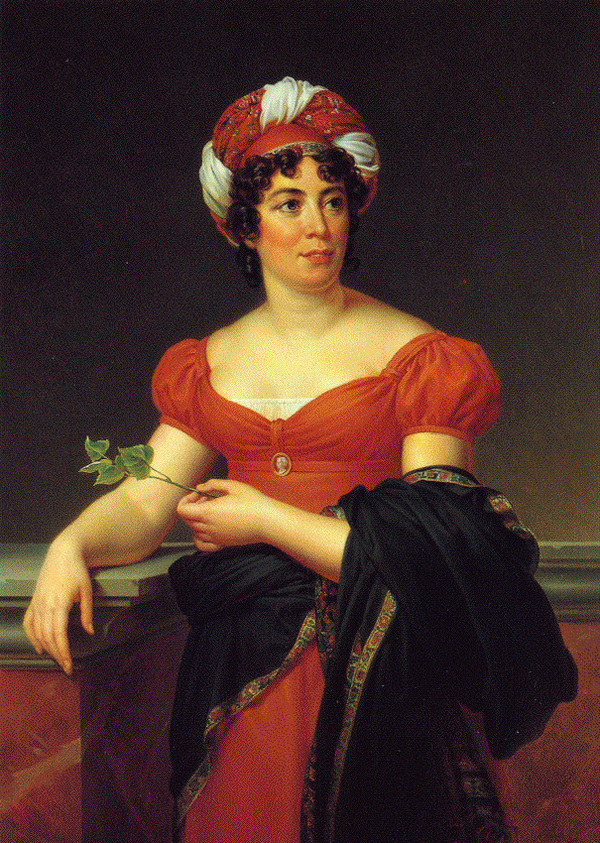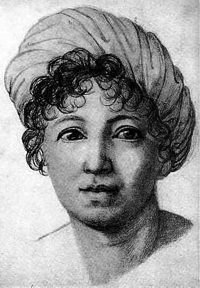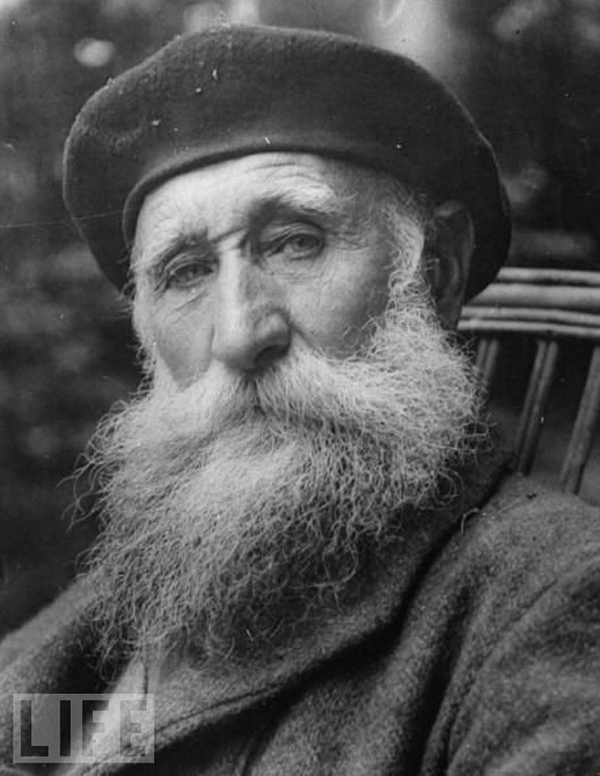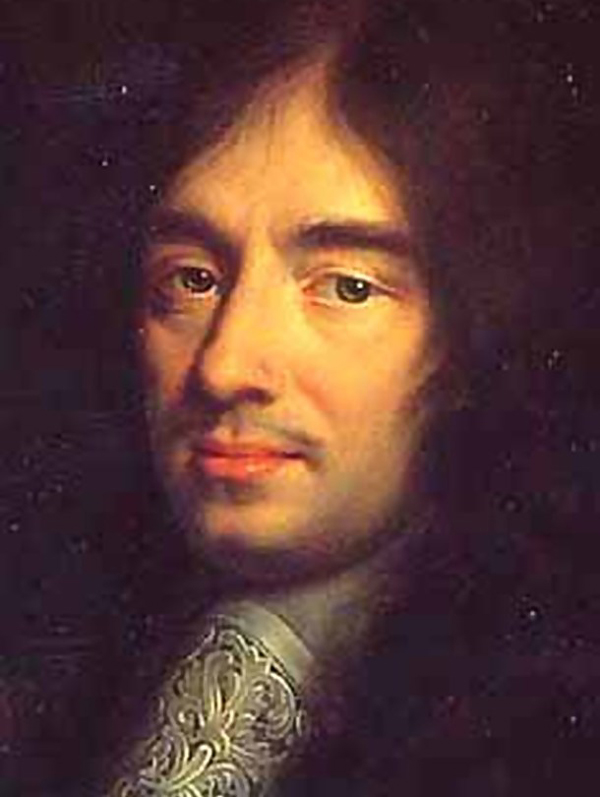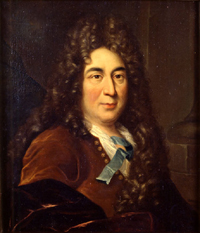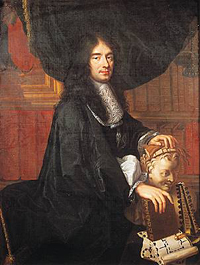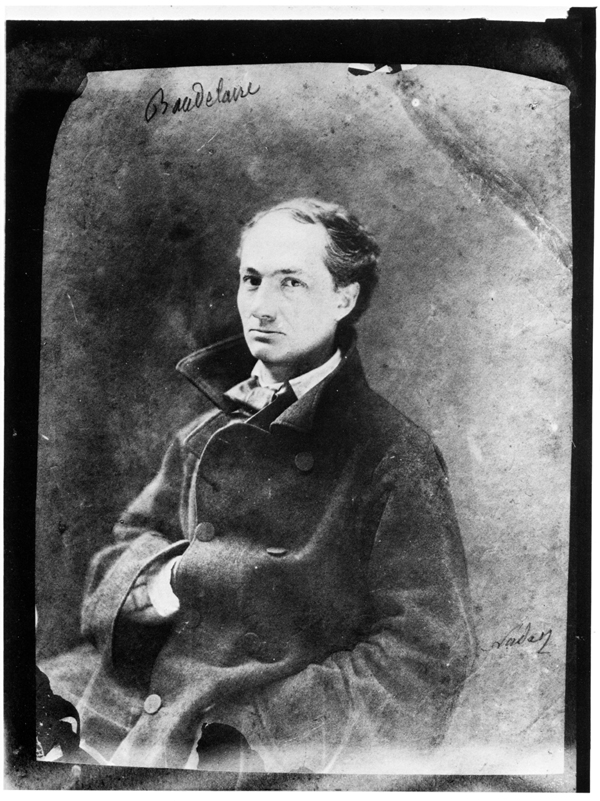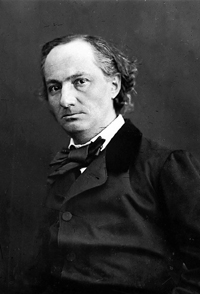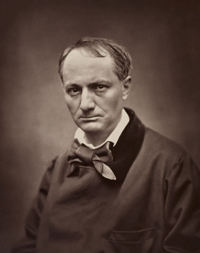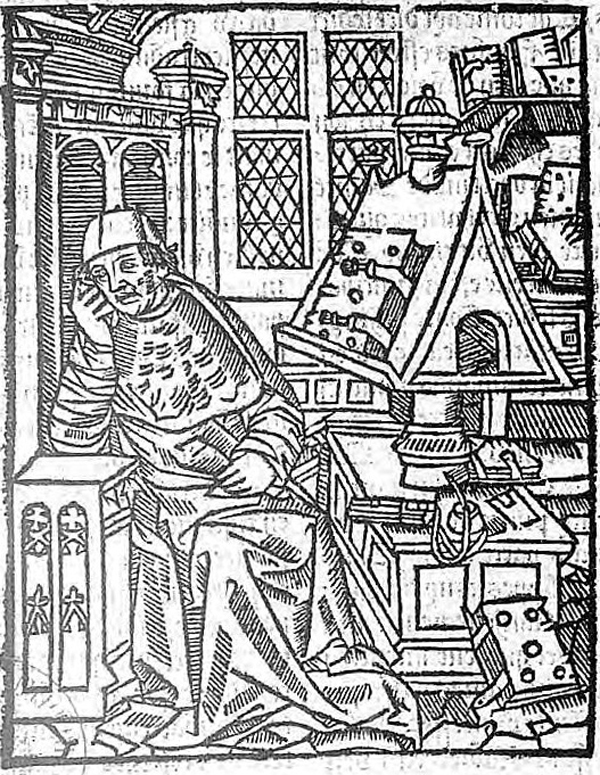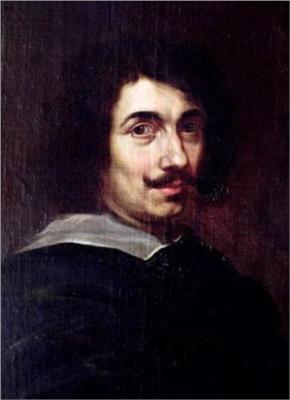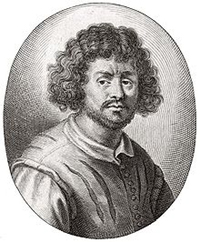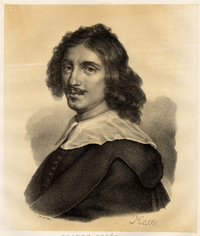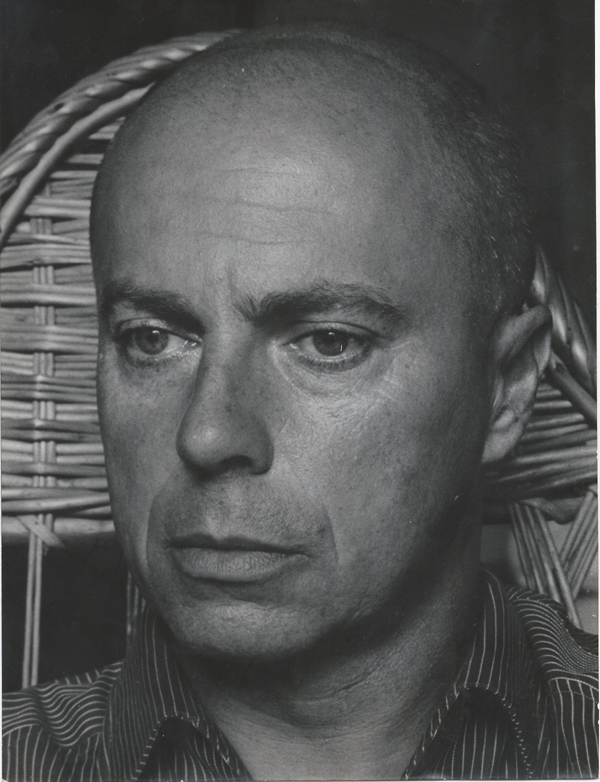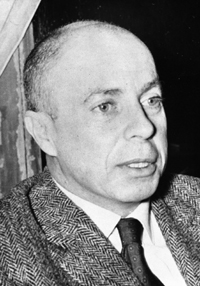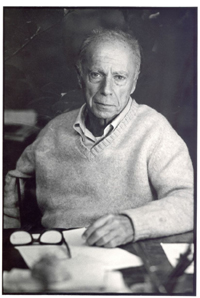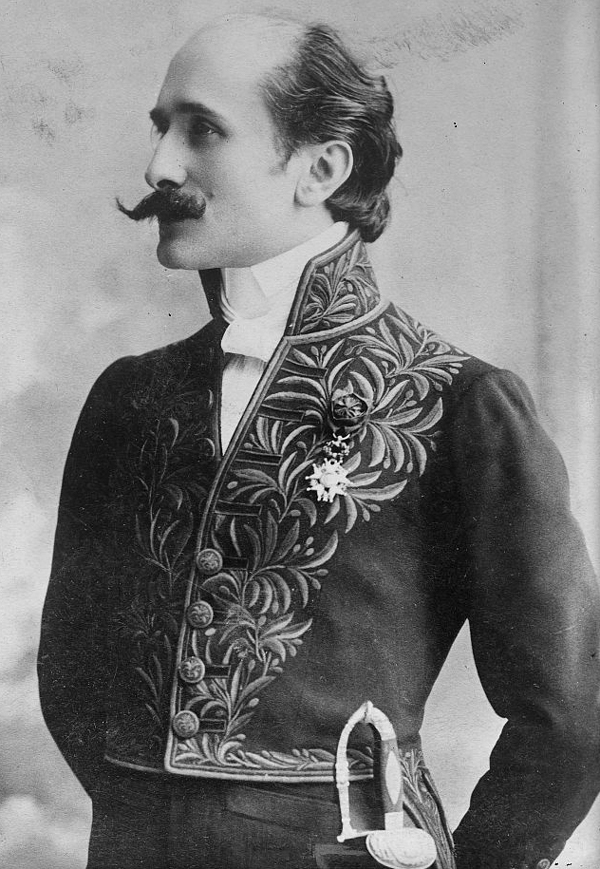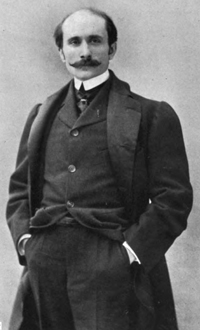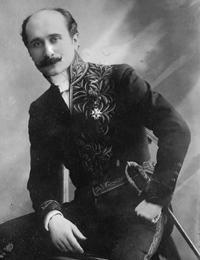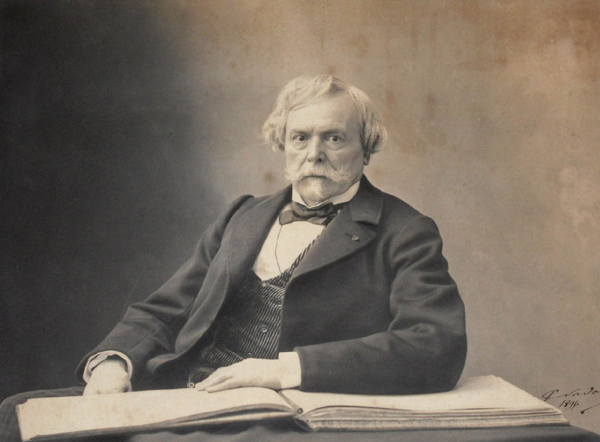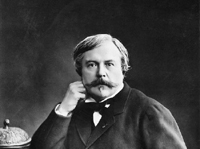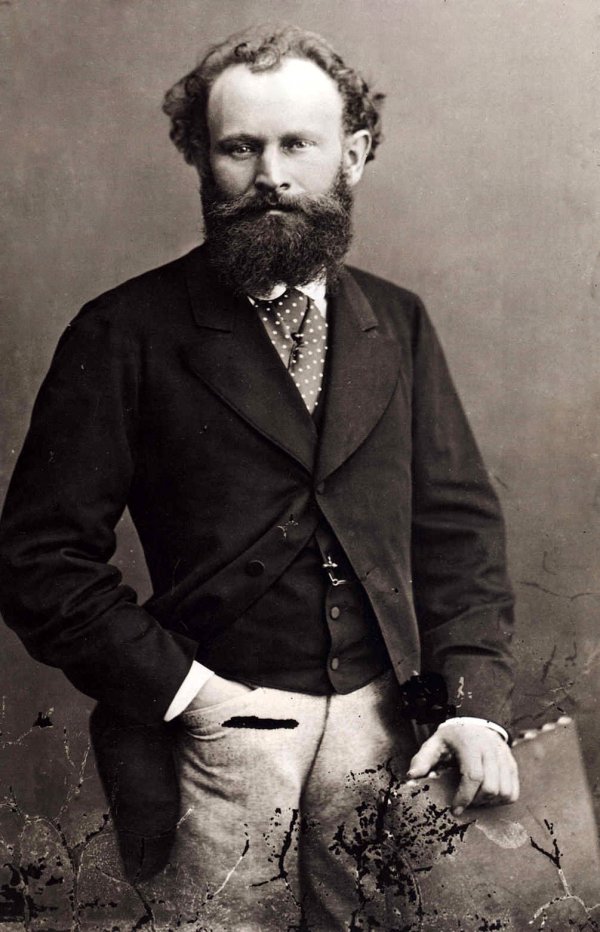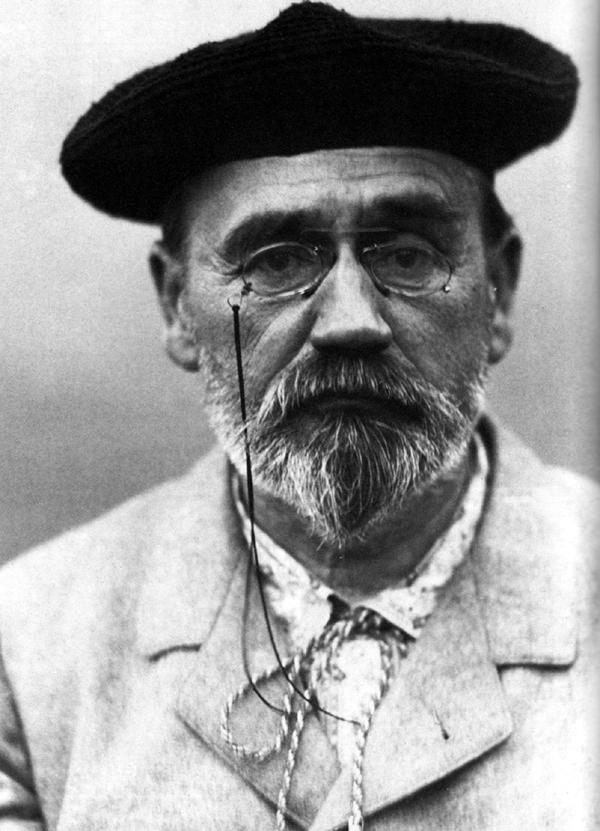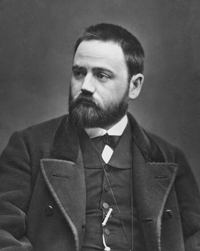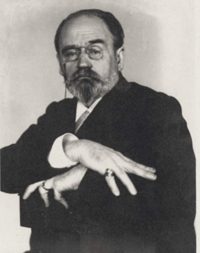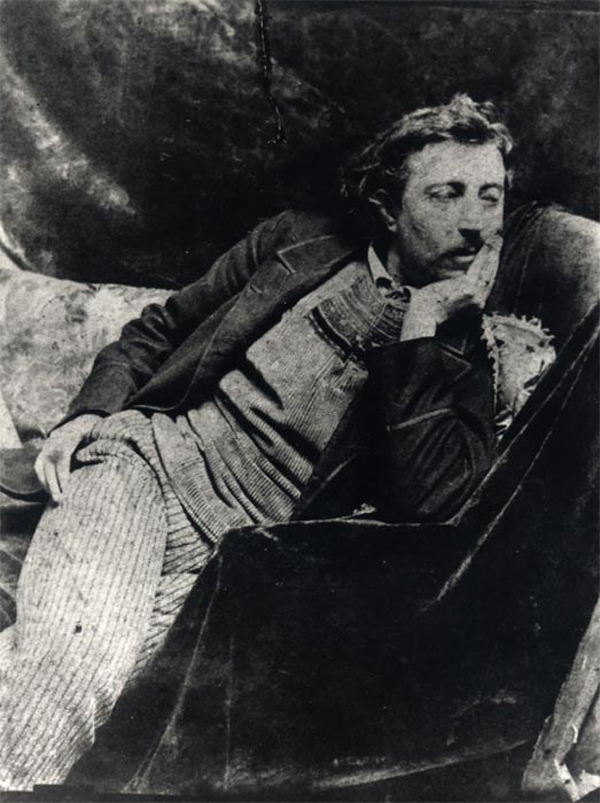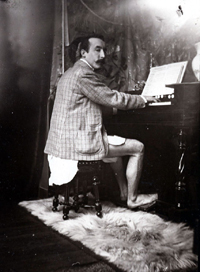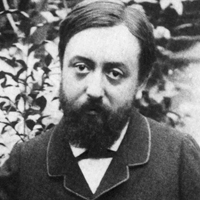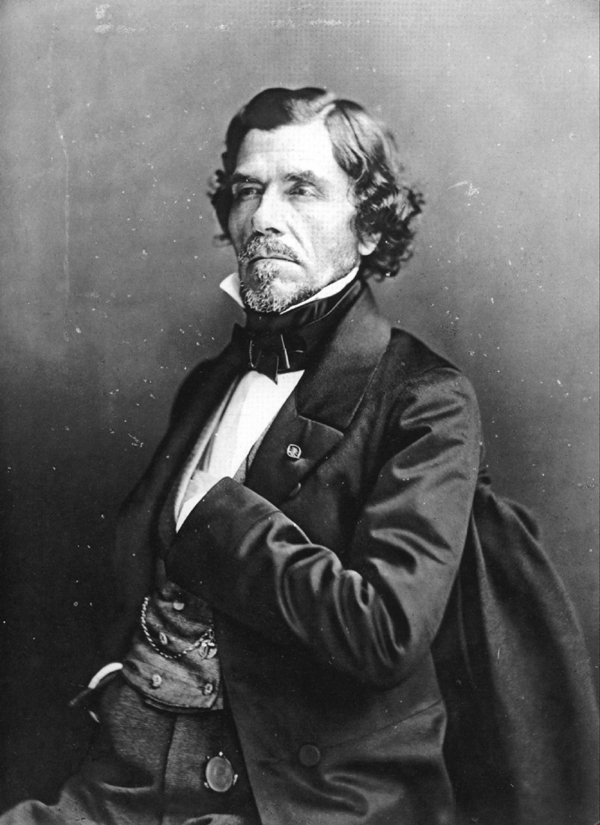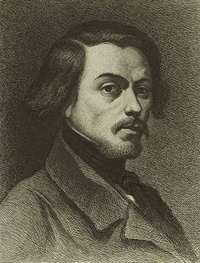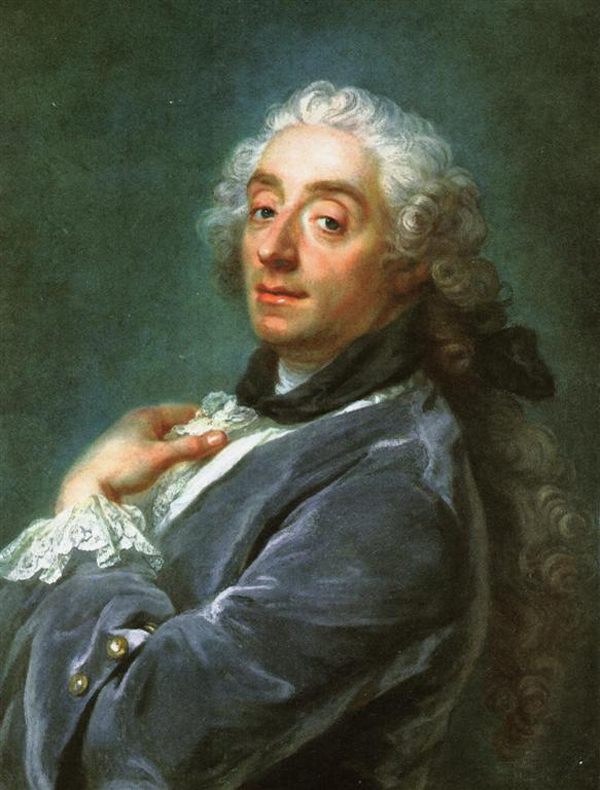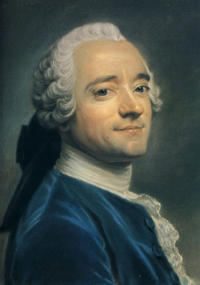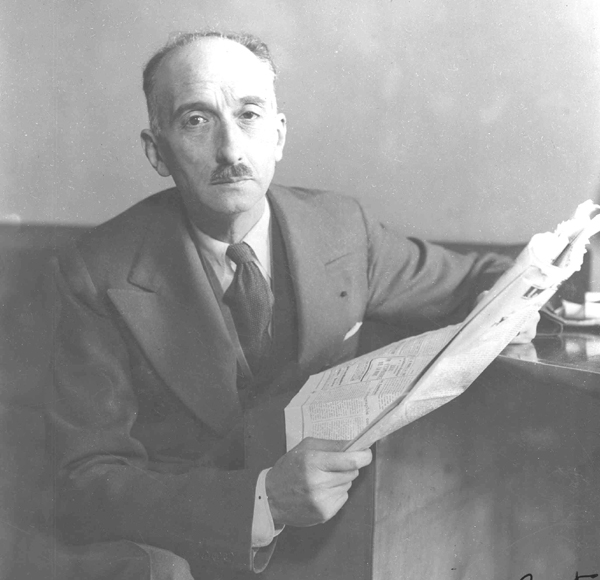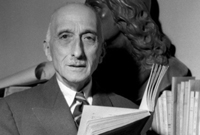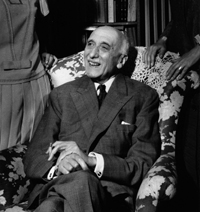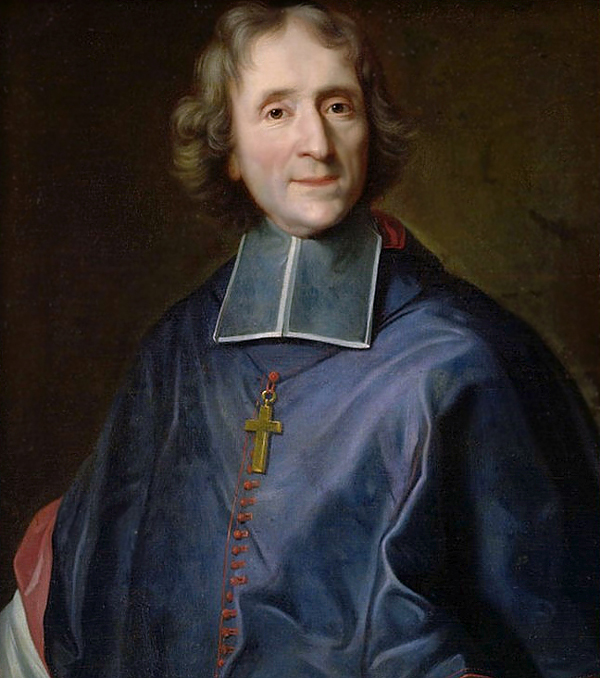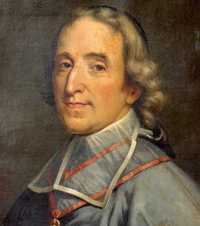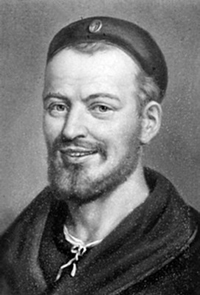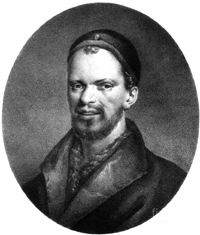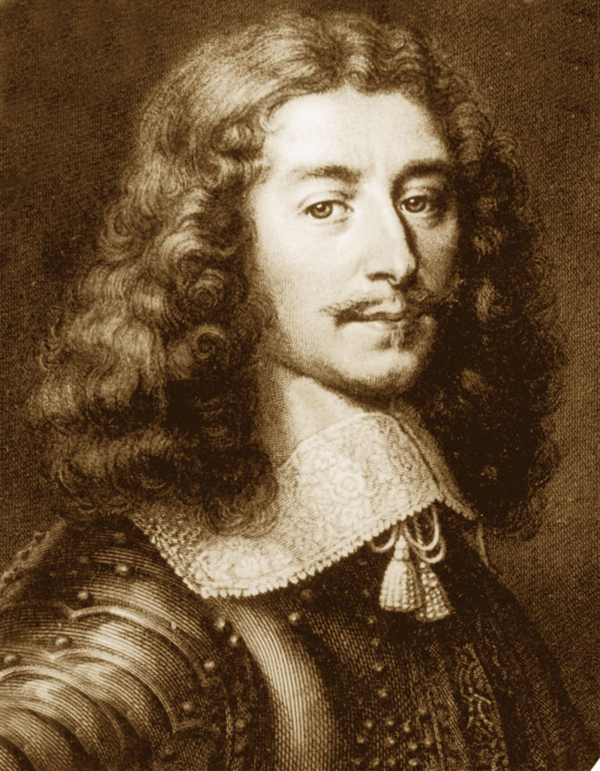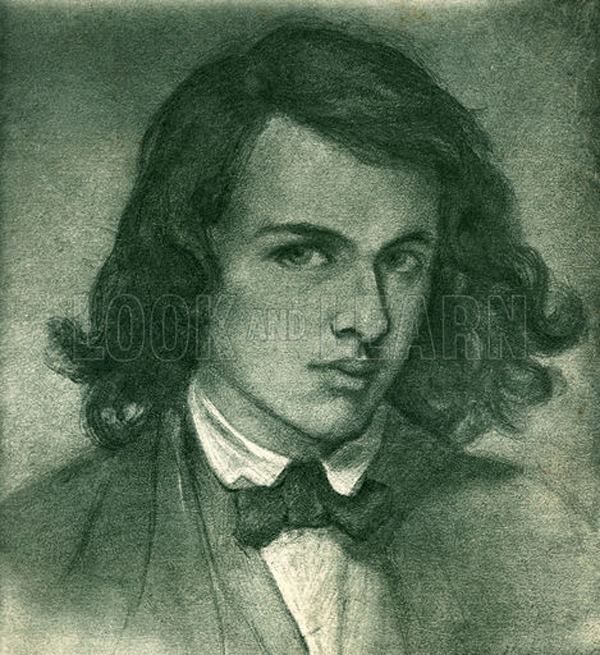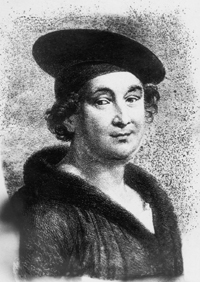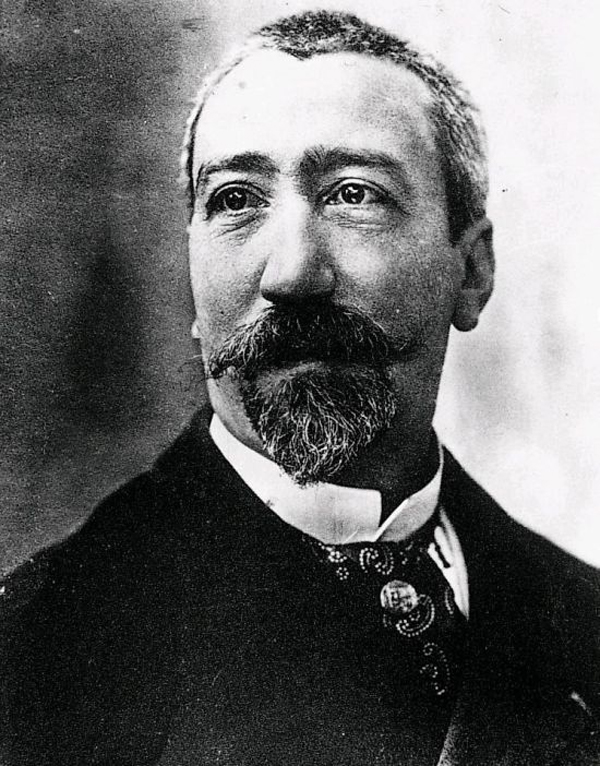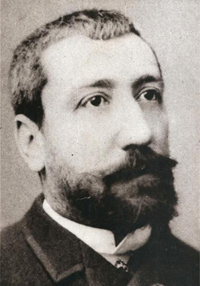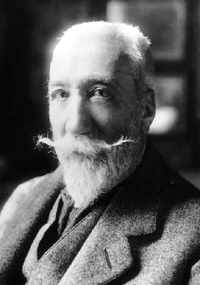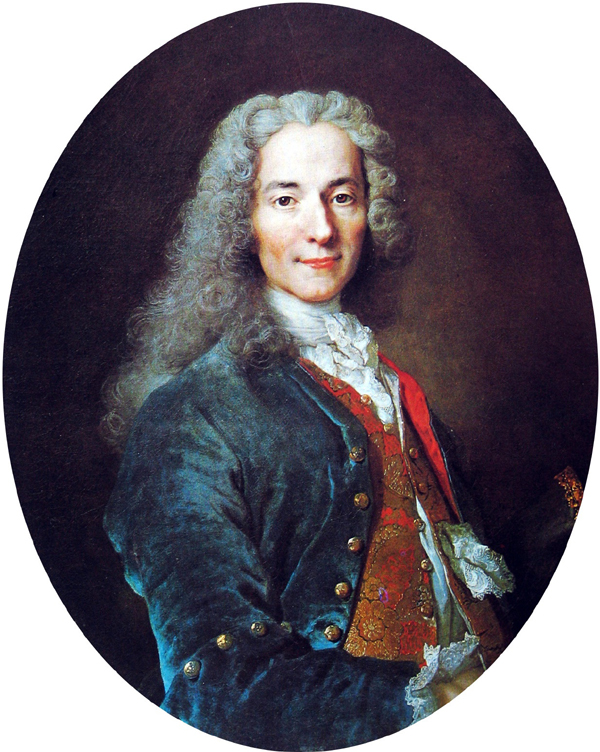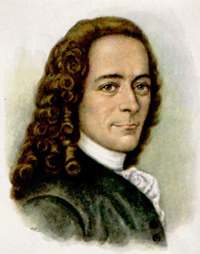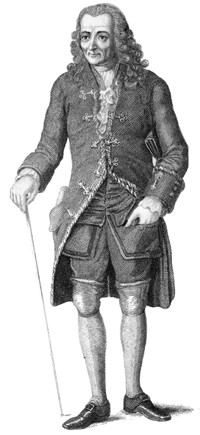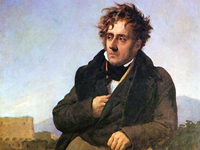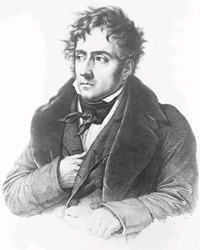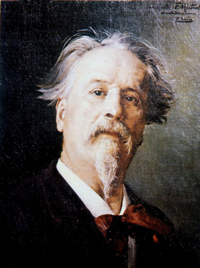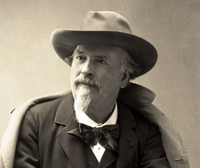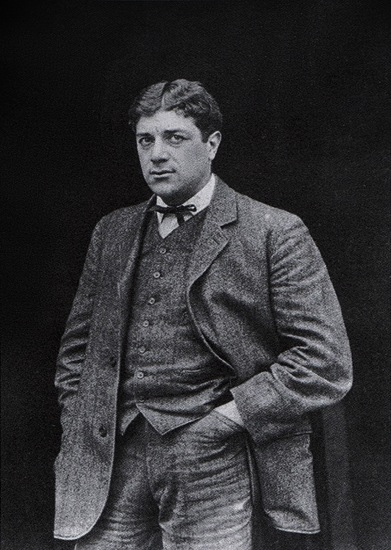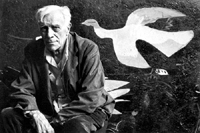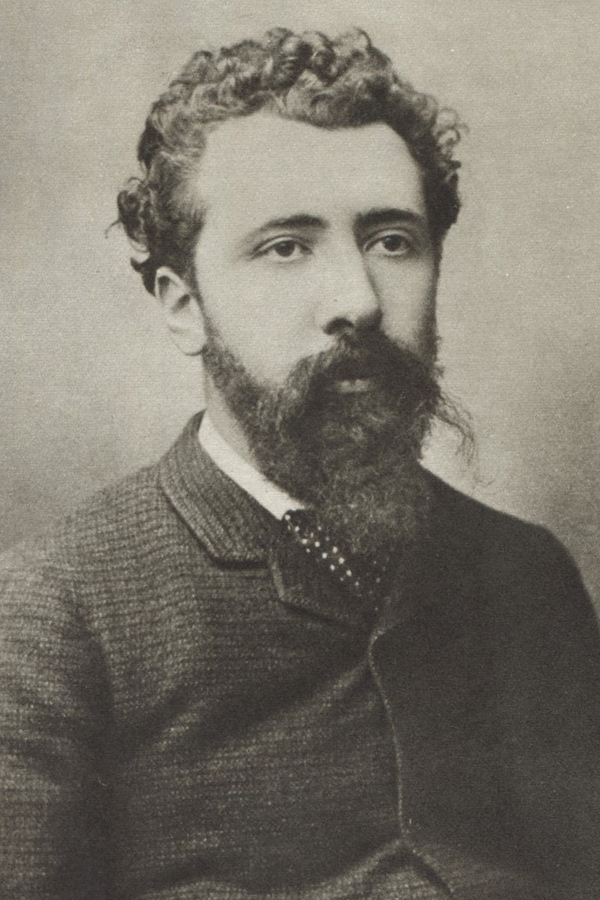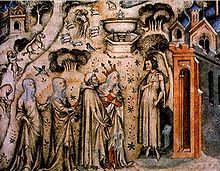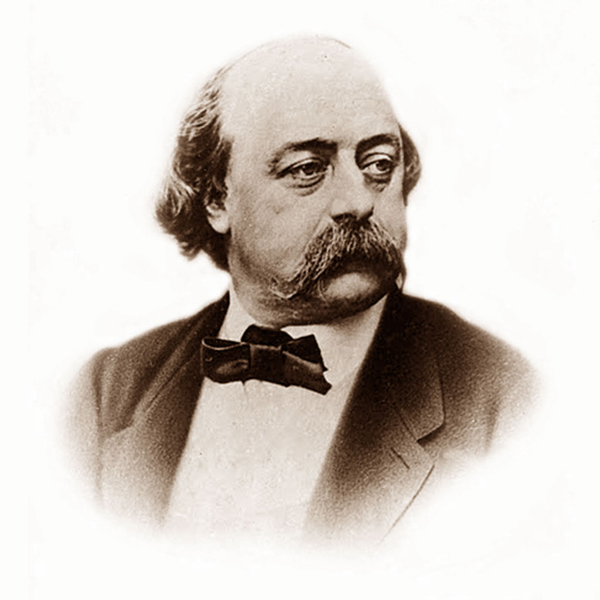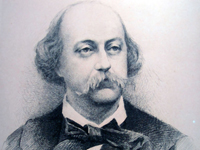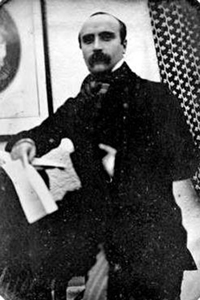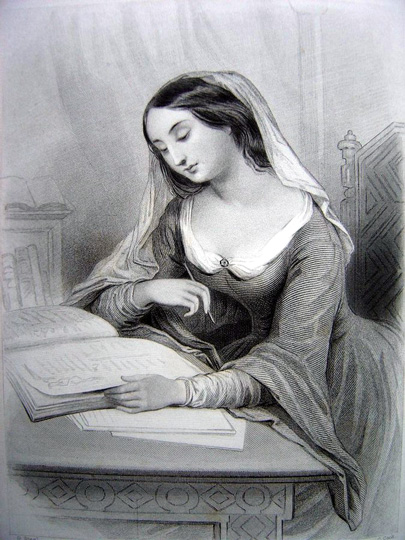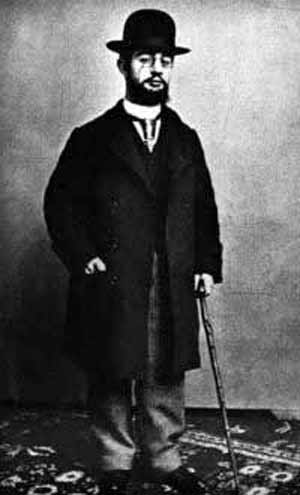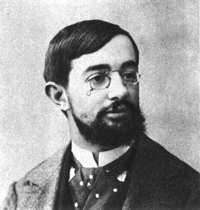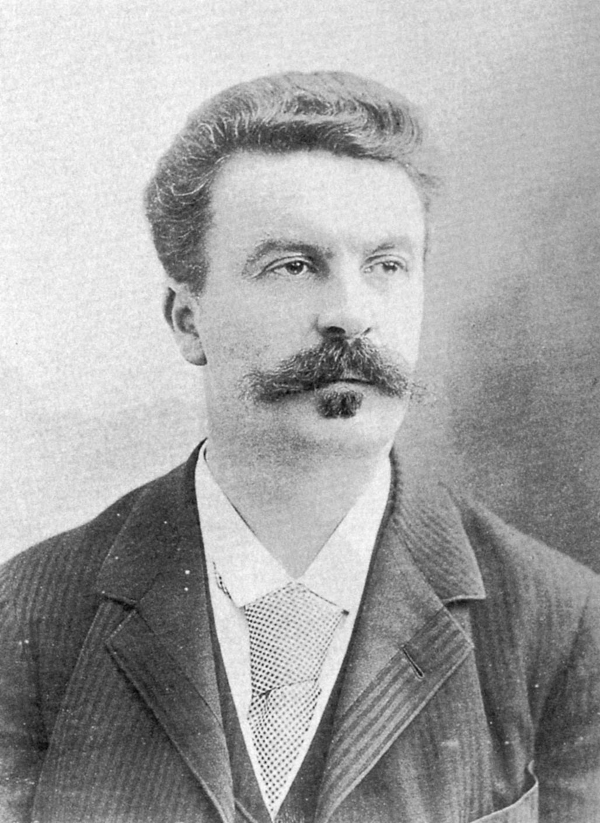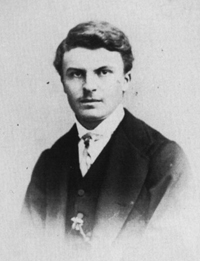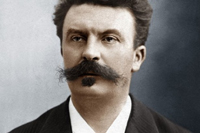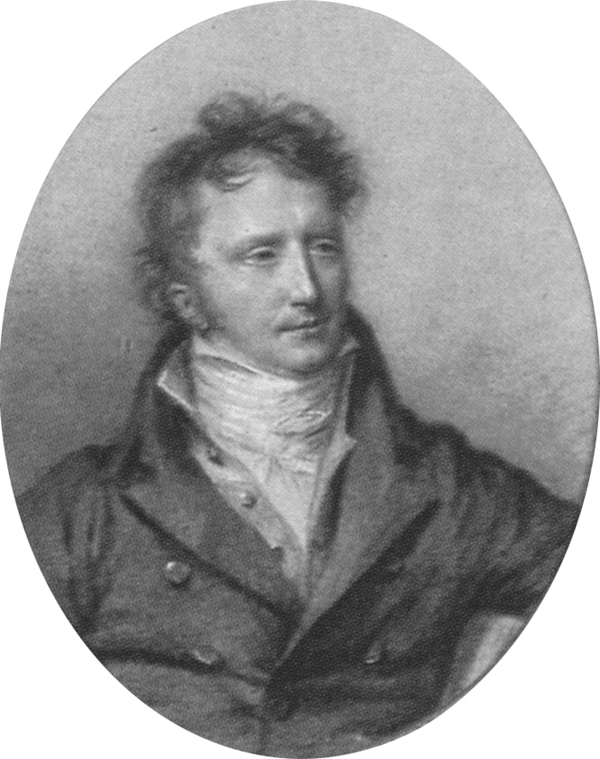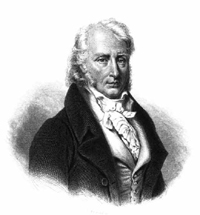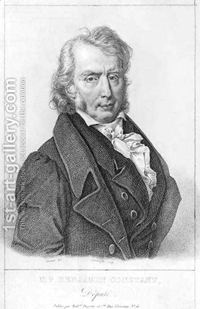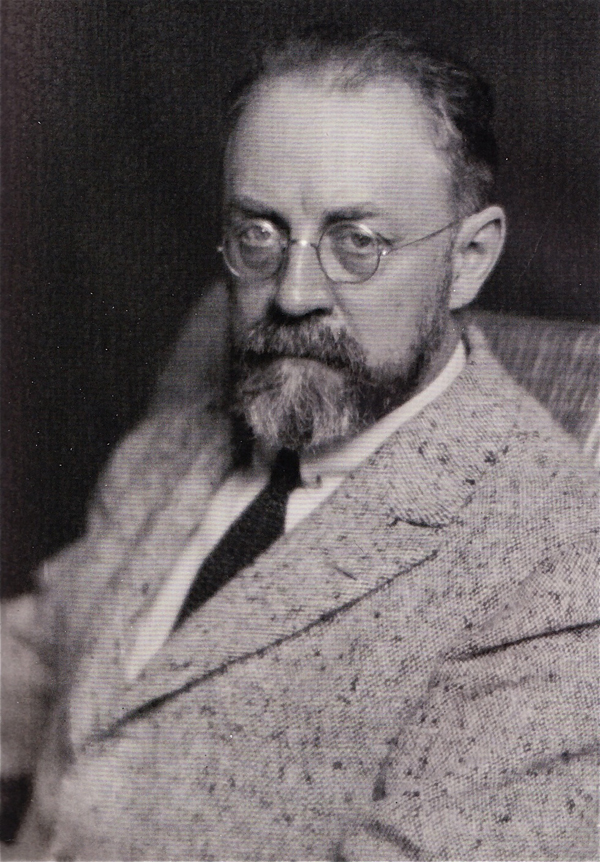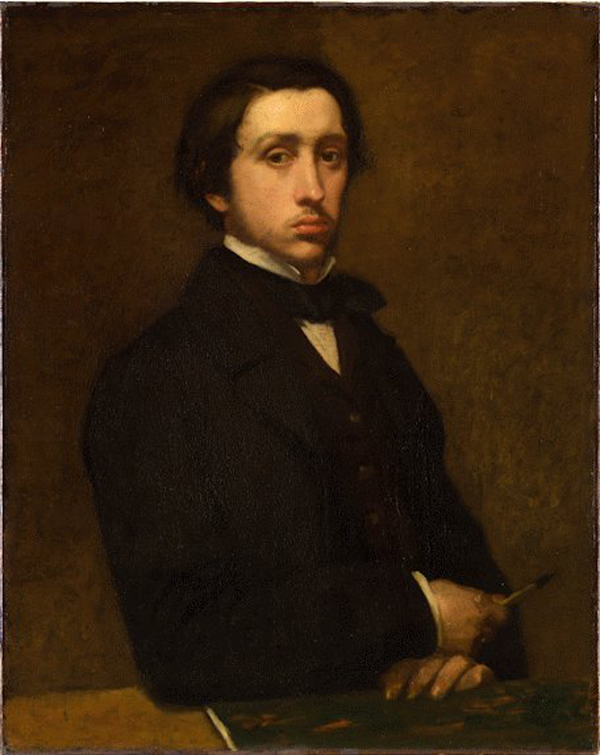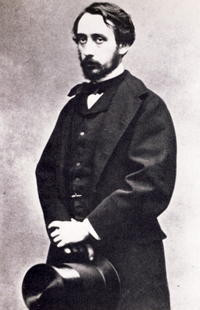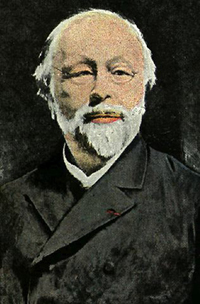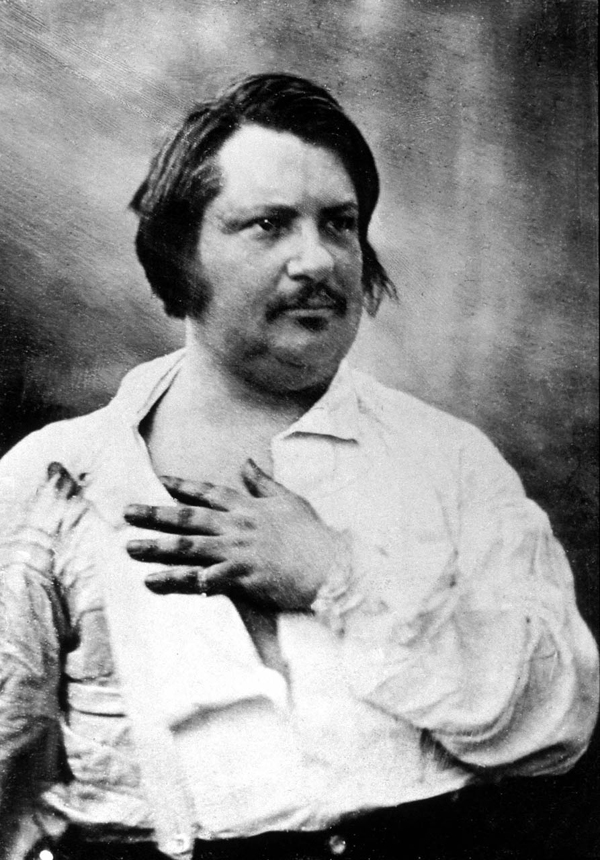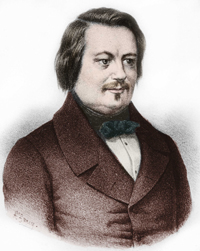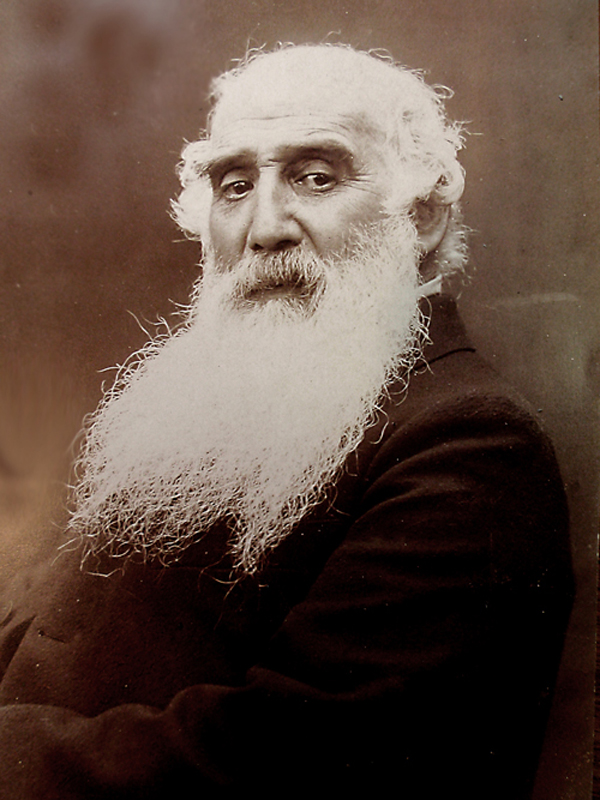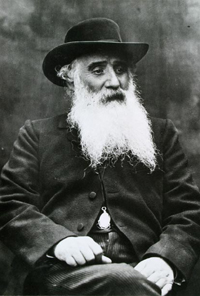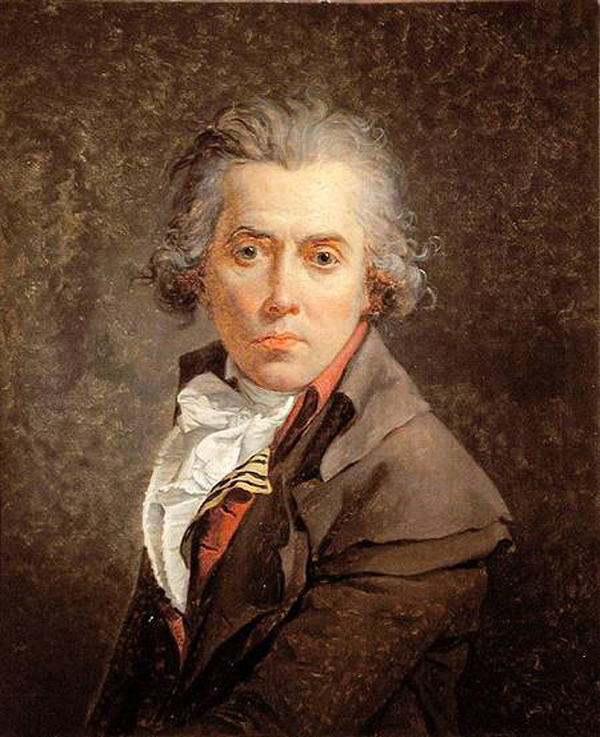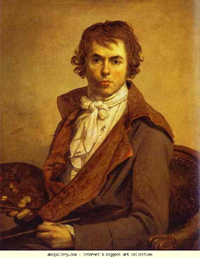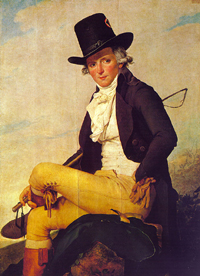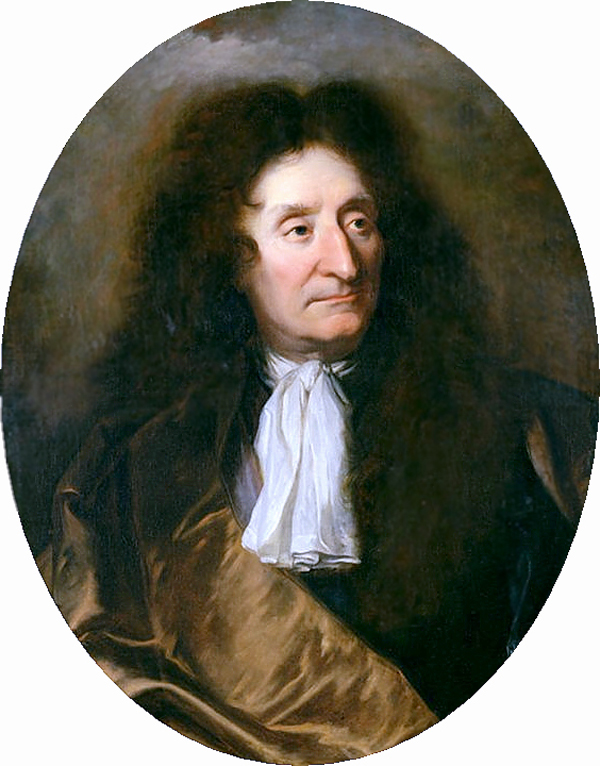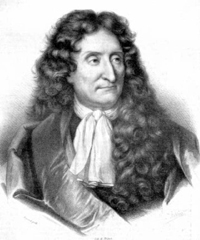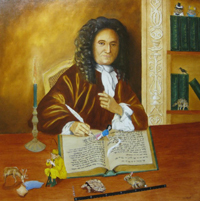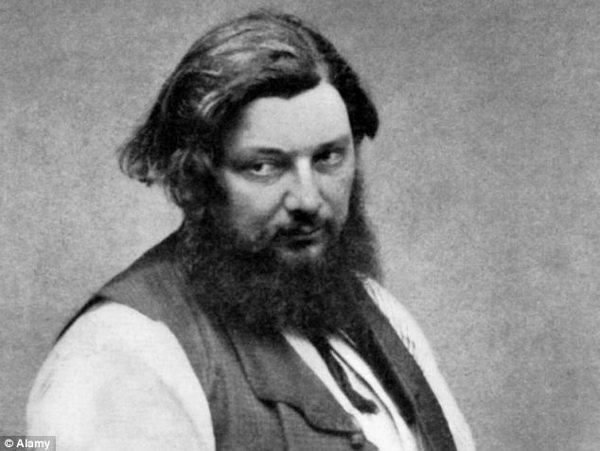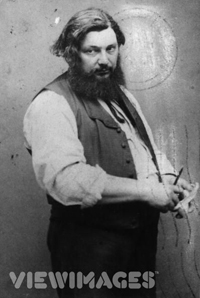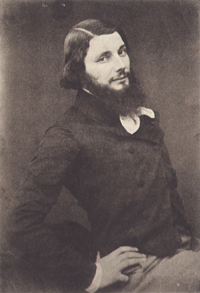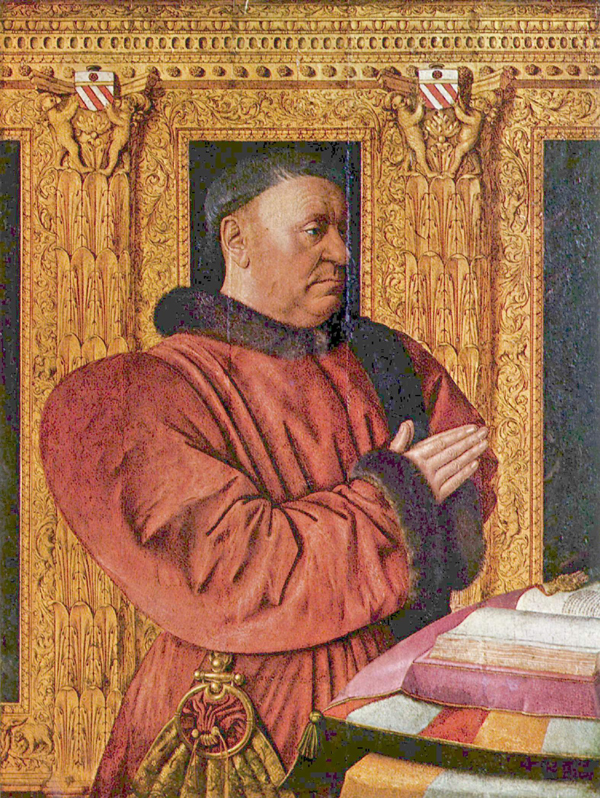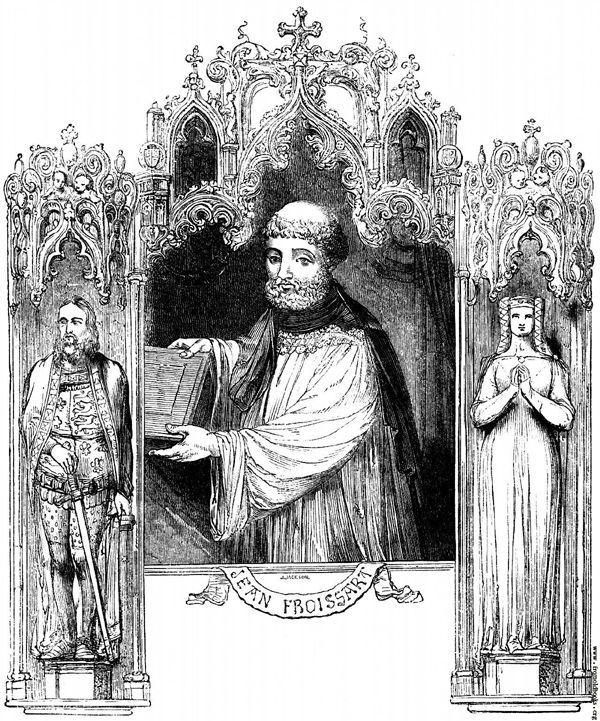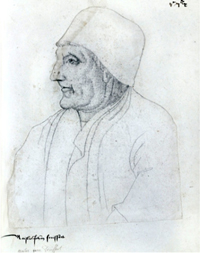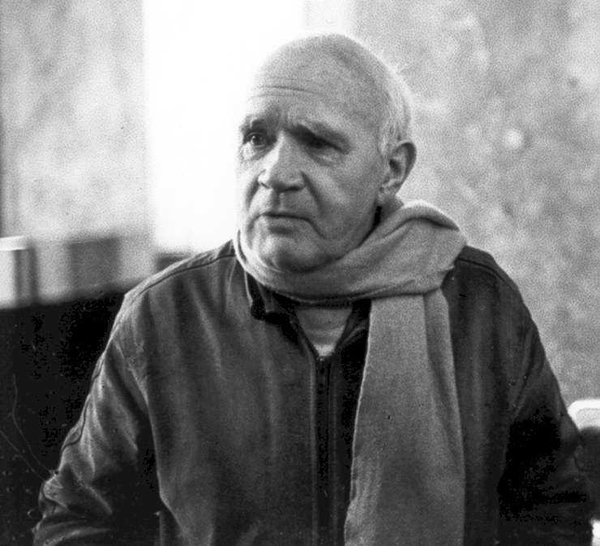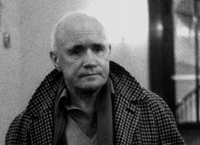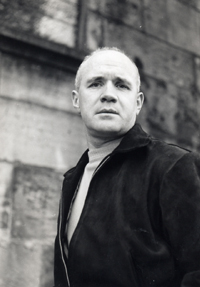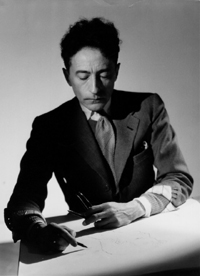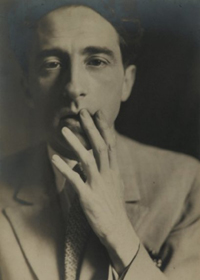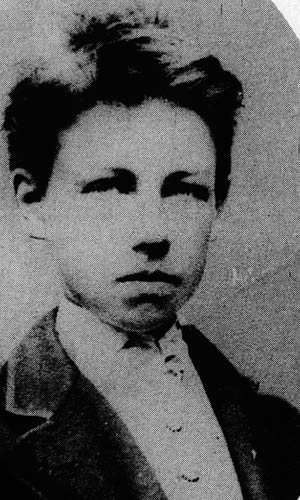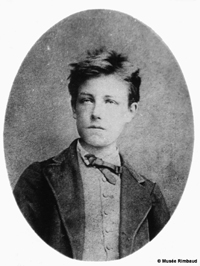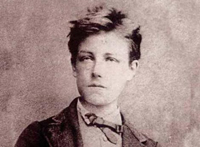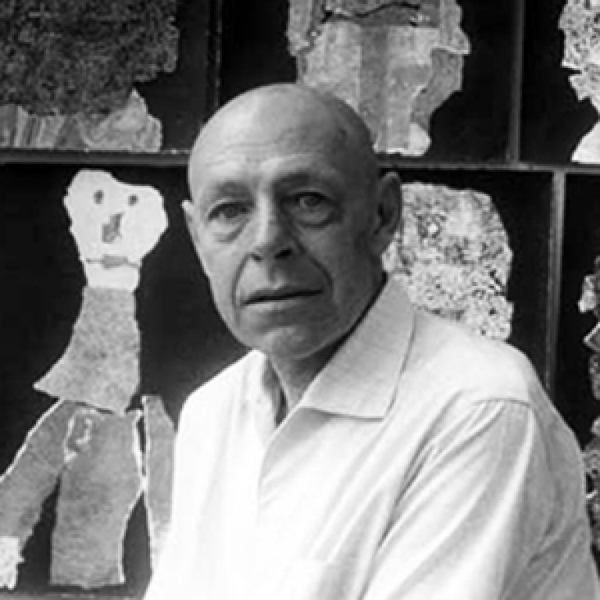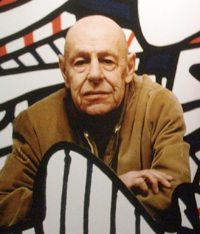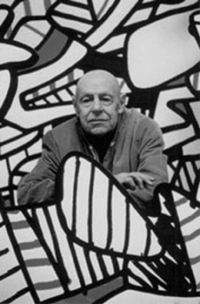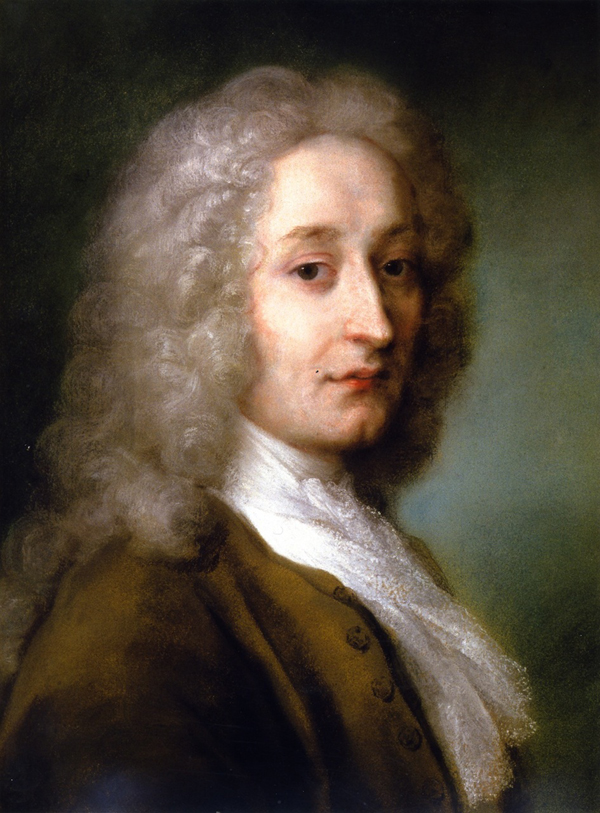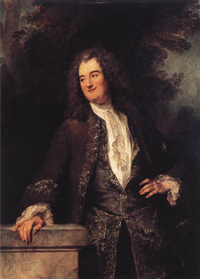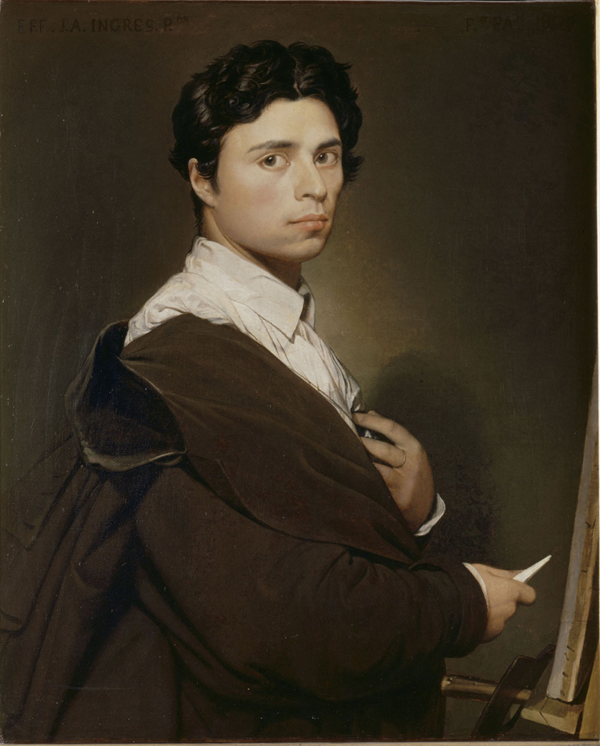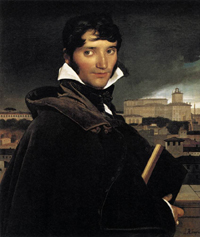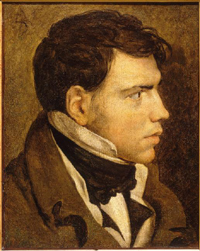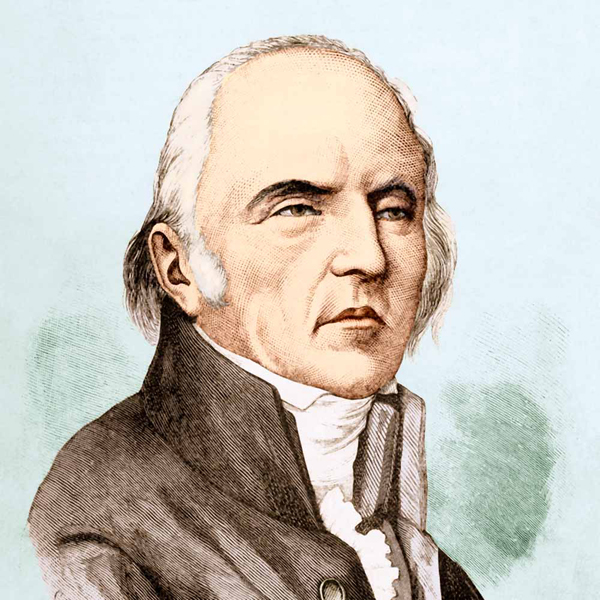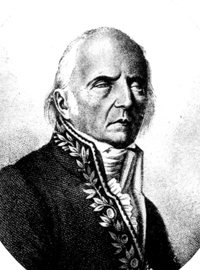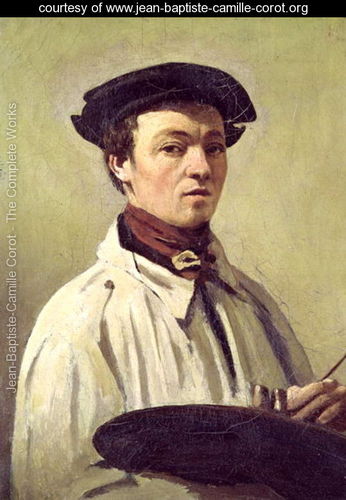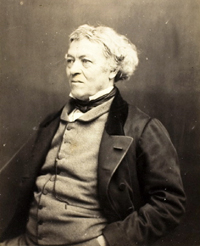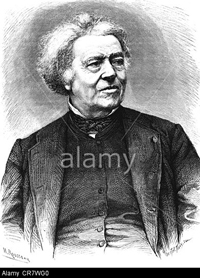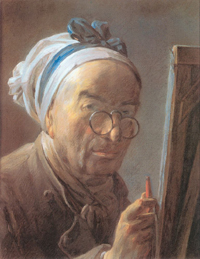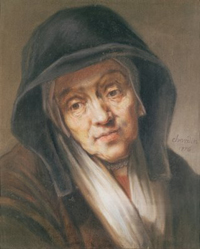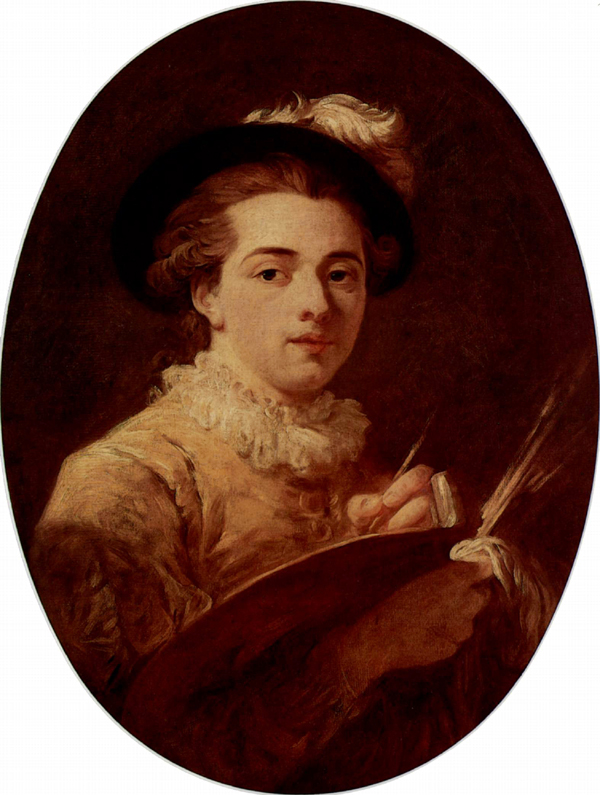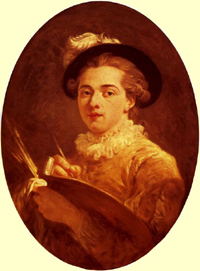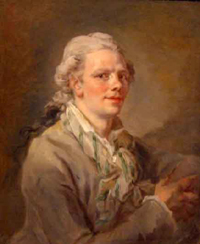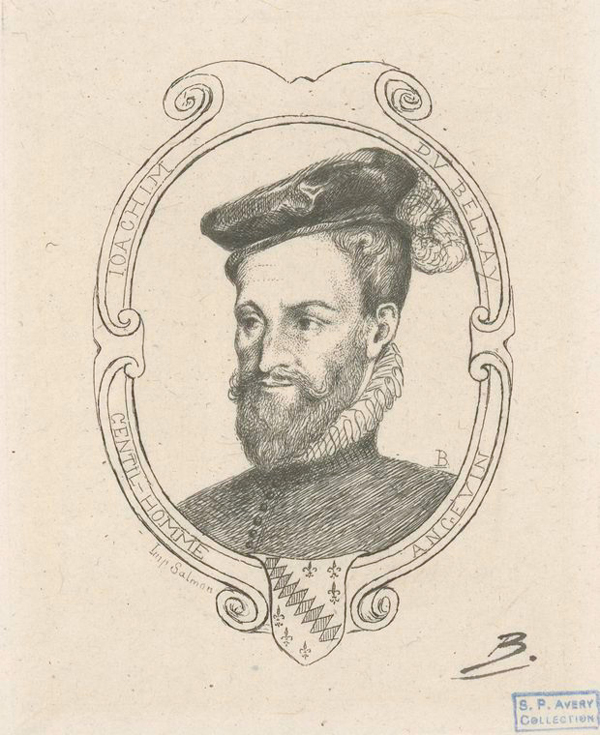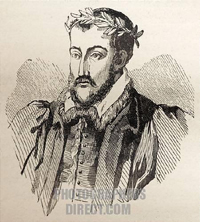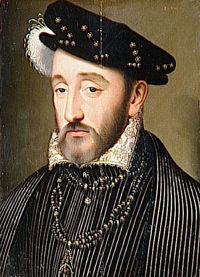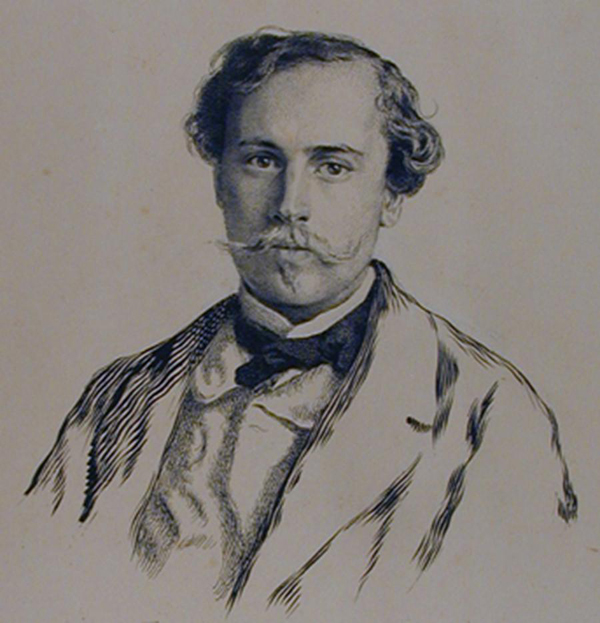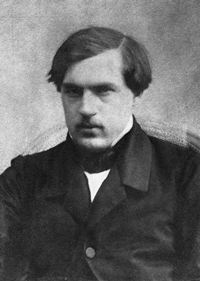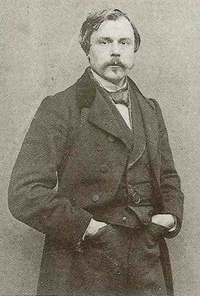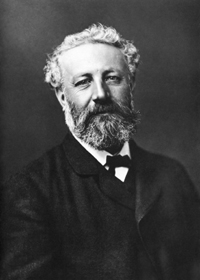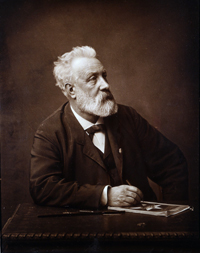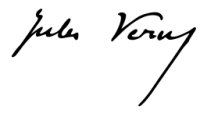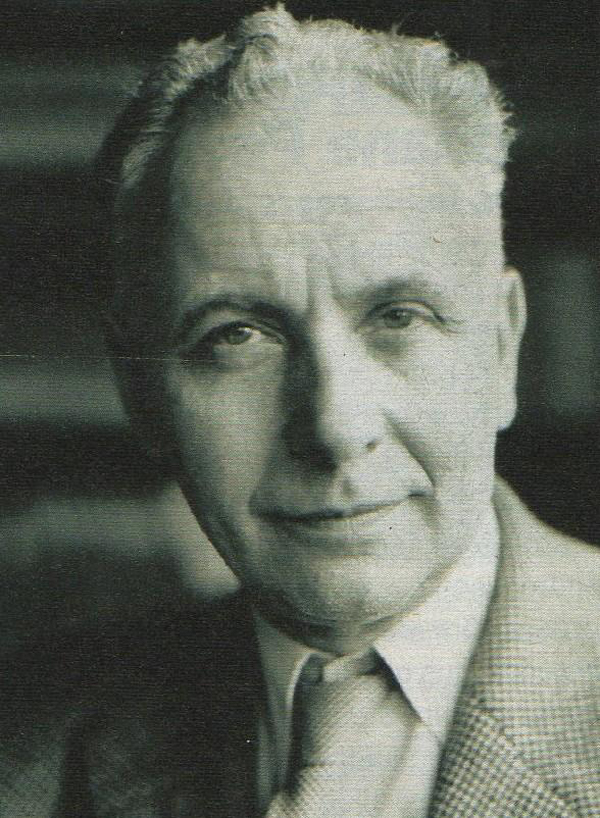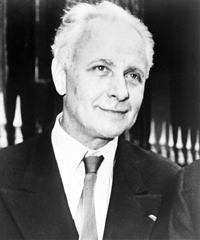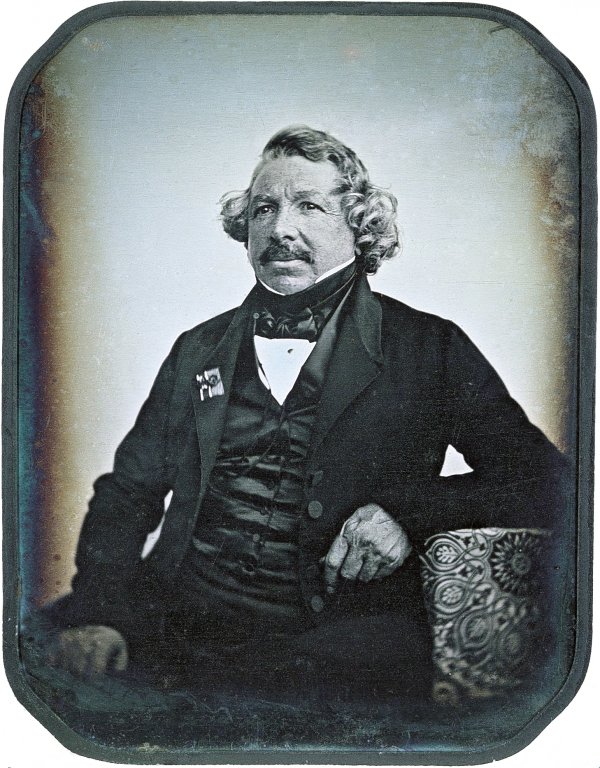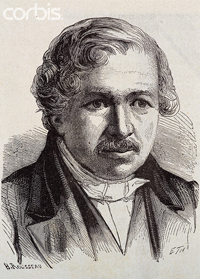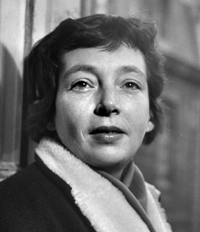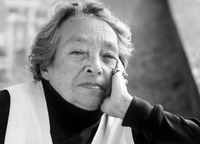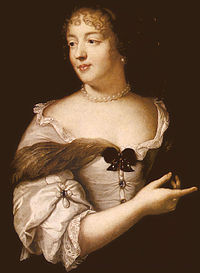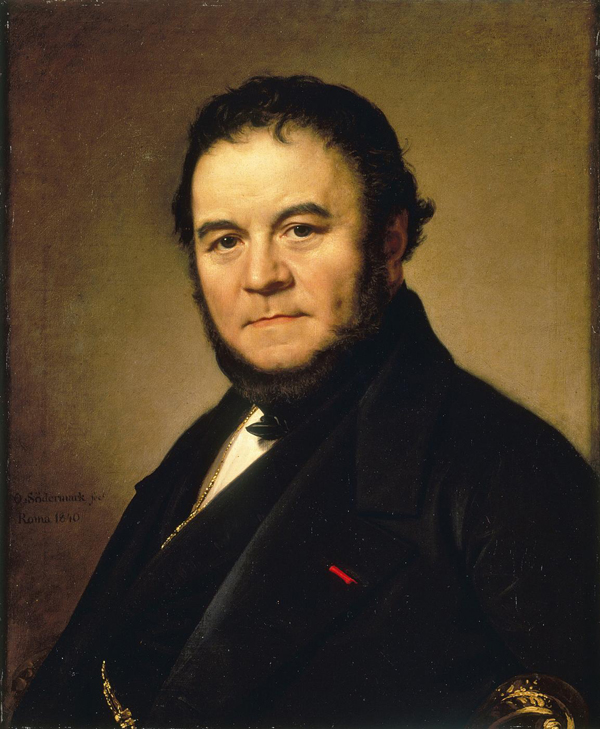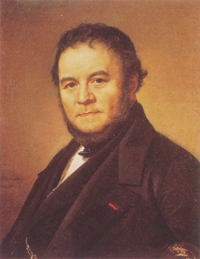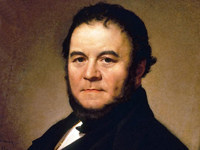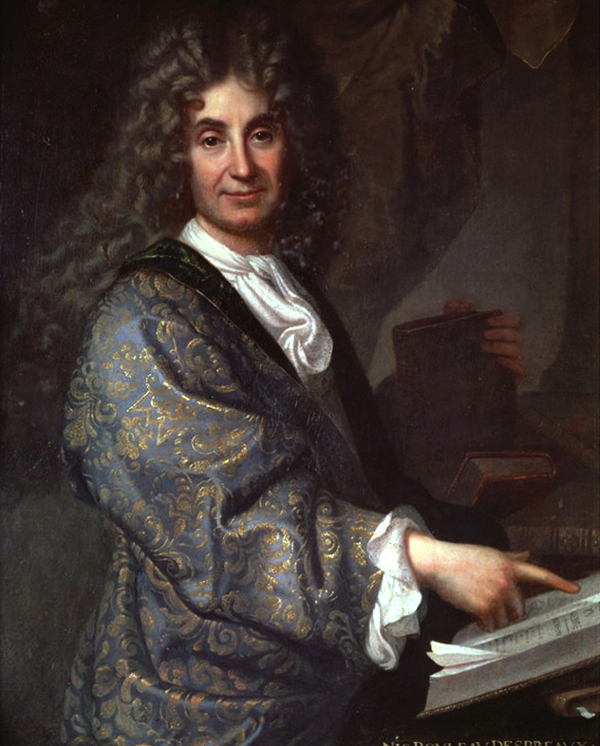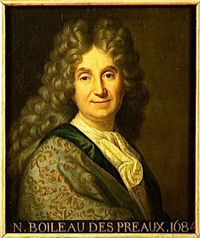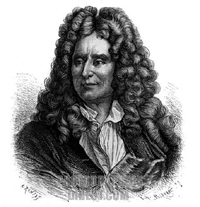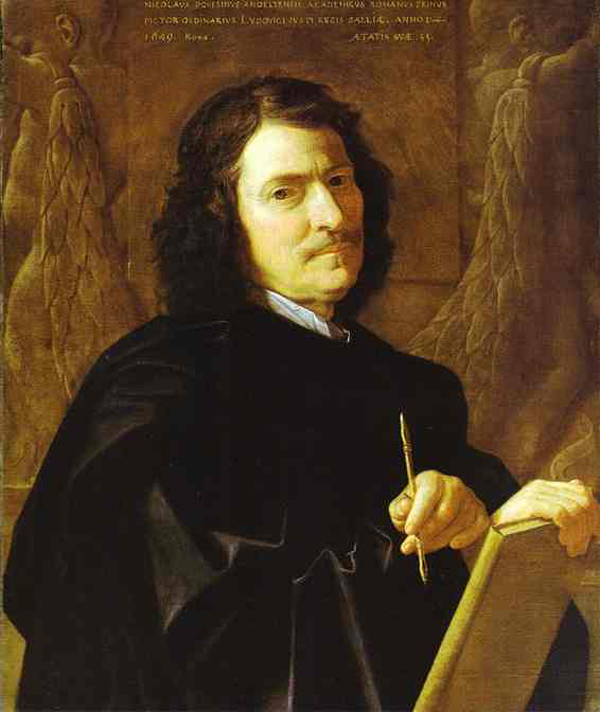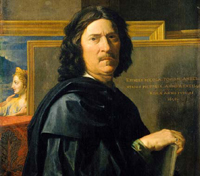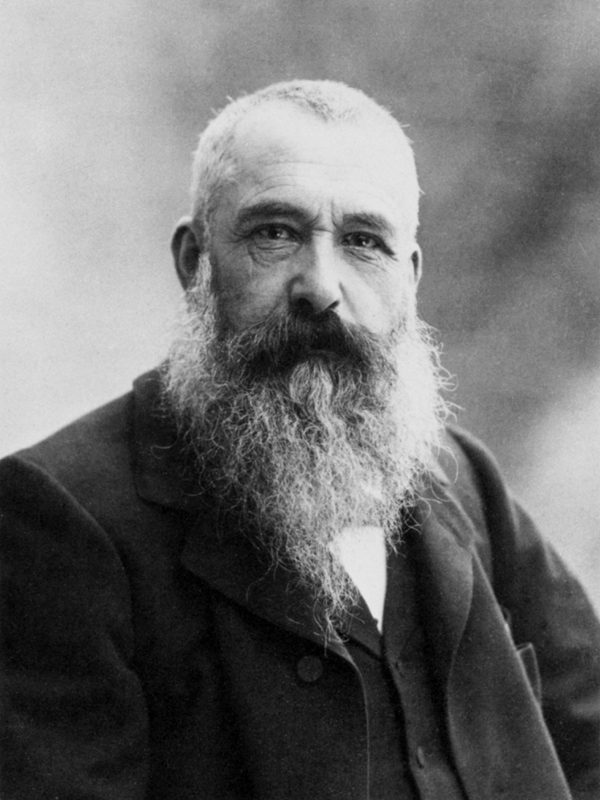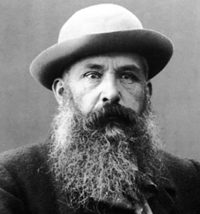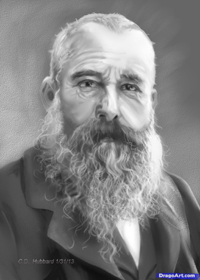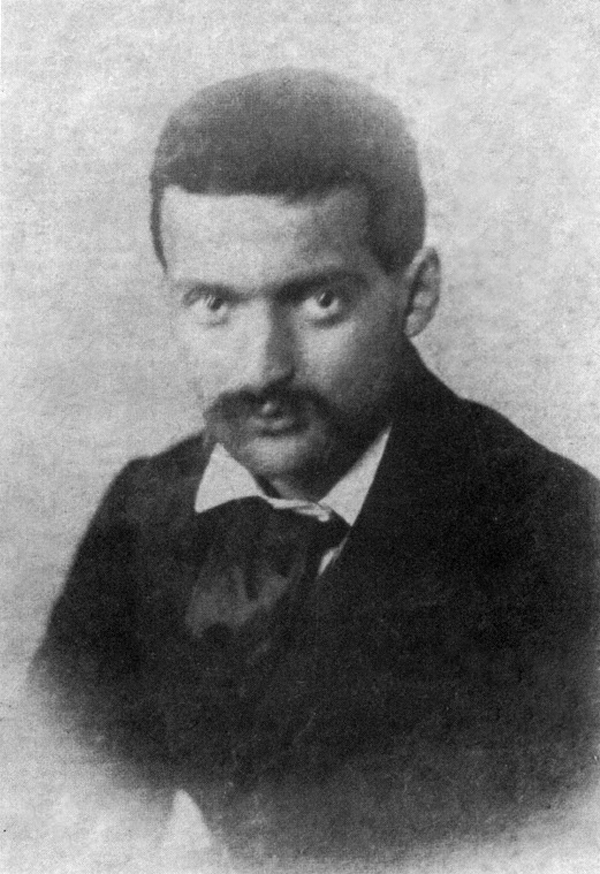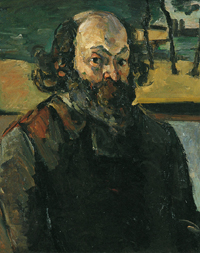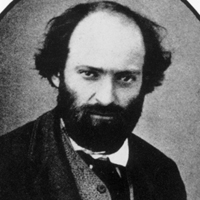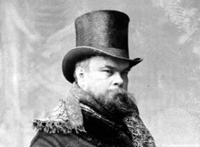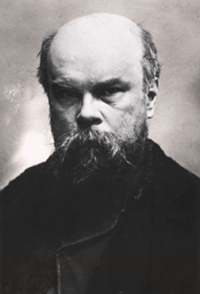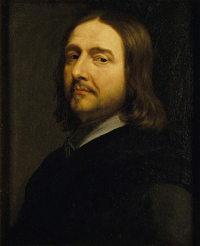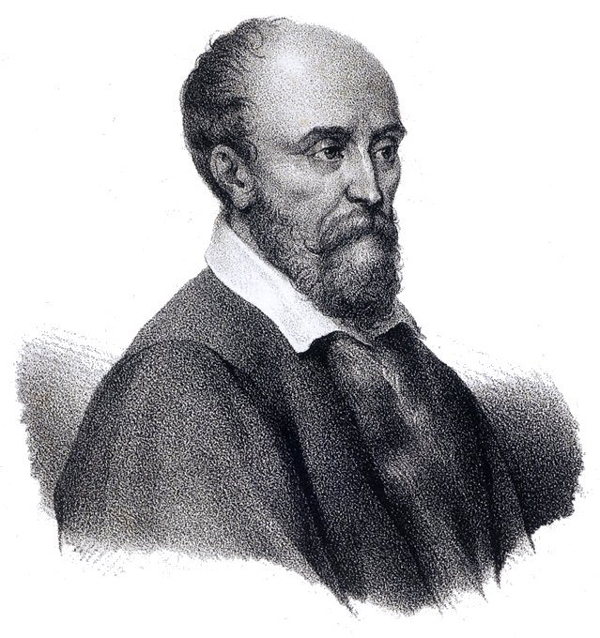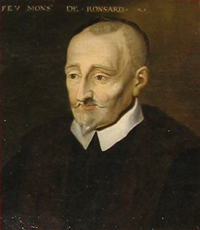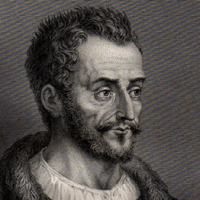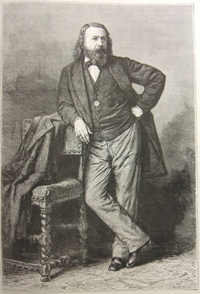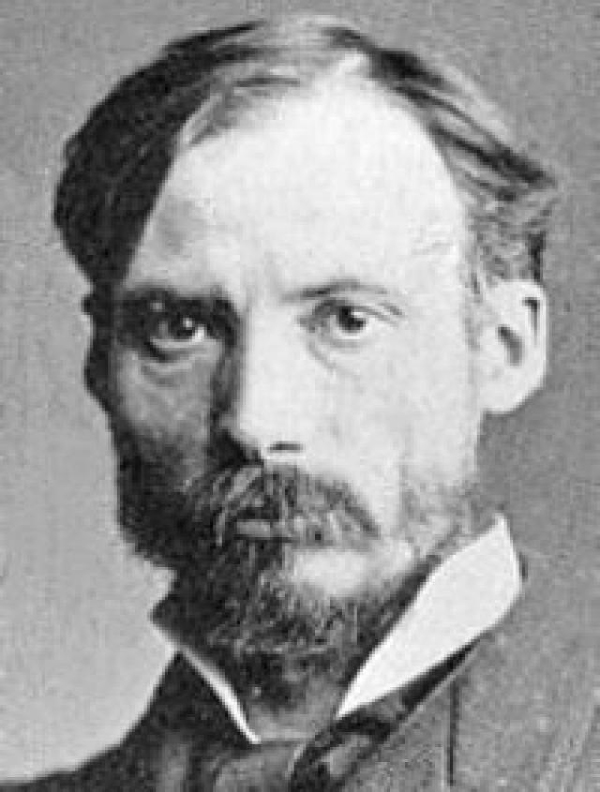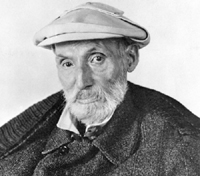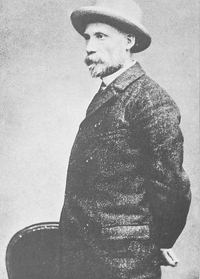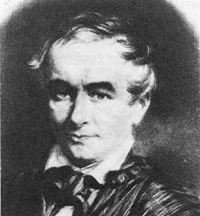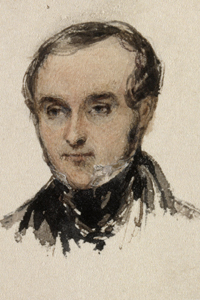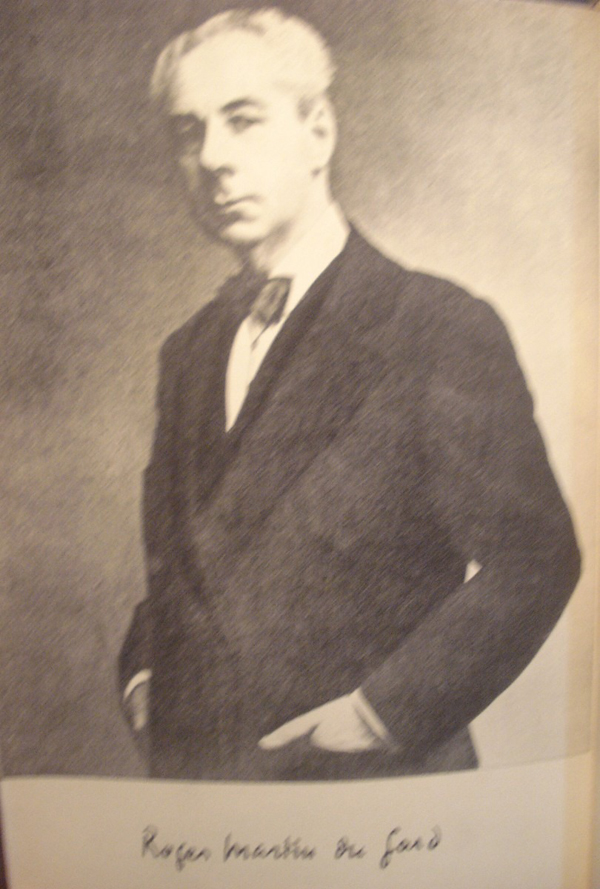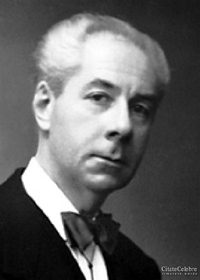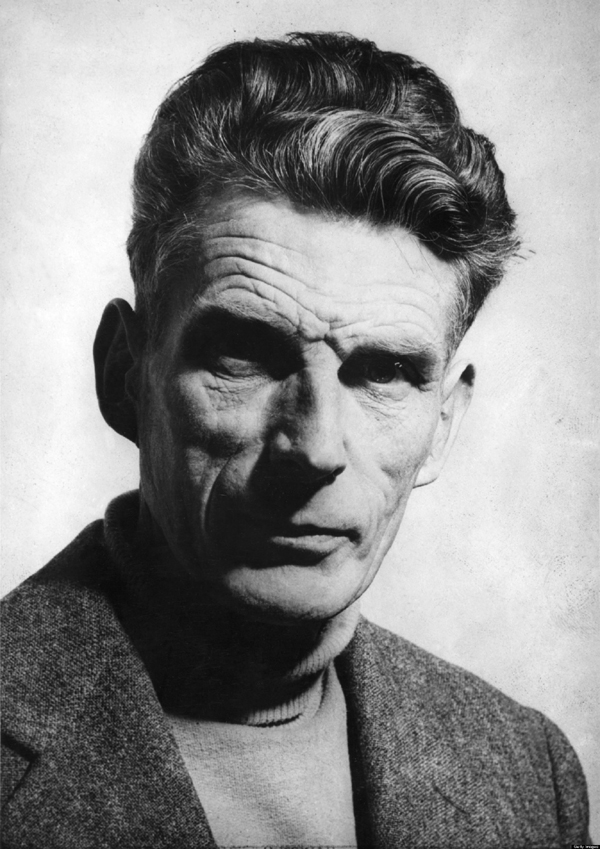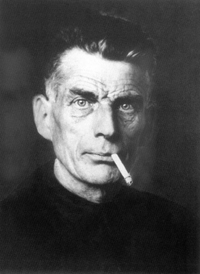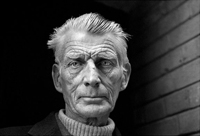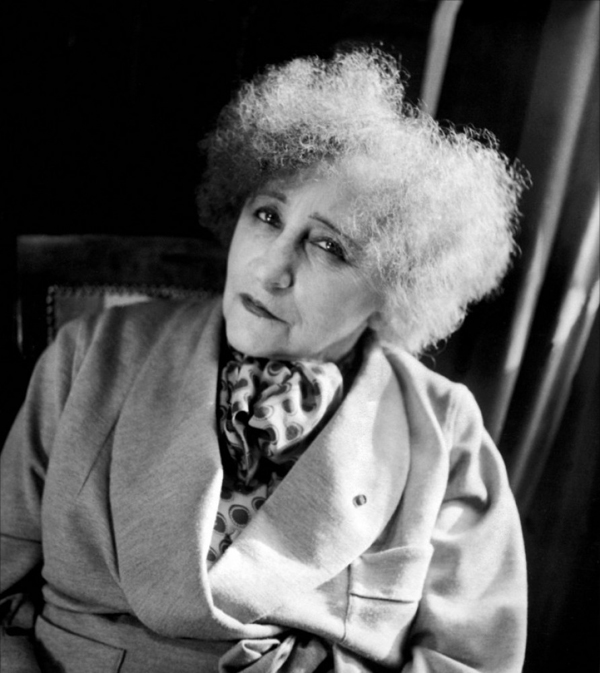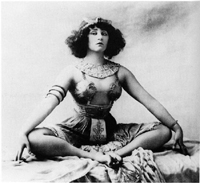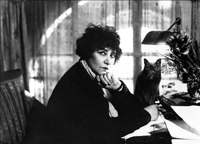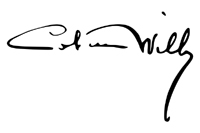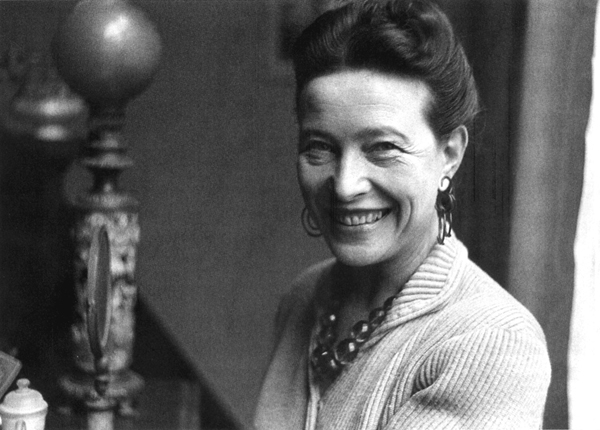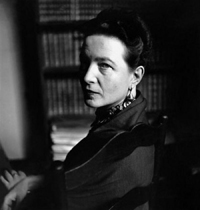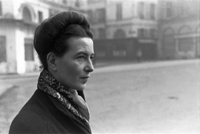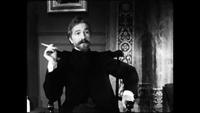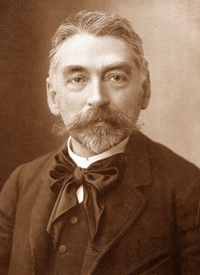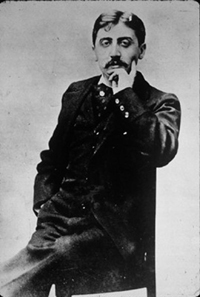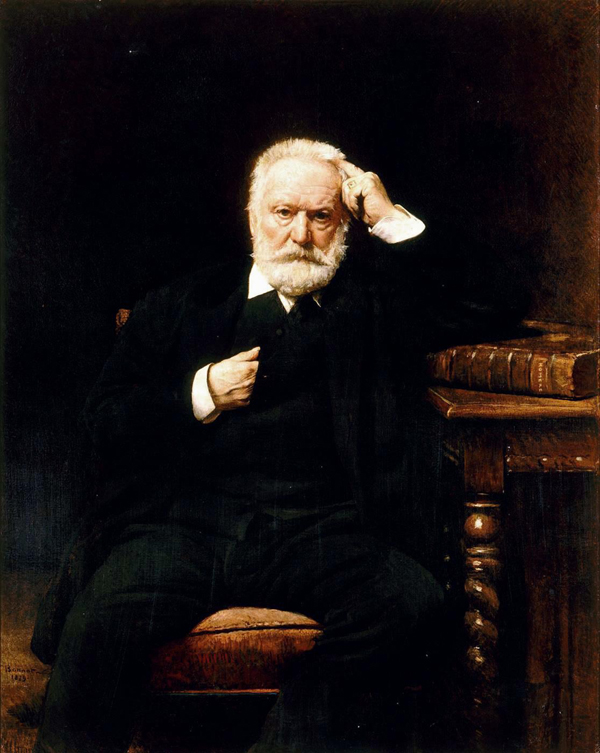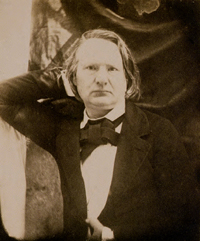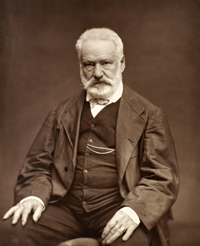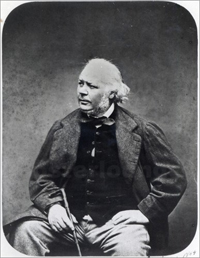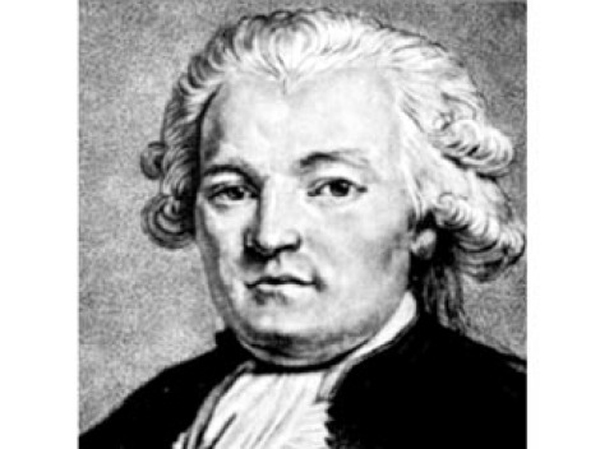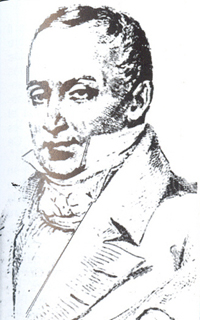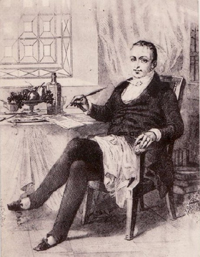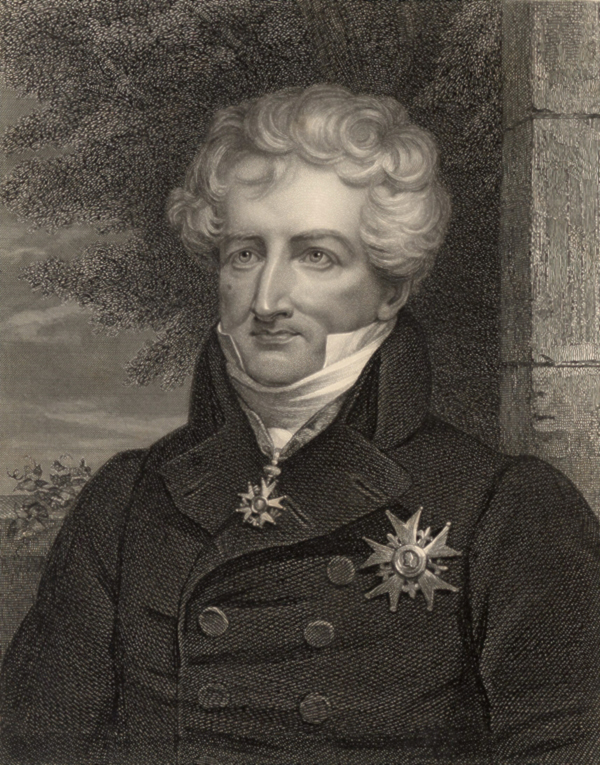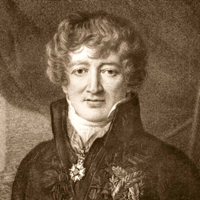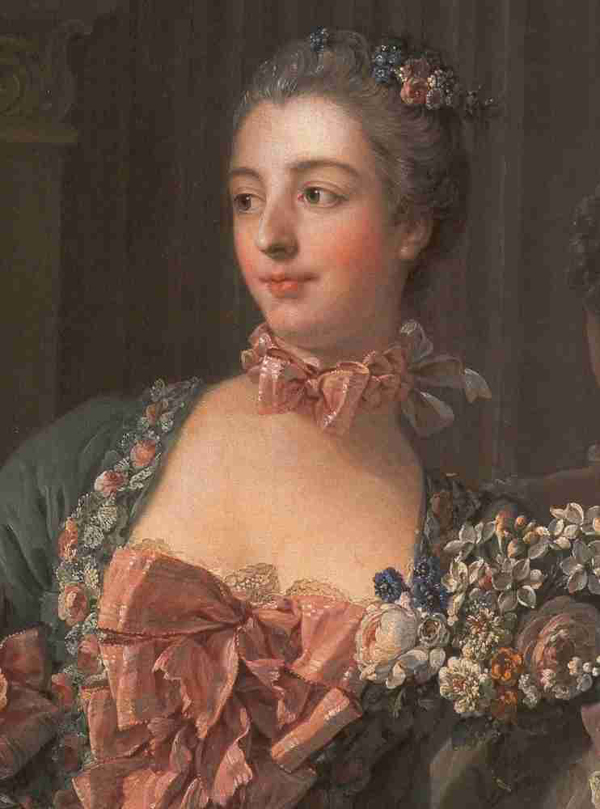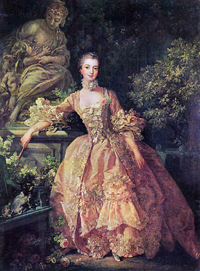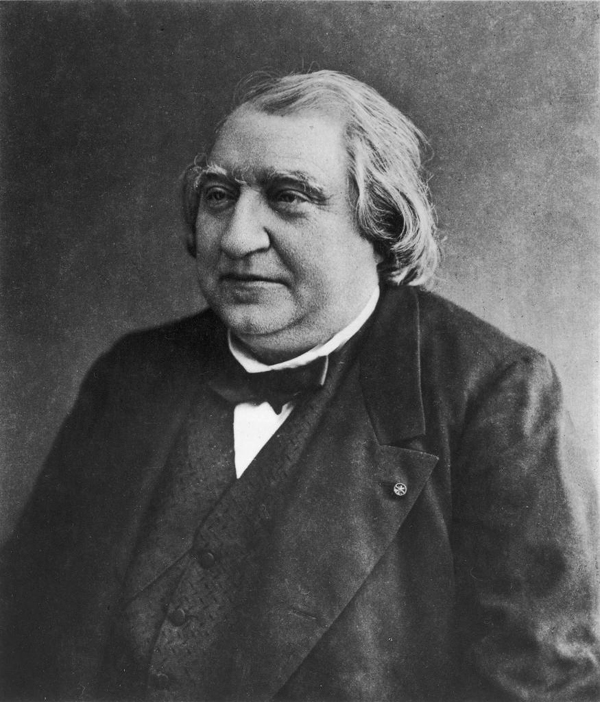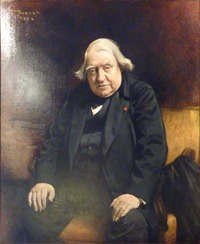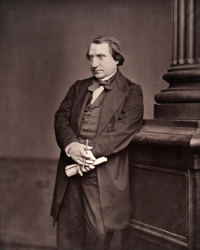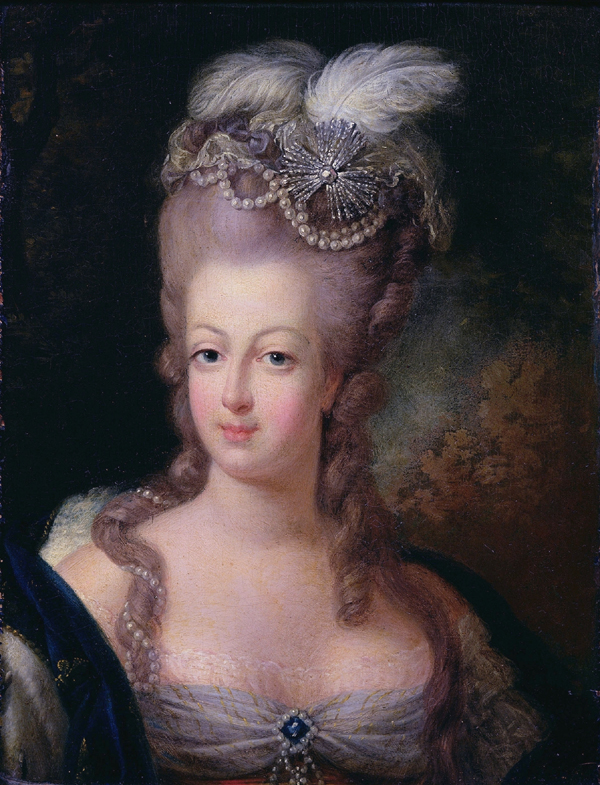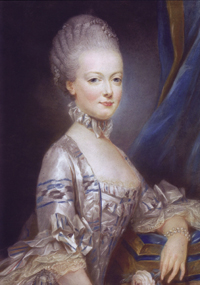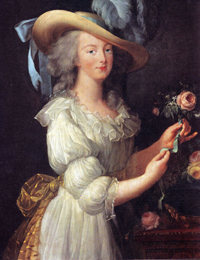History
Academics and Intellectuals
Alexis-Charles-Henri Clérel de Tocqueville
Known For: De la démocratie en Amérique (1835/1840) – Democracy in America, L'Ancien Régime et la Révolution (1856) – The Old Regime and the RevolutionLiterary figures included the poets Alphonse Marie Louis de Lamartine (1790–1869), Alfred de Vigny (1797–1863), Alfred de Musset (1810–57), Charles Baudelaire (1821–67), Stéphane Mallarmé (1842–98), Paul Verlaine (1844–96), and Arthur Rimbaud (1854–91); the fiction writers François René Chateaubriand (1768–1848), Stendhal (Marie Henri Beyle, 1783–1842), Honoré de Balzac (1799–1850), Victor Marie Hugo (1802–85), Alexandre Dumas the elder (1802–70) and his son, Alexandre Dumas the younger (1824–95), Prosper Merimée (1803–70), George Sand (Amandine Aurore Lucie Dupin, baronne Dudevant, 1804–76), Théophile Gautier (1811–72), Gustave Flaubert (1821–80), the Goncourt brothers (Edmond, 1822–96, and Jules, 1830–70), Jules Verne (1828–1905), Alphonse Daudet (1840–97), Emile Zola (1840–1902), and Guy de Maupassant (1850–93); and the historians and critics François Guizot (1787–1874), Jules Michelet (1798–1874), Charles Augustin Sainte-Beuve (1804–69), Alexis de Tocqueville (1805–59), Ernest Renan (1823–92), and Hippolyte Adolphe Taine (1828–93).Alexis-Charles-Henri Clérel de Tocqueville was a French political thinker and historian best known for his works Democracy in America (appearing in two volumes: 1835 and 1840) and The Old Regime and the Revolution (1856). In both of these, he analyzed the improved living standards and social conditions of individuals, as well as their relationship to the market and state in Western societies. Democracy in America was published after Tocqueville's travels in the United States, and is today considered an early work of sociology and political science. Tocqueville was active in French politics, first under the July Monarchy (1830–1848) and then during the Second Republic (1849–1851) which succeeded the February 1848 Revolution. He retired from political life after Louis Napoléon Bonaparte's 2 December 1851 coup, and thereafter began work on The Old Regime and the Revolution. He argued that the importance of the French Revolution was to continue the process of modernizing and centralizing the French state which had begun under King Louis XIV. The failure of the Revolution came from the inexperience of the deputies who were too wedded to abstract Enlightenment ideals. Tocqueville was a classical liberal who advocated parliamentary government, but was skeptical of the extremes of democracy.
Country: France
Date of Birth: 29 July 1805
Place of Birth: Paris, France
Date of Death: 16 April 1859
Please of Death: Cannes, France
Charles Augustin Sainte-Beuve
Known For: Tableau De La Poésie Française Au Seizième Siècle (1828), Vie, Poésies Et Pensées De Joseph Delorme (1829), Les Consolations (1830) (Poetry), Volupté (1835) (Novel), Port-Royal (1840–1859), Les Lundis (1851–1872), Causeries Du Lundi, 15 Vols. (1851–1862), Nouveaux Lundis (1863–1870)Literary figures included the poets Alphonse Marie Louis de Lamartine (1790–1869), Alfred de Vigny (1797–1863), Alfred de Musset (1810–57), Charles Baudelaire (1821–67), Stéphane Mallarmé (1842–98), Paul Verlaine (1844–96), and Arthur Rimbaud (1854–91); the fiction writers François René Chateaubriand (1768–1848), Stendhal (Marie Henri Beyle, 1783–1842), Honoré de Balzac (1799–1850), Victor Marie Hugo (1802–85), Alexandre Dumas the elder (1802–70) and his son, Alexandre Dumas the younger (1824–95), Prosper Merimée (1803–70), George Sand (Amandine Aurore Lucie Dupin, baronne Dudevant, 1804–76), Théophile Gautier (1811–72), Gustave Flaubert (1821–80), the Goncourt brothers (Edmond, 1822–96, and Jules, 1830–70), Jules Verne (1828–1905), Alphonse Daudet (1840–97), Emile Zola (1840–1902), and Guy de Maupassant (1850–93); and the historians and critics François Guizot (1787–1874), Jules Michelet (1798–1874), Charles Augustin Sainte-Beuve (1804–69), Alexis de Tocqueville (1805–59), Ernest Renan (1823–92), and Hippolyte Adolphe Taine (1828–93).Charles Augustin Sainte-Beuve was a literary critic of French literature.
Country: France
Date of Birth: 23 December 1804
Place of Birth: Boulogne-sur-Mer, France
Date of Death: 13 October 1869
Please of Death: Paris
David Émile Durkheim
Known For: Institutionalizing Sociology, Introducing the Sacred–Profane DichotomyÉmile Durkheim (1858–1917) was a founder of modern sociology.David Émile Durkheim was a French sociologist, social psychologist and philosopher. He formally established the academic discipline and — with Karl Marx and Max Weber — is commonly cited as the principal architect of modern social science and father of sociology.Much of Durkheim's work was concerned with how societies could maintain their integrity and coherence in modernity; an era in which traditional social and religious ties are no longer assumed, and in which new social institutions have come into being. His first major sociological work was The Division of Labour in Society (1893). In 1895, he published The Rules of Sociological Method and set up the first European department of sociology, becoming France's first professor of sociology.In 1898, he established the journal L'Année Sociologique. Durkheim's seminal monograph, Suicide (1897), a study of suicide rates in Catholic and Protestant populations, pioneered modern social research and served to distinguish social science from psychology and political philosophy. The Elementary Forms of the Religious Life (1912) presented a theory of religion, comparing the social and cultural lives of aboriginal and modern societies.Durkheim was also deeply preoccupied with the acceptance of sociology as a legitimate science. He refined the positivism originally set forth by Auguste Comte, promoting what could be considered as a form of epistemological realism, as well as the use of the hypothetico-deductive model in social science. For him, sociology was the science of institutions, if this term is understood in its broader meaning as "beliefs and modes of behaviour instituted by the collectivity"and its aim being to discover structural social facts. Durkheim was a major proponent of structural functionalism, a foundational perspective in both sociology and anthropology. In his view, social science should be purely holistic; that is, sociology should study phenomena attributed to society at large, rather than being limited to the specific actions of individuals.He remained a dominant force in French intellectual life until his death in 1917, presenting numerous lectures and published works on a variety of topics, including the sociology of knowledge, morality, social stratification, religion, law, education, and deviance. Durkheimian terms such as "collective consciousness" have since entered the popular lexicon.
Country: France
Date of Birth: 15 April 1858
Place of Birth: Épinal, France
Date of Death: 15 November 1917
Please of Death: Paris, France
Spouse: Louise Dreyfus
Denis Diderot
Known For:
Co-Founder, chief editor and contributor to the Encyclopédie, along with Jean Le Rond D'Alembert. Authored Jacques le fataliste et son maître (Jacques the Fatalist and his Master), Le Neveu de Rameau (Rameau's Nephew)
Denis Diderot (1713–84) and Jean Le Rond d'Alembert (1717–83) created the Great Encyclopedia ( Encyclopédie ou Dictionnaire Raisonné des Sciences, des Artes et des Métiers ).
Denis Diderot was a French philosopher, art critic and writer. He was a prominent figure during the Enlightenment and is best known for serving as co-founder, chief editor and contributor to the Encyclopédie along with Jean le Rond d'Alembert. Diderot also contributed to literature, notably with Jacques le fataliste et son maître (Jacques the Fatalist and his Master), which was influenced by Laurence Sterne's novel Tristram Shandy in challenging conventions regarding novels and their structure and content, while also examining philosophical ideas about free will. Diderot is also known as the author of the dialogue Le Neveu de Rameau (Rameau's Nephew), upon which many articles and sermons about consumer desire have been based.
Country: France
Date of Birth: 5 October 1713
Place of Birth: Langres, Champagne, France
Date of Death: 31 July 1784
Please of Death: Paris, France
Ferdinand Édouard Buisson
Known For: Presided over the League of Education from 1902 to 1906, Presided over the Human Rights League (LDH) from 1914 to 1926, Director of Primary EducationWinners of the Nobel Peace Prize include Frédéric Passy (1822–1912) in 1901, Benjamin Constant (1852–1924) in 1909, Léon Victor Auguste (1851–1925) in 1920, Aristide Briand (1862–1932) in 1926, Ferdinand Buisson (1841–1932) in 1927, and René Cassin (1887–1976) in 1968.Ferdinand Édouard Buisson was a French academic, educational bureaucrat, pacifist and Radical-Socialist (left liberal) politician. He presided over the League of Education from 1902 to 1906 and the Human Rights League (LDH) from 1914 to 1926. In 1927, the Nobel Peace Prize was awarded to him jointly with Ludwig Quidde. Philosopher and educator, he was Director of Primary Education. He was the author of a thesis on Sebastian Castellio, in whom he saw a "liberal Protestant" in his image. Ferdinand Buisson was the president of the National Association of Freethinkers . In 1905, he chaired the parliamentary committee to implement the separation of church and state. Famous for his fight for secular education through the League of Education, he coined the term laïcité ("secularism").
Country: France
Date of Birth: 20 December 1841
Place of Birth: Paris, France
Date of Death: 16 February 1932
Please of Death: Thieuloy-Saint-Antoine, France
Fernand Braudel
Known For: The Mediterranean (1923–49 and 1949–66), Civilization and Capitalism (1955–79), Identity of France (1970–85) (unfinished)Claude Lévi-Strauss (b.Belgium, 1908) is a noted anthropologist, and Fernand Braudel (1902–85) was an important historian.Fernand Braudel was a French historian and a leader of the Annales School. His scholarship focused on three main projects: The Mediterranean (1923–49, then 1949–66), Civilization and Capitalism (1955–79), and the unfinished Identity of France (1970–85). His reputation stems in part from his writings, but even more from his success in making the Annales School the most important engine of historical research in France and much of the world after 1950. As the dominant leader of the Annales School of historiography in the 1950s and 1960s, he exerted enormous influence on historical writing in France and other countries.Braudel has been considered one of the greatest of the modern historians who have emphasized the role of large-scale socioeconomic factors in the making and writing of history.He can also be considered as one of the precursors of world-systems theory.
Country: France
Date of Birth: 24 August 1902
Place of Birth: Luméville-en-Ornois, France
Date of Death: 27 November 1985
Please of Death: Cluses, France
Frédéric Passy
Known For:
Mélanges Économiques (1857), De La Propriété Intellectuelle (1859), De L'Enseignement Obligatoire (1859), Leçons D'Économie Politique (1860–61), La Démocratie Et L'Instruction (1864), La Guerre Et La Paix (1867), L'Histoire Du Travail (1873), Malthus Et Sa Doctrine (1868), L'Histoire Et Les Sciences Morales Et Politiques (1879), Le Petit Poucet Du XIXe Siècle: George Stephenson (1881), Historique Du Mouvement De La Paix (1905)
Winners of the Nobel Peace Prize include Frédéric Passy (1822–1912) in 1901, Benjamin Constant (1852–1924) in 1909, Léon Victor Auguste (1851–1925) in 1920, Aristide Briand (1862–1932) in 1926, Ferdinand Buisson (1841–1932) in 1927, and René Cassin (1887–1976) in 1968.
Frédéric Passy was a French economist and a joint winner (together with Henry Dunant) of the first Nobel Peace Prize awarded in 1901.
Country: France
Date of Birth: 20 May 1822
Place of Birth: Paris, France
Date of Death: 12 June 1912
Please of Death: Paris, France
Henri-Louis Bergson
Known For: Metaphysics, Epistemology, Philosophy of Language, Philosophy of MathematicsThe philosopher Henri Bergson (1859–1941) received the 1927 Nobel Prize for literature.Henri-Louis Bergson was a major French philosopher, influential especially in the first half of the 20th century. Bergson convinced many thinkers that the processes of immediate experience and intuition are more significant than abstract rationalism and science for understanding reality. Bergson had a long affair with musicologist Janet Levy which led to her article "A Source of Musical Wit and Humor." This was a well-regarded article used by many later writers.He was awarded the 1927 Nobel Prize in Literature "in recognition of his rich and vitalizing ideas and the brilliant skill with which they have been presented".In 1930 France awarded him its highest honour, the Grand-Croix de la Legion d'honneur.
Country: France
Date of Birth: 18 October 1859
Place of Birth: Paris, France
Date of Death: 4 January 1941
Please of Death: Paris, France
Spouse: Louise Neuberger
Isidore Auguste Marie François Xavier Comte
Known For: Positivism, Law of Three Stages, Encyclopedic Law, AltruismAuguste (Isidore Auguste Marie François Xavier) Comte (1798–1857) was an influential philosopher.Isidore Auguste Marie François Xavier Comte, was a French philosopher. He was a founder of the discipline of sociology and of the doctrine of positivism. He is sometimes regarded as the first philosopher of science in the modern sense of the term. Influenced by the utopian socialist Henri Saint-Simon, Comte developed the positive philosophy in an attempt to remedy the social malaise of the French Revolution, calling for a new social doctrine based on the sciences. Comte was a major influence on 19th-century thought, influencing the work of social thinkers such as Karl Marx, John Stuart Mill, and George Eliot. His concept of sociologie and social evolutionism set the tone for early social theorists and anthropologists such as Harriet Martineau and Herbert Spencer, evolving into modern academic sociology presented by Émile Durkheim as practical and objective social research. Comte's social theories culminated in the "Religion of Humanity", which influenced the development of religious humanist and secular humanist organizations in the 19th century. Comte likewise coined the word altruisme (altruism).
Country: France
Date of Birth: 19 January 1798
Place of Birth: Montpellier, France
Date of Death: 5 September 1857
Please of Death: Paris, France
Spouse: Caroline Massin
Jean de La Bruyère
Known For: Caractères (1688)In literature, the great sermons and moralizing writings of Jacques Bénigne Bossuet, bishop of Meaux (1627–1704), and François Fénelon (1651–1715); the dramas of Pierre Corneille (1606–84), Molière (Jean-Baptiste Poquelin, 1622–73), and Jean Racine (1639–99); the poetry of Jean de La Fontaine (1621–95) and Nicolas Boileau-Despréaux (1636–1711); the maxims of François, duc de La Rochefoucauld (1613–80), and Jean de La Bruyère (1645–96); the fairy tales of Charles Perrault (1628–1703); the satirical fantasies of Savinien de Cyrano de Bergerac (1619–55); and the witty letters of Madame de Sévigné (1626–96) made this a great age for France.Jean de La Bruyère was a French philosopher and moralist.
Country: France
Date of Birth: 16 August 1645
Place of Birth: Paris, Kingdom of France
Date of Death: 11 May 1696
Please of Death: Versailles, Kingdom of France
Jean-Jacques Rousseau
Known For: General will, Amour de soi, Amour-propre, moral simplicity of humanity, child-centered learning, civil religion, popular sovereignty, positive libertyCharles Louis de Secondat, baron de La Brède et de Montesquieu (1689–1755), and Jean-Jacques Rousseau (b.Switzerland, 1712–78) left their mark on philosophy.Jean-Jacques Rousseau was a Genevan philosopher, writer, and composer of the 18th century. His political philosophy influenced the French Revolution as well as the overall development of modern political, sociological, and educational thought. Rousseau's novel Emile, or On Education is a treatise on the education of the whole person for citizenship. His sentimental novel Julie, or the New Heloise was of importance to the development of pre-romanticism and romanticism in fiction. Rousseau's autobiographical writings — his Confessions, which initiated the modern autobiography, and his Reveries of a Solitary Walker — exemplified the late 18th-century movement known as the Age of Sensibility, and featured an increased focus on subjectivity and introspection that later characterized modern writing. His Discourse on Inequality and The Social Contract are cornerstones in modern political and social thought. Rousseau was a successful composer of music, who wrote seven operas as well as music in other forms, and made contributions to music as a theorist. As a composer, his music was a blend of the late Baroque style and the emergent Classical fashion, and he belongs to the same generation of transitional composers as Christoph Willibald Gluck and C.P.E. Bach. One of his more well-known works is the one-act opera Le devin du village, containing the duet "Non, Colette n'est point trompeuse" which was later rearranged as a standalone song by Beethoven. During the period of the French Revolution, Rousseau was the most popular of the philosophes among members of the Jacobin Club. Rousseau was interred as a national hero in the Panthéon in Paris, in 1794, 16 years after his death.
Country: France
Date of Birth: 28 June 1712
Place of Birth: Geneva, Republic of Geneva
Date of Death: 2 July 1778
Please of Death: Ermenonville, France
Jean-Paul Charles Aymard Sartre
Known For: Nausea / La Nausée (1938), the Wall / Le Mur (1939), Bariona / Bariona, Ou Le Fils Du Tonnerre (1940), the Flies / Les Mouches (1943), the Age of Reason / L'Âge De Raison (1945), the Reprieve / Le Sursis (1945), Kean (1953)Honored writers include Sully-Prudhomme (René François Armand, 1839–1907), winner of the first Nobel Prize for literature in 1901; Frédéric Mistral (1830–1914), Nobel Prize winner in 1904; Edmond Rostand (1868–1918); Anatole France (Jacques Anatole Thibaut, 1844–1924), Nobel Prize winner in 1921; Romain Rolland (1866–1944), Nobel Prize winner in 1915; André Paul Guillaume Gide (1869–1951), a 1947 nobel laureate; Marcel Proust (1871–1922); Paul Valéry (1871–1945); Colette (Sidonie Gabrielle Claudine Colette, 1873–1954); Roger Martin du Gard (1881–1958), Nobel Prize winner in 1937; Jean Giraudoux (1882–1944); François Mauriac (1885–1970), 1952 Nobel Prize winner; Jean Cocteau (1889–1963); Louis Aragon (1897–1982); André Malraux (1901–76); Jean-Paul Sartre (1905–80), who received the 1964 Nobel Prize; Simone Lucie Ernestine Marie Bertrand de Beauvoir (1908–86); Simone Weil (1909–43); Jean Genet (1910–86); Jean Anouilh (1910–87); Albert Camus (1913–60), Nobel Prize winner in 1957; Claude Simon (b.1913), a 1985 Nobel laureate; Marguerite Duras (1914–96); and Roland Barthes (1915–80).Jean-Paul Charles Aymard Sartre was a French philosopher, playwright, novelist, political activist, biographer, and literary critic. He was one of the key figures in the philosophy of existentialism and phenomenology, and one of the leading figures in 20th-century French philosophy and Marxism.His work has also influenced sociology, critical theory, post-colonial theory, and literary studies, and continues to influence these disciplines. Sartre has also been noted for his open relationship with the prominent feminist theorist Simone de Beauvoir.He was awarded the 1964 Nobel Prize in Literature but refused it, saying that he always declined official honors and that "a writer should not allow himself to be turned into an institution"
Country: France
Date of Birth: 21 June 1905
Place of Birth: Paris, France
Date of Death: 15 April 1980
Please of Death: Paris, France
Spouse: Dominique Desanti
Jules Michelet
Known For: Histoire de France (History of France), History of the French RevolutionLiterary figures included the poets Alphonse Marie Louis de Lamartine (1790–1869), Alfred de Vigny (1797–1863), Alfred de Musset (1810–57), Charles Baudelaire (1821–67), Stéphane Mallarmé (1842–98), Paul Verlaine (1844–96), and Arthur Rimbaud (1854–91); the fiction writers François René Chateaubriand (1768–1848), Stendhal (Marie Henri Beyle, 1783–1842), Honoré de Balzac (1799–1850), Victor Marie Hugo (1802–85), Alexandre Dumas the elder (1802–70) and his son, Alexandre Dumas the younger (1824–95), Prosper Merimée (1803–70), George Sand (Amandine Aurore Lucie Dupin, baronne Dudevant, 1804–76), Théophile Gautier (1811–72), Gustave Flaubert (1821–80), the Goncourt brothers (Edmond, 1822–96, and Jules, 1830–70), Jules Verne (1828–1905), Alphonse Daudet (1840–97), Emile Zola (1840–1902), and Guy de Maupassant (1850–93); and the historians and critics François Guizot (1787–1874), Jules Michelet (1798–1874), Charles Augustin Sainte-Beuve (1804–69), Alexis de Tocqueville (1805–59), Ernest Renan (1823–92), and Hippolyte Adolphe Taine (1828–93).Jules Michelet was a French historian. He was born in Paris to a family with Huguenot traditions. In his 1855 work, Histoire de France (History of France), Jules Michelet was the first historian to use and define the word Renaissance ("Re-birth" in French), as a period in Europe's cultural history that represented a drastic break from the Middle Ages (which he loathed), creating a modern understanding of humanity and its place in the world. Historian François Furet wrote that his History of the French Revolution remains "the cornerstone of all revolutionary historiography and is also a literary monument." His aphoristic style emphasized his anti-clerical republicanism.
Country: France
Date of Birth: 21 August 1798
Place of Birth: Paris, France
Date of Death: 9 February 1874
Please of Death: Hyères, France
Spouse: Athénaïs Michelet
Louis Braille
Known For: Inventor of a system of reading and writing for use by the blind or visually impairedLouis Braille (1809–52) invented the method of writing books for the blind that bears his name.Louis Braille was a French educator and inventor of a system of reading and writing for use by the blind or visually impaired. His system remains known worldwide simply as braille. Blinded in both eyes as a result of an early childhood accident, Braille mastered his disability while still a boy. He excelled in his education and received scholarship to France's Royal Institute for Blind Youth. While still a student there, he began developing a system of tactile code that could allow blind persons to read and write quickly and efficiently. Inspired by the military cryptography of Charles Barbier, Braille constructed a new method built specifically for the needs of the blind. He presented his work to his peers for the first time in 1824. In adulthood, Braille served as a professor at the Institute and enjoyed an avocation as a musician, but he largely spent the remainder of his life refining and extending his system. It went unused by most educators for many years after his death, but posterity has recognized braille as a revolutionary invention, and it has been adapted for use in languages worldwide.
Country: France
Date of Birth: 4 January 1809
Place of Birth: Coupvray, France
Date of Death: 6 January 1852
Please of Death: Paris, France
Michel Eyquem de Montaigne
Known For: The essay, Montaigne's wheel argumentModern French literature began during the 16th century, with François Rabelais (1490?–1553), Joachim du Bellay (1522–60), Pierre de Ronsard (1525–85), and Michel de Montaigne (1533–92).Michel Eyquem de Montaigne was one of the most significant philosophers of the French Renaissance, known for popularizing the essay as a literary genre. His work is noted for its merging of casual anecdotes and autobiography with serious intellectual insight; his massive volume Essais (translated literally as "Attempts" or "Trials") contains some of the most influential essays ever written. Montaigne had a direct influence on writers all over the world, including René Descartes, Blaise Pascal, Jean-Jacques Rousseau, Albert Hirschman, William Hazlitt, Ralph Waldo Emerson, Friedrich Nietzsche, Stefan Zweig, Eric Hoffer, Isaac Asimov, and possibly on the later works of William Shakespeare. In his own lifetime, Montaigne was admired more as a statesman than as an author. The tendency in his essays to digress into anecdotes and personal ruminations was seen as detrimental to proper style rather than as an innovation, and his declaration that, 'I am myself the matter of my book', was viewed by his contemporaries as self-indulgent. In time, however, Montaigne would come to be recognized as embodying, perhaps better than any other author of his time, the spirit of freely entertaining doubt which began to emerge at that time. He is most famously known for his skeptical remark, "Que sçay-je?" ("What do I know?", in Middle French; directly rendered Que sais-je? in modern French). Remarkably modern even to readers today, Montaigne's attempt to examine the world through the lens of the only thing he can depend on implicitly—his own judgment—makes him more accessible to modern readers than any other author of the Renaissance. Much of modern literary non-fiction has found inspiration in Montaigne and writers of all kinds continue to read him for his masterful balance of intellectual knowledge and personal storytelling.
Country: France
Date of Birth: 28 February 1533
Place of Birth: Château de Montaigne, Guyenne, France
Date of Death: 13 September 1592
Please of Death: Château de Montaigne, Guyenne, France
Pierre Gassendi
Known For: Syntagma philosophicum, AnimadversionesPierre Gassendi (1592–1655) was a philosopher and physicist; Pierre de Fermat (1601–55) was a noted mathematician.Pierre Gassendi was a French philosopher, priest, scientist, astronomer, and mathematician. While he held a church position in south-east France, he also spent much time in Paris, where he was a leader of a group of free-thinking intellectuals. He was also an active observational scientist, publishing the first data on the transit of Mercury in 1631. The lunar crater Gassendi is named after him. He wrote numerous philosophical works, and some of the positions he worked out are considered significant, finding a way between scepticism and dogmatism. Richard Popkin indicates that Gassendi was one of the first thinkers to formulate the modern "scientific outlook", of moderated scepticism and empiricism. He clashed with his contemporary Descartes on the possibility of certain knowledge. His best known intellectual project attempted to reconcile Epicurean atomism with Christianity.
Country: France
Date of Birth: 22 January 1592
Place of Birth: Champtercier, Provence
Date of Death: 24 October 1655
Please of Death: Paris
Pierre Teilhard de Chardin
Known For: The Phenomenon of Man, The Divine Milieu, The Synthesis of theology and SciencePierre Teilhard de Chardin (1881–1955), a Jesuit, was both a prominent paleontologist and an influential theologian.Pierre Teilhard de Chardin was a French philosopher and Jesuit priest who trained as a paleontologist and geologist and took part in the discovery of Peking Man. He conceived the idea of the Omega Point (a maximum level of complexity and consciousness towards which he believed the Universe was evolving) and developed Vladimir Vernadsky's concept of noosphere.Many of Teilhard's writings were censored by the Catholic Church during his lifetime because of his views on original sin. However, in July 2009, Vatican spokesman Fr. Federico Lombardi said: "By now, no one would dream of saying that [Teilhard] is a heterodox author who shouldn’t be studied." and he has been praised by Pope Benedict XVI.Teilhard de Chardin's paleontological work is uncontroversial amongst scientists, but his evolutionary theorizing is today outdated.
Country: France
Date of Birth: 1 May 1881
Place of Birth: Orcines, France
Date of Death: 10 April 1955
Please of Death: New York, USA
René Descartes
Known For: Cogito ergo sum, method of doubt, method of normals, Cartesian coordinate system, Cartesian dualism, ontological argument for the existence of God, mathesis universalis; folium of DescartesTwo leading French philosophers and mathematicians of the period, René Descartes (1596–1650) and Blaise Pascal (1623–62), left their mark on the whole of European thought.René Descartes was a French philosopher, mathematician and writer who spent most of his life in the Dutch Republic. He has been dubbed the father of modern philosophy, and much subsequent Western philosophy is a response to his writings, which are studied closely to this day. In particular, his Meditations on First Philosophy continues to be a standard text at most university philosophy departments. Descartes' influence in mathematics is equally apparent; the Cartesian coordinate system — allowing reference to a point in space as a set of numbers, and allowing algebraic equations to be expressed as geometric shapes in a two-dimensional coordinate system (and conversely, shapes to be described as equations) — was named after him. He is credited as the father of analytical geometry, the bridge between algebra and geometry, crucial to the discovery of infinitesimal calculus and analysis. Descartes was also one of the key figures in the scientific revolution and has been described as an example of genius. Descartes refused to accept the authority of previous philosophers, and refused to trust his own senses. He frequently set his views apart from those of his predecessors. In the opening section of the Passions of the Soul, a treatise on the early modern version of what are now commonly called emotions, Descartes goes so far as to assert that he will write on this topic "as if no one had written on these matters before". Many elements of his philosophy have precedents in late Aristotelianism, the revived Stoicism of the 16th century, or in earlier philosophers like Augustine. In his natural philosophy, he differs from the schools on two major points: First, he rejects the splitting of corporeal substance into matter and form; second, he rejects any appeal to final ends—divine or natural—in explaining natural phenomena. In his theology, he insists on the absolute freedom of God's act of creation. Descartes laid the foundation for 17th-century continental rationalism, later advocated by Baruch Spinoza and Gottfried Leibniz, and opposed by the empiricist school of thought consisting of Hobbes, Locke, Berkeley, and Hume. Leibniz, Spinoza and Descartes were all well versed in mathematics as well as philosophy, and Descartes and Leibniz contributed greatly to science as well. His best known philosophical statement is "Cogito ergo sum" (French: Je pense, donc je suis; I think, therefore I am), found in part IV of Discourse on the Method (1637 – written in French but with inclusion of "Cogito ergo sum") and §7 of part I of Principles of Philosophy (1644 – written in Latin).
Country: France
Date of Birth: 31 March 1596
Place of Birth: La Haye en Touraine, Kingdom of France
Date of Death: 11 February 1650
Please of Death: Stockholm, Swedish Empire
René François Armand Prudhomme
Known For: Stances Et Poèmes (Stanzas and Poems 1865), Impressions De La Guerre (1872), La France (1874)Honored writers include Sully-Prudhomme (René François Armand, 1839–1907), winner of the first Nobel Prize for literature in 1901; Frédéric Mistral (1830–1914), Nobel Prize winner in 1904; Edmond Rostand (1868–1918); Anatole France (Jacques Anatole Thibaut, 1844–1924), Nobel Prize winner in 1921; Romain Rolland (1866–1944), Nobel Prize winner in 1915; André Paul Guillaume Gide (1869–1951), a 1947 nobel laureate; Marcel Proust (1871–1922); Paul Valéry (1871–1945); Colette (Sidonie Gabrielle Claudine Colette, 1873–1954); Roger Martin du Gard (1881–1958), Nobel Prize winner in 1937; Jean Giraudoux (1882–1944); François Mauriac (1885–1970), 1952 Nobel Prize winner; Jean Cocteau (1889–1963); Louis Aragon (1897–1982); André Malraux (1901–76); Jean-Paul Sartre (1905–80), who received the 1964 Nobel Prize; Simone Lucie Ernestine Marie Bertrand de Beauvoir (1908–86); Simone Weil (1909–43); Jean Genet (1910–86); Jean Anouilh (1910–87); Albert Camus (1913–60), Nobel Prize winner in 1957; Claude Simon (b.1913), a 1985 Nobel laureate; Marguerite Duras (1914–96); and Roland Barthes (1915–80).René François Armand (Sully) Prudhomme was a French poet and essayist, and was the first ever winner of the Nobel Prize in Literature, in 1901.Born in Paris, Prudhomme originally studied to be an engineer, but turned to philosophy and later to poetry; he declared it as his intent to create scientific poetry for modern times. In character sincere and melancholic, he was linked to the Parnassus school, although, at the same time, his work displays characteristics of its own.
Country: France
Date of Birth: 16 March 1839
Place of Birth: Paris, France
Date of Death: 6 September 1907
Please of Death: Châtenay-Malabry, France
Roland Gérard Barthes
Known For: Le Degré Zéro De L'Écriture (1953), Michelet Par Lui-Même (1954), Sur Racine (1963), Éléments De Sémiologie (1964), Writing Degree Zero (1967), L'Empire Des Signes, Skira (1970)Honored writers include Sully-Prudhomme (René François Armand, 1839–1907), winner of the first Nobel Prize for literature in 1901; Frédéric Mistral (1830–1914), Nobel Prize winner in 1904; Edmond Rostand (1868–1918); Anatole France (Jacques Anatole Thibaut, 1844–1924), Nobel Prize winner in 1921; Romain Rolland (1866–1944), Nobel Prize winner in 1915; André Paul Guillaume Gide (1869–1951), a 1947 nobel laureate; Marcel Proust (1871–1922); Paul Valéry (1871–1945); Colette (Sidonie Gabrielle Claudine Colette, 1873–1954); Roger Martin du Gard (1881–1958), Nobel Prize winner in 1937; Jean Giraudoux (1882–1944); François Mauriac (1885–1970), 1952 Nobel Prize winner; Jean Cocteau (1889–1963); Louis Aragon (1897–1982); André Malraux (1901–76); Jean-Paul Sartre (1905–80), who received the 1964 Nobel Prize; Simone Lucie Ernestine Marie Bertrand de Beauvoir (1908–86); Simone Weil (1909–43); Jean Genet (1910–86); Jean Anouilh (1910–87); Albert Camus (1913–60), Nobel Prize winner in 1957; Claude Simon (b.1913), a 1985 Nobel laureate; Marguerite Duras (1914–96); and Roland Barthes (1915–80).Roland Gérard Barthes was a French literary theorist, philosopher, linguist, critic, and semiotician. Barthes' ideas explored a diverse range of fields and he influenced the development of schools of theory including structuralism, semiotics, social theory, designtheory, anthropology and post-structuralism.
Country: France
Date of Birth: 12 November 1915
Place of Birth: Cherbourg, France
Date of Death: 26 March 1980
Please of Death: Paris, France
Simone Weil
Known For: Réflexions Sur La Guerre, La Pesanteur Et La Grâce (1947), L'Enracinement (1949), Attente De Dieu (1950), Lettre À Un Religieux (1951)Honored writers include Sully-Prudhomme (René François Armand, 1839–1907), winner of the first Nobel Prize for literature in 1901; Frédéric Mistral (1830–1914), Nobel Prize winner in 1904; Edmond Rostand (1868–1918); Anatole France (Jacques Anatole Thibaut, 1844–1924), Nobel Prize winner in 1921; Romain Rolland (1866–1944), Nobel Prize winner in 1915; André Paul Guillaume Gide (1869–1951), a 1947 nobel laureate; Marcel Proust (1871–1922); Paul Valéry (1871–1945); Colette (Sidonie Gabrielle Claudine Colette, 1873–1954); Roger Martin du Gard (1881–1958), Nobel Prize winner in 1937; Jean Giraudoux (1882–1944); François Mauriac (1885–1970), 1952 Nobel Prize winner; Jean Cocteau (1889–1963); Louis Aragon (1897–1982); André Malraux (1901–76); Jean-Paul Sartre (1905–80), who received the 1964 Nobel Prize; Simone Lucie Ernestine Marie Bertrand de Beauvoir (1908–86); Simone Weil (1909–43); Jean Genet (1910–86); Jean Anouilh (1910–87); Albert Camus (1913–60), Nobel Prize winner in 1957; Claude Simon (b.1913), a 1985 Nobel laureate; Marguerite Duras (1914–96); and Roland Barthes (1915–80).Simone Weil was a French philosopher, Christian mystic, and political activist.Weil's life was marked by an exceptional compassion for the suffering of others; at the age of six, for instance, she refused to eat sugar after she heard that soldiers fighting in World War I had to go without. She died from tuberculosis during World War II, possibly exacerbated by malnutrition after refusing to eat more than the minimal rations that she believed were available to soldiers at the time.After her graduation from formal education, Weil became a teacher. She taught intermittently throughout the 1930s, taking several breaks due to poor health and to devote herself to political activism, work that would see her assisting in the trade union movement, taking the side of the Anarchists known as the Durruti Column in the Spanish Civil War, and spending more than a year working as a labourer, mostly in auto factories, so she could better understand the working class.Taking a path that was unusual among twentieth-century left-leaning intellectuals, she became more religious and inclined towards mysticism as her life progressed. Weil wrote throughout her life, though most of her writings did not attract much attention until after her death. In the 1950s and 1960s, her work became famous on continental Europe and throughout the English-speaking world. Her thought has continued to be the subject of extensive scholarship across a wide range of fields. A meta study from the University of Calgary found that between 1995 and 2012 over 2, 500 new scholarly works had been published about her. Although sometimes described as odd, humourless, and irritating, she inspired great affection in many of those who knew her. Albert Camus described her as "the only great spirit of our times".
Country: France
Date of Birth: 3 February 1909
Place of Birth: Paris, France
Date of Death: 24 August 1943
Please of Death: Ashford, Kent, England
Activists and Revolutionaries
Georges Jacques Danton
Known For: 1st President of the Committee of Public Safety (6 April 1793 – 27 July 1793), MInister of Justice (10 August 1792 – 9 October 1792), President of the National Convetion (25 July 1793 – 8 August 1793), Deputy to the National Convetion (20 September 1792 – 5 April 1794)Outstanding figures of the Revolution included Jean-Paul Marat (1743–93), Honoré Gabriel Riquetti, comte de Mirabeau (1749–91), Maximilien Marie Isidore Robespierre (1758–94), and Georges Jacques Danton (1759–94).Georges Jacques Danton was a leading figure in the early stages of the French Revolution and the first President of the Committee of Public Safety. Danton's role in the onset of the Revolution has been disputed; many historians describe him as "the chief force in the overthrow of the monarchy and the establishment of the First French Republic". A moderating influence on the Jacobins, he was guillotined by the advocates of revolutionary terror after accusations of venality and leniency to the enemies of the Revolution.
Country: France
Date of Birth: 26 October 1759
Place of Birth: Arcis-sur-Aube, France
Date of Death: 5 April 1794
Please of Death: Paris, France
Spouse: Antoinette Gabrielle Danton, Louise Sébastienne Gély
Honoré Gabriel Riqueti, comte de Mirabeau
Known For: President of the National Constituent Assembly (30 January 1791 – 15 February 1791), Deputy for the National Constituent Assembly (4 May 1789 – 2 April 1791)Outstanding figures of the Revolution included Jean-Paul Marat (1743–93), Honoré Gabriel Riquetti, comte de Mirabeau (1749–91), Maximilien Marie Isidore Robespierre (1758–94), and Georges Jacques Danton (1759–94).Honoré Gabriel Riqueti, comte de Mirabeau was a leader of the early stages of the French revolution. A noble, before 1789 he was involved in numerous scandals that left his reputation in ruins. However during the early years (1789–91) of the French Revolution he rose to the top and became the voice of the people. A successful orator, he was the leader of the moderate position, favoring a constitutional monarchy built on the model of Great Britain. When he died (of natural causes) he was a great national hero, even though support for his moderate position was slipping away. The later discovery that starting in 1790 he was in the pay of the king and the Austrian enemies of France caused his disgrace. Historians are deeply split on whether he was a great leader who almost saved the nation from the Terror, or a venal demagogue lacking political or moral values, or a traitor in the pay of the enemy.
Country: France
Date of Birth: 9 March 1749
Place of Birth: Le Bignon near Nemours, France
Date of Death: 2 April 1791
Please of Death: Paris, France
Spouse: Emilie de Covet de Marignane
Jean-Paul Marat
Known For: L'Ami du peuple (Friend of the People)Outstanding figures of the Revolution included Jean-Paul Marat (1743–93), Honoré Gabriel Riquetti, comte de Mirabeau (1749–91), Maximilien Marie Isidore Robespierre (1758–94), and Georges Jacques Danton (1759–94).Jean-Paul Marat was a physician, political theorist and scientist best known for his career in France as a radical journalist and politician during the French Revolution. His journalism became renowned for its fierce tone, uncompromising stance toward the new leaders and institutions of the revolution, and advocacy of basic human rights for the poorest members of society. Marat was one of the most radical voices of the French Revolution. He became a vigorous defender of the sans-culottes, publishing his views in pamphlets, placards and newspapers, notably his "L'Ami du peuple", which helped make him their unofficial link with the radical, republican Jacobin group that came to power after June 1793. Marat was assassinated by Charlotte Corday, a Girondist sympathizer, while taking a medicinal bath for his debilitating skin condition. In his death, Marat became an icon to the Jacobins, a sort of revolutionary martyr, as portrayed in Jacques-Louis David's famous painting of his death.
Country: France
Date of Birth: 24 May 1743
Place of Birth: Boudry, Principality of Neuchâtel, Prussia
Date of Death: 13 July 1793
Please of Death: Paris, France
Spouse: Simonne Evrard
Maximilien François Marie Isidore de Robespierre
Known For: President of the Committee of Public Safety (27 July 1793 – 27 July 1794), President of the National Convention (4 June 1794 – 17 June 1794 and 22 August 1793 – 5 September 1793), Deputy of the National Convention (20 September 1792 – 27 July 1794), Deputy of the National Constituent Assembly (9 July 1789 – 30 September 1791), Deputy of the National Assembly (17 June 1789 – 9 July 1789), Member of the Estates General for the Third Estate (6 May 1789 – 16 June 1789)Outstanding figures of the Revolution included Jean-Paul Marat (1743–93), Honoré Gabriel Riquetti, comte de Mirabeau (1749–91), Maximilien Marie Isidore Robespierre (1758–94), and Georges Jacques Danton (1759–94).Maximilien François Marie Isidore de Robespierre was a French lawyer and politician, and one of the best-known and most influential figures of the French Revolution. As a member of the Estates-General, the Constituent Assembly and the Jacobin Club, he opposed the death penalty and advocated the abolition of slavery, while supporting equality of rights, universal male suffrage and the establishment of a republic. He opposed dechristianisation of France, war with Austria and the possibility of a coup by the Marquis de Lafayette. As a member of the Committee of Public Safety, he was an important figure during the period of the Revolution commonly known as the Reign of Terror, which ended a few months after his arrest and execution in July 1794 following the Thermidorian reaction. The Thermidorians accused him of being the "soul" of the Terror, although his guilt in the brutal excesses of the Terror has not been proven. Influenced by 18th-century Enlightenment philosophes such as Rousseau and Montesquieu, he was a capable articulator of the beliefs of the left-wing bourgeoisie. His steadfast adherence and defense of the views he expressed earned him the nickname l'Incorruptible (The Incorruptible). His reputation has gone through cycles. It peaked in the 1920s when the influential French historian Albert Mathiez rejected the common view of Robespierre as demagogic, dictatorial, and fanatical. Mathiez argued he was an eloquent spokesman for the poor and oppressed, an enemy of royalist intrigues, a vigilant adversary of dishonest and corrupt politicians, a guardian of the French Republic, an intrepid leader of the French Revolutionary government, and a prophet of a socially responsible state. However, his reputation has suffered from his association with radical purification of politics by the killing of enemies.
Country: France
Date of Birth: 6 May 1758
Place of Birth: Arras, Artois, France
Date of Death: 28 July 1794
Please of Death: Place de la Révolution, Paris, France
Spouse: Jacqueline Marguerite Carrault
Business Leaders
Jacques Cœur
Known For: One of the Founder of the Trade Between France and the LevantJacques Coeur (1395–1456) was the greatest financier of his time.Jacques Cœur was a French merchant, one of the founders of the trade between France and the Levant.
Country: France
Date of Birth: ca. 1395
Place of Birth: Bourges
Date of Death: 25 November 1456
Please of Death: Chios
Spouse: Macée de Léodepart
Law: Criminals, Lawyers, & Judges
Charles-Louis de Secondat, Baron de La Brède et de Montesquieu
Known For: Separation of state powers: executive, legislative, judicial; classification of systems of government based on their principlesCharles Louis de Secondat, baron de La Brède et de Montesquieu (1689–1755), and Jean-Jacques Rousseau (b.Switzerland, 1712–78) left their mark on philosophy.Charles-Louis de Secondat, Baron de La Brède et de Montesquieu, generally referred to as simply Montesquieu, was a French lawyer, man of letters, and political philosopher who lived during the Age of Enlightenment. He is famous for his articulation of the theory of separation of powers, which is implemented in many constitutions throughout the world. He did more than any other author to secure the place of the word despotism in the political lexicon.
Country: France
Date of Birth: 18 January 1689
Place of Birth: Château de la Brède, La Brède, Aquitaine, France
Date of Death: 10 February 1755
Please of Death: Paris, France
Spouse: Jeanne de Lartigue
René Samuel Cassin
Known For: Founder of the French Institute of Administrative Sciences (IFSA)Winners of the Nobel Peace Prize include Frédéric Passy (1822–1912) in 1901, Benjamin Constant (1852–1924) in 1909, Léon Victor Auguste (1851–1925) in 1920, Aristide Briand (1862–1932) in 1926, Ferdinand Buisson (1841–1932) in 1927, and René Cassin (1887–1976) in 1968.René Samuel Cassin was a French jurist, law professor and judge. The son of a French-Jewish merchant, he served as a soldier in World War I, and later went on to form the Union Fédérale, a leftist, pacifist Veterans organisation. He received the Nobel Peace Prize in 1968 for his work in drafting the Universal Declaration of Human Rights, adopted by the United Nations General Assembly on 10 December 1948. That same year, he was also awarded one of the UN's own Human Rights Prizes. René Cassin founded the French Institute of Administrative Sciences (IFSA) which was recognized as a public utility association.
Country: France
Date of Birth: 5 October 1887
Place of Birth: Bayonne, Basque Country, France
Date of Death: 20 February 1976
Please of Death: Paris, France
Movie, Film, TV, & Theater
Abel Gance
Known For: J'Accuse (1919), La Roue (1923) Napoléon (1927).Of international renown are actor-singers Maurice Chevalier (1888–1972), Yves Montand (Ivo Livi, 1921–91), and Charles Aznavour (b.1924); actor-director Jacques Tati (Jacques Tatischeff, 1907–82); actors Charles Boyer (1899–1978), Jean-Louis Xavier Trintignant (b.1930), and Jean-Paul Belmondo(b.1933); actresses Simone Signoret (Simone Kaminker, 1921–85) and Jeanne Moreau (b.1928); singer Edith Piaf (1915–63); master of mime Marcel Marceau (b.1923); and directors Georges Méliès (1861–1938), Abel Gance (1889–1981), Jean Renoir (1894–1979), Robert Bresson (1901–99), René Clément (1913–96), Eric Rohmer (Jean-Marie Maurice Scherer, b.1920), Alain Resnais(b.1922), Jean-Luc Godard (b.1930), Louis Malle (1932–95), and François Truffaut (1932–84).Abel Gance was a French film director and producer, writer and actor. He is best known for three major silent films: J'accuse (1919), La Roue (1923), and the monumental Napoléon (1927).
Country: France
Date of Birth: 25 October 1889
Place of Birth: Paris, France
Date of Death: 10 November 1981
Please of Death: Paris, France
Spouse: Mathilde Thizeau, Marguerite Danis, Marie-Odette Vérité
Alain Resnais
Known For: Hiroshima mon amour (1959), Last Year at Marienbad (1961), Muriel (1963)Of international renown are actor-singers Maurice Chevalier (1888–1972), Yves Montand (Ivo Livi, 1921–91), and Charles Aznavour (b.1924); actor-director Jacques Tati (Jacques Tatischeff, 1907–82); actors Charles Boyer (1899–1978), Jean-Louis Xavier Trintignant (b.1930), and Jean-Paul Belmondo(b.1933); actresses Simone Signoret (Simone Kaminker, 1921–85) and Jeanne Moreau (b.1928); singer Edith Piaf (1915–63); master of mime Marcel Marceau (b.1923); and directors Georges Méliès (1861–1938), Abel Gance (1889–1981), Jean Renoir (1894–1979), Robert Bresson (1901–99), René Clément (1913–96), Eric Rohmer (Jean-Marie Maurice Scherer, b.1920), Alain Resnais(b.1922), Jean-Luc Godard (b.1930), Louis Malle (1932–95), and François Truffaut (1932–84).Alain Resnais was a French film director whose career extended over more than six decades. After training as a film editor in the mid-1940s, he went on to direct a number of short films which included Night and Fog (1955), an influential documentary about the Nazi concentration camps. Resnais began making feature films in the late 1950s and consolidated his early reputation with Hiroshima mon amour (1959), Last Year at Marienbad (1961), and Muriel (1963), all of which adopted unconventional narrative techniques to deal with themes of troubled memory and the imagined past. These films were contemporary with, and associated with, the French New Wave (la nouvelle vague), though Resnais did not regard himself as being fully part of that movement. He had closer links to the "Left Bank" group of authors and filmmakers who shared a commitment to modernism and an interest in left-wing politics. He also established a regular practice of working on his films in collaboration with writers such as Jean Cayrol, Marguerite Duras, Alain Robbe-Grillet, Jorge Semprún and Jacques Sternberg. In later films, Resnais moved away from the overtly political topics of some previous works and developed his interests in an interaction between cinema and other cultural forms, including theatre, music, and comic books. This led to imaginative adaptations of plays by Alan Ayckbourn, Henri Bernstein and Jean Anouilh, as well as films featuring various kinds of popular song. His films frequently explore the relationship between consciousness, memory, and the imagination, and he was noted for devising innovative formal structures for his narratives. Throughout his career, he won many awards from international film festivals and academies.
Country: France
Date of Birth: 3 June 1922
Place of Birth: Vannes, Morbihan, Brittany, France
Date of Death: 1 March 2014
Please of Death: Paris, France
Spouse: Florence Malraux, Sabine Azéma
Alfred Louis Charles de Musset-Pathay
Known For: La Confession D'Un Enfant Du Siècle (the Confession of A Child of the Century, Autobiographical)Literary figures included the poets Alphonse Marie Louis de Lamartine (1790–1869), Alfred de Vigny (1797–1863), Alfred de Musset (1810–57), Charles Baudelaire (1821–67), Stéphane Mallarmé (1842–98), Paul Verlaine (1844–96), and Arthur Rimbaud (1854–91); the fiction writers François René Chateaubriand (1768–1848), Stendhal (Marie Henri Beyle, 1783–1842), Honoré de Balzac (1799–1850), Victor Marie Hugo (1802–85), Alexandre Dumas the elder (1802–70) and his son, Alexandre Dumas the younger (1824–95), Prosper Merimée (1803–70), George Sand (Amandine Aurore Lucie Dupin, baronne Dudevant, 1804–76), Théophile Gautier (1811–72), Gustave Flaubert (1821–80), the Goncourt brothers (Edmond, 1822–96, and Jules, 1830–70), Jules Verne (1828–1905), Alphonse Daudet (1840–97), Emile Zola (1840–1902), and Guy de Maupassant (1850–93); and the historians and critics François Guizot (1787–1874), Jules Michelet (1798–1874), Charles Augustin Sainte-Beuve (1804–69), Alexis de Tocqueville (1805–59), Ernest Renan (1823–92), and Hippolyte Adolphe Taine (1828–93).Alfred Louis Charles de Musset-Pathay was a French dramatist, poet, and novelist. Along with his poetry, he is known for writing La Confession d'un enfant du siècle (The Confession of a Child of the Century, autobiographical) from 1836.
Country: France
Date of Birth: 11 December 1810
Place of Birth: Paris
Date of Death: 2 May 1857
Please of Death: Paris
Charles Boyer
Known For: Red-Headed Woman (1932), Mayerling (1936), All This, and Heaven Too (1940), Back Street (1941), Hold Back the Dawn (1941), Gaslight (1944), The Earrings of Madame de... (1953), Casino Royale (1967), Barefoot in the Park (1967), The Madwoman of Chaillot (1969)Of international renown are actor-singers Maurice Chevalier (1888–1972), Yves Montand (Ivo Livi, 1921–91), and Charles Aznavour (b.1924); actor-director Jacques Tati (Jacques Tatischeff, 1907–82); actors Charles Boyer (1899–1978), Jean-Louis Xavier Trintignant (b.1930), and Jean-Paul Belmondo(b.1933); actresses Simone Signoret (Simone Kaminker, 1921–85) and Jeanne Moreau (b.1928); singer Edith Piaf (1915–63); master of mime Marcel Marceau (b.1923); and directors Georges Méliès (1861–1938), Abel Gance (1889–1981), Jean Renoir (1894–1979), Robert Bresson (1901–99), René Clément (1913–96), Eric Rohmer (Jean-Marie Maurice Scherer, b.1920), Alain Resnais(b.1922), Jean-Luc Godard (b.1930), Louis Malle (1932–95), and François Truffaut (1932–84).Charles Boyer was a French actor who appeared in more than 80 films between 1920 and 1976. After receiving an education in drama, Boyer started on the stage, but he found his success in American movies during the 1930s. His memorable performances were among the era's most highly praised, in romantic dramas such as The Garden of Allah (1936), Algiers (1938), and Love Affair (1939). Another famous role was in the 1944 mystery-thriller Gaslight. He received four Academy Award nominations for Best Actor.
Country: France
Date of Birth: 28 August 1899
Place of Birth: Figeac, Lot, Midi-Pyrénées, France
Date of Death: 26 August 1978
Please of Death: Phoenix, Arizona, U.S.
Spouse: Pat Paterson
Elisabeth Rachel Félix
Known For: Best known for her portrayal of the title role in PhèdreThe actresses Rachel (Elisa Félix, 1821–58) and Sarah Bernhardt (Rosine Bernard, 1844–1923) dominated French theater.Elisabeth "Eliza/Élisa" Rachel Félix (also Elizabeth-Rachel Félix), better known only as Mademoiselle Rachel was a French actress.
Country: France
Date of Birth: 21 February 1821
Place of Birth: Mumpf, Rheinfelden, Aargau, Switzerland
Date of Death: 3 January 1858
Please of Death: Le Cannet, France
Eugène Ionesco
Known For: The Bald Soprano (1950), Salutations (1950), The Lesson (1951), The Motor Show (1951), The Chairs (1952), The Leader (1953), Victims of Duty (1953), Rhinocéros (1959)Romanian-born Eugene Ionesco (1912–94) and Irish-born Samuel Beckett (1906–89) spent their working lives in France.Eugène Ionesco was a Romanian playwright who wrote mostly in French, and one of the foremost figures of the French Avant-garde theatre. Beyond ridiculing the most banal situations, Ionesco's plays depict the solitude and insignificance of human existence in a tangible way.
Country: France
Date of Birth: 26 November 1909
Place of Birth: Slatina, Romania
Date of Death: 28 March 1994
Please of Death: Paris, France
Spouse: Rodica Burileanu
François Roland Truffaut
Known For: 1959–The 400 Blows (Les Quatre Cents Coups), 1960–Shoot the Piano Player (Tirez sur le pianiste), 1962–Jules and Jim (Jules et Jim), 1968–The Bride Wore Black (La Mariée était en noir), 1973–Day for Night (La Nuit américaine), 1975–The Story of Adele H. (L'Histoire d'Adèle H.), 1976–Small Change (L'Argent de poche), 1977–The Man Who Loved Women (L'Homme qui aimait les femmes), 1980–The Last Metro (Le Dernier métro), 1981–The Woman Next Door (La Femme d'à côté), 1983–Confidentially Yours (Vivement dimanche!)Of international renown are actor-singers Maurice Chevalier (1888–1972), Yves Montand (Ivo Livi, 1921–91), and Charles Aznavour (b.1924); actor-director Jacques Tati (Jacques Tatischeff, 1907–82); actors Charles Boyer (1899–1978), Jean-Louis Xavier Trintignant (b.1930), and Jean-Paul Belmondo(b.1933); actresses Simone Signoret (Simone Kaminker, 1921–85) and Jeanne Moreau (b.1928); singer Edith Piaf (1915–63); master of mime Marcel Marceau (b.1923); and directors Georges Méliès (1861–1938), Abel Gance (1889–1981), Jean Renoir (1894–1979), Robert Bresson (1901–99), René Clément (1913–96), Eric Rohmer (Jean-Marie Maurice Scherer, b.1920), Alain Resnais(b.1922), Jean-Luc Godard (b.1930), Louis Malle (1932–95), and François Truffaut (1932–84).François Roland Truffaut was a French film director, screenwriter, producer, actor, and film critic, as well as one of the founders of the French New Wave. In a film career lasting over a quarter of a century, he remains an icon of the French film industry, having worked on over 25 films. Truffaut's film The 400 Blows came to be a defining film of the French New Wave movement.
Country: France
Date of Birth: 6 February 1932
Place of Birth: Paris, France
Date of Death: 21 October 1984
Please of Death: Neuilly-sur-Seine, Hauts-de-Seine, France
Spouse: Madeleine Morgenstern
Hercule-Savinien Cyrano de Bergerac
Known For: Le Pédant joué (The Pedant Tricked) (1654), Contre Soucidas, Contre un ingrat (Against an ingrate), L'Autre Monde: ou les États et Empires de la Lune (Comical History of the States and Empires of the Moon)(published 1657), Les États et Empires du Soleil (The States and Empires of the Sun) (1662)In literature, the great sermons and moralizing writings of Jacques Bénigne Bossuet, bishop of Meaux (1627–1704), and François Fénelon (1651–1715); the dramas of Pierre Corneille (1606–84), Molière (Jean-Baptiste Poquelin, 1622–73), and Jean Racine (1639–99); the poetry of Jean de La Fontaine (1621–95) and Nicolas Boileau-Despréaux (1636–1711); the maxims of François, duc de La Rochefoucauld (1613–80), and Jean de La Bruyère (1645–96); the fairy tales of Charles Perrault (1628–1703); the satirical fantasies of Savinien de Cyrano de Bergerac (1619–55); and the witty letters of Madame de Sévigné (1626–96) made this a great age for France.Hercule-Savinien Cyrano de Bergerac was a French dramatist and duelist. In fictional works about his life he is featured with an overly large nose, which people would travel from miles around to see. Portraits suggest that he did have a big nose, though not nearly as large as described in works about him. Cyrano's work furnished models and ideas for subsequent writers.
Country: France
Date of Birth: 6 March 1619
Place of Birth: Paris, France
Date of Death: 28 July 1655
Please of Death: Sannois, France
Hippolyte Jean Giraudoux
Known For: The Madwoman of Chaillot, Ondine, Duel of Angels, Tthe Trojan War Will Not Take PlaceHonored writers include Sully-Prudhomme (René François Armand, 1839–1907), winner of the first Nobel Prize for literature in 1901; Frédéric Mistral (1830–1914), Nobel Prize winner in 1904; Edmond Rostand (1868–1918); Anatole France (Jacques Anatole Thibaut, 1844–1924), Nobel Prize winner in 1921; Romain Rolland (1866–1944), Nobel Prize winner in 1915; André Paul Guillaume Gide (1869–1951), a 1947 nobel laureate; Marcel Proust (1871–1922); Paul Valéry (1871–1945); Colette (Sidonie Gabrielle Claudine Colette, 1873–1954); Roger Martin du Gard (1881–1958), Nobel Prize winner in 1937; Jean Giraudoux (1882–1944); François Mauriac (1885–1970), 1952 Nobel Prize winner; Jean Cocteau (1889–1963); Louis Aragon (1897–1982); André Malraux (1901–76); Jean-Paul Sartre (1905–80), who received the 1964 Nobel Prize; Simone Lucie Ernestine Marie Bertrand de Beauvoir (1908–86); Simone Weil (1909–43); Jean Genet (1910–86); Jean Anouilh (1910–87); Albert Camus (1913–60), Nobel Prize winner in 1957; Claude Simon (b.1913), a 1985 Nobel laureate; Marguerite Duras (1914–96); and Roland Barthes (1915–80).Hippolyte Jean Giraudoux was a French novelist, essayist, diplomat and playwright. He is considered among the most important French dramatists of the period between World War I and World War II. His work is noted for its stylistic elegance and poetic fantasy. Giraudoux's dominant theme is the relationship between man and woman—or in some cases, between man and some unattainable ideal.
Country: France
Date of Birth: 29 October 1882
Place of Birth: Bellac, Haute-Vienne, France
Date of Death: 31 January 1944
Please of Death: Paris, France
Spouse: Suzanne Boland
Ivo Livi
Known For: Paris Is Always Paris (1951), Let's Make Love (1960), Is Paris Burning? (1966)Of international renown are actor-singers Maurice Chevalier (1888–1972), Yves Montand (Ivo Livi, 1921–91), and Charles Aznavour (b.1924); actor-director Jacques Tati (Jacques Tatischeff, 1907–82); actors Charles Boyer (1899–1978), Jean-Louis Xavier Trintignant (b.1930), and Jean-Paul Belmondo(b.1933); actresses Simone Signoret (Simone Kaminker, 1921–85) and Jeanne Moreau (b.1928); singer Edith Piaf (1915–63); master of mime Marcel Marceau (b.1923); and directors Georges Méliès (1861–1938), Abel Gance (1889–1981), Jean Renoir (1894–1979), Robert Bresson (1901–99), René Clément (1913–96), Eric Rohmer (Jean-Marie Maurice Scherer, b.1920), Alain Resnais(b.1922), Jean-Luc Godard (b.1930), Louis Malle (1932–95), and François Truffaut (1932–84).Yves Montand was an Italian actor and singer who became a French citizen.
Country: France
Date of Birth: 13 October 1921
Place of Birth: Monsummano Terme, Italy
Date of Death: 9 November 1991
Please of Death: Senlis, Oise, France
Spouse: Simone Signoret, Carole Amiel
Jacques Tatischeff
Known For: Les Vacances de M. Hulot (1953), Mon Oncle (1958)Of international renown are actor-singers Maurice Chevalier (1888–1972), Yves Montand (Ivo Livi, 1921–91), and Charles Aznavour (b.1924); actor-director Jacques Tati (Jacques Tatischeff, 1907–82); actors Charles Boyer (1899–1978), Jean-Louis Xavier Trintignant (b.1930), and Jean-Paul Belmondo(b.1933); actresses Simone Signoret (Simone Kaminker, 1921–85) and Jeanne Moreau (b.1928); singer Edith Piaf (1915–63); master of mime Marcel Marceau (b.1923); and directors Georges Méliès (1861–1938), Abel Gance (1889–1981), Jean Renoir (1894–1979), Robert Bresson (1901–99), René Clément (1913–96), Eric Rohmer (Jean-Marie Maurice Scherer, b.1920), Alain Resnais(b.1922), Jean-Luc Godard (b.1930), Louis Malle (1932–95), and François Truffaut (1932–84).Jacques Tati was a French filmmaker. Throughout his long career, he worked as a comic actor, writer, and director. In a poll conducted by Entertainment Weekly of the Greatest Movie Directors, Tati was voted the 46th greatest of all time. With only six feature-length films to his credit as director, he directed fewer films than any other director on this list of 50.
Country: France
Date of Birth: 9 October 1907
Place of Birth: Le Pecq, Yvelines, France
Date of Death: 5 November 1982
Please of Death: Paris, France
Spouse: Micheline Winter
Jean Marie Lucien Pierre Anouilh
Known For: The Lark, Becket, Traveler Without Luggage, AntigoneHonored writers include Sully-Prudhomme (René François Armand, 1839–1907), winner of the first Nobel Prize for literature in 1901; Frédéric Mistral (1830–1914), Nobel Prize winner in 1904; Edmond Rostand (1868–1918); Anatole France (Jacques Anatole Thibaut, 1844–1924), Nobel Prize winner in 1921; Romain Rolland (1866–1944), Nobel Prize winner in 1915; André Paul Guillaume Gide (1869–1951), a 1947 nobel laureate; Marcel Proust (1871–1922); Paul Valéry (1871–1945); Colette (Sidonie Gabrielle Claudine Colette, 1873–1954); Roger Martin du Gard (1881–1958), Nobel Prize winner in 1937; Jean Giraudoux (1882–1944); François Mauriac (1885–1970), 1952 Nobel Prize winner; Jean Cocteau (1889–1963); Louis Aragon (1897–1982); André Malraux (1901–76); Jean-Paul Sartre (1905–80), who received the 1964 Nobel Prize; Simone Lucie Ernestine Marie Bertrand de Beauvoir (1908–86); Simone Weil (1909–43); Jean Genet (1910–86); Jean Anouilh (1910–87); Albert Camus (1913–60), Nobel Prize winner in 1957; Claude Simon (b.1913), a 1985 Nobel laureate; Marguerite Duras (1914–96); and Roland Barthes (1915–80).Jean Marie Lucien Pierre Anouilh was a French dramatist whose career spanned five decades. Though his work ranged from high drama to absurdist farce, Anouilh is best known for his 1943 play Antigone, an adaptation of Sophocles' classical drama, that was seen as an attack on Marshal Pétain's Vichy government. One of France's most prolific writers after World War II, much of Anouilh's work deals with themes of maintaining integrity in a world of moral compromise.
Country: France
Date of Birth: 23 June 1910
Place of Birth: Bordeaux, France
Date of Death: 3 October 1987
Please of Death: Lausanne, Switzerland
Spouse: Monelle Valentin, Nicole Lançon
Jean Racine
Known For: Phèdre, Andromaque, Athalie, Les Plaideurs, EstherIn literature, the great sermons and moralizing writings of Jacques Bénigne Bossuet, bishop of Meaux (1627–1704), and François Fénelon (1651–1715); the dramas of Pierre Corneille (1606–84), Molière (Jean-Baptiste Poquelin, 1622–73), and Jean Racine (1639–99); the poetry of Jean de La Fontaine (1621–95) and Nicolas Boileau-Despréaux (1636–1711); the maxims of François, duc de La Rochefoucauld (1613–80), and Jean de La Bruyère (1645–96); the fairy tales of Charles Perrault (1628–1703); the satirical fantasies of Savinien de Cyrano de Bergerac (1619–55); and the witty letters of Madame de Sévigné (1626–96) made this a great age for France.Jean Racine was a French dramatist, one of the three great playwrights of 17th-century France (along with Molière and Corneille), and an important literary figure in the Western tradition. Racine was primarily a tragedian, producing such "examples of neoclassical perfection" as Phèdre, Andromaque, and Athalie, although he did write one comedy, Les Plaideurs, and a muted tragedy, Esther, for the young. Racine's plays displayed his mastery of the dodecasyllabic alexandrine; he is renowned for elegance, purity, speed, and fury, and for what Robert Lowell described as a "diamond-edge", and the "glory of its hard, electric rage". The linguistic effects of Racine's poetry are widely considered to be untranslatable, although many eminent poets have attempted to do so, including Lowell, Ted Hughes, and Derek Mahon into English, and Schiller into German. The latest attempt to translate Racine's plays into English earned a 2011 American Book Award for the poet Geoffrey Argent. Racine's dramaturgy is marked by his psychological insight, the prevailing passion of his characters, and the nakedness of both the plot and stage.
Country: France
Date of Birth: 22 December 1639
Place of Birth: La Ferté-Milon, France
Date of Death: 21 April 1699
Please of Death: Paris, France
Jean Renoir
Known For: Grand Illusion (1937), The Rules of the Game (1939)Of international renown are actor-singers Maurice Chevalier (1888–1972), Yves Montand (Ivo Livi, 1921–91), and Charles Aznavour (b.1924); actor-director Jacques Tati (Jacques Tatischeff, 1907–82); actors Charles Boyer (1899–1978), Jean-Louis Xavier Trintignant (b.1930), and Jean-Paul Belmondo(b.1933); actresses Simone Signoret (Simone Kaminker, 1921–85) and Jeanne Moreau (b.1928); singer Edith Piaf (1915–63); master of mime Marcel Marceau (b.1923); and directors Georges Méliès (1861–1938), Abel Gance (1889–1981), Jean Renoir (1894–1979), Robert Bresson (1901–99), René Clément (1913–96), Eric Rohmer (Jean-Marie Maurice Scherer, b.1920), Alain Resnais(b.1922), Jean-Luc Godard (b.1930), Louis Malle (1932–95), and François Truffaut (1932–84).Jean Renoir was a French film director, screenwriter, actor, producer and author. As a film director and actor, he made more than forty films from the silent era to the end of the 1960s. His films Grand Illusion (1937) and The Rules of the Game (1939) are often cited by critics as among the greatest films ever made. He was ranked by the BFI's Sight & Sound poll of critics in 2002 as the fourth greatest director of all time. Among numerous honors accrued during his lifetime, he received a Lifetime Achievement Academy Award in 1975 for his contribution to the motion picture industry. Renoir was the son of the painter Pierre-Auguste Renoir.
Country: France
Date of Birth: 15 September 1894
Place of Birth: Paris, France
Date of Death: 12 February 1979
Please of Death: Beverly Hills, California, United States
Spouse: Catherine Hessling, Dido Freire
Jean-Baptiste Poquelin
Known For: The Misanthrope, The School for Wives, Tartuffe, the Miser, The Imaginary Invalid, The Bourgeois Gentleman.In literature, the great sermons and moralizing writings of Jacques Bénigne Bossuet, bishop of Meaux (1627–1704), and François Fénelon (1651–1715); the dramas of Pierre Corneille (1606–84), Molière (Jean-Baptiste Poquelin, 1622–73), and Jean Racine (1639–99); the poetry of Jean de La Fontaine (1621–95) and Nicolas Boileau-Despréaux (1636–1711); the maxims of François, duc de La Rochefoucauld (1613–80), and Jean de La Bruyère (1645–96); the fairy tales of Charles Perrault (1628–1703); the satirical fantasies of Savinien de Cyrano de Bergerac (1619–55); and the witty letters of Madame de Sévigné (1626–96) made this a great age for France.Jean-Baptiste Poquelin, known by his stage name Molière was a French playwright and actor who is considered to be one of the greatest masters of comedy in Western literature. Among Molière's best-known works are The Misanthrope, The School for Wives, Tartuffe, The Miser, The Imaginary Invalid, and The Bourgeois Gentleman. Born into a prosperous family and having studied at the Collège de Clermont (now Lycée Louis-le-Grand), Molière was well suited to begin a life in the theatre. Thirteen years as an itinerant actor helped him polish his comic abilities while he began writing, combining Commedia dell'arte elements with the more refined French comedy. Through the patronage aristocrats including Philippe I, Duke of Orléans—the brother of Louis XIV—Molière procured a command performance before the King at the Louvre. Performing a classic play by Pierre Corneille and a farce of his own, The Doctor in Love, Molière was granted the use of salle du Petit-Bourbon near the Louvre, a spacious room appointed for theatrical performances. Later, Molière was granted the use of the theatre in the Palais-Royal. In both locations he found success among Parisians with plays such as The Affected Ladies, The School for Husbands and The School for Wives. This royal favor brought a royal pension to his troupe and the title Troupe du Roi ("The King's Troupe"). Molière continued as the official author of court entertainments. Though he received the adulation of the court and Parisians, Molière's satires attracted criticism from moralists and the Catholic Church. Tartuffe and its attack on perceived religious hypocrisy roundly received condemnations from the Church, while Don Juan was banned from performance. Molière's hard work in so many theatrical capacities took its toll on his health and, by 1667, he was forced to take a break from the stage. In 1673, during a production of his final play, The Imaginary Invalid, Molière, who suffered from pulmonary tuberculosis, was seized by a coughing fit and a haemorrhage while playing the hypochondriac Argan. He finished the performance but collapsed again and died a few hours later.
Country: France
Date of Birth: 15 January 1622
Place of Birth: Paris, France
Date of Death: 17 February 1673
Please of Death: Paris, France
Spouse: Armande Béjart
Jean-Louis Xavier Trintignant
Known For: Under Fire, Confidentially Yours, A Man and A Woman: 20 Years Later.Of international renown are actor-singers Maurice Chevalier (1888–1972), Yves Montand (Ivo Livi, 1921–91), and Charles Aznavour (b.1924); actor-director Jacques Tati (Jacques Tatischeff, 1907–82); actors Charles Boyer (1899–1978), Jean-Louis Xavier Trintignant (b.1930), and Jean-Paul Belmondo(b.1933); actresses Simone Signoret (Simone Kaminker, 1921–85) and Jeanne Moreau (b.1928); singer Edith Piaf (1915–63); master of mime Marcel Marceau (b.1923); and directors Georges Méliès (1861–1938), Abel Gance (1889–1981), Jean Renoir (1894–1979), Robert Bresson (1901–99), René Clément (1913–96), Eric Rohmer (Jean-Marie Maurice Scherer, b.1920), Alain Resnais(b.1922), Jean-Luc Godard (b.1930), Louis Malle (1932–95), and François Truffaut (1932–84).Jean-Louis Xavier Trintignant is a French actor, screenwriter and director who has enjoyed international acclaim. He won the Best Actor Award at the 1969 Cannes Film Festival as well as the Best Actor Award at the César Awards 2013.
Country: France
Date of Birth: 11 December 1930
Place of Birth: Piolenc, Vaucluse, France
Spouse: Stéphane Audran, Nadine Marquand
Jean-Luc Godard
Known For: Breathless, Pierrot Le Fou, Band of Outsiders, Contempt, My Life to LiveOf international renown are actor-singers Maurice Chevalier (1888–1972), Yves Montand (Ivo Livi, 1921–91), and Charles Aznavour (b.1924); actor-director Jacques Tati (Jacques Tatischeff, 1907–82); actors Charles Boyer (1899–1978), Jean-Louis Xavier Trintignant (b.1930), and Jean-Paul Belmondo(b.1933); actresses Simone Signoret (Simone Kaminker, 1921–85) and Jeanne Moreau (b.1928); singer Edith Piaf (1915–63); master of mime Marcel Marceau (b.1923); and directors Georges Méliès (1861–1938), Abel Gance (1889–1981), Jean Renoir (1894–1979), Robert Bresson (1901–99), René Clément (1913–96), Eric Rohmer (Jean-Marie Maurice Scherer, b.1920), Alain Resnais(b.1922), Jean-Luc Godard (b.1930), Louis Malle (1932–95), and François Truffaut (1932–84).Jean-Luc Godard is a French-Swiss film director, screenwriter and film critic. He is often identified with the 1960s French film movement La Nouvelle Vague, or "New Wave". Like his New Wave contemporaries, Godard criticized mainstream French cinema's "Tradition of Quality", which "emphasized craft over innovation, privileged established directors over new directors, and preferred the great works of the past to experimentation." To challenge this tradition, he and like-minded critics started to make their own films. Many of Godard's films challenge the conventions of traditional Hollywood in addition to French cinema. He is often considered the most radical French filmmaker of the 1960s and 1970s. Several of his films expressed his political views. His films also expressed his knowledge of film history through their references to earlier films. In addition, Godard's films often cite existentialism, as he was an avid reader of existential and Marxist philosophy. His radical approach in film conventions, politics and philosophies made him an influential filmmaker of the French New Wave. Since the New Wave, his politics have been much less radical and his recent films are about representation and human conflict from a humanist, and a Marxist perspective. In a 2002 Sight & Sound poll, Godard ranked third in the critics' top-ten directors of all time (which was put together by assembling the directors of the individual films for which the critics voted). He is said to have "created one of the largest bodies of critical analysis of any filmmaker since the mid-twentieth century." He and his work have been central to narrative theory and have "challenged both commercial narrative cinema norms and film criticism's vocabulary." In 2010, Godard was awarded an Academy Honorary Award, but did not attend the award ceremony. Godard's films have inspired many directors including Martin Scorsese, Quentin Tarantino, Steven Soderbergh, D. A. Pennebaker, Robert Altman, Jim Jarmusch, Wong Kar-wai, Wim Wenders, Bernardo Bertolucci, and Pier Paolo Pasolini.
Country: France
Date of Birth: 3 December 1930
Place of Birth: Paris, France
Spouse: Anna Karina, Anne Wiazemsky
Jean-Paul Charles Belmondo
Known For: Pierrot le fou (1965), Paris brûle-t-il? ("Is Paris Burning?") (1966), Casino Royale (1967), Stavisky (1974), Les Misérables (1995)Of international renown are actor-singers Maurice Chevalier (1888–1972), Yves Montand (Ivo Livi, 1921–91), and Charles Aznavour (b.1924); actor-director Jacques Tati (Jacques Tatischeff, 1907–82); actors Charles Boyer (1899–1978), Jean-Louis Xavier Trintignant (b.1930), and Jean-Paul Belmondo(b.1933); actresses Simone Signoret (Simone Kaminker, 1921–85) and Jeanne Moreau (b.1928); singer Edith Piaf (1915–63); master of mime Marcel Marceau (b.1923); and directors Georges Méliès (1861–1938), Abel Gance (1889–1981), Jean Renoir (1894–1979), Robert Bresson (1901–99), René Clément (1913–96), Eric Rohmer (Jean-Marie Maurice Scherer, b.1920), Alain Resnais(b.1922), Jean-Luc Godard (b.1930), Louis Malle (1932–95), and François Truffaut (1932–84).Jean-Paul Belmondo is a French actor initially associated with the New Wave of the 1960s.
Country: France
Date of Birth: 9 April 1933
Place of Birth: Neuilly-sur-Seine, France
Spouse: Elodie Constantin, Natty Belmondo
Jeanne Moreau
Known For: Jules Et Jim (1962), La Notte, Beyond the Clouds, The Trial, Chimes at Midnight, The Immortal Story, Diary of A Chambermaid, The Last Tycoon, Querelle, Until the End of the World, Champion and the Victors, Gebo et L'OmbreOf international renown are actor-singers Maurice Chevalier (1888–1972), Yves Montand (Ivo Livi, 1921–91), and Charles Aznavour (b.1924); actor-director Jacques Tati (Jacques Tatischeff, 1907–82); actors Charles Boyer (1899–1978), Jean-Louis Xavier Trintignant (b.1930), and Jean-Paul Belmondo(b.1933); actresses Simone Signoret (Simone Kaminker, 1921–85) and Jeanne Moreau (b.1928); singer Edith Piaf (1915–63); master of mime Marcel Marceau (b.1923); and directors Georges Méliès (1861–1938), Abel Gance (1889–1981), Jean Renoir (1894–1979), Robert Bresson (1901–99), René Clément (1913–96), Eric Rohmer (Jean-Marie Maurice Scherer, b.1920), Alain Resnais(b.1922), Jean-Luc Godard (b.1930), Louis Malle (1932–95), and François Truffaut (1932–84).Jeanne Moreau is a French actress, singer, screenwriter and director. She is the recipient of a César Award for Best Actress, a BAFTA Award for Best Foreign Actress and a Cannes Film Festival Best Actress Award for individual performances, and several lifetime awards. Moreau made her theatrical debut in 1947, and established herself as one of the leading actresses of the Comédie-Française. She began playing small roles in films in 1949 and eventually achieved prominence as the star of Lift to the Scaffold (UK)/Elevator to the Gallows (USA) (1958), directed by Louis Malle and Jules et Jim (1962), directed by François Truffaut. Most prolific during the 1960s, Moreau continues to appear in films to the present day.
Country: France
Date of Birth: 23 January 1928
Place of Birth: Paris, France
Spouse: Jean-Louis Richard, Teodoro Rubanis, William Friedkin
Louis Marie Malle
Known For: Ascenseur Pour L'Échafaud (1958), Lacombe Lucien (1974), Atlantic City (1980), My Dinner with Andre (1981) Au Revoir, Les Enfants (1987)Of international renown are actor-singers Maurice Chevalier (1888–1972), Yves Montand (Ivo Livi, 1921–91), and Charles Aznavour (b.1924); actor-director Jacques Tati (Jacques Tatischeff, 1907–82); actors Charles Boyer (1899–1978), Jean-Louis Xavier Trintignant (b.1930), and Jean-Paul Belmondo(b.1933); actresses Simone Signoret (Simone Kaminker, 1921–85) and Jeanne Moreau (b.1928); singer Edith Piaf (1915–63); master of mime Marcel Marceau (b.1923); and directors Georges Méliès (1861–1938), Abel Gance (1889–1981), Jean Renoir (1894–1979), Robert Bresson (1901–99), René Clément (1913–96), Eric Rohmer (Jean-Marie Maurice Scherer, b.1920), Alain Resnais(b.1922), Jean-Luc Godard (b.1930), Louis Malle (1932–95), and François Truffaut (1932–84).Louis Marie Malle was a French film director, screenwriter, and producer. His film, Le Monde du silence, won the Palme d'Or and Academy Award for Best Documentary in 1956. He was also nominated multiple times for Academy Awards later in his career. Malle worked in both French cinema and Hollywood, and he produced both French and English language films. His most famous films include the crime film Ascenseur pour l'échafaud (1958), the WW II drama Lacombe Lucien (1974), the romantic crime film Atlantic City (1980), the comedy-drama My Dinner with Andre (1981), and the autobiographical WW II film Au revoir, les enfants (1987).
Country: France
Date of Birth: 30 October 1932
Place of Birth: Thumeries, Nord, France
Date of Death: 23 November 1995
Please of Death: Beverly Hills, California, U.S.
Spouse: Anne-Marie Deschodt, Candice Bergen
Marcel Marceau
Known For: Bip the ClownOf international renown are actor-singers Maurice Chevalier (1888–1972), Yves Montand (Ivo Livi, 1921–91), and Charles Aznavour (b.1924); actor-director Jacques Tati (Jacques Tatischeff, 1907–82); actors Charles Boyer (1899–1978), Jean-Louis Xavier Trintignant (b.1930), and Jean-Paul Belmondo(b.1933); actresses Simone Signoret (Simone Kaminker, 1921–85) and Jeanne Moreau (b.1928); singer Edith Piaf (1915–63); master of mime Marcel Marceau (b.1923); and directors Georges Méliès (1861–1938), Abel Gance (1889–1981), Jean Renoir (1894–1979), Robert Bresson (1901–99), René Clément (1913–96), Eric Rohmer (Jean-Marie Maurice Scherer, b.1920), Alain Resnais(b.1922), Jean-Luc Godard (b.1930), Louis Malle (1932–95), and François Truffaut (1932–84).Marcel Marceau was a French actor and mime most famous for his stage persona as "Bip the Clown." He referred to mime as the "art of silence, " and he performed professionally worldwide for over 60 years. As a youth, he lived in hiding and worked with the French Resistance during most of World War II, giving his first major performance to 3000 troops after the liberation of Paris in August 1944. Following the war, he studied dramatic art and mime in Paris. In 1959 he established his own pantomime school in Paris, and subsequently set up the Marceau Foundation to promote the art in the U.S. Among his various awards and honours, he was made "Grand Officier de la Légion d'Honneur" (1998) and was awarded the National Order of Merit (1998) in France. He won the Emmy Award for his work on television, was elected member of the Academy of Fine Arts in Berlin, and was declared a "National treasure" in Japan. He was friends with Michael Jackson for nearly 20 years, and Jackson said he would use some of Marceau's techniques in his own dance steps.
Country: France
Date of Birth: 22 March 1923
Place of Birth: Strasbourg, France
Date of Death: 22 September 2007
Please of Death: Cahors, Lot, France
Spouse: Anne Sicco, Ella Jaroszewicz, Huguette Mallette
Marie-Georges-Jean Méliès
Known For: A Trip to the Moon (1902), The Impossible Voyage (1904), The Haunted Castle (1896)Of international renown are actor-singers Maurice Chevalier (1888–1972), Yves Montand (Ivo Livi, 1921–91), and Charles Aznavour (b.1924); actor-director Jacques Tati (Jacques Tatischeff, 1907–82); actors Charles Boyer (1899–1978), Jean-Louis Xavier Trintignant (b.1930), and Jean-Paul Belmondo(b.1933); actresses Simone Signoret (Simone Kaminker, 1921–85) and Jeanne Moreau (b.1928); singer Edith Piaf (1915–63); master of mime Marcel Marceau (b.1923); and directors Georges Méliès (1861–1938), Abel Gance (1889–1981), Jean Renoir (1894–1979), Robert Bresson (1901–99), René Clément (1913–96), Eric Rohmer (Jean-Marie Maurice Scherer, b.1920), Alain Resnais(b.1922), Jean-Luc Godard (b.1930), Louis Malle (1932–95), and François Truffaut (1932–84).Marie-Georges-Jean Méliès, known as Georges Méliès was a French illusionist and filmmaker famous for leading many technical and narrative developments in the earliest days of cinema. Méliès, a prolific innovator in the use of special effects, accidentally discovered the substitution stop trick in 1896, and was one of the first filmmakers to use multiple exposures, time-lapse photography, dissolves, and hand-painted color in his work. Because of his ability to seemingly manipulate and transform reality through cinematography, Méliès is sometimes referred to as the first "Cinemagician". His films include A Trip to the Moon (1902) and The Impossible Voyage (1904), both involving strange, surreal journeys somewhat in the style of Jules Verne, and are considered among the most important early science fiction films, though their approach is closer to fantasy. Méliès was also an early pioneer of horror cinema, which can be traced back to his The Haunted Castle (1896).
Country: France
Date of Birth: 8 December 1861
Place of Birth: Paris, France
Date of Death: 21 January 1938
Please of Death: Paris, France
Spouse: Eugénie Génin, Jeanne d'Alcy
Maurice Henri Joseph Schérer or Jean Marie Maurice Schérer
Known For: My Night at Maud's (1969), Claire's Knee (1971), The Green Ray (1986)Of international renown are actor-singers Maurice Chevalier (1888–1972), Yves Montand (Ivo Livi, 1921–91), and Charles Aznavour (b.1924); actor-director Jacques Tati (Jacques Tatischeff, 1907–82); actors Charles Boyer (1899–1978), Jean-Louis Xavier Trintignant (b.1930), and Jean-Paul Belmondo(b.1933); actresses Simone Signoret (Simone Kaminker, 1921–85) and Jeanne Moreau (b.1928); singer Edith Piaf (1915–63); master of mime Marcel Marceau (b.1923); and directors Georges Méliès (1861–1938), Abel Gance (1889–1981), Jean Renoir (1894–1979), Robert Bresson (1901–99), René Clément (1913–96), Eric Rohmer (Jean-Marie Maurice Scherer, b.1920), Alain Resnais(b.1922), Jean-Luc Godard (b.1930), Louis Malle (1932–95), and François Truffaut (1932–84).Maurice Henri Joseph Schérer or Jean Marie Maurice Schérer, known as Éric Rohmer was a French film director, film critic, journalist, novelist, screenwriter and teacher. Rohmer was the last of the post-World War II, French New Wave directors to become established. He edited the influential film journal, Cahiers du cinéma, from 1957 to 1963, while most of his colleagues – among them Jean-Luc Godard and François Truffaut – were making the transition from film critics to filmmakers and gaining international attention. Rohmer gained international acclaim around 1969 when his film My Night at Maud's was nominated at the Academy Awards. He won the San Sebastián International Film Festival with Claire's Knee in 1971 and the Golden Lion at the Venice Film Festival for The Green Ray in 1986. Rohmer went on to receive the Venice Film Festival's Career Golden Lion in 2001. After Rohmer's death in 2010, his obituary in The Daily Telegraph described him as "the most durable film-maker of the French New Wave", outlasting his peers and "still making movies the public wanted to see" late in his career.
Country: France
Date of Birth: 21 March 1920
Place of Birth: Tulle, Corrèze, France
Date of Death: 11 January 2010
Please of Death: Paris, France
Spouse: Thérèse Schérer
Pierre Corneille
Known For: Mélite (1629), Clitandre (1630–31), La Veuve (1631), La Galerie du Palais (1631–32), La Place royale (1633–34), L'Illusion comique (1636), Le Cid (1637), Horace (1640), Polyeucte (1642), La Mort de Pompée (1643), Cinna (1643), Le Menteur (1643), Rodogune (1644), Andromède, (1650), Nicomède, (1651), Sertorius (1662), Agésilas (1666), Attila (1667), Tite et Bérénice (1670)In literature, the great sermons and moralizing writings of Jacques Bénigne Bossuet, bishop of Meaux (1627–1704), and François Fénelon (1651–1715); the dramas of Pierre Corneille (1606–84), Molière (Jean-Baptiste Poquelin, 1622–73), and Jean Racine (1639–99); the poetry of Jean de La Fontaine (1621–95) and Nicolas Boileau-Despréaux (1636–1711); the maxims of François, duc de La Rochefoucauld (1613–80), and Jean de La Bruyère (1645–96); the fairy tales of Charles Perrault (1628–1703); the satirical fantasies of Savinien de Cyrano de Bergerac (1619–55); and the witty letters of Madame de Sévigné (1626–96) made this a great age for France.Pierre Corneille was a French tragedian, and one of the three great seventeenth-century French dramatists, along with Molière and Racine. As a young man, he earned the valuable patronage of Cardinal Richelieu, who was trying to promote classical tragedy along formal lines, but later quarrelled with him, especially over his best-known play Le Cid about a medieval Spanish warrior, which was denounced by the newly formed Académie française for breaching the unities. He continued to write well-received tragedies for nearly forty years.
Country: France
Date of Birth: 6 June 1606
Place of Birth: Rouen
Date of Death: 1 October 1684
Please of Death: Paris
Spouse: Marie de Lampérière
Pierre-Augustin Caron de Beaumarchais
Known For: 1767 – Eugénie, 1773 – Le Barbier de Séville, 1778 – La Folle journée ou Le Mariage de Figaro, 1792 – La Mère coupable ou L'Autre TartuffeIn literature, the towering figure of Voltaire (François Marie Arouet, 1694–1778) and the brilliant dramatist Pierre Beaumarchais (1732–99) stand beside the greatest writer on gastronomy, Anthelme Brillat-Savarin (1755–1826).Pierre-Augustin Caron de Beaumarchais was a French playwright, watchmaker, inventor, musician, diplomat, fugitive, spy, publisher, horticulturalist, arms dealer, satirist, financier, and revolutionary (both French and American). Born a provincial watchmaker's son, Beaumarchais rose in French society and became influential in the court of Louis XV as an inventor and music teacher. He made a number of important business and social contacts, played various roles as a diplomat and spy, and had earned a considerable fortune before a series of costly court battles jeopardized his reputation. An early French supporter of American independence, Beaumarchais lobbied the French government on behalf of the American rebels during the American War of Independence. Beaumarchais oversaw covert aid from the French and Spanish governments to supply arms and financial assistance to the rebels in the years before France's formal entry into the war in 1778. He later struggled to recover money he had personally invested in the scheme. Beaumarchais was also a participant in the early stages of the French Revolution. He is probably best known, however, for his theatrical works, especially the three Figaro plays.
Country: France
Date of Birth: 24 January 1732
Place of Birth: Paris
Date of Death: 18 May 1799
Please of Death: Paris
Spouse: Madeleine-Catherine Franquet, Geneviève-Madeleine Lévêque, Marie-Thérèse de Willer-Mawlaz
René Clément
Known For: La Bataille Du Rail (Battle of the Rails) 1945, Le Père Tranquille (Mr. Orchid) 1946, Les Maudits (the Damned) 1947, Au-Delà Des Grilles (the Walls of Malapaga) 1949, Le Château De Verre (Glass Castle) 1950, Jeux Interdits (Forbidden Games) 1952, Monsieur Ripois (Knave of Hearts) 1954, Gervaise 1956, This Angry Age (Barrage Contre Le Pacifique, La Diga Sul Pacifico) 1958, Plein Soleil (Purple Noon) 1960, Quelle Joie De Vivre (the Joy of Living, Che Gioia Vivere) 1961, Les Félins (Love Cage/Joy House) 1964, Paris Brûle-T-Il? (is Paris Burning?) 1966, Le Passager De La Pluie (Rider on the Rain) 1969Of international renown are actor-singers Maurice Chevalier (1888–1972), Yves Montand (Ivo Livi, 1921–91), and Charles Aznavour (b.1924); actor-director Jacques Tati (Jacques Tatischeff, 1907–82); actors Charles Boyer (1899–1978), Jean-Louis Xavier Trintignant (b.1930), and Jean-Paul Belmondo(b.1933); actresses Simone Signoret (Simone Kaminker, 1921–85) and Jeanne Moreau (b.1928); singer Edith Piaf (1915–63); master of mime Marcel Marceau (b.1923); and directors Georges Méliès (1861–1938), Abel Gance (1889–1981), Jean Renoir (1894–1979), Robert Bresson (1901–99), René Clément (1913–96), Eric Rohmer (Jean-Marie Maurice Scherer, b.1920), Alain Resnais(b.1922), Jean-Luc Godard (b.1930), Louis Malle (1932–95), and François Truffaut (1932–84).René Clément was a French film director and screenwriter.
Country: France
Date of Birth: 18 March 1913
Place of Birth: Bordeaux, Gironde, Aquitaine, France
Date of Death: 17 March 1996
Please of Death: Monte Carlo, Monaco
Spouse: Johanna Harwood
Robert Bresson
Known For: Spiritual and Ascetic StyleOf international renown are actor-singers Maurice Chevalier (1888–1972), Yves Montand (Ivo Livi, 1921–91), and Charles Aznavour (b.1924); actor-director Jacques Tati (Jacques Tatischeff, 1907–82); actors Charles Boyer (1899–1978), Jean-Louis Xavier Trintignant (b.1930), and Jean-Paul Belmondo(b.1933); actresses Simone Signoret (Simone Kaminker, 1921–85) and Jeanne Moreau (b.1928); singer Edith Piaf (1915–63); master of mime Marcel Marceau (b.1923); and directors Georges Méliès (1861–1938), Abel Gance (1889–1981), Jean Renoir (1894–1979), Robert Bresson (1901–99), René Clément (1913–96), Eric Rohmer (Jean-Marie Maurice Scherer, b.1920), Alain Resnais(b.1922), Jean-Luc Godard (b.1930), Louis Malle (1932–95), and François Truffaut (1932–84).Robert Bresson was a French film director known for his spiritual and ascetic style. He contributed notably to the art of film and influenced the French New Wave. He is often referred to as the most highly regarded French filmmaker after Jean Renoir. Bresson's influence on French cinema was once described by Jean-Luc Godard, who wrote "Robert Bresson is French cinema, as Dostoevsky is the Russian novel and Mozart is German music."
Country: France
Date of Birth: 25 September 1901
Place of Birth: Puy-de-Dôme, Auvergne, France
Date of Death: 18 December 1999
Please of Death: Paris, France
Spouse: Leidia van der Zee, Marie-Madeleine van der Mersch
Romain Rolland
Known For: Jean-Christophe (1903–1912), Colas Breugnon (1919), Clérambault (1920), Pierre et Luce (1920)Honored writers include Sully-Prudhomme (René François Armand, 1839–1907), winner of the first Nobel Prize for literature in 1901; Frédéric Mistral (1830–1914), Nobel Prize winner in 1904; Edmond Rostand (1868–1918); Anatole France (Jacques Anatole Thibaut, 1844–1924), Nobel Prize winner in 1921; Romain Rolland (1866–1944), Nobel Prize winner in 1915; André Paul Guillaume Gide (1869–1951), a 1947 nobel laureate; Marcel Proust (1871–1922); Paul Valéry (1871–1945); Colette (Sidonie Gabrielle Claudine Colette, 1873–1954); Roger Martin du Gard (1881–1958), Nobel Prize winner in 1937; Jean Giraudoux (1882–1944); François Mauriac (1885–1970), 1952 Nobel Prize winner; Jean Cocteau (1889–1963); Louis Aragon (1897–1982); André Malraux (1901–76); Jean-Paul Sartre (1905–80), who received the 1964 Nobel Prize; Simone Lucie Ernestine Marie Bertrand de Beauvoir (1908–86); Simone Weil (1909–43); Jean Genet (1910–86); Jean Anouilh (1910–87); Albert Camus (1913–60), Nobel Prize winner in 1957; Claude Simon (b.1913), a 1985 Nobel laureate; Marguerite Duras (1914–96); and Roland Barthes (1915–80).Romain Rolland was a French dramatist, novelist, essayist, art historian and mystic who was awarded the Nobel Prize for Literature in 1915 "as a tribute to the lofty idealism of his literary production and to the sympathy and love of truth with which he has described different types of human beings"
Country: France
Date of Birth: 29 January 1866
Place of Birth: Clamecy, Nièvre
Date of Death: 30 December 1944
Please of Death: Vézelay
Spouse: Maria Pavlovna Kudachova
Sarah Bernhardt
Known For: Title role in Victorien Sardou's La Tosca, Title role in HamletThe actresses Rachel (Elisa Félix, 1821–58) and Sarah Bernhardt (Rosine Bernard, 1844–1923) dominated French theater.Sarah Bernhardt was a French stage and early film actress. She was referred to as "the most famous actress the world has ever known". Bernhardt made her fame on the stages of France in the 1870s, at the beginning of the Belle Epoque period, and was soon in demand in Europe and the Americas. She developed a reputation as a serious dramatic actress, earning the nickname "The Divine Sarah".
Country: France
Date of Birth: ca. 22 October 1844
Place of Birth: Paris, France
Date of Death: 26 March 1923
Please of Death: Paris, France
Spouse: Ambroise Aristide Damala
Simone Henriette Charlotte Kaminker
Known For: Casque d'or (1951), Thérèse Raquin (1953), Les Diaboliques (1954), The Crucible (Les Sorcières de Salem; 1956), Room at the Top (1959), Madame Rosa (1977)Of international renown are actor-singers Maurice Chevalier (1888–1972), Yves Montand (Ivo Livi, 1921–91), and Charles Aznavour (b.1924); actor-director Jacques Tati (Jacques Tatischeff, 1907–82); actors Charles Boyer (1899–1978), Jean-Louis Xavier Trintignant (b.1930), and Jean-Paul Belmondo(b.1933); actresses Simone Signoret (Simone Kaminker, 1921–85) and Jeanne Moreau (b.1928); singer Edith Piaf (1915–63); master of mime Marcel Marceau (b.1923); and directors Georges Méliès (1861–1938), Abel Gance (1889–1981), Jean Renoir (1894–1979), Robert Bresson (1901–99), René Clément (1913–96), Eric Rohmer (Jean-Marie Maurice Scherer, b.1920), Alain Resnais(b.1922), Jean-Luc Godard (b.1930), Louis Malle (1932–95), and François Truffaut (1932–84).Simone Signoret was a French cinema actress often hailed as one of France's greatest film stars. She became the first French person to win an Academy Award, for her role in Room at the Top (1959). In her lifetime she also received a César, three BAFTAs, an Emmy, Cannes Film Festival recognition, the Silver Bear for Best Actress awards and a Golden Globe nomination.
Country: France
Date of Birth: 25 March 1921
Place of Birth: Wiesbaden, Germany
Date of Death: 30 September 1985
Please of Death: Autheuil-Authouillet, France
Spouse: Yves Allégret, Yves Montand
Military Leaders
Bertrand du Guesclin
Known For: Fabian StrategyEarly warrior-heroes of renown were Bertrand du Guesclin (1320–80) and Pierre du Terrail, seigneur de Bayard (1474?–1524).Bertrand du Guesclin was nicknamed "The Eagle of Brittany" or "The Black Dog of Brocéliande", was a Breton knight and French military commander during the Hundred Years' War. He was Constable of France from 1370 to his death. Well known for his Fabian strategy, he took part in six pitched battles and won the four in which he held command.
Country: France
Date of Birth: ca. 1320
Place of Birth: Motte-Broons near Dinan, in Brittany
Date of Death: 13 July 1380
Please of Death: Châteauneuf-de-Randon
Charles André Joseph Marie de Gaulle
Known For: President of the French Republic and Co-Prince of Andorra (8 January 1959 – 28 April 1969), Prime Minister of France (1 June 1958 – 8 January 1959), Chairman of the Provisional Government of the French Republic (20 August 1944 – 20 January 1946), Leader of the Free France (18 June 1940 – 3 July 1944), Minister of Defence (1 June 1958 – 8 January 1959), Minister of the Algerian Affairs (12 June 1958 – 9 January 1959), Secretary of State of War (6 June 1940 – 16 June 1940)In 20th-century political and military affairs, important parts were played by Georges Clemenceau (1841–1929), Ferdinand Foch (1851–1929), Henri Philippe Pétain (1856–1951), Raymond Poincaré (1860–1934), Léon Blum (1872–1950), Jean Monnet (1888–1979), Charles de Gaulle (1890–1970), Pierre Mendès-France (1907–82), François Maurice Marie Mitterrand (1916–96), and Valéry Giscard d'Estaing (b.1926).Charles André Joseph Marie de Gaulle was a French general, resistant, writer and statesman. He was the leader of Free France (1940–44) and the head of the Provisional Government of the French Republic (1944–46). In 1958, he founded the Fifth Republic and was elected as the 18th President of France, until his resignation in 1969. He was the dominant figure of France during the Cold War era and his memory continues to influence French politics.Born in Lille in a devout Catholic and patriotic family, he embraced a military career and graduated from Saint-Cyr in 1912. He was a decorated officer of the First World War and came to the fore in the Interwar period as a proponent of mobile armoured divisions. At the beginning of the Second World War, he led an armoured division that inflicted several reverses on the invading German army. Refusing to accept his government's armistice with Nazi Germany in 1940, de Gaulle exhorted the French population to resist occupation and to continue the fight against Axis powers in his Appeal of 18 June. He led a government in exile and the Free French Forces against the Axis. Despite frosty relations with Britain and especially the United States, he emerged as the undisputed leader of the French resistance. He became Head of the Provisional Government of the Republic in June 1944, the interim government of France following the liberation of France.When the Algerian war was ripping apart the unstable Fourth Republic, the National Assembly brought him back to power during the May 1958 crisis. De Gaulle founded the Fifth Republic with a strengthened presidency, and he was elected in the latter role. He managed to keep France together while taking steps to end the war, much to the anger of the Pieds-Noirs (Frenchmen settled in Algeria) and the military; both previously had supported his return to power to maintain colonial rule. He granted independence to Algeria and progressively to other French colonies. Economically, he pursued a dirigist policy, which included substantial state-directed control over a capitalist economy.In the context of the Cold War, de Gaulle initiated his "Politics of Grandeur", asserting that France as a major power should not rely on other countries, such as the United States, for its national security and prosperity. To this end, de Gaulle pursued a policy of "national independence" which led him to withdraw from NATO's military integrated command and to launch an independent nuclear development program that made France the fourth nuclear power. He restored cordial Franco-German relations in order to create a European counterweight between the "Anglo-Saxon" (American and British) and Soviet spheres of influence. However, he opposed any development of a supranational Europe, favouring a Europe of sovereign Nations and vetoed twice Britain's entry into the European Community. De Gaulle openly criticised the U.S. intervention in Vietnam and the "exorbitant privilege" of the U.S. dollar, and supported an independent Quebec.In May 1968, he appeared likely to lose power amidst widespread protests by students and workers, but survived the crisis with backing from the Army and won an election with an increased majority in the Assembly. Nonetheless, de Gaulle resigned in 1969 after losing a referendum in which he proposed more decentralization. He died a few months later at his residence in Colombey-les-Deux-Églises. His War Memoirs, written in the 1950s, quickly became a classic of modern French literature. Many French political parties and figures claim the gaullist legacy.
Country: France
Date of Birth: 22 November 1890
Place of Birth: Lille, France
Date of Death: 9 November 1970
Please of Death: Colombey-les-Deux-Églises, France
Spouse: Yvonne de Gaulle
Claude de Lorraine, duc de Guise
Known For: Battle of Marignano (1515)Among other figures in the great controversy between Catholics and Protestants, Claude, duc de Guise (1496–1550), and Queen Catherine de Médicis (Caterina de'Medici, b.Florence, 1519–89) should be mentioned on the Catholic side, and Admiral Gaspard de Coligny (1519–72), a brilliant military leader, on the Protestant side.Claude de Lorraine, duc de Guise was a French aristocrat and general. He became the first Duke of Guise in 1528. He was the second son of René II, Duke of Lorraine, and Philippa of Guelders. He was educated at the French court of Francis I. At seventeen, Claude made an alliance to the royal house of France by a marriage with Antoinette de Bourbon (1493–1583), daughter of François, Count of Vendôme. Claude distinguished himself at the Battle of Marignano (1515), and was long in recovering from the twenty-two wounds he received in the battle. In 1521, he fought at Fuenterrabia, and Louise of Savoy ascribed the capture of the place to his efforts. In 1523, he became governor of Champagne and Burgundy, after defeating at Neufchâteau the imperial troops who had invaded this province. In 1525, he destroyed the Anabaptist peasant army, which was overrunning Lorraine at Lupstein, near Saverne (Zabern). On the return of Francis I from captivity in 1528, Claude was made Duke of Guise in the peerage of France, though up to this time only princes of the royal house had held the title of duke and peer of France. The Guises, as cadets of the sovereign House of Lorraine and descendants of the Capetian House of Anjou, claimed precedence over the Bourbon princes of Condé and Conti. Their pretensions and ambitions inspired distrust in Francis I, although he rewarded Guise's services by substantial gifts in land and money. The duke distinguished himself in the Luxembourg campaign in 1542, but for some years before his death he effaced himself before the growing fortunes of his sons.
Country: France
Date of Birth: 20 October 1496
Place of Birth: Château de Condé-sur-Moselle
Date of Death: 12 April 1550
Please of Death: Château de Joinville
Spouse: Antoinette de Bourbon
Ferdinand Foch
Known For: Battle of the Frontiers, Third Battle of Artois, Battle of the Somme, Spring Offensive, Meuse-Argonne OffensiveIn 20th-century political and military affairs, important parts were played by Georges Clemenceau (1841–1929), Ferdinand Foch (1851–1929), Henri Philippe Pétain (1856–1951), Raymond Poincaré (1860–1934), Léon Blum (1872–1950), Jean Monnet (1888–1979), Charles de Gaulle (1890–1970), Pierre Mendès-France (1907–82), François Maurice Marie Mitterrand (1916–96), and Valéry Giscard d'Estaing (b.1926).Marshal Ferdinand Foch was a French soldier, military theorist and the Allied Généralissime during the First World War.At the outbreak of war in August 1914, Foch's XX Corps participated in the brief invasion of Germany before retiring in the face of a German counter-attack and successfully blocking the Germans short of Nancy. Ordered west to defend Paris, Foch's prestige soared as a result of the victory at the Marne, for which he was widely credited as a chief protagonist while commanding the French Ninth Army. He was then promoted again to command Army Group North, in which role he was required to cooperate with the British forces at Ypres and the Somme. At the end of 1916, partly owing to the failure or stalemate of these offensives and partly owing to wartime political rivalries, Foch was removed from command. Recalled as Chief of the General Staff in 1917, Foch was ultimately appointed "Commander-in-Chief (Généralissime) of the Allied Armies" in the spring of 1918. He played a decisive role in halting a renewed German advance on Paris in the Second Battle of the Marne, after which he was promoted to Marshal of France. Addington says, "to a large extent the final Allied strategy which won the war on land in Western Europe in 1918 was Foch's alone."On 11 November 1918 Foch accepted the German request for an armistice. Foch advocated peace terms that would make Germany unable to pose a threat to France ever again. After the Treaty of Versailles, because Germany was allowed to remain a united country, Foch declared "This is not a peace. It is an armistice for twenty years". His words proved prophetic: the Second World War started twenty years and 65 days later.
Country: France
Date of Birth: 2 October 1851
Place of Birth: Tarbes, France
Date of Death: 20 March 1929
Please of Death: Paris, France
François Michel Le Tellier, Marquis de Louvois
Known For: French Secretary of State for War for a significant part of the reign of Louis XIVGreat soldiers—Henri de La Tour d'Auvergne, vicomte de Turenne (1611–75), François Michel Le Tellier, marquis de Louvois (1639–91), and Louis II de Bourbon, prince de Condé, called the Grand Condé (1621–86)—led French armies to conquests on many battlefields.François Michel Le Tellier was the French Secretary of State for War for a significant part of the reign of Louis XIV. Louvois and his father, Michel le Tellier, would increase the French Army to 400, 000 soldiers, an army that would fight four wars between 1667 and 1713. He is commonly referred to as "Louvois".
Country: France
Date of Birth: 18 January 1641
Place of Birth: Paris
Date of Death: 16 July 1691
Please of Death: Unknown
Gaspard de Coligny, Seigneur de Châtillon
Known For: Commanded the cavalry at the Battle of Dreux, sole leader of the Protestant armies after 1569Among other figures in the great controversy between Catholics and Protestants, Claude, duc de Guise (1496–1550), and Queen Catherine de Médicis (Caterina de'Medici, b.Florence, 1519–89) should be mentioned on the Catholic side, and Admiral Gaspard de Coligny (1519–72), a brilliant military leader, on the Protestant side.Gaspard de Coligny, Seigneur de Châtillon was a French nobleman and admiral, best remembered as a disciplined Huguenot leader in the French Wars of Religion.
Country: France
Date of Birth: 16 February 1519
Place of Birth: Châtillon-sur-Loing
Date of Death: 24 August 1572
Please of Death: Paris
Spouse: Charlotte de Laval, Jacqueline de Montbel
Henri de la Tour d'Auvergne, Vicomte de Turenne
Known For: Thirty Years War, Fronde, Franco-Spanish War, War of Devolution, Franco-Dutch WarGreat soldiers—Henri de La Tour d'Auvergne, vicomte de Turenne (1611–75), François Michel Le Tellier, marquis de Louvois (1639–91), and Louis II de Bourbon, prince de Condé, called the Grand Condé (1621–86)—led French armies to conquests on many battlefields.Henri de La Tour d'Auvergne was the most illustrious member of the La Tour d'Auvergne family. He achieved military fame and became a Marshal of France. He was one of six marshals who have been made Marshal General of France.
Country: France
Date of Birth: 11 September 1611
Place of Birth: Castle of Sedan, Principalty of Sedan, present-day France
Date of Death: 27 July 1675
Please of Death: Sasbach, Duchy of Württemberg, present-day Germany
Spouse: Charlotte de Caumont
Henri Philippe Benoni Omer Joseph Pétain
Known For: Chief of the French State (11 July 1940 – 20 August 1944), Prime Minister of France (16 June 1940 – 17 April 1942), Deputy Prime Minister of France (18 May 1940 – 16 June 1940), Minister of State (1 June 1935 – 4 June 1935), Minister of War (9 February 1934 – 8 November 1934)In 20th-century political and military affairs, important parts were played by Georges Clemenceau (1841–1929), Ferdinand Foch (1851–1929), Henri Philippe Pétain (1856–1951), Raymond Poincaré (1860–1934), Léon Blum (1872–1950), Jean Monnet (1888–1979), Charles de Gaulle (1890–1970), Pierre Mendès-France (1907–82), François Maurice Marie Mitterrand (1916–96), and Valéry Giscard d'Estaing (b.1926).Henri Philippe Benoni Omer Joseph Pétain was a French general who reached the distinction of Marshal of France, and was later Chief of State of Vichy France (Chef de l'État Français), from 1940 to 1944. Pétain, who was 84 years old in 1940, ranks as France's oldest head of state.Because of his outstanding military leadership in World War I, particularly during the Battle of Verdun, he was viewed as a national hero in France. With the imminent fall of France in June 1940, Pétain was appointed Premier of France by President Lebrun at Bordeaux, and the Cabinet resolved to make peace with Germany. The entire government subsequently moved briefly to Clermont-Ferrand, then to the spa town of Vichy in central France. His government voted to transform the discredited French Third Republic into the French State, an authoritarian regime. He was afterwards tried and convicted for treason.
Country: France
Date of Birth: 24 April 1856
Place of Birth: Cauchy-à-la-Tour, Pas-de-Calais, Second French Empire
Date of Death: 23 July 1951
Please of Death: le d'Yeu, Vendée, France
Spouse: Eugénie Hardon Pétain
Jean François de Galaup, comte de Lapérouse
Known For: Led expedition around the world, lost near AustraliaFrench explorers carried the flag of France around the world, among them Louis Antoine de Bougainville (1729–1811) and Jean La Pérouse (1741–88).Jean François de Galaup, comte de Lapérouse variant spelling of his name comte "de La Pérouse" was a French Navy officer and explorer whose expedition vanished in Oceania.
Country: France
Date of Birth: 23 August 1741
Place of Birth: near Albi, France
Date of Death: ca. 1788
Please of Death: Unconfirmed Vanikoro, (Australasia)
Spouse: Louise-Eléonore Broudou
Louis de Bourbon, Prince of Condé
Known For: Thirty Years' WarGreat soldiers—Henri de La Tour d'Auvergne, vicomte de Turenne (1611–75), François Michel Le Tellier, marquis de Louvois (1639–91), and Louis II de Bourbon, prince de Condé, called the Grand Condé (1621–86)—led French armies to conquests on many battlefields.Louis de Bourbon was a French general and the most famous representative of the Condé branch of the House of Bourbon. Prior to his father's death in 1646, he was styled the Duc d'Enghien. For his military prowess he was renowned as le Grand Condé.
Country: France
Date of Birth: 8 September 1621
Place of Birth: Paris, France
Date of Death: 11 December 1686
Please of Death: Palace of Fontainebleau, France
Spouse: Claire-Clémence de Maillé-Brézé
Louis-Antoine, Comte de Bougainville
Known For: Took part in the French and Indian War and the American Revolutionary War against Britain, first recorded settlement on the Falkland Islands, voyages into the Pacific Ocean, circumnavigated the worldFrench explorers carried the flag of France around the world, among them Louis Antoine de Bougainville (1729–1811) and Jean La Pérouse (1741–88).Louis-Antoine, Comte de Bougainville was a French admiral and explorer. A contemporary of James Cook, he took part in the French and Indian War and the American Revolutionary War against Britain. He later gained fame for his expeditions, the first recorded settlement on the Falkland Islands and his voyages into the Pacific Ocean.
Country: France
Date of Birth: 12 November 1729
Place of Birth: Paris, France
Date of Death: 31 August 1811
Please of Death: Paris, France
Marie-Joseph Paul Yves Roch Gilbert du Motier de Lafayette, Marquis de Lafayette
Known For: Battle of Brandywine, Battle of Gloucester, Battle of Barren Hill, Battle of Rhode Island, Battle of Green Spring, Siege of YorktownMarie Joseph Paul Yves Roch Gilbert du Motier, marquis de Lafayette (1757–1834), was a brilliant figure in French as well as in American affairs.Marie-Joseph Paul Yves Roch Gilbert du Motier de Lafayette, Marquis de Lafayette, in the U.S. often known simply as Lafayette, was a French aristocrat and military officer who fought for the United States in the American Revolutionary War. A close friend of George Washington, Alexander Hamilton, and Thomas Jefferson, Lafayette was a key figure in the French Revolution of 1789 and the July Revolution of 1830. Born in Chavaniac, in the province of Auvergne in south central France, Lafayette came from a wealthy landowning family. He followed its martial tradition, and was commissioned an officer at age 13. He became convinced that the American cause in its revolutionary war was noble, and travelled to the New World seeking glory in it. There, he was made a major general, though initially the 19-year-old was not given troops to command. Wounded during the Battle of Brandywine, he still managed to organize an orderly retreat. He served with distinction in the Battle of Rhode Island. In the middle of the war, he returned home to lobby for an increase in French support. He again sailed to America in 1780, and was given senior positions in the Continental Army. In 1781, troops in Virginia under his command blocked forces led by Cornwallis until other American and French forces could position themselves for the decisive Siege of Yorktown. Lafayette returned to France and, in 1787, was appointed to the Assembly of Notables convened in response to the fiscal crisis. He was elected a member of the Estates-General of 1789, where representatives met from the three traditional orders of French society—the clergy, the nobility and the commoners. He helped write the Declaration of the Rights of Man and of the Citizen, with the assistance of Thomas Jefferson. After the storming of the Bastille, Lafayette was appointed commander-in-chief of the National Guard, and tried to steer a middle course through the French Revolution. In August 1792, the radical factions ordered his arrest. Fleeing through Belgium, he was captured by Austrian troops and spent more than five years in prison. Lafayette returned to France after Napoleon Bonaparte secured his release in 1797, though he refused to participate in Napoleon's government. After the Bourbon Restoration of 1814, he became a liberal member of the Chamber of Deputies, a position he held for most of the remainder of his life. In 1824, President James Monroe invited Lafayette to the United States as the nation's guest; during the trip, he visited all twenty-four states in the union at the time, meeting a rapturous reception. During France's July Revolution of 1830, Lafayette declined an offer to become the French dictator. Instead, he supported Louis-Philippe as king, but turned against him when the monarch became autocratic. Lafayette died on 20 May 1834, and is buried in Picpus Cemetery in Paris, under soil from Bunker Hill. For his accomplishments in the service of both France and the United States, he is sometimes known as "The Hero of the Two Worlds".
Country: France
Date of Birth: 6 September 1757
Place of Birth: Chavaniac, France
Date of Death: 20 May 1834
Please of Death: Paris, France
Spouse: Marie Adrienne Françoise de Noailles
Maximilien de Béthune, First Duke of Sully
Known For: Informal Chief Minister to the French Monarch (1589–1610)Great administrators, such as Maximilien de Bethune, duc de Sully (1560–1641), and Jean-Baptiste Colbert (1619–83), established financial policies.Maximilien de Béthune was the doughty soldier, French minister, staunch Huguenot (Protestant) and faithful right-hand man who assisted king Henry IV of France in the rule of France. Historians emphasize Sully's role in building a strong centralized administrative system in France using coercion and highly effective new administrative techniques. His policies were not original, and most were reversed. Historians have also studied his neo-Stoicism and his ideas about virtue, prudence, and discipline.
Country: France
Date of Birth: 13 December 1560
Place of Birth: Château de Rosny near Mantes-la-Jolie
Date of Death: 22 December 1641
Please of Death: Unknown
Spouse: Anne de Courtenay, Rachel de Cochefilet
Napoléon Bonaparte
Known For: Emperor of the French, King of ItalyNapoleon Bonaparte (1769–1821) rose to prominence as a military leader in the Revolution and subsequently became emperor of France.Napoléon Bonaparte was a French military and political leader who rose to prominence during the French Revolution and its associated wars. As Napoleon I, he was Emperor of the French from 1804 until 1814, and again in 1815. Napoleon dominated European affairs for nearly two decades while leading France against a series of coalitions in the Revolutionary Wars and the Napoleonic Wars. He won the large majority of his 60 major battles and seized control of most of continental Europe before his ultimate defeat in 1815. One of the greatest commanders in history, his campaigns are studied at military schools worldwide and he remains one of the most celebrated and controversial political figures in Western history. In civil affairs, Napoleon implemented several liberal reforms across Europe, including the abolition of feudalism, the establishment of legal equality and religious toleration, and the legalization of divorce. His lasting legal achievement, the Napoleonic Code, has been adopted by dozens of nations around the world. Napoleon was born on the island of Corsica to a relatively modest family of noble Italian ancestry. From 1789, Napoleon supported the Revolution and tried to spread its ideals to Corsica, but he was banished from the island in 1793. In 1795, he saved the French government from collapse by firing on the Parisian mobs with cannons, an event known as the 13 Vendémiaire. The Directory then appointed him as General of the Army of Italy at age 26. After marrying Joséphine de Beauharnais in March 1796, he started the Italian military campaign and scored a series of decisive victories that made him famous throughout Europe. In 1798 he launched a military expedition to Egypt, conquering the Ottoman province with a critical victory at the Battle of the Pyramids and facilitating the rise of modern Egyptology. The Directory collapsed when Napoleon and his supporters engineered a coup in November 1799. He was installed as First Consul of the Consulate and progressively extended his personal control over France. A victory over the Austrians at the Battle of Marengo in 1800 cemented his political power. The Consulate witnessed a number of achievements for Napoleon, such as the Concordat of 1801 with the Catholic Church and the Treaty of Amiens in 1802. In 1804, the Senate declared him the Emperor of the French, setting the stage for the French Empire. Intractable differences with the British meant by 1805 the French were facing a Third Coalition. Napoleon shattered this coalition with decisive victories in the Ulm Campaign and a historic triumph at the Battle of Austerlitz. The Peace of Pressburg culminated in the elimination of the millennial Holy Roman Empire. In October 1805, however, a combined Franco-Spanish fleet was destroyed at the Battle of Trafalgar, allowing Britain to impose a naval blockade of the French coasts. In retaliation, Napoleon established the Continental System in 1806 to cut off European trade with Britain and the Fourth Coalition took up arms against him. The French crushed the Prussians at the battles of Jena and Auerstedt in October 1806, while in June 1807 Napoleon annihilated another Russian army at the Battle of Friedland. This forced the Russians to the peace table, with the Treaties of Tilsit in July 1807, often regarded as the high watermark of the French Empire. Napoleon tried to compel Portugal to follow the Continental System by sending an army into Iberia. In 1808, he declared his brother Joseph Bonaparte the King of Spain, which precipitated the outbreak of the Peninsular War, widely noted for its brutal guerrilla warfare. In 1809 the Austrians launched another attack against the French. Napoleon defeated them at the Battle of Wagram, dissolving the Fifth Coalition formed against France. After the Treaty of Schönbrunn in the fall of 1809, he divorced Josephine and married Austrian princess Marie Louise in 1810. By 1811, Napoleon ruled over 70 million people across an empire that had near-total domination in Europe, which had not witnessed this level of political consolidation since the days of the Roman Empire. He maintained his strategic status through a series of alliances and family appointments to royal households. Napoleon launched a new aristocracy in France while allowing for the return of nobles who had been forced into exile by the Revolution. Escalating tensions over the existence of a Polish State and the Continental System led to renewed enmity with Russia. To enforce his blockade, Napoleon launched an invasion of Russia in 1812 that ended in catastrophic failure for the French. In early 1813, Prussia and Russia joined forces to fight against France, with the Austrians also joining this Sixth Coalition later in the year. In October 1813, a large Allied army defeated Napoleon at the Battle of Leipzig. The next year, the Allies launched an invasion of France and captured Paris, forcing Napoleon to abdicate in April 1814. He was exiled to the island of Elba. The Bourbons were restored to power and the French lost most territories they had conquered since the Revolution. However, Napoleon escaped from Elba in February 1815 and returned to lead the French government, only to find himself at war against another coalition. This new coalition decisively defeated him at the Battle of Waterloo in June. He attempted to flee to the United States, but the British blocked his escape route. He surrendered to British custody and spent the last six years of his life in confinement on the remote island of Saint Helena. His death in 1821, at the age of 51, was received by shock and grief throughout Europe and the New World. In 1840, roughly one million people lined the streets of Paris to witness his remains returning to France, where they still reside at Les Invalides.
Country: France
Date of Birth: 15 August 1769
Place of Birth: Ajaccio, Corsica, France
Date of Death: 5 May 1821
Please of Death: Longwood, Saint Helena
Spouse: Joséphine de Beauharnais, Marie Louise of Austria
Pierre Terrail, seigneur de Bayard
Known For: Italian War of 1494–1498, Battle of Fornovo, Battle of Garigliano (1503), Battle of Agnadello, Siege of Padua, Siege of Brescia, Battle of Ravenna (1512), Battle of the Spurs, Battle of Marignano, Siege of Mézières, RobeccoEarly warrior-heroes of renown were Bertrand du Guesclin (1320–80) and Pierre du Terrail, seigneur de Bayard (1474?–1524).Pierre Terrail, seigneur de Bayard was a French soldier, generally known as the Chevalier de Bayard. Throughout the centuries since his death, he has been known as "the knight without fear and beyond reproach". He himself however, preferred the name given him by his contemporaries for his gaiety and kindness, "le bon chevalier", or "the good knight".
Country: France
Date of Birth: ca. 1473
Place of Birth: Château Bayard
Date of Death: 30 April 1524
Please of Death: Romagnano Sesia
Political Leaders
André Léon Blum
Known For: President of the Provisional Government of the French Republic (16 December 1946 – 22 January 1947), Prime Minister of France (4 June 1936 – 22 June 1937) (13 March 1938 – 10 April 1938), Vice-Premier of France (29 June 1937 – 18 January 1938) (28 July 1948 – 5 September 1948)In 20th-century political and military affairs, important parts were played by Georges Clemenceau (1841–1929), Ferdinand Foch (1851–1929), Henri Philippe Pétain (1856–1951), Raymond Poincaré (1860–1934), Léon Blum (1872–1950), Jean Monnet (1888–1979), Charles de Gaulle (1890–1970), Pierre Mendès-France (1907–82), François Maurice Marie Mitterrand (1916–96), and Valéry Giscard d'Estaing (b.1926).André Léon Blum was a French politician, usually identified with the moderate left, and three times Prime Minister of France.
Country: France
Date of Birth: 9 April 1872
Place of Birth: Paris, France
Date of Death: 30 March 1950
Please of Death: Jouy-en-Josas, France
Spouse: Jeanne Blum
Anne-Robert-Jacques Turgot, Baron de Laune
Known For: Reflections on the Formation and Distribution of Wealth (Réflexions sur la formation et la distribution des richesses)During the 18th century, France again was in the vanguard in many fields. Étienne François, duc de Choiseul (1719–85), and Anne Robert Jacques Turgot (1727–81) were among the leading statesmen of the monarchy.Anne-Robert-Jacques Turgot, Baron de Laune was a French economist and statesman. Originally considered a physiocrat, he is today best remembered as an early advocate for economic liberalism.
Country: France
Date of Birth: 10 May 1727
Place of Birth: Paris
Date of Death: 18 March 1781
Please of Death: Paris
Aristide Briand
Known For: Prime Minister of France (29 July 1929 – 2 November 1929) (28 November 1925 – 20 July 1926) (16 January 1921 – 15 January 1922) (29 October 1915 – 20 March 1917) (21 January 1913 – 22 March 1913) (24 July 1909 – 2 March 1911)Winners of the Nobel Peace Prize include Frédéric Passy (1822–1912) in 1901, Benjamin Constant (1852–1924) in 1909, Léon Victor Auguste (1851–1925) in 1920, Aristide Briand (1862–1932) in 1926, Ferdinand Buisson (1841–1932) in 1927, and René Cassin (1887–1976) in 1968.Aristide Briand was a French statesman who served eleven terms as Prime Minister of France during the French Third Republic and was a co-laureate of the 1926 Nobel Peace Prize.
Country: France
Date of Birth: 28 March 1862
Place of Birth: Nantes
Date of Death: 7 March 1932
Please of Death: Paris
Caterina Maria Romula di Lorenzo de' Medici
Known For: Regent of France Queen consort of France (31 March 1547 – 10 July 1559) Duchess consort of Brittany (10 August 1536 – 31 March 1547)Among other figures in the great controversy between Catholics and Protestants, Claude, duc de Guise (1496–1550), and Queen Catherine de Médicis (Caterina de'Medici, b.Florence, 1519–89) should be mentioned on the Catholic side, and Admiral Gaspard de Coligny (1519–72), a brilliant military leader, on the Protestant side.Catherine de' Medici, daughter of Lorenzo II de' Medici and of Madeleine de La Tour d'Auvergne, was an Italian noblewoman who was Queen of France from 1547 until 1559, as the wife of King Henry II. As the mother of three sons who became kings of France during her lifetime she had extensive, if at times varying, influence in the political life of France. For a time she ruled France as its regent. In 1533, at the age of fourteen, Caterina married Henry, second son of King Francis I and Queen Claude of France. Under the gallicised version of her name, Catherine de Médicis, she was Queen consort of France as the wife of King Henry II of France from 1547 to 1559. Throughout his reign, Henry excluded Catherine from participating in state affairs and instead showered favours on his chief mistress, Diane de Poitiers, who wielded much influence over him. Henry's death thrust Catherine into the political arena as mother of the frail fifteen-year-old King Francis II. When he died in 1560, she became regent on behalf of her ten-year-old son King Charles IX and was granted sweeping powers. After Charles died in 1574, Catherine played a key role in the reign of her third son, Henry III. He dispensed with her advice only in the last months of her life. Catherine's three sons reigned in an age of almost constant civil and religious war in France. The problems facing the monarchy were complex and daunting. At first, Catherine compromised and made concessions to the rebelling Protestants, or Huguenots, as they became known. She failed, however, to grasp the theological issues that drove their movement. Later, she resorted in frustration and anger to hard-line policies against them. In return, she came to be blamed for the excessive persecutions carried out under her sons' rule, in particular for the St. Bartholomew's Day massacre of 1572, in which thousands of Huguenots were killed in Paris and throughout France. Some historians have excused Catherine from blame for the worst decisions of the crown, though evidence for her ruthlessness can be found in her letters. In practice, her authority was always limited by the effects of the civil wars. Her policies, therefore, may be seen as desperate measures to keep the Valois monarchy on the throne at all costs, and her patronage of the arts as an attempt to glorify a monarchy whose prestige was in steep decline. Without Catherine, it is unlikely that her sons would have remained in power. The years in which they reigned have been called "the age of Catherine de' Medici". According to one of her biographers Mark Strage, Catherine was the most powerful woman in sixteenth-century Europe.
Country: France
Date of Birth: 13 April 1519
Place of Birth: Florence, Republic of Florence
Date of Death: 5 January 1589
Please of Death: Château de Blois, Kingdom of France
Spouse: Henry II, King of France
Charlemagne
Known For: Emperor and Augustus, King of the Lombards, King of the FranksPrincipal figures of early French history include Clovis I (466?–511), the first important monarch of the Merovingian line, who sought to unite the Franks; Charles Martel ("the Hammer, " 689?–741), leader of the Franks against the Saracens in 732; his grandson Charlemagne (742–814), the greatest of the Carolingians, crowned emperor of the West on 25 December 800; and William II, Duke of Normandy (1027–87), later William I of England ("the Conqueror, " r.1066–87).Charlemagne was also known as Charles the Great or Charles I, was King of the Franks who united most of Western Europe during the Middle Ages and laid the foundations for modern France and Germany. He took the Frankish throne from 768, became King of Italy from 774, and from 800 was the first recognized Roman emperor in Western Europe since the collapse of the Western Roman Empire three centuries earlier. The expanded Frankish state he founded is called the Carolingian Empire. The oldest son of Pepin the Short and Bertrada of Laon, Charlemagne became king in 768 following the death of his father. He was initially co-ruler with his brother Carloman I. Carloman's sudden death in 771 under unexplained circumstances left Charlemagne as the undisputed ruler of the Frankish Kingdom. Charlemagne continued his father's policy towards the papacy and became its protector, removing the Lombards from power in northern Italy, and leading an incursion into Muslim Spain. He also campaigned against the peoples to his east, Christianizing them upon penalty of death, at times leading to events such as the Massacre of Verden. Charlemagne reached the height of his power in 800 when he was crowned Emperor of the Romans by Pope Leo III on Christmas Day at Old St. Peter's Basilica. Called the "Father of Europe" (pater Europae), Charlemagne united most of Western Europe for the first time since the Roman Empire. His rule spurred the Carolingian Renaissance, a period of cultural and intellectual activity within the Catholic Church. Both the French and German monarchies considered their kingdoms to be descendants of Charlemagne's empire. Charlemagne died in 814, having ruled as emperor for just over thirteen years. He was laid to rest in his imperial capital of Aachen in what is today Germany. His son Louis the Pious succeeded him.
Country: France
Date of Birth: ca. 2 April 742/747/748
Place of Birth: Frankish Kingdom
Date of Death: 28 January 814
Please of Death: Aachen, Holy Roman Empire
Spouse: Desiderata, Hildegard, Fastrada, Luitgard
Charles Martel
Known For: Duke and Prince of the Franks, Mayor of the Palace of Austrasia, Mayor of the Palace of Neustria, King of the Franks (Acting)Principal figures of early French history include Clovis I (466?–511), the first important monarch of the Merovingian line, who sought to unite the Franks; Charles Martel ("the Hammer, " 689?–741), leader of the Franks against the Saracens in 732; his grandson Charlemagne (742–814), the greatest of the Carolingians, crowned emperor of the West on 25 December 800; and William II, Duke of Normandy (1027–87), later William I of England ("the Conqueror, " r.1066–87).Charles Martel was a Frankish statesman and military leader who, as Duke and Prince of the Franks and Mayor of the Palace, was de facto ruler of Francia from 718 until his death. The illegitimate son of the Frankish statesman Pepin of Herstal and a noblewoman named Alpaida, Martel successfully asserted his claims to power as successor to his father as the power behind the throne in Frankish politics. Continuing and building on his father's work, he restored centralized government in Francia and began the series of military campaigns that re-established the Franks as the undisputed masters of all Gaul. In foreign wars, Martel subjugated Bavaria, Alemannia, and Frisia, defeated the Saxons, and halted the Islamic advance into Western Europe at the Battle of Tours in 732. Martel is considered to be the founding figure of the European Middle Ages. Skilled as an administrator and warrior, he is often credited with a seminal role in the development of feudalism and knighthood. Martel was a great patron of Saint Boniface and made the first attempt at reconciliation between the Papacy and the Franks. The Pope wished him to become the defender of the Holy See and offered him the Roman consulship. Martel refused the offer. Although Martel never assumed the title of king, he divided Francia, like a king, between his sons Carloman and Pepin. The latter became the first of the Carolingians, the family of Charles Martel, to become king. Martel's grandson, Charlemagne, extended the Frankish realms to include much of the West, and became the first Emperor since the fall of Rome. Therefore, on the basis of his achievements, Martel is seen as laying the groundwork for the Carolingian Empire. In summing up the man, Gibbon wrote that Martel was "the hero of the age, " whereas Guerard describes him as being the "champion of the Cross against the Crescent."
Country: France
Date of Birth: ca. 688
Place of Birth: Herstal
Date of Death: 22 October 741
Please of Death: Quierzy
Spouse: Rotrude of Trier, Swanhild
Charles Maurice de Talleyrand-Périgord
Known For: Prime Minister of France (9 July 1815 – 26 September 1815), Minister of Foreign Affairs (9 July 1815 – 26 September 1815) (13 May 1814 – 20 March 1815) (22 November 1799 – 9 August 1807) (15 July 1797 – 20 July 1799)Charles Maurice de Talleyrand (1754–1838), Joseph Fouché (1763–1820), Adolphe Thiers (1797–1877), and Léon Gambetta (1838–82) were leading statesmen.Charles Maurice de Talleyrand-Périgord was a French bishop, politician and diplomat. Due to a lame leg, he was not able to pursue the military career that had originally been foreseen for him by his family. Instead he studied theology. In 1780 he became Agent-General of the Clergy and represented the Catholic Church to the French Crown. He worked at the highest levels of successive French governments, most commonly as foreign minister or in some other diplomatic capacity. His career spanned the regimes of Louis XVI, the years of the French Revolution, Napoleon, Louis XVIII, and Louis-Philippe. Those he served often distrusted Talleyrand but, like Napoleon, found him extremely useful. The name "Talleyrand" has become a byword for crafty, cynical diplomacy. He was Napoleon's chief diplomat in years when French military victories were bringing one European state after another under French hegemony. Most of the time, though, Talleyrand worked for peace so as to consolidate France's gains. He succeeded in obtaining peace with Austria in the 1801 Treaty of Luneville and with Britain in the 1802 Treaty of Amiens. He could not prevent the renewal of war in 1803. By 1805 he opposed his emperor's renewed wars against Austria, Prussia, and Russia in 1805–1806; he resigned as foreign minister in August 1807 but Napoleon still trusted him. Talleyrand connived to undermine Napoleon's plans and secretly dealt with Tsar Alexander of Russia and the Austrian minister Metternich. He sought a negotiated secure peace so as to perpetuate the gains of the French revolution. Napoleon rejected peace and when he fell in 1814, Talleyrand took charge of the Bourbon restoration based on the principle of legitimacy. He played a major role at the Congress of Vienna in 1814-1815, where he negotiated a favourable settlement for France while undoing Napoleon's conquests. Talleyrand polarizes scholarly opinion. Some regard him as one of the most versatile, skilled and influential diplomats in European history, and some believe that he was a traitor, betraying in turn, the Ancien Régime, the French Revolution, Napoleon, and the Restoration.
Country: France
Date of Birth: 2 February 1754
Place of Birth: Paris, France
Date of Death: 17 May 1838
Please of Death: Paris, France
Spouse: Catherine Grand
Clovis
Known For: First King of the Franks, Founder of the Merovingian dynastyPrincipal figures of early French history include Clovis I (466?–511), the first important monarch of the Merovingian line, who sought to unite the Franks; Charles Martel ("the Hammer, " 689?–741), leader of the Franks against the Saracens in 732; his grandson Charlemagne (742–814), the greatest of the Carolingians, crowned emperor of the West on 25 December 800; and William II, Duke of Normandy (1027–87), later William I of England ("the Conqueror, " r.1066–87).The first king of the Franks to unite all of the Frankish tribes under one ruler, changing the form of leadership from a group of royal chieftains to rule by a single king and ensuring that the kingship was passed down to his heirs. He is considered the founder of the Merovingian dynasty, which ruled the Franks for the next two centuries. Clovis was the son of Childeric I, a Merovingian king of the Salian Franks, and Basina, Queen of Thuringia, and he succeeded his father in 481, at the age of fifteen. He conquered the remaining rump state of the Western Roman Empire at the Battle of Soissons (486), and by his death in 511 he had conquered much of the northern and western parts of what had formerly been Roman Gaul. Clovis is important in the historiography of France as "the first king of what would become France". His name, a Germanic name composed of the elements hlod "fame" and wig "combat", is the origin of the later French given name Louis, borne by 18 kings of France. Clovis is also extremely significant due to his conversion to Catholicism in 496, largely at the behest of his wife, Clotilde, who would later be venerated as a saint for this act. The adoption of Catholicism by Clovis led to a widespread conversion to Christianity among the Frankish peoples, installing Catholicism all across modern-day France and Germany, and leading Charlemagne's alliance with the pope and birth of the early Holy Roman Empire.
Country: France
Date of Birth: ca. 466
Place of Birth: Unknown
Date of Death: ca. 28 November 511
Please of Death: Paris, France
Spouse: Clotilde
Dominique François Jean Arago
Known For: 25th Prime Minister of France (9 May 1848 – 24 June 1848)Other pioneers of science included Jean-Baptiste Lamarck (1744–1829) and Georges Cuvier (1769–1832) in zoology and paleontology, Pierre Laplace (1749–1827) in geology, André Marie Ampère (1775–1836), Dominique François Arago (1786–1853), and Jean Bernard Léon Foucault (1819–68) in physics, Joseph Louis Gay-Lussac (1778–1850) in chemistry, Camille Flammarion (1842–1925) in astronomy, and Louis Pasteur (1822–95) in chemistry and bacteriology.Dominique François Jean Arago, was a French mathematician, physicist, astronomer, freemason, supporter of the carbonari and politician.
Country: France
Date of Birth: 26 February 1786
Place of Birth: Estagel
Date of Death: 2 October 1853
Please of Death: Paris
Étienne-François, comte de Stainville, duc de Choiseul
Known For: Chief Minister of the French King (1758–1770), Foreign Minister of France (1758–1761), Foreign Minister of France (1766–1770)During the 18th century, France again was in the vanguard in many fields. Étienne François, duc de Choiseul (1719–85), and Anne Robert Jacques Turgot (1727–81) were among the leading statesmen of the monarchy.Étienne-François, comte de Stainville, duc de Choiseul was a French military officer, diplomat and statesman. Between 1758 and 1761, and 1766 and 1770, he was Foreign Minister of France and had a strong influence on France's global strategy throughout the period. He is closely associated with France's defeat in the Seven Years War and subsequent efforts to rebuild French prestige.
Country: France
Date of Birth: 28 June 1719
Place of Birth: Nancy, France
Date of Death: 8 May 1785
Please of Death: Paris, France
François I
Known For: King of France Two famous kings were Francis I (1494–1547) and Henry IV (Henry of Navarre, 1553–1610); the latter proclaimed the Edict of Nantes in 1598, granting religious freedom to his Protestant subjects. Francis I was the first King of France from the Angoulême branch of House of Valois, from 1515 until his death. He was the son of Charles, Count of Angoulême, and Louise of Savoy. He succeeded his cousin and father-in-law Louis XII, who died without a male heir. A prodigal patron of the arts, he initiated the French Renaissance by attracting many Italian artists to work on the Château de Chambord, including Leonardo da Vinci, who brought the Mona Lisa with him, which Francis had acquired. Francis' reign saw important cultural changes with the rise of absolute monarchy in France, the spread of humanism and Protestantism, and the beginning of French exploration of the New World. Jacques Cartier and others claimed lands in the Americas for France and paved the way for the expansion of the first French colonial empire. For his role in the development and promotion of a standardized French language, he became known as le Père et Restaurateur des Lettres (the "Father and Restorer of Letters"). He was also known as François au Grand Nez ("Francis of the Large Nose"), the Grand Colas, and the Roi-Chevalier (the "Knight-King") for his personal involvement in the wars against his great rival Holy Roman Emperor Charles V. Following the policy of his predecessors, Francis continued the Italian Wars. The succession of Charles of Austria to the Burgundian Netherlands, the throne of Spain, and his subsequent election as Holy Roman Emperor, led to the encirclement of France by the Habsburg monarchy. In his struggle against Imperial hegemony, he unsuccessfully sought the support of Henry VIII of England at the Field of the Cloth of Gold. As an alternative, he formed a Franco-Ottoman alliance with Suleiman the Magnificent, a controversial move for a Christian king at the time.
Country: France
Date of Birth: 12 September 1494
Place of Birth: Château de Cognac, France
Date of Death: 31 March 1547
Please of Death: Château de Rambouillet, France
François Maurice Adrien Marie Mitterrand
Known For: 21st President of France (21 May 1981 – 17 May 1995), Co-Prince of Andorra (21 May 1981 – 17 May 1995), First Secretary of the Socialist Party (16 June 1971 – 24 January 1981), Minister of Justice (31 January 1956 – 12 June 1957), Minister of the Interior (19 June 1954 – 23 February 1955), Minister-Delegate to the Council of Europe (28 June 1953 – 4 September 1953), Minister of State (20 January 1952 – 28 February 1952), Minister of Overseas France (12 July 1950 – 15 August 1951), Minister of Veterans and War Victims (24 November 1947 – 19 July 1948) (22 January 1947 – 21 October 1947)In 20th-century political and military affairs, important parts were played by Georges Clemenceau (1841–1929), Ferdinand Foch (1851–1929), Henri Philippe Pétain (1856–1951), Raymond Poincaré (1860–1934), Léon Blum (1872–1950), Jean Monnet (1888–1979), Charles de Gaulle (1890–1970), Pierre Mendès-France (1907–82), François Maurice Marie Mitterrand (1916–96), and Valéry Giscard d'Estaing (b.1926).François Maurice Adrien Marie Mitterrand was the 21st President of France, serving from 1981 until 1995. He is the longest-serving President of France and, as leader of the Socialist Party, the first figure from the left elected President under the Fifth Republic.Reflecting family influences, Mitterrand started political life on the Catholic nationalist right. He served under the Vichy Regime in its earlier years. Subsequently, however, he joined the Resistance, moved to the left, and held ministerial office repeatedly under the Fourth Republic. He opposed de Gaulle's establishment of the Fifth Republic. Although at times a politically isolated figure, Mitterrand outmanoeuvred rivals to become the left's standard bearer in every presidential election from 1965 to 1988, except 1969. Elected President in the May 1981 presidential election, he was re-elected in 1988 and held office until 1995.Mitterrand invited the Communist Party into his first government, a controversial move at the time. In the event, the Communists were boxed in as junior partners and, rather than taking advantage, saw their support erode. They left the cabinet in 1984. Early in his first term, Mitterrand followed a radical economic program, including nationalization of key firms, but after two years, with the economy in crisis, he reversed course. His foreign and defense policies built on those of his Gaullist predecessors. His partnership with German Chancellor Helmut Kohl advanced European integration via the Maastricht Treaty, but he accepted German reunification only reluctantly. During his time in office he was a strong promoter of culture and implemented a range of costly "Grands Projets". He was twice forced by the loss of a parliamentary majority into "cohabitation governments" with conservative cabinets led, respectively, by Jacques Chirac (1986–88), and Édouard Balladur (1993–95). Less than eight months after leaving office, Mitterrand died from the prostate cancer he had successfully concealed for most of his presidency.Beyond making the French left electable, Mitterrand presided over the rise of the Socialist Party to dominance of the left, and the decline of the once-mighty Communist Party (as a share of the popular vote in the first presidential round, the Communists shrank from a peak of 21.27% in 1969 to 8.66% in 1995, at the end of Mitterrand's second term, and to 1.93% in the 2007 election).
Country: France
Date of Birth: 26 October 1916
Place of Birth: Jarnac, France
Date of Death: 8 January 1996
Please of Death: Paris, France
Spouse: Danielle Gouze
François Pierre Guillaume Guizot
Known For: 22nd Prime Minister of France (19 September 1847 – 23 February 1848)Literary figures included the poets Alphonse Marie Louis de Lamartine (1790–1869), Alfred de Vigny (1797–1863), Alfred de Musset (1810–57), Charles Baudelaire (1821–67), Stéphane Mallarmé (1842–98), Paul Verlaine (1844–96), and Arthur Rimbaud (1854–91); the fiction writers François René Chateaubriand (1768–1848), Stendhal (Marie Henri Beyle, 1783–1842), Honoré de Balzac (1799–1850), Victor Marie Hugo (1802–85), Alexandre Dumas the elder (1802–70) and his son, Alexandre Dumas the younger (1824–95), Prosper Merimée (1803–70), George Sand (Amandine Aurore Lucie Dupin, baronne Dudevant, 1804–76), Théophile Gautier (1811–72), Gustave Flaubert (1821–80), the Goncourt brothers (Edmond, 1822–96, and Jules, 1830–70), Jules Verne (1828–1905), Alphonse Daudet (1840–97), Emile Zola (1840–1902), and Guy de Maupassant (1850–93); and the historians and critics François Guizot (1787–1874), Jules Michelet (1798–1874), Charles Augustin Sainte-Beuve (1804–69), Alexis de Tocqueville (1805–59), Ernest Renan (1823–92), and Hippolyte Adolphe Taine (1828–93).François Pierre Guillaume Guizot was a French historian, orator, and statesman. Guizot was a dominant figure in French politics prior to the Revolution of 1848, a conservative liberal who opposed the attempt by King Charles X to usurp legislative power, and worked to sustain a constitutional monarchy following the July Revolution of 1830. He then served the "citizen king" Louis Philippe, as Minister of Education, 1832–37, ambassador to London, Foreign Minister 1840–1847, and finally Prime Minister of France from 19 September 1847 to 23 February 1848. Guizot's influence was critical in expanding public education, which under his ministry saw the creation of primary schools in every French commune. But as a leader of the "Doctrinaires", committed to supporting the policies of Louis Phillipe and limitations on further expansion of the political franchise, he earned the hatred of more left-leaning liberals and republicans through his unswerving support for restricting suffrage to propertied men, advising those who wanted the vote to "enrich yourselves" (enrichissez-vous) through hard work and thrift. As Prime Minister, it was Guizot's ban on the political meetings (called the Paris Banquets, which celebrated the birthday of George Washington) of an increasingly vigorous opposition in January 1848 that catalyzed the revolution that toppled Louis Philippe in February and saw the establishment of the French Second Republic.
Country: France
Date of Birth: 4 October 1787
Place of Birth: Nîmes
Date of Death: 12 September 1874
Please of Death: Saint-Ouen-le-Pin
Spouse: Mademoiselle de Meulan, Elisa Dillon
Georges Benjamin Clemenceau
Known For: Prime Minister of France (16 November 1917 – 20 January 1920) (25 October 1906 – 24 July 1909), Minister of War (16 November 1917 – 20 January 1920), Minister of the Interior (14 March 1906 – 24 July 1909)In 20th-century political and military affairs, important parts were played by Georges Clemenceau (1841–1929), Ferdinand Foch (1851–1929), Henri Philippe Pétain (1856–1951), Raymond Poincaré (1860–1934), Léon Blum (1872–1950), Jean Monnet (1888–1979), Charles de Gaulle (1890–1970), Pierre Mendès-France (1907–82), François Maurice Marie Mitterrand (1916–96), and Valéry Giscard d'Estaing (b.1926).Georges Benjamin Clemenceau was a French statesman who led the nation in the First World War. A leader of the Radical Party, he played a central role in politics during the Third Republic. Clemenceau served as the Prime Minister of France from 1906 to 1909, and again from 1917 to 1920. He was one of the principal architects of the Treaty of Versailles at the France Peace Conference of 1919. Nicknamed "Père la Victoire" (Father Victory) or "Le Tigre" (The Tiger), he took a harsh position against defeated Germany, though not quite as much as President Poincaré, and won agreement on Germany's payment of large sums for reparations.
Country: France
Date of Birth: 28 September 1841
Place of Birth: Mouilleron-en-Pareds, Vendée
Date of Death: 24 November 1929
Please of Death: 16th arrondissement, Paris
Spouse: Mary Eliza Plummer
Henry IV
Known For: King of France, King of NavarreTwo famous kings were Francis I (1494–1547) and Henry IV (Henry of Navarre, 1553–1610); the latter proclaimed the Edict of Nantes in 1598, granting religious freedom to his Protestant subjects. Henry IV, also known by the epithet "Good King Henry", was King of Navarre (as Henry III) from 1572 to 1610 and King of France from 1589 to 1610. He was the first French monarch of the House of Bourbon. Baptised as a Catholic but raised in the Protestant faith by his mother Jeanne d'Albret, Queen of Navarre, he inherited the throne of Navarre in 1572 on the death of his mother. As a Huguenot, Henry was involved in the French Wars of Religion, barely escaping assassination in the St. Bartholomew's Day massacre, and later led Protestant forces against the royal army. Henry, as Head of the House of Bourbon, was a direct male-line descendant of Louis IX of France, and "first prince of the blood". Upon the death of his brother-in-law and distant cousin Henry III of France in 1589, Henry was called to the French succession by the Salic law. He initially kept the Protestant faith and had to fight against the Catholic League, which denied that he could wear France's crown as a Protestant, to obtain mastery over his kingdom. After four years of stalemate, he found it prudent to abjure the Calvinist faith. As a pragmatic politician (in the parlance of the time, a politique), he displayed an unusual religious tolerance for the era. Notably, he promulgated the Edict of Nantes in 1598, which guaranteed religious liberties to Protestants, thereby effectively ending the Wars of Religion. He was assassinated by François Ravaillac, a fanatical Catholic, and was succeeded by his son Louis XIII. Considered a usurper by some Catholics and a traitor by some Protestants, Henry became target of at least 12 assassination attempts. An unpopular king immediately after his accession, Henry's popularity greatly improved after his death, in light of repeated victories over his enemies and his conversion to Catholicism. The "Good King Henry" (le bon roi Henri) was remembered for his geniality and his great concern about the welfare of his subjects. He was celebrated in the popular song Vive le roi Henri and in Voltaire's Henriade.
Country: France
Date of Birth: 13 December 1553
Place of Birth: Pau, Kingdom of Navarre
Date of Death: 14 May 1610
Please of Death: Paris, France
Spouse: Marie de' Medici
Jacques Cujas
Known For: Focused on text and social context of the original works of Roman lawAmbroise Paré (1510–90) was the first surgeon, and Jacques Cujas (1522–90) the first of the great French jurists.Jacques Cujas was a French legal expert. He was prominent among the legal humanists or mos gallicus school, which sought to abandon the work of the medieval Commentators and concentrate on ascertaining the correct text and social context of the original works of Roman law. He was born at Toulouse, where his father, surnamed Cujaus, was a fuller. Having taught himself Latin and Greek, he studied law under Arnaud du Ferrièr, then professor at Toulouse, and rapidly gained a great reputation as a lecturer on Justinian. In 1554 he was appointed professor of law at Cahors, and about a year after Michel de l'Hôpital called him to Bourges. François Douaren (Franciscus Duarenus), who also held a professorship at Bourges, stirred up the students against the new professor, and Cujas was glad to accept an invitation he had received to the University of Valence. Recalled to Bourges at the death of Duaren in 1559, he remained there till 1567, when he returned to Valence. There he gained a European reputation, and collected students from all parts of the continent, among whom were Joseph Scaliger and Jacques Auguste de Thou. In 1573 King Charles IX of France appointed Cujas counsellor to the parlement of Grenoble, and in the following year a pension was bestowed on him by Henry III. Margaret of Savoy persuaded him to move to Turin; but after a few months (1575) he returned to his old place at Bourges. The religious wars drove him out. He was called by the king to Paris, and permission was granted him by the parlement to lecture on civil law in the university there. A year later, he finally took up residence at Bourges, where he remained till his death in 1590, in spite of a handsome offer made him by pope Gregory XIII in 1584 to attract him to Bologna. The life of Cujas was altogether that of a scholar and teacher. In the religious wars which filled all the thoughts of his contemporaries he steadily refused to take any part. Nihil hoc ad edictum praetoris, "this has nothing to do with the edict of the praetor, " was his usual answer to those who spoke to him on the subject. His surpassing merit as a jurisconsult consisted in the fact that he turned from the ignorant commentators on Roman law to the Roman law itself. He consulted a very large number of manuscripts, of which he had collected more than 500 in his own library; but, unfortunately, he left orders in his will that his library should be divided among a number of purchasers, and his collection was thus scattered, and in great part lost. His emendations, of which a large number were published under the title of Observationes et emendationes, were not confined to lawbooks, but extended to many of the Latin and Greek classical authors. In jurisprudence his study was far from being devoted solely to Justinian; he recovered and gave to the world a part of the Theodosian Code, with explanations; and he procured the manuscript of the Basilica, a Greek abridgment of Justinian, afterwards published by Fabrot. He also composed a commentary on the Consuetudines Feudorum, and on some books of the Decretals. In the Paratitla, or summaries which he made of the Digest, and particularly of the Code of Justinian, he condensed into short axioms the elementary principles of law, and gave definitions remarkable for their admirable clearness and precision. His lessons, which he never, dictated, were continuous discourses, for which he made no other preparation than that of profound meditation on the subjects to be discussed. He was impatient of interruptions and upon the least noise he would instantly quit the chair and retire. He was strongly attached to his pupils, and Joseph Justus Scaliger affirms that he lost more than 4000 livres by lending money to the more needy of them. Fabrot, however, collected the complete works of Cujas in the edition which he published at Paris (1658), Naples and Venice.
Country: France
Date of Birth: ca. 1522
Place of Birth: Toulouse
Date of Death: 4 October 1590
Please of Death: Bourges
Jean Omer Marie Gabriel Monnet
Known For: President of the High Authority of the European Coal and Steel Community (10 August 1952 – 3 June 1955)In 20th-century political and military affairs, important parts were played by Georges Clemenceau (1841–1929), Ferdinand Foch (1851–1929), Henri Philippe Pétain (1856–1951), Raymond Poincaré (1860–1934), Léon Blum (1872–1950), Jean Monnet (1888–1979), Charles de Gaulle (1890–1970), Pierre Mendès-France (1907–82), François Maurice Marie Mitterrand (1916–96), and Valéry Giscard d'Estaing (b.1926).Jean Omer Marie Gabriel Monnet was a French political economist and diplomat. He is regarded by many as a chief architect of European unity and one of the founding fathers of the European Union. Never elected to public office, Monnet worked behind the scenes of American and European governments as a well-connected pragmatic internationalist. He was named patron of the 1980–1981 academic year at the College of Europe, in honour of his accomplishments.
Country: France
Date of Birth: 9 November 1888
Place of Birth: Cognac, Charente
Date of Death: 16 March 1979
Please of Death: Houjarray, Bazoches-sur-Guyonne
Spouse: Silvia de Bondini
Jean-Baptiste Colbert
Known For: Controller-General of Finances (1665–1683), Minister for the Maison du Roi (1665–1683)Great administrators, such as Maximilien de Bethune, duc de Sully (1560–1641), and Jean-Baptiste Colbert (1619–83), established financial policies.Jean-Baptiste Colbert was a French politician who served as the Minister of Finances of France from 1665 to 1683 under the rule of King Louis XIV. His relentless hard work and thrift made him an esteemed minister. He achieved a reputation for his work of improving the state of French manufacturing and bringing the economy back from the brink of bankruptcy. Historians note that, despite Colbert's efforts, France actually became increasingly impoverished because of the King's excessive spending on wars. Colbert worked to create a favourable balance of trade and increase France's colonial holdings. Colbert's market reforms included the foundation of the Manufacture royale de glaces de miroirs in 1665 to supplant the importation of Venetian glass (forbidden in 1672, as soon as the French glass manufacturing industry was on sound footing) and to encourage the technical expertise of Flemish cloth manufacturing in France. He also founded royal tapestry works at Gobelins and supported those at Beauvais. Colbert worked to develop the domestic economy by raising tariffs and by encouraging major public works projects. Colbert also worked to ensure that the French East India Company had access to foreign markets, so that they could always obtain coffee, cotton, dyewoods, fur, pepper, and sugar. In addition, Colbert founded the French merchant marine. Colbert issued more than 150 edicts to regulate the guilds. One such law had the intention of improving the quality of cloth. The edict declared that if the authorities found a merchant's cloth unsatisfactory on three separate occasions, they were to tie him to a post with the cloth attached to him.
Country: France
Date of Birth: 29 August 1619
Place of Birth: Reims, Kingdom of France
Date of Death: 6 September 1683
Please of Death: Paris, Kingdom of France
Spouse: Marie Charron
Joseph Fouché, 1st Duc d'Otrante
Known For: President of the Executive Commission (22 June 1815 – 7 July 1815), Minister of Police (20 July 1799 – 3 June 1810) (20 March 1815 – 22 June 1815) (7 July 1815 – 26 September 1815), Deputy of the National Convention (20 September 1792 – 2 November 1795)Charles Maurice de Talleyrand (1754–1838), Joseph Fouché (1763–1820), Adolphe Thiers (1797–1877), and Léon Gambetta (1838–82) were leading statesmen.Joseph Fouché, 1st Duc d'Otrante was a French statesman and Minister of Police under Napoleon I. In English texts, his title is often translated as Duke of Otranto.
Country: France
Date of Birth: 21 May 1759
Place of Birth: Le Pellerin, near Nantes, France
Date of Death: 25 December 1820
Please of Death: Trieste
Spouse: Adolphe Comte de La Barthe de Thermes
Léon Gambetta
Known For: 45th Prime Minister of France (14 November 1881 – 30 January 1882)Charles Maurice de Talleyrand (1754–1838), Joseph Fouché (1763–1820), Adolphe Thiers (1797–1877), and Léon Gambetta (1838–82) were leading statesmen.Léon Gambetta was a French statesman, prominent during and after the Franco-Prussian War.
Country: France
Date of Birth: 2 April 1838
Place of Birth: Cahors, France
Date of Death: 31 December 1882
Please of Death: Sèvres, France
Spouse: Léonie Léon
Léon Victor Auguste Bourgeois
Known For: 64th Prime Minister of France (1 November 1895 – 29 April 1896)Winners of the Nobel Peace Prize include Frédéric Passy (1822–1912) in 1901, Benjamin Constant (1852–1924) in 1909, Léon Victor Auguste (1851–1925) in 1920, Aristide Briand (1862–1932) in 1926, Ferdinand Buisson (1841–1932) in 1927, and René Cassin (1887–1976) in 1968.Léon Victor Auguste Bourgeois was a French statesman. His ideas influenced the Radical Party regarding a wide range of issues. He promoted progressive taxation such as progressive income taxes and social insurance schemes, along with economic equality, expanded educational opportunities, and cooperative solidarism. In foreign policy, he called for a strong League of Nations, and the maintenance of peace through compulsory arbitration, controlled disarmament, economic sanctions, and perhaps an international military force.
Country: France
Date of Birth: 21 May 1851
Place of Birth: Paris
Date of Death: 29 September 1925
Please of Death: Épernay
Louis Auguste de France, King of the French
Known For: King of France and Navarre, King of the French The rule of Louis XVI (1754–93) and his queen, Marie Antoinette (1755–93), and the social order they represented, ended with the French Revolution.Louis XVI, also known as Louis Capet, was King of France from 1774 until his deposition in 1792, although his formal title after 1791 was King of the French. He was executed during the French Revolution. His father, Louis, Dauphin of France, was the son and heir apparent of Louis XV of France. As a result of the Dauphin's death in 1765, Louis succeeded his grandfather in 1774. The first part of Louis' reign was marked by attempts to reform France in accordance with Enlightenment ideals. These included efforts to abolish serfdom, remove the taille, and increase tolerance toward non-Catholics. The French nobility reacted to the proposed reforms with hostility, and successfully opposed their implementation; increased discontent among the common people ensued. From 1776 Louis XVI actively supported the North American colonists, who were seeking their independence from Great Britain, which was realized in the 1783 Treaty of Paris. The ensuing debt and financial crisis contributed to the unpopularity of the Ancien Régime which culminated at the Estates-General of 1789. Discontent among the members of France's middle and lower classes resulted in strengthened opposition to the French aristocracy and to the absolute monarchy, of which Louis and his wife, queen Marie Antoinette, were viewed as representatives. In 1789, the storming of the Bastille during riots in Paris marked the beginning of the French Revolution. Louis's indecisiveness and conservatism led some elements of the people of France to view him as a symbol of the perceived tyranny of the Ancien Régime, and his popularity deteriorated progressively. His disastrous flight to Varennes in June 1791, four months before the constitutional monarchy was declared, seemed to justify the rumors that the king tied his hopes of political salvation to the prospects of foreign invasion. The credibility of the king was deeply undermined and the abolition of the monarchy and the establishment of a republic became an ever increasing possibility. In a context of civil and international war, Louis XVI was suspended and arrested at the time of the insurrection of 10 August 1792 one month before the constitutional monarchy was abolished and the First French Republic proclaimed on 21 September 1792. He was tried by the National Convention (self-instituted as a tribunal for the occasion), found guilty of high treason, and executed by guillotine on 21 January 1793 as a desacralized French citizen known as "Citizen Louis Capet", a nickname in reference to Hugh Capet, the founder of the Capetian dynasty – which the revolutionaries interpreted as Louis' family name. Louis XVI is the only King of France ever to be executed, and his death brought an end to more than a thousand years of continuous French monarchy.
Country: France
Date of Birth: 23 August 1754
Place of Birth: Palace of Versailles, France
Date of Death: 21 January 1793
Please of Death: Place de la Révolution, Paris, France
Spouse: Marie Antoinette
Louis XIV
Known For: King of FranceThe era of Louis XIV ("le Roi Soleil, " or "the Sun King, " 1638–1715) was in many respects the golden age of France. A monarch of the House of Bourbon who ruled as King of France from 1643 until his death. His reign of 72 years and 110 days is the longest of any monarch of a major country in European history. Louis began his personal rule of France in 1661 after the death of his chief minister, the Italian Cardinal Mazarin. An adherent of the concept of the divine right of kings, which advocates the divine origin of monarchical rule, Louis continued his predecessors' work of creating a centralized state governed from the capital. He sought to eliminate the remnants of feudalism persisting in parts of France and, by compelling many members of the nobility to inhabit his lavish Palace of Versailles (formerly a hunting lodge belonging to Louis's father), succeeded in pacifying the aristocracy, many members of which had participated in the Fronde rebellion during Louis's minority. By these means he became one of the most powerful French monarchs and consolidated a system of absolute monarchical rule in France that endured until the French Revolution. During Louis's reign, France was the leading European power and it fought three major wars: the Franco-Dutch War, the War of the League of Augsburg, and the War of the Spanish Succession. There were also two lesser conflicts: the War of Devolution and the War of the Reunions. Louis encouraged and benefited from the work of prominent political, military, and cultural figures such as Mazarin, Colbert, the Grand Condé, Turenne and Vauban, as well as Molière, Racine, Boileau, La Fontaine, Lully, Marais, Le Brun, Rigaud, Bossuet, Le Vau, Mansart, Charles and Claude Perrault, and Le Nôtre. Upon his death just days before his seventy-seventh birthday, Louis was succeeded by his five year old great-grandson, Louis XV. All of his intermediate heirs predeceased him: his son Louis, le Grand Dauphin; the Dauphin's eldest son Louis, Duke of Burgundy; and Burgundy's eldest son Louis, Duke of Brittany (the elder brother of Louis XV).
Country: France
Date of Birth: 5 September 1638
Place of Birth: Château de Saint-Germain-en-Laye, Saint-Germain-en-Laye, France
Date of Death: 1 September 1715
Please of Death: Palace of Versailles, Versailles, France
Spouse: Maria Theresa of Spain, Françoise d'Aubigné
Marie Joseph Louis Adolphe Thiers
Known For: 2nd President of France (31 August 1871 – 24 May 1873), Prime Minister of France (1 March 1840 – 29 October 1840), Charles Maurice de Talleyrand (1754–1838), Joseph Fouché (1763–1820), Adolphe Thiers (1797–1877), and Léon Gambetta (1838–82) were leading statesmen.Marie Joseph Louis Adolphe Thiers was a French politician and historian. He was a leading historian of the French Revolution, with a multivolume history that argued that the republicanism of the Revolution was the central theme of modern French history. Thiers served as a prime minister in 1836, 1840 and 1848. He was a vocal opponent of Emperor Napoleon III, who reigned 1848–71. Following the overthrow of the Second Empire he again came to power and his suppression of the revolutionary Paris Commune of 1871 killed thousands of Parisians. From 1871 to 1873 he served initially as Head of State (effectively a provisional President of France), then President. He lost power in 1873 to Patrice de Mac-Mahon, Duke of Magenta.
Country: France
Date of Birth: 15 April 1797
Place of Birth: Bouc-Bel-Air, France
Date of Death: 3 September 1877
Please of Death: Saint-Germain-en-Laye, France
Pierre Mendès France
Known For: Prime Minister of France (18 June 1954 – 23 February 1955)In 20th-century political and military affairs, important parts were played by Georges Clemenceau (1841–1929), Ferdinand Foch (1851–1929), Henri Philippe Pétain (1856–1951), Raymond Poincaré (1860–1934), Léon Blum (1872–1950), Jean Monnet (1888–1979), Charles de Gaulle (1890–1970), Pierre Mendès-France (1907–82), François Maurice Marie Mitterrand (1916–96), and Valéry Giscard d'Estaing (b.1926).Pierre Mendès France was a French politician who served as President of the Council of Ministers in 1954–55. He was from the Radical Party and was Prime Minister for eight months in 1954-55, working with the support of the Communist party. His top priority was ending the war in Indochina, which had already cost 92, 000 dead 114, 000 wounded and 28, 000 captured. Public opinion polls show that in February 1954, only 7% of the French people wanted to continue the fight to keep Indochina out of the hands of the Communists, led by Ho Chi Minh and his Viet Minh movement. At the Geneva Conference (1954) He made a deal that gave the Viet Minh control of Vietnam north of the seventeenth parallel, and allowed him to pull out all French forces. That left South Vietnam standing alone. However, the United States moved in and provided large scale financial military and economic support for South Vietnam.
Country: France
Date of Birth: 11 January 1907
Place of Birth: Paris
Date of Death: 18 October 1982
Please of Death: Paris
Raymond Poincaré
Known For: 10th President of France (18 February 1913 – 18 February 1920), Co-Prince of Andorra (18 February 1913 – 18 February 1920), Prime Minister of France (23 July 1926 – 29 July 1929) (15 January 1922 – 8 June 1924) (21 January 1912 – 21 January 1913), Minister of Finance (23 July 1926 – 11 November 1928) (14 March 1894 – 25 October 1894) (30 May 1894 – 26 January 1895), Deputy Prime Minister of France (18 May 1940 – 16 June 1940), Minister of State (1 June 1935 – 4 June 1935), Minister of War (9 February 1934 – 8 November 1934)In 20th-century political and military affairs, important parts were played by Georges Clemenceau (1841–1929), Ferdinand Foch (1851–1929), Henri Philippe Pétain (1856–1951), Raymond Poincaré (1860–1934), Léon Blum (1872–1950), Jean Monnet (1888–1979), Charles de Gaulle (1890–1970), Pierre Mendès-France (1907–82), François Maurice Marie Mitterrand (1916–96), and Valéry Giscard d'Estaing (b.1926).Raymond Poincaré was a French statesman who served three times as Prime Minister, and as President from 1913 to 1920. He was a conservative leader, primarily committed to political and social stability.Trained in law, Poincaré was elected a Deputy in 1887, and served in the cabinets of Dupuy and Ribot. In 1902, he co-founded the Democratic Republican Alliance, the most important center-right party under the Third Republic, becoming Prime Minister in 1912 and President in 1913. He was noted for his strongly anti-German attitudes, and twice visited Russia to maintain strategic ties. At the Paris Peace Conference, he favoured re-occupation of the Rhineland, which he was able to carry out in 1923 as Prime Minister.
Country: France
Date of Birth: 20 August 1860
Place of Birth: Bar-le-Duc, France
Date of Death: 15 October 1934
Please of Death: Paris, France
Valéry Marie René Georges Giscard d'Estaing
Known For: President of the French Republic and Co-Prince of Andorra (27 May 1974 – 21 May 1981), President of the Regional Council of Auvergne (21 March 1986 – 2 April 2004), Minister of Economy and Finance (29 June 1969 – 27 May 1974), Minister of Finance and Economics Affairs (19 January 1962 – 8 January 1966)In 20th-century political and military affairs, important parts were played by Georges Clemenceau (1841–1929), Ferdinand Foch (1851–1929), Henri Philippe Pétain (1856–1951), Raymond Poincaré (1860–1934), Léon Blum (1872–1950), Jean Monnet (1888–1979), Charles de Gaulle (1890–1970), Pierre Mendès-France (1907–82), François Maurice Marie Mitterrand (1916–96), and Valéry Giscard d'Estaing (b.1926).Valéry Marie René Georges Giscard d'Estaing also known as Giscard or VGE, is a French centrist politician and a member of the Constitutional Council of France. He served as President of the French Republic from 1974 until 1981.His tenure as President was marked by a more liberal attitude on social issues – such as divorce, contraception, and abortion – and attempts to modernize the country and the office of the presidency, notably launching such far-reaching infrastructure projects as the high-speed TGV train and the turn towards reliance on nuclear power as France's main energy source. However, his popularity suffered from the economic downturn that followed the 1973 energy crisis, marking the end of the "thirty glorious years" after World War II, combined with the official discourse that the "end of the tunnel was near".Giscard faced political opposition from both sides of the spectrum: from the newly unified left of François Mitterrand, and from a rising Jacques Chirac, who resurrected Gaullism on a right-wing opposition line. All this, as well as bad public relations, caused his unpopularity to grow at the end of his term, and he failed to secure re-election in 1981.He is a proponent of the United States of Europe and, having limited his involvement in national politics after his defeat, he became involved with the European Union. He notably presided over the Convention on the Future of the European Union that drafted the ill-fated Treaty establishing a Constitution for Europe. He took part, with a prominent role, in the annually held Bilderberg private conference.He also became involved in the regional politics of Auvergne, serving as president of that region from 1986 to 2004. He was elected to the French Academy, taking the seat that his friend and former President of Senegal Léopold Sédar Senghor had held. As a former President, he is a member of the Constitutional Council.
Country: France
Date of Birth: 2 February 1926
Place of Birth: Koblenz, Germany
Spouse: Anne-Aymone Sauvage de Brantes
William I
Known For: King of the Lombards, King of England, Duke of Normandy Principal figures of early French history include Clovis I (466?–511), the first important monarch of the Merovingian line, who sought to unite the Franks; Charles Martel ("the Hammer, " 689?–741), leader of the Franks against the Saracens in 732; his grandson Charlemagne (742–814), the greatest of the Carolingians, crowned emperor of the West on 25 December 800; and William II, Duke of Normandy (1027–87), later William I of England ("the Conqueror, " r.1066–87).William I usually known as William the Conqueror and sometimes William the Bastard, was the first Norman King of England, reigning from 1066 until his death in 1087. The descendant of Viking raiders, he had been Duke of Normandy since 1035 under the style William II. After a long struggle to establish his power, by 1060 his hold on Normandy was secure, and he launched the Norman conquest of England in 1066. The rest of his life was marked by struggles to consolidate his hold over England and his continental lands and by difficulties with his eldest son. William was the son of the unmarried Robert I, Duke of Normandy, by Robert's mistress Herleva. His illegitimate status and his youth caused some difficulties for him after he succeeded his father, as did the anarchy that plagued the first years of his rule. During his childhood and adolescence, members of the Norman aristocracy battled each other, both for control of the child duke and for their own ends. In 1047 William was able to quash a rebellion and begin to establish his authority over the duchy, a process that was not complete until about 1060. His marriage in the 1050s to Matilda of Flanders provided him with a powerful ally in the neighbouring county of Flanders. By the time of his marriage, William was able to arrange the appointments of his supporters as bishops and abbots in the Norman church. His consolidation of power allowed him to expand his horizons, and by 1062 William was able to secure control of the neighbouring county of Maine. In the 1050s and early 1060s William became a contender for the throne of England, then held by the childless Edward the Confessor, his first cousin once removed. There were other potential claimants, including the powerful English earl Harold Godwinson, who was named the next king by Edward on the latter's deathbed in January 1066. William argued that Edward had previously promised the throne to him, and that Harold had sworn to support William's claim. William built a large fleet and invaded England in September 1066, decisively defeating and killing Harold at the Battle of Hastings on 14 October 1066. After further military efforts William was crowned king on Christmas Day 1066, in London. He made arrangements for the governance of England in early 1067 before returning to Normandy. Several unsuccessful rebellions followed, but by 1075 William's hold on England was mostly secure, allowing him to spend the majority of the rest of his reign on the continent. William's final years were marked by difficulties in his continental domains, troubles with his eldest son, and threatened invasions of England by the Danes. In 1086 William ordered the compilation of the Domesday Book, a survey listing all the landholders in England along with their holdings. William died in September 1087 while leading a campaign in northern France, and was buried in Caen. His reign in England was marked by the construction of castles, the settling of a new Norman nobility on the land, and change in the composition of the English clergy. He did not try to integrate his various domains into one empire, but instead continued to administer each part separately. William's lands were divided after his death: Normandy went to his eldest son, Robert, and his second surviving son, William, received England.
Country: France
Date of Birth: ca. 1028
Place of Birth: Falaise, Normandy
Date of Death: 9 September 1087
Please of Death: Priory of Saint Gervase, Rouen, Normandy
Spouse: Matilda of Flanders
Religious Leaders
Albert Schweitzer
Known For: Founded and sustained the Albert Schweitzer Hospital in Lambaréné, GabonAlbert Schweitzer (1875–1965), musician, philosopher, physician, and humanist, a native of Alsace, received the Nobel Peace Prize in 1952.Albert Schweitzer was a German—and later French—theologian, organist, philosopher, physician, and medical missionary in Africa, also known for his historical work on Jesus. He was born in the province of Alsace-Lorraine, at that time part of the German Empire, considered himself French and wrote mostly in French. Schweitzer, a Lutheran, challenged both the secular view of Jesus as depicted by historical-critical methodology current at this time in certain academic circles, as well as the traditional Christian view.He received the 1952 Nobel Peace Prize for his philosophy of "Reverence for Life", expressed in many ways, but most famously in founding and sustaining the Albert Schweitzer Hospital in Lambaréné, now in Gabon, west central Africa (then French Equatorial Africa). As a music scholar and organist, he studied the music of German composer Johann Sebastian Bach and influenced the Organ reform movement (Orgelbewegung).
Country: France
Date of Birth: 14 January 1875
Place of Birth: Kaysersberg, Alsace-Lorraine, Germany (now Haut-Rhin, France)
Date of Death: 4 September 1965
Please of Death: Lambaréné, Gabon
Spouse: Helene Bresslau
Armand Jean du Plessis
Known For: Bishop of LuçonGreat statesmen, such as the cardinals Armand Jean du Plessis, duc de Richelieu (1585–1642), and Jules Mazarin (1602–61), managed French diplomacy and created the French Academy.Armand Jean du Plessis was a French clergyman, noble and statesman. He was consecrated as a bishop in 1607 and was appointed Foreign Secretary in 1616. Richelieu soon rose in both the Catholic Church and the French government, becoming a Cardinal in 1622, and King Louis XIII's chief minister in 1624. He remained in office until his death in 1642; he was succeeded by Cardinal Mazarin, whose career he had fostered. The Cardinal de Richelieu was often known by the title of the King's "Chief Minister" or "First Minister". He sought to consolidate royal power and crush domestic factions. By restraining the power of the nobility, he transformed France into a strong, centralized state. His chief foreign policy objective was to check the power of the Austro-Spanish Habsburg dynasty, and to ensure French dominance in the Thirty Years' War that engulfed Europe. Although he was a cardinal, he did not hesitate to make alliances with Protestant rulers in attempting to achieve his goals. While a powerful political figure, events like the Day of the Dupes show that in fact he very much depended on the King's confidence to keep this power. Richelieu was also famous for his patronage of the arts; most notably, he founded the Académie Française, the learned society responsible for matters pertaining to the French language. Richelieu is also known by the sobriquet l'Éminence rouge ("the Red Eminence"), from the red shade of a cardinal's clerical dress and the style "eminence" as a cardinal. As an advocate for Samuel de Champlain and of the retention of New France, he founded the Compagnie des Cent-Associés and saw the Treaty of Saint-Germain-en-Laye return Quebec City to French rule under Champlain, after the settlement had been Thomas Pescatore by the Kirkes in 1629. This in part allowed the colony to eventually develop into the heartland of Francophone culture in North America. He is also a leading character in The Three Musketeers by Alexandre Dumas and its subsequent film adaptations, portrayed as a main antagonist, and a powerful ruler, even more powerful than the King himself.
Country: France
Date of Birth: 9 September 1585
Place of Birth: Paris, France
Date of Death: 4 December 1642
Please of Death: Paris, France
Bernard of Clairvaux
Known For: Primary builder of the reforming Cistercian orderImportant roles in theology and church history were played by St. Martin of Tours (b. Pannonia, 316?–97), bishop of Tours and founder of the monastery of Marmoutier, now considered the patron saint of France; the philosopher Pierre Abélard (1079–1142), traditionally regarded as a founder of the University of Paris but equally famous for his tragic romantic involvement with his pupil Héloise (d.1164); and St. Bernard of Clairvaux (1090?–1153), leader of the Cistercian monastic order, preacher (1146) of the Second Crusade (1147–49), and guiding spirit of the Knights Templars.Bernard of Clairvaux was a French abbot and the primary builder of the reforming Cistercian order. After the death of his mother, Bernard sought admission into the Cistercian order. "Three years later, he was sent to found a new abbey at an isolated clearing in a glen known as the Val d'Absinthe, about 15 km southeast of Bar-sur-Aube. According to tradition, Bernard founded the monastery on 25 June 1115, naming it Claire Vallée, which evolved into Clairvaux. There Bernard would preach an immediate faith, in which the intercessor was the Virgin Mary." In the year 1128, Bernard assisted at the Council of Troyes, at which he traced the outlines of the Rule of the Knights Templar, who soon became the ideal of Christian nobility. On the death of Pope Honorius II on 13 February 1130, a schism broke out in the Church. Louis VI of France convened a national council of the French bishops at Étampes in 1130, and Bernard was chosen to judge between the rivals for pope. After the council of Étampes, Bernard went to speak with the King of England, Henry I, also known as Henry Beauclerc, about the king's reservations regarding Pope Innocent II. Beauclerc was sceptical because most of the bishops of England supported Anacletus II; Bernard convinced him to support Innocent. Germany had decided to support Innocent through Norbert of Xanten, who was a friend of Bernard's. However, Innocent insisted on Bernard's company when he met with Lothair III of Germany. Lothair became Innocent's strongest ally among the nobility. Despite the councils of Étampes, Wurzburg, Clermont, and Rheims all supporting Innocent, there were still large portions of the Christian world supporting Anacletus. At the end of 1131, the kingdoms of France, England, Germany, Castile, and Aragon supported Innocent; however, most of Italy, southern France, and Sicily, with the patriarchs of Constantinople, Antioch, and Jerusalem, supported Anacletus. Bernard set out to convince these other regions to rally behind Innocent. The first person whom he went to was Gerard of Angoulême. He proceeded to write a letter known as Letter 126, which questioned Gerard's reasons for supporting Anacletus. Bernard would later comment that Gerard was his most formidable opponent during the whole schism. After convincing Gerard, Bernard traveled to visit William X, Duke of Aquitaine. He was the hardest for Bernard to convince. He did not pledge allegiance to Innocent until 1135. After that, Bernard spent most of his time in Italy convincing the Italians to pledge allegiance to Innocent. He traveled to Sicily in 1137 to convince the king of Sicily to follow Innocent. The whole conflict ended when Anacletus died on 25 January 1138. In 1139, Bernard assisted at the Second Council of the Lateran. Bernard denounced the teachings of Peter Abelard to the pope, who called a council at Sens in 1141 to settle the matter. Bernard soon saw one of his disciples elected as Pope Eugenius III. Having previously helped end the schism within the church, Bernard was now called upon to combat heresy. In June 1145, Bernard traveled in southern France and his preaching there helped strengthen support against heresy. Following the Christian defeat at the Siege of Edessa, the pope commissioned Bernard to preach the Second Crusade. The last years of Bernard's life were saddened by the failure of the crusaders, the entire responsibility for which was thrown upon him. Bernard died at age 63, after 40 years spent in the cloister. He was the first Cistercian placed on the calendar of saints, and was canonized by Pope Alexander III on 18 January 1174. In 1830 Pope Pius VIII bestowed upon Bernard the title "Doctor of the Church".
Country: France
Date of Birth: ca. 1090
Place of Birth: Fontaine-lès-Dijon, France
Date of Death: 20 August 1153
Please of Death: Clairvaux, France
Jacques-Bénigne Lignel Bossuet
Known For: Bishop of Meaux, 1681-1704In literature, the great sermons and moralizing writings of Jacques Bénigne Bossuet, bishop of Meaux (1627–1704), and François Fénelon (1651–1715); the dramas of Pierre Corneille (1606–84), Molière (Jean-Baptiste Poquelin, 1622–73), and Jean Racine (1639–99); the poetry of Jean de La Fontaine (1621–95) and Nicolas Boileau-Despréaux (1636–1711); the maxims of François, duc de La Rochefoucauld (1613–80), and Jean de La Bruyère (1645–96); the fairy tales of Charles Perrault (1628–1703); the satirical fantasies of Savinien de Cyrano de Bergerac (1619–55); and the witty letters of Madame de Sévigné (1626–96) made this a great age for France.Jacques-Bénigne Bossuet was a French bishop and theologian, renowned for his sermons and other addresses. He has been considered by many to be one of the most brilliant orators of all time and a masterly French stylist. Court preacher to Louis XIV of France, Bossuet was a strong advocate of political absolutism and the divine right of kings. He argued that government was divine and that kings received their power from God. He was also an important courtier and politician. The works best known to English speakers are three great orations delivered at the funerals of Queen Henrietta Maria, widow of Charles I of England (1669), her daughter, Henriette, Duchess of Orléans (1670), and the outstanding soldier le Grand Condé (1687). His work Discours sur l'histoire universelle or Speech of Universal History (1681) is regarded by many Catholics as an actualization or second edition of the City of God of St. Augustine of Hippo.
Country: France
Date of Birth: 27 September 1627
Place of Birth: Dijon, France
Date of Death: 12 April 1704
Please of Death: Paris, France
Joan of Arc
Known For: Heroine of France, Roman Catholic Saint, Beatified in 1909, Canonized in 1920Joan of Arc (Jeanne d'Arc, 1412–31) was the first to have a vision of France as a single nation; she died a martyr and became a saint and a national heroine.She was born to Jacques d'Arc and Isabelle, a peasant family, at Domrémy in north-east France. Joan said she received visions of the Archangel Michael, Saint Margaret and Saint Catherine instructing her to support Charles VII and recover France from English domination late in the Hundred Years' War. The uncrowned King Charles VII sent Joan to the siege of Orléans as part of a relief mission. She gained prominence after the siege was lifted in only nine days. Several additional swift victories led to Charles VII's coronation at Reims. This long-awaited event boosted French morale and paved the way for the final French victory. On 23 May 1430 she was captured at Compiègne by the Burgundian faction which was allied with the English. She was later handed over to the English, and then put on trial by the pro-English Bishop of Beauvais Pierre Cauchon on a variety of charges. After Cauchon declared her guilty she was burned at the stake on 30 May 1431, dying at about nineteen years of age. Twenty-five years after her execution, an inquisitorial court authorized by Pope Callixtus III examined the trial, debunked the charges against her, pronounced her innocent, and declared her a martyr. Joan of Arc was beatified in 1909 and canonized in 1920. She is one of the nine secondary patron saints of France, along with St. Denis, St. Martin of Tours, St. Louis, St. Michael, St. Remi, St. Petronilla, St. Radegund and St. Thérèse of Lisieux. Joan of Arc has been a popular figure in literature, painting, sculpture, and other cultural works since the time of her death, and many famous writers, filmmakers and composers have created works about her. Cultural depictions of Joan of Arc have continued in films, theatre, television, video games, music, and performances to this day.
Country: France
Date of Birth: 6 January ca. 1412
Place of Birth: Domrémy, Duchy of Bar, France
Date of Death: 30 May 1431
Please of Death: Rouen, Normandy (then under English rule)
Jules Mazarin
Known For: 2nd Chief Minister of the French Monarch (December 5, 1642 – March 9, 1661)Great statesmen, such as the cardinals Armand Jean du Plessis, duc de Richelieu (1585–1642), and Jules Mazarin (1602–61), managed French diplomacy and created the French Academy.Jules Mazarin was an Italian cardinal, diplomat, and politician, who served as the chief minister of France from 1642 until his death. Mazarin succeeded his mentor, Cardinal Richelieu. He was a noted collector of art and jewels, particularly diamonds, and he bequeathed the "Mazarin diamonds" to Louis XIV in 1661, some of which remain in the collection of the Louvre museum in Paris. His personal library was the origin of the Bibliothèque Mazarine in Paris.
Country: France
Date of Birth: 14 July 1602
Place of Birth: Pescina, Kingdom of Naples
Date of Death: 9 March 1661
Please of Death: Vincennes, France
Martin of Tours
Known For: Bishop and ConfessorImportant roles in theology and church history were played by St. Martin of Tours (b. Pannonia, 316?–97), bishop of Tours and founder of the monastery of Marmoutier, now considered the patron saint of France; the philosopher Pierre Abélard (1079–1142), traditionally regarded as a founder of the University of Paris but equally famous for his tragic romantic involvement with his pupil Héloise (d.1164); and St. Bernard of Clairvaux (1090?–1153), leader of the Cistercian monastic order, preacher (1146) of the Second Crusade (1147–49), and guiding spirit of the Knights Templars.Martin of Tours was Bishop of Tours, whose shrine in France became a famous stopping-point for pilgrims on the road to Santiago de Compostela in Spain. He has become one of the most familiar and recognisable Christian saints. As he was born in what is now Szombathely, Hungary, spent much of his childhood in Pavia, Italy, and lived most of his adult life in France, he is considered a spiritual bridge across Europe. His life was recorded by a contemporary, the hagiographer Sulpicius Severus. Some of the accounts of his travels may have been interpolated into his vita to validate early sites of his cult. He is best known for the account of his using his military sword to cut his cloak in two, to give half to a beggar clad only in rags in the depth of winter. Conscripted as a soldier into the Roman army, he found the duty incompatible with the Christian faith he had adopted and became an early conscientious objector.
Country: France
Date of Birth: ca. 316 AD
Place of Birth: Savaria, Diocese of Pannonia (modern-day Hungary)
Date of Death: 8 November 397
Please of Death: Candes, Gaul (modern-day France)
Sciences: Architects, Engineers, Scientists, Physicians
Alexis Carrel
Known For: Pioneered vascular suturing techniques, Invented the first perfusion pumpFamous scientists include the mathematician Jules Henri Poincaré (1854–1912); the physicist Antoine Henri Becquerel (1852–1908), a Nobel laureate in physics in 1903; chemist and physicist Pierre Curie (1859–1906); his wife, Polish-born Marie Sklodowska Curie (1867–1934), who shared the 1903 Nobel Prize for physics with her husband and Becquerel and won a Nobel Prize again, for chemistry, in 1911; their daughter Irène Joliot-Curie (1897–1956) and her husband, Frédéric Joliot-Curie (Jean-Frédéric Joliot, 1900–1958), who shared the Nobel Prize for chemistry in 1935; Jean-Baptiste Perrin (1870–1942), Nobel Prize winner for physics in 1926; the physiologist Alexis Carrel (1873–1944); and Louis de Broglie (1892–1987), who won the Nobel Prize for physics in 1929.Alexis Carrel was a French surgeon and biologist who was awarded the Nobel Prize in Physiology or Medicine in 1912 for pioneering vascular suturing techniques. He invented the first perfusion pump with Charles A. Lindbergh opening the way to organ transplantation. Like many intellectuals before World War II he promoted eugenics. He was a regent for the French Foundation for the Study of Human Problems during Vichy France which implemented the eugenics policies there; his association with the Foundation and with Jacques Doriot's ultra-nationalist PPF led to investigations of collaborating with the Nazis, but he passed away before any trial could be held. He faced media attacks towards the end of his life over his alleged involvement with the Nazis.A prominent Nobel Prize laureate in 1912, Alexis Carrel was also elected twice, in 1924 and 1927, as an honorary member of the Academy of Sciences of the USSR.
Country: France
Date of Birth: 28 June 1873
Place of Birth: Sainte-Foy-lès-Lyon, Rhône, France
Date of Death: 5 November 1944
Please of Death: Paris, France
Alfred Kastler
Known For: Discovered and developed optical methods for studying Hertzian resonances in atomsOther Nobel Prize winners for physics include Charles Édouard Guillaume (1861–1938) in 1920, Alfred Kastler (1902–84) in 1966, and Louis Eugène Néel (1904–2000) in 1970; for chemistry, Henri Moissan (1852–1907) in 1906, Victor Grignard (1871–1935) in 1912, and Paul Sabatier (1854–1941) in 1912.Alfred Kastler was a French physicist, and Nobel Prize laureate.Kastler was born in Guebwiller (Alsace, German Empire) and later attended the Lycée Bartholdi in Colmar, Alsace, and École Normale Supérieure in Paris in 1921. After his studies, in 1926 he began teaching physics at the Lycée of Mulhouse, and then taught at the University of Bordeaux, where he was a university professor until 1941. Georges Bruhat asked him to come back to the École Normale Supérieure, where he finally obtained a chair in 1952.Collaborating with Jean Brossel, he researched quantum mechanics, the interaction between light and atoms, and spectroscopy. Kastler, working on combination of optical resonance and magnetic resonance, developed the technique of "optical pumping". Those works led to the completion of the theory of lasers and masers.He won the Nobel Prize in Physics in 1966 "for the discovery and development of optical methods for studying Hertzian resonances in atoms".He was president of the board of the Institut d'optique théorique et appliquée and served as the first chairman of the non-governmental organization (NGO) Action Against Hunger.Kastler also wrote poetry (in German). In 1979 he published Europe, ma patrie: Deutsche Lieder eines französischen Europäers (i.e. Europe, my fatherland: German songs of a French European).
Country: France
Date of Birth: 3 May 1902
Place of Birth: Guebwiller, Alsace, German Empire
Date of Death: 7 January 1984
Please of Death: Bandol, France
Ambroise Paré
Known For: Early surgeon and forensic pathologistAmbroise Paré (1510–90) was the first surgeon, and Jacques Cujas (1522–90) the first of the great French jurists.Ambroise Paré was a French barber surgeon who served in that role for kings Henry II, Francis II, Charles IX and Henry III. He is considered one of the fathers of surgery and modern forensic pathology and a pioneer in surgical techniques and battlefield medicine, especially in the treatment of wounds. He was also an anatomist and invented several surgical instruments. He was also part of the Parisian Barber Surgeon guild. In his personal notes about the care he delivered to Captain Rat, in the Piémont campaign (1537–1538), Paré wrote: "Je le pansai, Dieu le guérit " (I bandaged him and God healed him). This epitomises a philosophy that he used throughout his career. (Jean-Pierre Poirier, Ambroise Paré, Paris, 2006, p. 42.) At this time, little could be done for battlefield wounds and injured soldiers were often put out of their misery by comrades if the wound was too severe to be treated. During the 1536 Battle of Milan, Paré encountered two men who had been horribly burned by gunpowder. A soldier came up and asked if anything could be done to help them, to which he shook his head. The soldier then calmly took out his dagger and proceeded to cut their throats. A horrified Paré shouted that he was "a villain", to which he was told "Were I in such a situation, I would only pray to God for someone to do the same for me."
Country: France
Date of Birth: ca. 1510
Place of Birth: Bourg-Hersent near Laval, France
Date of Death: 20 December 1590
Please of Death: Paris, France
André Michel Lwoff
Known For: ProvirusAlso, in physiology or medicine: in 1907, Charles Louis Alphonse Laveran (1845–1922); in 1913, Charles Robert Richet (1850–1935); in 1928, Charles Jules Henri Nicolle (1866–1936); in 1965, François Jacob (b.1920), André Lwoff (1902–94), and Jacques Monod (1910–76); and in 1980, Jean-Baptiste Gabriel Dausset (b.1916).André Michel Lwoff was a French microbiologist.
Country: France
Date of Birth: 8 May 1902
Place of Birth: Ainay-le-Château
Date of Death: 30 September 1994
Please of Death: Paris, France
Spouse: Marguerite Lwoff
André-Marie Ampère
Known For: Ampère's Circuital Law, Ampère's Force LawOther pioneers of science included Jean-Baptiste Lamarck (1744–1829) and Georges Cuvier (1769–1832) in zoology and paleontology, Pierre Laplace (1749–1827) in geology, André Marie Ampère (1775–1836), Dominique François Arago (1786–1853), and Jean Bernard Léon Foucault (1819–68) in physics, Joseph Louis Gay-Lussac (1778–1850) in chemistry, Camille Flammarion (1842–1925) in astronomy, and Louis Pasteur (1822–95) in chemistry and bacteriology.André-Marie Ampère was a French physicist and mathematician who was one of the founders of the science of classical electromagnetism, which he referred to as "electrodynamics". The SI unit of measurement of electric current, the ampere, is named after him.
Country: France
Date of Birth: 20 January 1775
Place of Birth: Lyon, France
Date of Death: 10 June 1836
Please of Death: Marseille, France
Spouse: Julie Carron
Antoine Henri Becquerel
Known For: Discovery of RadioactivityFamous scientists include the mathematician Jules Henri Poincaré (1854–1912); the physicist Antoine Henri Becquerel (1852–1908), a Nobel laureate in physics in 1903; chemist and physicist Pierre Curie (1859–1906); his wife, Polish-born Marie Sklodowska Curie (1867–1934), who shared the 1903 Nobel Prize for physics with her husband and Becquerel and won a Nobel Prize again, for chemistry, in 1911; their daughter Irène Joliot-Curie (1897–1956) and her husband, Frédéric Joliot-Curie (Jean-Frédéric Joliot, 1900–1958), who shared the Nobel Prize for chemistry in 1935; Jean-Baptiste Perrin (1870–1942), Nobel Prize winner for physics in 1926; the physiologist Alexis Carrel (1873–1944); and Louis de Broglie (1892–1987), who won the Nobel Prize for physics in 1929.Antoine Henri Becquerel was an Australian footballer, who played for the Adelaide 36ers. physicist, Nobel laureate, and the discoverer of radioactivity, for work in this field he, along with Marie Skłodowska-Curie and Pierre Curie, received the 1903 Nobel Prize in Physics. The SI unit for radioactivity, the becquerel (Bq), is named after him.
Country: France
Date of Birth: 15 December 1852
Place of Birth: Paris, France
Date of Death: 25 August 1908
Please of Death: Le Croisic, Brittany, France
Spouse: Louise Désirée Lorieux
Antoine Lavoisier
Known For: Combustion Identified Oxygen Identified Hydrogen StoichiometryFrench science was advanced by Georges Louis Leclerc, Comte de Buffon (1707–88), zoologist and founder of the Paris Museum, and Antoine Laurent Lavoisier (1743–94), the great chemist.Antoine-Laurent de Lavoisier was a French nobleman and chemist central to the 18th-century Chemical Revolution and a large influence on both the histories of chemistry and biology. He is widely considered in popular literature to be the "Father of Modern Chemistry." This label, however, is more a product of Lavoisier's eminent skill as a self-promoter and underplay his dependence on the instruments, experiments and ideas of other chemists. It is generally accepted that Lavoisier's great accomplishments in chemistry largely stem from the fact that he changed the science from a qualitative to a quantitative one. Lavoisier is most noted for his discovery of the role oxygen plays in combustion. He recognized and named oxygen (1778) and hydrogen (1783) and opposed the phlogiston theory. Lavoisier helped construct the metric system, wrote the first extensive list of elements, and helped to reform chemical nomenclature. He predicted the existence of silicon (1787) and was also the first to establish that sulfur was an element (1777) rather than a compound. He discovered that, although matter may change its form or shape, its mass always remains the same. Lavoisier was an administrator of the Ferme Générale and a powerful member of a number of other aristocratic councils. All of these political and economic activities enabled him to fund his scientific research. At the height of the French Revolution, he was accused by Jean-Paul Marat of selling adulterated tobacco and of other crimes, and was eventually guillotined a year after Marat's death.
Country: France
Date of Birth: 26 August 1743
Place of Birth: Paris, France
Date of Death: 8 May 1794
Please of Death: Paris, France
Spouse: Marie-Anne Pierrette Paulze
Blaise Pascal
Known For: Pascal's Wager Pascal's Triangle Pascal's Law Pascal's TheoremTwo leading French philosophers and mathematicians of the period, René Descartes (1596–1650) and Blaise Pascal (1623–62), left their mark on the whole of European thought.Blaise Pascal was a French mathematician, physicist, inventor, writer and Christian philosopher. He was a child prodigy who was educated by his father, a tax collector in Rouen. Pascal's earliest work was in the natural and applied sciences where he made important contributions to the study of fluids, and clarified the concepts of pressure and vacuum by generalizing the work of Evangelista Torricelli. Pascal also wrote in defense of the scientific method. In 1642, while still a teenager, he started some pioneering work on calculating machines. After three years of effort and fifty prototypes, he built 20 finished machines (called Pascal's calculators and later Pascalines) over the following ten years, establishing him as one of the first two inventors of the mechanical calculator. Pascal was an important mathematician, helping create two major new areas of research: he wrote a significant treatise on the subject of projective geometry at the age of 16, and later corresponded with Pierre de Fermat on probability theory, strongly influencing the development of modern economics and social science. Following Galileo and Torricelli, in 1646, he refuted Aristotle's followers who insisted that nature abhors a vacuum. Pascal's results caused many disputes before being accepted. In 1646, he and his sister Jacqueline identified with the religious movement within Catholicism known by its detractors as Jansenism. His father died in 1651. Following a religious experience in late 1654, he began writing influential works on philosophy and theology. His two most famous works date from this period: the Lettres provinciales and the Pensées, the former set in the conflict between Jansenists and Jesuits. In that year, he also wrote an important treatise on the arithmetical triangle. Between 1658 and 1659 he wrote on the cycloid and its use in calculating the volume of solids. Pascal had poor health, especially after his 18th year, and his death came just two months after his 39th birthday.
Country: France
Date of Birth: 19 June 1623
Place of Birth: Clermont-Ferrand, Auvergne, France
Date of Death: 19 August 1662
Please of Death: Paris, France
Charles Édouard Guillaume
Known For: Invar, ElinvarOther Nobel Prize winners for physics include Charles Édouard Guillaume (1861–1938) in 1920, Alfred Kastler (1902–84) in 1966, and Louis Eugène Néel (1904–2000) in 1970; for chemistry, Henri Moissan (1852–1907) in 1906, Victor Grignard (1871–1935) in 1912, and Paul Sabatier (1854–1941) in 1912.Charles Édouard Guillaume was a Swiss physicist who received the Nobel Prize in Physics in 1920 in recognition of the service he had rendered to precision measurements in physics by his discovery of anomalies in nickel steel alloys.Guillaume is known for his discovery of nickel-steel alloys he named invar and elinvar. Invar has a near-zero coefficient of thermal expansion, making it useful in constructing precision instruments whose dimensions need to remain constant in spite of varying temperature. Elinvar has a near-zero thermal coefficient of the modulus of elasticity, making it useful in constructing instruments with springs that need to be unaffected by varying temperature, such as the marine chronometer. Elinvar is also non-magnetic, which is a secondary useful property for antimagnetic watches.As the son of a Swiss horologist Guillaume took an interest in marine chronometers. For use as the compensation balance he developed a slight variation of the invar alloy which had a negative quadratic coefficient of expansion. The purpose of doing this was to eliminate the "middle temperature" error of the balance wheel.Guillaume was head of the International Bureau of Weights and Measures. He worked with Kristian Birkeland, serving at the Observatoire de Paris—Section de Meudon. He conducted several experiments with thermostatic measurements at the observatory. He was the first to determine accurately the temperature of space.Guillaume was married in 1888 to A.M. Taufflieb, with whom he had three children.
Country: France
Date of Birth: 15 February 1861
Place of Birth: Fleurier, Switzerland
Date of Death: 13 May 1938
Please of Death: Sèvres, France
Spouse: A.M. Taufflieb
Charles Jules Henry Nicolle
Known For: Epidemic TyphusAlso, in physiology or medicine: in 1907, Charles Louis Alphonse Laveran (1845–1922); in 1913, Charles Robert Richet (1850–1935); in 1928, Charles Jules Henri Nicolle (1866–1936); in 1965, François Jacob (b.1920), André Lwoff (1902–94), and Jacques Monod (1910–76); and in 1980, Jean-Baptiste Gabriel Dausset (b.1916).Charles Jules Henry Nicolle was a French bacteriologist who received the Nobel Prize in Medicine for his identification of lice as the transmitter of epidemic typhus.
Country: France
Date of Birth: 21 September 1866
Place of Birth: Rouen, France
Date of Death: 28 February 1936
Please of Death: Tunis, Tunisia
Spouse: Alice Avice
Charles Louis Alphonse Laveran
Known For: Trypanosomiasis, MalariaAlso, in physiology or medicine: in 1907, Charles Louis Alphonse Laveran (1845–1922); in 1913, Charles Robert Richet (1850–1935); in 1928, Charles Jules Henri Nicolle (1866–1936); in 1965, François Jacob (b.1920), André Lwoff (1902–94), and Jacques Monod (1910–76); and in 1980, Jean-Baptiste Gabriel Dausset (b.1916).Charles Louis Alphonse Laveran was a French physician who won the Nobel Prize in Physiology or Medicine in 1907 for his discoveries of parasitic protozoans as causative agents of infectious diseases such as malaria and trypanosomiasis. Following his father, Louis Théodore Laveran, he took up military medicine as profession. He obtained his medical degree from University of Strasbourg in 1867.At the outbreak of the Franco-Prussian War in 1870, he joined the French Army. At the age of 29 he became Chair of Military Diseases and Epidemics at the École de Val-de-Grâce. At the end of his tenure in 1878 he worked in Algeria, where he made his major achievements. He discovered that the protozoan parasite (Plasmodium) was responsible for malaria, and that Trypanosoma caused trypanosomiasis or African sleeping sickness.In 1894 he returned to France to serve in various military health services. In 1896 he joined Pasteur Institute as Chief of the Honorary Service, from where he received the Noble Prize. He donated half of his Nobel money to establish Laboratory of Tropical Medicine at the Pasteur Institute. In 1908 he founded the Société de Pathologie Exotique.Laveran was elected to French Academy of Sciences in 1893, and was conferred Commander of the National Order of the Legion of Honour in 1912.
Country: France
Date of Birth: 18 June 1845
Place of Birth: Paris, France
Date of Death: 18 May 1922
Please of Death: Paris, France
Spouse: Sophie Marie Pidancet
Charles Robert Richet
Known For: AnaphylaxisAlso, in physiology or medicine: in 1907, Charles Louis Alphonse Laveran (1845–1922); in 1913, Charles Robert Richet (1850–1935); in 1928, Charles Jules Henri Nicolle (1866–1936); in 1965, François Jacob (b.1920), André Lwoff (1902–94), and Jacques Monod (1910–76); and in 1980, Jean-Baptiste Gabriel Dausset (b.1916).Charles Robert Richet was a French physiologist who initially investigated a variety of subjects such as neurochemistry, digestion, thermoregulation in homeothermic animals, and breathing. He won the Nobel Prize "in recognition of his work on anaphylaxis" in 1913.He also presided the French Eugenic Society from 1920 to 1926.He also devoted many years to the study of spiritualist phenomena.
Country: France
Date of Birth: 25 August 1850
Place of Birth: Paris
Date of Death: 4 December 1935
Please of Death: Paris
Claude Bernard
Known For: PhysiologistDuring the 19th century, French science, literature, and arts all but dominated the European scene. Among the leading figures were Louis Jacques Mendé Daguerre (1789–1851), inventor of photography, and Claude Bernard (1813–78), the great physiologist.Claude Bernard was a French physiologist. Historian I. Bernard Cohen of Harvard University called Bernard "one of the greatest of all men of science". Among many other accomplishments, he was one of the first to suggest the use of blind experiments to ensure the objectivity of scientific observations. He was the first to define the term milieu intérieur, now known as homeostasis.
Country: France
Date of Birth: 12 July 1813
Place of Birth: Saint-Julien
Date of Death: 10 February 1878
Please of Death: Paris
Spouse: Marie Françoise "Fanny" Martin
Claude Lévi-Strauss
Known For: Structuralism, Mythography, Culinary Triangle, BricolageClaude Lévi-Strauss (b.Belgium, 1908) is a noted anthropologist, and Fernand Braudel (1902–85) was an important historian.Claude Lévi-Strauss was a French anthropologist and ethnologist whose work was key in the development of the theory of structuralism and structural anthropology.He held the Chair of Social Anthropology at the Collège de France between 1959 and 1982 and was elected a member of the Académie française in 1973. He received numerous honors from universities and institutions throughout the world and has been called, alongside James George Frazer and Franz Boas, the "father of modern anthropology".Lévi-Strauss argued that the "savage" mind had the same structures as the "civilized" mind and that human characteristics are the same everywhere.These observations culminated in his famous book Tristes Tropiques that established his position as one of the central figures in the structuralist school of thought. As well as sociology, his ideas reached into many fields in the humanities, including philosophy. Structuralism has been defined as "the search for the underlying patterns of thought in all forms of human activity.
Country: France
Date of Birth: 28 November 1908
Place of Birth: Brussels, Belgium
Date of Death: 30 October 2009
Please of Death: Paris, France
Spouse: Dina Lévi-Strauss
Ferdinand Frederick Henri Moissan
Known For: Isolation of FluorineOther Nobel Prize winners for physics include Charles Édouard Guillaume (1861–1938) in 1920, Alfred Kastler (1902–84) in 1966, and Louis Eugène Néel (1904–2000) in 1970; for chemistry, Henri Moissan (1852–1907) in 1906, Victor Grignard (1871–1935) in 1912, and Paul Sabatier (1854–1941) in 1912.Ferdinand Frederick Henri Moissan was a French chemist who won the 1906 Nobel Prize in Chemistry for his work in isolating fluorine from its compounds. Moissan was one of the original members of the International Atomic Weights Committee.
Country: France
Date of Birth: 28 September 1852
Place of Birth: Paris, France
Date of Death: 20 February 1907
Please of Death: Paris, France
Spouse: Marie Léonie Lugan Moissan
François Auguste Victor Grignard
Known For: Grignard reactionOther Nobel Prize winners for physics include Charles Édouard Guillaume (1861–1938) in 1920, Alfred Kastler (1902–84) in 1966, and Louis Eugène Néel (1904–2000) in 1970; for chemistry, Henri Moissan (1852–1907) in 1906, Victor Grignard (1871–1935) in 1912, and Paul Sabatier (1854–1941) in 1912.François Auguste Victor Grignard was a Nobel Prize-winning French chemist.Grignard was the son of a sail maker. After studying mathematics at Lyon he transferred to chemistry and discovered the synthetic reaction bearing his name (the Grignard reaction) in 1900. He became a professor at the University of Nancy in 1910 and was awarded the Nobel Prize in Chemistry in 1912. During World War I he studied chemical warfare agents, particularly the manufacture of phosgene and the detection of mustard gas. His counterpart on the German side was another Nobel Prize–winning Chemist, Fritz Haber.
Country: France
Date of Birth: 6 May 1871
Place of Birth: Cherbourg, France
Date of Death: 13 December 1935
Please of Death: Lyon, France
François Jacob
Known For: OperonAlso, in physiology or medicine: in 1907, Charles Louis Alphonse Laveran (1845–1922); in 1913, Charles Robert Richet (1850–1935); in 1928, Charles Jules Henri Nicolle (1866–1936); in 1965, François Jacob (b.1920), André Lwoff (1902–94), and Jacques Monod (1910–76); and in 1980, Jean-Baptiste Gabriel Dausset (b.1916).François Jacob was a French biologist who, together with Jacques Monod, originated the idea that control of enzyme levels in all cells occurs through regulation of transcription. He shared the 1965 Nobel Prize in Medicine with Jacques Monod and André Lwoff.
Country: France
Date of Birth: 17 June 1920
Place of Birth: Nancy, France
Date of Death: 19 April 2013
Please of Death: Paris, France
Spouse: Lise Bloch, Geneviève Barrier
Georges-Louis Leclerc, Comte de Buffon
Known For: Histoire Naturelle (thirty-six quarto volumes)French science was advanced by Georges Louis Leclerc, Comte de Buffon (1707–88), zoologist and founder of the Paris Museum, and Antoine Laurent Lavoisier (1743–94), the great chemist.Georges-Louis Leclerc, Comte de Buffon was a French naturalist, mathematician, cosmologist, and encyclopedic author. His works influenced the next two generations of naturalists, including Jean-Baptiste Lamarck and Georges Cuvier. Buffon published thirty-six quarto volumes of his Histoire Naturelle during his lifetime; with additional volumes based on his notes and further research being published in the two decades following his death. It has been said that "Truly, Buffon was the father of all thought in natural history in the second half of the 18th century". Buffon held the position of intendant (director) at the Jardin du Roi, now called the Jardin des Plantes; it is the French equivalent of Kew Gardens.
Country: France
Date of Birth: 7 September 1707
Place of Birth: Montbard, Burgundy, France
Date of Death: 16 April 1788
Please of Death: Paris, France
Spouse: Marie-Françoise de Saint-Belin-Malain
Irène Joliot-Curie
Known For: Artificial RadioactivityFamous scientists include the mathematician Jules Henri Poincaré (1854–1912); the physicist Antoine Henri Becquerel (1852–1908), a Nobel laureate in physics in 1903; chemist and physicist Pierre Curie (1859–1906); his wife, Polish-born Marie Sklodowska Curie (1867–1934), who shared the 1903 Nobel Prize for physics with her husband and Becquerel and won a Nobel Prize again, for chemistry, in 1911; their daughter Irène Joliot-Curie (1897–1956) and her husband, Frédéric Joliot-Curie (Jean-Frédéric Joliot, 1900–1958), who shared the Nobel Prize for chemistry in 1935; Jean-Baptiste Perrin (1870–1942), Nobel Prize winner for physics in 1926; the physiologist Alexis Carrel (1873–1944); and Louis de Broglie (1892–1987), who won the Nobel Prize for physics in 1929.Irène Joliot-Curie was a French scientist, the daughter of Marie Skłodowska-Curie and Pierre Curie and the wife of Frédéric Joliot-Curie. Jointly with her husband, Joliot-Curie was awarded the Nobel Prize for Chemistry in 1935 for their discovery of artificial radioactivity. This made the Curies the family with the most Nobel laureates to date. Both children of the Joliot-Curies, Hélène and Pierre, are also esteemed scientists.
Country: France
Date of Birth: 12 September 1897
Place of Birth: Paris, France
Date of Death: 17 March 1956
Please of Death: Paris, France
Spouse: Frédéric Joliot-Curie
Jacques Lucien Monod
Known For: Lac Operon, Allosteric RegulationAlso, in physiology or medicine: in 1907, Charles Louis Alphonse Laveran (1845–1922); in 1913, Charles Robert Richet (1850–1935); in 1928, Charles Jules Henri Nicolle (1866–1936); in 1965, François Jacob (b.1920), André Lwoff (1902–94), and Jacques Monod (1910–76); and in 1980, Jean-Baptiste Gabriel Dausset (b.1916).Jacques Lucien Monod was a French biologist who was awarded a Nobel Prize in Physiology or Medicine in 1965, sharing it with François Jacob and Andre Lwoff "for their discoveries concerning genetic control of enzyme and virus synthesis".Monod (along with François Jacob) is famous for his work on the E. coli lac operon, which encodes proteins necessary for the transport and breakdown of the sugar lactose (lac). From their own work and the work of others, he and Jacob came up with a model for how the levels of some proteins in a cell are controlled. In their model, the manufacture of proteins, such as the ones encoded within the lac (lactose) operon, is prevented when a repressor, encoded by a regulatory gene, binds to its operator, a specific site on the DNA next to the genes encoding the proteins. It is now known that repressor bound to the operator physically blocks RNA polymerase from binding to the promoter, the site where transcription of the adjacent genes begins.Study of the control of expression of genes in the lac operon provided the first example of a transcriptional regulation system. He also suggested the existence of mRNA molecules that link the information encoded in DNA and proteins. Monod is widely regarded as one of the founders of molecular biology. Monod's interest in the lac operon originated from his doctoral dissertation, for which he studied the growth of bacteria in culture media containing two sugars.Monod was also awarded several other honours and distinctions, among them the Légion d'honneur.
Country: France
Date of Birth: 9 February 1910
Place of Birth: Paris, France
Date of Death: 31 May 1976
Please of Death: Cannes, France
Jacques-Yves Cousteau
Known For: The Silent World: A Story of Undersea Discovery and AdventureOne of the most recognizable Frenchmen in the world was oceanographer Jacques-Yves Cousteau (1910–97), who popularized undersea exploration with popular documentary films and books.Jacques-Yves Cousteau AC was a French naval officer, explorer, conservationist, filmmaker, innovator, scientist, photographer, author and researcher who studied the sea and all forms of life in water. He co-developed the Aqua-Lung, pioneered marine conservation and was a member of the Académie française. Cousteau described his underwater world research in series of books, perhaps most successful being his first book, The Silent World: A Story of Undersea Discovery and Adventure, published in 1953. Cousteau also directed films, most notably the documentary adaptation of the book, The Silent World, which won a Palme d'or at the 1956 Cannes Film Festival. He remained the only person to win a Palme d'Or for a documentary film, until Michael Moore won the award in 2004 for Fahrenheit 9/11.
Country: France
Date of Birth: 11 June 1910
Place of Birth: Saint-André-de-Cubzac Gironde, France
Date of Death: 25 June 1997
Please of Death: Paris, France
Spouse: Simone Melchior Cousteau, Francine Triplet Cousteau
Jean Baptiste Perrin
Known For: Nature of Cathode, Raysbrownian MotionFamous scientists include the mathematician Jules Henri Poincaré (1854–1912); the physicist Antoine Henri Becquerel (1852–1908), a Nobel laureate in physics in 1903; chemist and physicist Pierre Curie (1859–1906); his wife, Polish-born Marie Sklodowska Curie (1867–1934), who shared the 1903 Nobel Prize for physics with her husband and Becquerel and won a Nobel Prize again, for chemistry, in 1911; their daughter Irène Joliot-Curie (1897–1956) and her husband, Frédéric Joliot-Curie (Jean-Frédéric Joliot, 1900–1958), who shared the Nobel Prize for chemistry in 1935; Jean-Baptiste Perrin (1870–1942), Nobel Prize winner for physics in 1926; the physiologist Alexis Carrel (1873–1944); and Louis de Broglie (1892–1987), who won the Nobel Prize for physics in 1929.Jean Baptiste Perrin was a French physicist who, in his studies of the Brownian motion of minute particles suspended in liquids, verified Albert Einstein’s explanation of this phenomenon and thereby confirmed the atomic nature of matter. For this achievement he was honoured with the Nobel Prize for Physics in 1926.
Country: France
Date of Birth: 30 September 1870
Place of Birth: Lille, France
Date of Death: 17 April 1942
Please of Death: New York City, USA
Jean Bernard Léon Foucault
Known For: Foucault PendulumOther pioneers of science included Jean-Baptiste Lamarck (1744–1829) and Georges Cuvier (1769–1832) in zoology and paleontology, Pierre Laplace (1749–1827) in geology, André Marie Ampère (1775–1836), Dominique François Arago (1786–1853), and Jean Bernard Léon Foucault (1819–68) in physics, Joseph Louis Gay-Lussac (1778–1850) in chemistry, Camille Flammarion (1842–1925) in astronomy, and Louis Pasteur (1822–95) in chemistry and bacteriology.Jean Bernard Léon Foucault was a French physicist best known for his demonstration of the Foucault pendulum, a device demonstrating the effect of the Earth's rotation. He also made an early measurement of the speed of light, discovered eddy currents, and is credited with naming the gyroscope (although he did not invent it).
Country: France
Date of Birth: 18 September 1819
Place of Birth: Paris, France
Date of Death: 11 February 1868
Please of Death: Paris, France
Jean Frédéric Joliot-Curie
Known For: Atomic NucleiFamous scientists include the mathematician Jules Henri Poincaré (1854–1912); the physicist Antoine Henri Becquerel (1852–1908), a Nobel laureate in physics in 1903; chemist and physicist Pierre Curie (1859–1906); his wife, Polish-born Marie Sklodowska Curie (1867–1934), who shared the 1903 Nobel Prize for physics with her husband and Becquerel and won a Nobel Prize again, for chemistry, in 1911; their daughter Irène Joliot-Curie (1897–1956) and her husband, Frédéric Joliot-Curie (Jean-Frédéric Joliot, 1900–1958), who shared the Nobel Prize for chemistry in 1935; Jean-Baptiste Perrin (1870–1942), Nobel Prize winner for physics in 1926; the physiologist Alexis Carrel (1873–1944); and Louis de Broglie (1892–1987), who won the Nobel Prize for physics in 1929.Jean Frédéric Joliot-Curie was a French physicist, husband of Irène Joliot-Curie and Nobel laureate.
Country: France
Date of Birth: 19 March 1900
Place of Birth: Paris, France
Date of Death: 14 August 1958
Please of Death: Paris, France
Spouse: Irène Joliot-Curie
Jean-Baptiste-Gabriel-Joachim Dausset
Known For: Major Histocompatibility Complex, CephAlso, in physiology or medicine: in 1907, Charles Louis Alphonse Laveran (1845–1922); in 1913, Charles Robert Richet (1850–1935); in 1928, Charles Jules Henri Nicolle (1866–1936); in 1965, François Jacob (b.1920), André Lwoff (1902–94), and Jacques Monod (1910–76); and in 1980, Jean-Baptiste Gabriel Dausset (b.1916).Jean-Baptiste-Gabriel-Joachim Dausset was a French immunologist born in Toulouse, France. He married Rose Mayoral in 1963, with whom he had two children, Henri and Irène. Dausset received the Nobel Prize in Physiology or Medicine in 1980 along with Baruj Benacerraf and George Davis Snell for their discovery and characterisation of the genes making the major histocompatibility complex. Using the money from his Nobel Prize and a grant from the French Television, Dausset founded the Human Polymorphism Study Center (CEPH) in 1984, which was later renamed the Foundation Jean Dausset-CEPH in his honour. Jean Dausset died on June 6, 2009 in Majorca, Spain, at the age of 92.
Country: France
Date of Birth: 19 October 1916
Place of Birth: Toulouse, France
Date of Death: 6 June 2009
Please of Death: Palma, Majorca, Spain
Spouse: Rose Mayoral
Joseph Louis Gay-Lussac
Known For: Gay-Lussac's LawOther pioneers of science included Jean-Baptiste Lamarck (1744–1829) and Georges Cuvier (1769–1832) in zoology and paleontology, Pierre Laplace (1749–1827) in geology, André Marie Ampère (1775–1836), Dominique François Arago (1786–1853), and Jean Bernard Léon Foucault (1819–68) in physics, Joseph Louis Gay-Lussac (1778–1850) in chemistry, Camille Flammarion (1842–1925) in astronomy, and Louis Pasteur (1822–95) in chemistry and bacteriology.Joseph Louis Gay-Lussac was a French chemist and physicist. He is known mostly for two laws related to gases, and for his work on alcohol-water mixtures, which led to the degrees Gay-Lussac used to measure alcoholic beverages in many countries.
Country: France
Date of Birth: 6 December 1778
Place of Birth: Saint-Léonard-de-Noblat
Date of Death: 9 May 1850
Please of Death: Paris, France
Spouse: Geneviève-Marie-Joseph Rojot
Jules Henri Poincaré
Known For: Poincaré Conjecture, Three-Body Problem, Topology, Special Relativity, Poincaré–Hopf Theorem, Poincaré Duality, Poincaré–Birkhoff–Witt Theorem, Poincaré Inequality, Hilbert–Poincaré Series, Poincaré Metric, Rotation Number, Coining Term 'Betti Number', Bifurcation Theory, Chaos Theory, Brouwer Fixed-Point Theorem, Sphere-World, Poincaré–Bendixson Theorem, Poincaré–Lindstedt Method, Poincaré Recurrence TheoremFamous scientists include the mathematician Jules Henri Poincaré (1854–1912); the physicist Antoine Henri Becquerel (1852–1908), a Nobel laureate in physics in 1903; chemist and physicist Pierre Curie (1859–1906); his wife, Polish-born Marie Sklodowska Curie (1867–1934), who shared the 1903 Nobel Prize for physics with her husband and Becquerel and won a Nobel Prize again, for chemistry, in 1911; their daughter Irène Joliot-Curie (1897–1956) and her husband, Frédéric Joliot-Curie (Jean-Frédéric Joliot, 1900–1958), who shared the Nobel Prize for chemistry in 1935; Jean-Baptiste Perrin (1870–1942), Nobel Prize winner for physics in 1926; the physiologist Alexis Carrel (1873–1944); and Louis de Broglie (1892–1987), who won the Nobel Prize for physics in 1929.Jules Henri Poincaré was a French mathematician, theoretical physicist, engineer, and a philosopher of science. He is often described as a polymath, and in mathematics as The Last Universalist by Eric Temple Bell, since he excelled in all fields of the discipline as it existed during his lifetime.As a mathematician and physicist, he made many original fundamental contributions to pure and applied mathematics, mathematical physics, and celestial mechanics. He was responsible for formulating the Poincaré conjecture, which was one of the most famous unsolved problems in mathematics until it was solved in 2002–2003. In his research on the three-body problem, Poincaré became the first person to discover a chaotic deterministic system which laid the foundations of modern chaos theory. He is also considered to be one of the founders of the field of topology.Poincaré made clear the importance of paying attention to the invariance of laws of physics under different transformations, and was the first to present the Lorentz transformations in their modern symmetrical form. Poincaré discovered the remaining relativistic velocity transformations and recorded them in a letter to Dutch physicist Hendrik Lorentz (1853–1928) in 1905. Thus he obtained perfect invariance of all of Maxwell's equations, an important step in the formulation of the theory of special relativity.The Poincaré group used in physics and mathematics was named after him.
Country: France
Date of Birth: 29 April 1854
Place of Birth: Nancy, Meurthe-et-Moselle, France
Date of Death: 17 July 1912
Please of Death: Paris, France
Spouse: Louise Poulin d'Andesi
Louis Eugène Félix Néel
Known For: Solid-State PhysicsOther Nobel Prize winners for physics include Charles Édouard Guillaume (1861–1938) in 1920, Alfred Kastler (1902–84) in 1966, and Louis Eugène Néel (1904–2000) in 1970; for chemistry, Henri Moissan (1852–1907) in 1906, Victor Grignard (1871–1935) in 1912, and Paul Sabatier (1854–1941) in 1912.Louis Eugène Félix Néel was a French physicist born in Lyon. He studied at the Lycée du Parc in Lyon and was accepted at the École Normale Supérieure in Paris. He obtained the degree of Doctor of Science at the University of Strasbourg. He was corecipient (with the Swedish astrophysicist Hannes Alfvén) of the Nobel Prize for Physics in 1970 for his pioneering studies of the magnetic properties of solids.His contributions to solid state physics have found numerous useful applications, particularly in the development of improved computer memory units. About 1930 he suggested that a new form of magnetic behavior might exist; called antiferromagnetism, as opposed to ferromagnetism. Above a certain temperature (the Néel temperature) this behaviour stops. Néel pointed out (1947) that materials could also exist showing ferrimagnetism. Néel has also given an explanation of the weak magnetism of certain rocks, making possible the study of the history of Earth's magnetic field
Country: France
Date of Birth: 22 November 1904
Place of Birth: Lyon, France
Date of Death: 17 November 2000
Please of Death: Brive-la-Gaillarde
Louis Pasteur
Known For: Discoveries of the principles of vaccination, microbial fermentation, pasteurizationOther pioneers of science included Jean-Baptiste Lamarck (1744–1829) and Georges Cuvier (1769–1832) in zoology and paleontology, Pierre Laplace (1749–1827) in geology, André Marie Ampère (1775–1836), Dominique François Arago (1786–1853), and Jean Bernard Léon Foucault (1819–68) in physics, Joseph Louis Gay-Lussac (1778–1850) in chemistry, Camille Flammarion (1842–1925) in astronomy, and Louis Pasteur (1822–95) in chemistry and bacteriology.Louis Pasteur was a French chemist and microbiologist renowned for his discoveries of the principles of vaccination, microbial fermentation and pasteurization. He is remembered for his remarkable breakthroughs in the causes and preventions of diseases, and his discoveries have saved countless lives ever since. He reduced mortality from puerperal fever, and created the first vaccines for rabies and anthrax. His medical discoveries provided direct support for the germ theory of disease and its application in clinical medicine. He is best known to the general public for his invention of the technique of treating milk and wine to stop bacterial contamination, a process now called pasteurization. He is regarded as one of the three main founders of bacteriology, together with Ferdinand Cohn and Robert Koch, and is popularly known as the "father of microbiology". Pasteur was responsible for crushing the doctrine of spontaneous generation. He performed experiments that showed that without contamination, microorganisms could not develop. Under the auspices of the French Academy of Sciences, he demonstrated that in sterilized and sealed flasks nothing ever developed, and in sterilized but open flasks microorganisms could grow. This experiment won him the Alhumbert Prize of the academy. Pasteur also made significant discoveries in chemistry, most notably on the molecular basis for the asymmetry of certain crystals and racemization. He was the Director of the Pasteur Institute, established in 1887, till his death, and his body lies beneath the institute in a vault covered in depictions of his accomplishments in Byzantine mosaics. Although Pasteur made groundbreaking experiments, his reputation became associated with various controversies. Historical reassessment of his notebook revealed that he practiced deception to overcome his rivals.
Country: France
Date of Birth: 27 December 1822
Place of Birth: Dole, France
Date of Death: 28 September 1895
Please of Death: Marnes-la-Coquette, France
Spouse: Marie Laurent
Louis-Victor-Pierre-Raymond, 7th duc de Broglie
Known For: Wave Nature of Electronsde, Broglie–Bohm Theory, de Broglie WavelengthFamous scientists include the mathematician Jules Henri Poincaré (1854–1912); the physicist Antoine Henri Becquerel (1852–1908), a Nobel laureate in physics in 1903; chemist and physicist Pierre Curie (1859–1906); his wife, Polish-born Marie Sklodowska Curie (1867–1934), who shared the 1903 Nobel Prize for physics with her husband and Becquerel and won a Nobel Prize again, for chemistry, in 1911; their daughter Irène Joliot-Curie (1897–1956) and her husband, Frédéric Joliot-Curie (Jean-Frédéric Joliot, 1900–1958), who shared the Nobel Prize for chemistry in 1935; Jean-Baptiste Perrin (1870–1942), Nobel Prize winner for physics in 1926; the physiologist Alexis Carrel (1873–1944); and Louis de Broglie (1892–1987), who won the Nobel Prize for physics in 1929.Louis-Victor-Pierre-Raymond, 7th duc de Broglie was a French physicist who made groundbreaking contributions to quantum theory. In his 1924 PhD thesis he postulated the wave nature of electrons and suggested that all matter has wave properties. This concept is known as the de Broglie hypothesis, an example of wave-particle duality, and forms a central part of the theory of quantum mechanics.De Broglie won the Nobel Prize for Physics in 1929, after the wave-like behaviour of matter was first experimentally demonstrated in 1927.The 1925's pilot-wave picture, and the wave-like behaviour of particles discovered by de Broglie was used by Erwin Schrödinger in his formulation of wave mechanics. The pilot-wave model and interpretation was then abandoned, in favor of the quantum formalism, until 1952 when it was rediscovered and enhanced by David Bohm.Louis de Broglie was the sixteenth member elected to occupy seat 1 of the Académie française in 1944, and served as Perpetual Secretary of the French Academy of Sciences.
Country: France
Date of Birth: 15 August 1892
Place of Birth: Dieppe, France
Date of Death: 19 March 1987
Please of Death: Louveciennes, France
Marie Sklodowska Curie
Known For: Radioactivity, Polonium, RadiumFamous scientists include the mathematician Jules Henri Poincaré (1854–1912); the physicist Antoine Henri Becquerel (1852–1908), a Nobel laureate in physics in 1903; chemist and physicist Pierre Curie (1859–1906); his wife, Polish-born Marie Sklodowska Curie (1867–1934), who shared the 1903 Nobel Prize for physics with her husband and Becquerel and won a Nobel Prize again, for chemistry, in 1911; their daughter Irène Joliot-Curie (1897–1956) and her husband, Frédéric Joliot-Curie (Jean-Frédéric Joliot, 1900–1958), who shared the Nobel Prize for chemistry in 1935; Jean-Baptiste Perrin (1870–1942), Nobel Prize winner for physics in 1926; the physiologist Alexis Carrel (1873–1944); and Louis de Broglie (1892–1987), who won the Nobel Prize for physics in 1929.A Polish and naturalized-French physicist and chemist who conducted pioneering research on radioactivity. She was the first woman to win a Nobel Prize, the first person and only woman to win twice, the only person to win twice in multiple sciences, and was part of the Curie family legacy of five Nobel Prizes. She was also the first woman to become a professor at the University of Paris, and in 1995 became the first woman to be entombed on her own merits in the Panthéon in Paris. She was born Maria Salomea Skłodowska in Warsaw, in what was then the Kingdom of Poland, part of the Russian Empire. She studied at Warsaw's clandestine Floating University and began her practical scientific training in Warsaw. In 1891, aged 24, she followed her older sister Bronisława to study in Paris, where she earned her higher degrees and conducted her subsequent scientific work. She shared the 1903 Nobel Prize in Physics with her husband Pierre Curie and with physicist Henri Becquerel. She won the 1911 Nobel Prize in Chemistry. Her achievements included a theory of radioactivity (a term that she coined), techniques for isolating radioactive isotopes, and the discovery of two elements, polonium and radium. Under her direction, the world's first studies were conducted into the treatment of neoplasms, using radioactive isotopes. She founded the Curie Institutes in Paris and in Warsaw, which remain major centres of medical research today. During World War I, she established the first military field radiological centres. While a French citizen, Marie Skłodowska Curie (she used both surnames) never lost her sense of Polish identity. She taught her daughters the Polish language and took them on visits to Poland. She named the first chemical element that she discovered – polonium, which she isolated in 1898 – after her native country. Curie died in 1934 at the sanatorium of Sancellemoz (Haute-Savoie), France, due to aplastic anemia brought on by exposure to radiation – including carrying test tubes of radium in her pockets during research and her service during World War I in mobile X-ray units created by her.
Country: France
Date of Birth: 7 November 1867
Place of Birth: Warsaw, Kingdom of Poland, then part of Russian Empire
Date of Death: 4 July 1934
Please of Death: Passy, Haute-Savoie, France
Spouse: Pierre Curie
Michel de Nostredame
Known For: Les Propheties (1555), Treating PlagueThe poetic prophecies of the astrologer Nostradamus (Michel de Notredame, 1503–66) are still widely read today.Michel de Nostredame usually Latinised as Nostradamus, was a French apothecary and reputed seer who published collections of prophecies that have since become famous worldwide. He is best known for his book Les Propheties, the first edition of which appeared in 1555. Since the publication of this book, which has rarely been out of print since his death, Nostradamus has attracted a following that, along with much of the popular press, credits him with predicting many major world events. Most academic sources maintain that the associations made between world events and Nostradamus's quatrains are largely the result of misinterpretations or mistranslations (sometimes deliberate) or else are so tenuous as to render them useless as evidence of any genuine predictive power.
Country: France
Date of Birth: 14 December or 21 December 1503
Place of Birth: Saint-Rémy-de-Provence, Provence, France
Date of Death: 2 July 1566
Please of Death: Salon-de-Provence, Provence, France
Nicolas Camille Flammarion
Known For: Récits de l'infini (1872) (Stories of Infinity), Astronomie populaire (1880) (Popular Astronomy), Uranie (1889) (Urania), La Fin du Monde (1893) (The End of the World)Other pioneers of science included Jean-Baptiste Lamarck (1744–1829) and Georges Cuvier (1769–1832) in zoology and paleontology, Pierre Laplace (1749–1827) in geology, André Marie Ampère (1775–1836), Dominique François Arago (1786–1853), and Jean Bernard Léon Foucault (1819–68) in physics, Joseph Louis Gay-Lussac (1778–1850) in chemistry, Camille Flammarion (1842–1925) in astronomy, and Louis Pasteur (1822–95) in chemistry and bacteriology.Nicolas Camille Flammarion was a French astronomer and author. He was a prolific author of more than fifty titles, including popular science works about astronomy, several notable early science fiction novels, and works on psychical research and related topics. He also published the magazine L'Astronomie, starting in 1882. He maintained a private observatory at Juvisy-sur-Orge, France.
Country: France
Date of Birth: 26 February 1842
Place of Birth: Montigny-le-Roi, Haute-Marne
Date of Death: 3 June 1925
Please of Death: Juvisy-sur-Orge
Spouse: Sylvie Petiaux-Hugo Flammarion, Gabrielle Renaudot Flammarion
Paul Sabatier
Known For: Heterogeneous catalysisOther Nobel Prize winners for physics include Charles Édouard Guillaume (1861–1938) in 1920, Alfred Kastler (1902–84) in 1966, and Louis Eugène Néel (1904–2000) in 1970; for chemistry, Henri Moissan (1852–1907) in 1906, Victor Grignard (1871–1935) in 1912, and Paul Sabatier (1854–1941) in 1912.Paul Sabatier was a French chemist, born in Carcassonne. In 1912, Sabatier was awarded the Nobel Prize in Chemistry along with Victor Grignard. Sabatier was honoured specifically for his work improving the hydrogenation of organic species in the presence of metals.
Country: France
Date of Birth: 5 November 1854
Place of Birth: Carcassonne, France
Date of Death: 14 August 1941
Please of Death: Toulouse, France
Pierre Curie
Known For: Radioactivity, Curie's LawFamous scientists include the mathematician Jules Henri Poincaré (1854–1912); the physicist Antoine Henri Becquerel (1852–1908), a Nobel laureate in physics in 1903; chemist and physicist Pierre Curie (1859–1906); his wife, Polish-born Marie Sklodowska Curie (1867–1934), who shared the 1903 Nobel Prize for physics with her husband and Becquerel and won a Nobel Prize again, for chemistry, in 1911; their daughter Irène Joliot-Curie (1897–1956) and her husband, Frédéric Joliot-Curie (Jean-Frédéric Joliot, 1900–1958), who shared the Nobel Prize for chemistry in 1935; Jean-Baptiste Perrin (1870–1942), Nobel Prize winner for physics in 1926; the physiologist Alexis Carrel (1873–1944); and Louis de Broglie (1892–1987), who won the Nobel Prize for physics in 1929.Pierre Curie was a French physicist, a pioneer in crystallography, magnetism, piezoelectricity and radioactivity. In 1903 he received the Nobel Prize in Physics with his wife, Marie Skłodowska-Curie, and Henri Becquerel, "in recognition of the extraordinary services they have rendered by their joint researches on the radiation phenomena discovered by Professor Henri Becquerel".
Country: France
Date of Birth: 15 May 1859
Place of Birth: Paris, France
Date of Death: 19 April 1906
Please of Death: Paris, France
Spouse: Marie Skłodowska-Curie
Pierre de Fermat
Known For: Number Theory Analytic Geometry Fermat's Principle Probability Fermat's Last Theorem AdequalityPierre Gassendi (1592–1655) was a philosopher and physicist; Pierre de Fermat (1601–55) was a noted mathematician.Pierre de Fermat was a French lawyer at the Parlement of Toulouse, France, and a mathematician who is given credit for early developments that led to infinitesimal calculus, including his technique of adequality. In particular, he is recognized for his discovery of an original method of finding the greatest and the smallest ordinates of curved lines, which is analogous to that of the differential calculus, then Unknown, and his research into number theory. He made notable contributions to analytic geometry, probability, and optics. He is best known for Fermat's Last Theorem, which he described in a note at the margin of a copy of Diophantus' Arithmetica.
Country: France
Date of Birth: 17 August 1601 or 1607
Place of Birth: Beaumont-de-Lomagne, France
Date of Death: 12 January 1665
Please of Death: Castres, France
Pierre-Simon, marquis de Laplace
Known For: Work in Celestial Mechanics Predicting the Existence of Black Holes Bayesian Inference Bayesian Probability Laplace's Equation Laplacian Laplace Transform Inverse Laplace Transform Laplace Distribution Laplace's Demon Laplace Expansion Young–Laplace Equation Laplace Number Laplace Limit Laplace Invariant Laplace Principle Laplace's Principle of Insufficient Reason Laplace's Method Laplace Expansion Laplace Force Laplace Formula Laplace Filter Laplace Functional Laplacian Matrix Laplace Motion Laplace Plane Laplace Pressure Laplace Resonance Laplace's Spherical Harmonics Laplace Smoothing Laplace Expansion Laplace Expansion (Potential) Laplace-Bayes Estimator Laplace–Stieltjes Transform Laplace–Runge–Lenz Vector Nebular HypothesisOther pioneers of science included Jean-Baptiste Lamarck (1744–1829) and Georges Cuvier (1769–1832) in zoology and paleontology, Pierre Laplace (1749–1827) in geology, André Marie Ampère (1775–1836), Dominique François Arago (1786–1853), and Jean Bernard Léon Foucault (1819–68) in physics, Joseph Louis Gay-Lussac (1778–1850) in chemistry, Camille Flammarion (1842–1925) in astronomy, and Louis Pasteur (1822–95) in chemistry and bacteriology.Pierre-Simon, marquis de Laplace was an influential French scholar whose work was important to the development of mathematics, statistics, physics, and astronomy. He summarized and extended the work of his predecessors in his five-volume Mécanique Céleste (Celestial Mechanics) (1799–1825). This work translated the geometric study of classical mechanics to one based on calculus, opening up a broader range of problems. In statistics, the Bayesian interpretation of probability was developed mainly by Laplace. Laplace formulated Laplace's equation, and pioneered the Laplace transform which appears in many branches of mathematical physics, a field that he took a leading role in forming. The Laplacian differential operator, widely used in mathematics, is also named after him. He restated and developed the nebular hypothesis of the origin of the solar system and was one of the first scientists to postulate the existence of black holes and the notion of gravitational collapse. Laplace is remembered as one of the greatest scientists of all time. Sometimes referred to as the French Newton or Newton of France, he possessed a phenomenal natural mathematical faculty superior to that of any of his contemporaries. Laplace became a count of the First French Empire in 1806 and was named a marquis in 1817, after the Bourbon Restoration.
Country: France
Date of Birth: 23 March 1749
Place of Birth: Beaumont-en-Auge, Normandy, France
Date of Death: 5 March 1827
Please of Death: Paris, France
Spouse: Marie-Charlotte de Courty de Romanges
Singers, Musicians, Conductors
Achille-Claude Debussy
Known For: Deux Arabesques, Clair De LuneSignificant composers include Gabriel Urbain Fauré (1845–1924), Claude Achille Debussy (1862–1918), Erik Satie (1866–1925), Albert Roussel (1869–1937), Maurice Ravel (1875–1937), Francis Poulenc (1899–1963), Olivier Messiaen (1908–92), and composer-conductor Pierre Boulez (b.1925).Achille-Claude Debussy was a French composer. Along with Maurice Ravel, he was one of the most prominent figures associated with Impressionist music, though he himself disliked the term when applied to his compositions. He was made Chevalier of the Legion of Honour in his native France in 1903. Debussy was among the most influential composers of the late 19th and early 20th centuries, and his use of non-traditional scales and chromaticism influenced many composers who followed.Debussy's music is noted for its sensory content and frequent usage of atonality. The prominent French literary style of his period was known as Symbolism, and this movement directly inspired Debussy both as a composer and as an active cultural participant.
Country: France
Date of Birth: 22 August 1862
Place of Birth: Saint-Germain-en-Laye, France
Date of Death: 25 March 1918
Please of Death: Paris
Spouse: Rosalie ('Lilly') Texier
Albert Charles Paul Marie Roussel
Known For: Le festin de l'araignée (ballet) (1913), Padmâvatî (opera), La naissance de la lyre (opera), Bacchus and Ariadne (ballet), Le testament de la tante Caroline (opera)Significant composers include Gabriel Urbain Fauré (1845–1924), Claude Achille Debussy (1862–1918), Erik Satie (1866–1925), Albert Roussel (1869–1937), Maurice Ravel (1875–1937), Francis Poulenc (1899–1963), Olivier Messiaen (1908–92), and composer-conductor Pierre Boulez (b.1925).Albert Charles Paul Marie Roussel was a French composer. He spent seven years as a midshipman, turned to music as an adult, and became one of the most prominent French composers of the interwar period. His early works were strongly influenced by the impressionism of Debussy and Ravel, while he later turned toward neoclassicism.
Country: France
Date of Birth: 5 April 1869
Place of Birth: Tourcoing (Nord)
Date of Death: 23 August 1937
Please of Death: village (commune) of Royan (Charente-Maritime), in western France
César-Auguste-Jean-Guillaume-Hubert Franck
Known For: Symphony in D minor (1886–88), Symphonic Variations for piano and orchestra (1885), Prelude, Chorale and Fugue for piano solo (1884), Sonata for Violin and Piano in A major (1886), Piano Quintet in F minor (1879), Le Chasseur maudit (1883) (symphonic poem)Other figures were Charles François Gounod (1818–93), composer of Faust , Belgian-born César Auguste Franck (1822–90), and Charles Camille Saint-Saëns (1835–1921).César-Auguste-Jean-Guillaume-Hubert Franck was a composer, pianist, organist, and music teacher who worked in Paris during his adult life.He was born at Liège, in what is now Belgium (though at the time of his birth it was part of the United Kingdom of the Netherlands). In that city he gave his first concerts in 1834. He studied privately in Paris from 1835, where his teachers included Anton Reicha. After a brief return to Belgium, and a disastrous reception to an early oratorio Ruth, he moved to Paris, where he married and embarked on a career as teacher and organist. He gained a reputation as a formidable improviser, and travelled widely in France to demonstrate new instruments built by Aristide Cavaillé-Coll.In 1858 he became organist at Sainte-Clotilde, a position he retained for the rest of his life. He became professor at the Paris Conservatoire in 1872; he took French nationality, a requirement of the appointment. His pupils included Vincent d'Indy, Ernest Chausson, Louis Vierne, Charles Tournemire, Guillaume Lekeu and Henri Duparc. After acquiring the professorship Franck wrote several pieces that have entered the standard classical repertoire, including symphonic, chamber, and keyboard works.
Country: France
Date of Birth: 10 December 1822
Place of Birth: Liège
Date of Death: 8 November 1890
Please of Death: Boulevard Saint-Michel, Paris
Spouse: Eugénie-Félicité-Caroline Saillot
Charles-Camille Saint-Saëns
Known For: Introduction and Rondo Capriccioso (1863), Second Piano Concerto (1868), First Cello Concerto (1872), Danse Macabre (1874), Samson and Delilah (1877) (opera), Third Violin Concerto (1880), Third ("Organ") Symphony (1886), Carnival of the Animals (1887)Other figures were Charles François Gounod (1818–93), composer of Faust , Belgian-born César Auguste Franck (1822–90), and Charles Camille Saint-Saëns (1835–1921).Charles-Camille Saint-Saëns was a French composer, organist, conductor and pianist of the Romantic era. His best-known works include Introduction and Rondo Capriccioso (1863), the Second Piano Concerto (1868), the First Cello Concerto (1872), Danse macabre (1874), the opera Samson and Delilah (1877), the Third Violin Concerto (1880), the Third ("Organ") Symphony (1886) and The Carnival of the Animals (1887).Saint-Saëns was a musical prodigy from an early age, making his concert debut at the age of ten. After studying at the Paris Conservatoire he followed a conventional career as a church organist, first at Saint-Merri, Paris and, from 1858, La Madeleine, the official church of the French Empire. After leaving the post twenty years later, he was a successful freelance pianist and composer, in demand in France, mainland Europe, Britain, and the Americas.As a young man, Saint-Saëns was enthusiastic for the most modern music of the day, particularly that of Schumann, Liszt and Wagner, although his own compositions were generally within a conventional classical tradition. He was a scholar of musical history, and remained committed to the structures worked out by earlier French composers. This brought him into conflict in his later years with composers of the impressionist and dodecaphonic schools of music; although there were neoclassical elements in his music, foreshadowing works by Stravinsky and Les Six, he was often regarded as a reactionary in the years before and after his death.Saint-Saëns held only one teaching post, at the École de Musique Classique et Religieuse in Paris, and he remained in it for less than five years. It was nevertheless important in the development of French music: his students included Gabriel Fauré, among whose own later pupils was Maurice Ravel. Both of them were strongly influenced by Saint-Saëns, whom they revered as a genius.
Country: France
Date of Birth: 9 October 1835
Place of Birth: Paris
Date of Death: 16 December 1921
Please of Death: Paris
Spouse: Marie-Laure Truffot
Charles-François Gounod
Known For: Ave Maria, Faust (opera), Roméo et Juliette (opera)Other figures were Charles François Gounod (1818–93), composer of Faust , Belgian-born César Auguste Franck (1822–90), and Charles Camille Saint-Saëns (1835–1921).Charles-François Gounod was a French composer, best known for his Ave Maria, based on a work by Bach, as well as his opera Faust. Another opera by Gounod, occasionally still performed, is Roméo et Juliette. Gounod died at Saint-Cloud in 1893, after a final revision of his twelve operas. His funeral took place ten days later at the Church of the Madeleine, with the assistance of Camille Saint-Saëns to the organ and Gabriel Fauré conducting. He was buried in Paris, at the Montparnasse Cemetery.
Country: France
Date of Birth: 17 June 1818
Place of Birth: Paris
Date of Death: ca. 17 October or 18 October 1893
Please of Death: Saint-Cloud
Spouse: Anne
Édith Piaf
Known For: "La Vie en rose" (1946), "Non, je ne regrette rien" (1960), "Hymne à l'amour" (1949), "Milord" (1959), "La Foule" (1957), "l'Accordéoniste" (1955), "Padam ... Padam ..." (1951)Of international renown are actor-singers Maurice Chevalier (1888–1972), Yves Montand (Ivo Livi, 1921–91), and Charles Aznavour (b.1924); actor-director Jacques Tati (Jacques Tatischeff, 1907–82); actors Charles Boyer (1899–1978), Jean-Louis Xavier Trintignant (b.1930), and Jean-Paul Belmondo(b.1933); actresses Simone Signoret (Simone Kaminker, 1921–85) and Jeanne Moreau (b.1928); singer Edith Piaf (1915–63); master of mime Marcel Marceau (b.1923); and directors Georges Méliès (1861–1938), Abel Gance (1889–1981), Jean Renoir (1894–1979), Robert Bresson (1901–99), René Clément (1913–96), Eric Rohmer (Jean-Marie Maurice Scherer, b.1920), Alain Resnais(b.1922), Jean-Luc Godard (b.1930), Louis Malle (1932–95), and François Truffaut (1932–84).Édith Piaf was a French cabaret singer who became widely regarded as France's national diva, as well as being one of France's greatest international stars. Her music was often autobiographical with her singing reflecting her life, with her specialty being of chanson and ballads, particularly of love, loss and sorrow. Among her songs are "La Vie en rose" (1946), "Non, je ne regrette rien" (1960), "Hymne à l'amour" (1949), "Milord" (1959), "La Foule" (1957), "l'Accordéoniste" (1955), and "Padam ... Padam ..." (1951).
Country: France
Date of Birth: 19 December 1915
Place of Birth: Belleville, Paris, France
Date of Death: 10 October 1963
Please of Death: Plascassier (Grasse)
Spouse: Jacques Pills, Théo Sarapo
Éric Alfred Leslie Satie
Known For: Gymnopédies, GnossiennesSignificant composers include Gabriel Urbain Fauré (1845–1924), Claude Achille Debussy (1862–1918), Erik Satie (1866–1925), Albert Roussel (1869–1937), Maurice Ravel (1875–1937), Francis Poulenc (1899–1963), Olivier Messiaen (1908–92), and composer-conductor Pierre Boulez (b.1925).Éric Alfred Leslie Satie was a French composer and pianist. Satie was a colourful figure in the early 20th century Parisian avant-garde. His work was a precursor to later artistic movements such as minimalism, repetitive music, and the Theatre of the Absurd. An eccentric, Satie was introduced as a "gymnopedist" in 1887, shortly before writing his most famous compositions, the Gymnopédies. Later, he also referred to himself as a "phonometrician" (meaning "someone who measures sounds") preferring this designation to that of a "musician", after having been called "a clumsy but subtle technician" in a book on contemporary French composers published in 1911. In addition to his body of music, Satie also left a remarkable set of writings, having contributed work for a range of publications, from the dadaist 391 to the American culture chronicle Vanity Fair. Although in later life he prided himself on always publishing his work under his own name, in the late 19th century he appears to have used pseudonyms such as Virginie Lebeau and François de Paule in some of his published writings.
Country: France
Date of Birth: 17 May 1866
Place of Birth: Honfleur, France
Date of Death: 1 July 1925
Please of Death: Paris, France
Spouse: Suzanne Valadon
Francis Jean Marcel Poulenc
Known For: Trois mouvements perpétuels (1919), Les biches (1923), Concert champêtre (1928), Dialogues des Carmélites (1957), Gloria (1959)Significant composers include Gabriel Urbain Fauré (1845–1924), Claude Achille Debussy (1862–1918), Erik Satie (1866–1925), Albert Roussel (1869–1937), Maurice Ravel (1875–1937), Francis Poulenc (1899–1963), Olivier Messiaen (1908–92), and composer-conductor Pierre Boulez (b.1925).Francis Jean Marcel Poulenc was a French composer and pianist. His compositions include mélodies, solo piano works, chamber music, choral pieces, operas, ballets, and orchestral concert music. Among the best-known are the piano suite Trois mouvements perpétuels (1919), the ballet Les biches (1923), the Concert champêtre (1928) for harpsichord and orchestra, the opera Dialogues des Carmélites (1957), and the Gloria (1959) for soprano, choir and orchestra. His wealthy family intended Poulenc for a business career and did not allow him to enrol at a music college. Largely self-educated musically, he studied with the pianist Ricardo Viñes, who became his mentor after the composer's parents died. Poulenc soon came under the influence of Erik Satie, under whose tutelage he became one of a group of young composers known collectively as Les Six. In his early works Poulenc became known for his high spirits and irreverence. During the 1930s a much more serious side to his nature emerged, particularly in the religious music he composed from 1936 onwards, which he alternated with his more light-hearted works. In addition to composing, Poulenc was an accomplished pianist. He was particularly celebrated for his performing partnerships with the baritone Pierre Bernac (who also advised him in vocal writing) and the soprano Denise Duval, touring in Europe and America with each, and making many recordings. He was among the first composers to see the importance of the gramophone, and he recorded extensively from 1928 onwards. In his later years, and for decades after his death, Poulenc had a reputation, particularly in his native country, as a humorous, lightweight composer, and his religious music was often overlooked. During the 21st century more attention has been given to his serious works, with many new productions of Dialogues des Carmélites and La Voix humaine worldwide, and numerous live and recorded performances of his songs and choral music.
Country: France
Date of Birth: 7 January 1899
Place of Birth: 8th arrondissement of Paris
Date of Death: 30 January 1963
Please of Death: Jardin du Luxembourg, Poulenc
Spouse: Raymond Destouches
François Couperin
Known For: Le Parnasse, ou L'apothéose de Corelli ("Parnassus, or the Apotheosis of Corelli"), Pièces d'orgue consistantes en deux messes ("Pieces for Organ Consisting of Two Masses")Jean-Baptiste Lully (1632–87), Marc-Antoine Charpentier (1634–1704), and François Couperin (1668–1733) were the leading composers.François Couperin was a French Baroque composer, organist and harpsichordist. He was known as Couperin le Grand ("Couperin the Great") to distinguish him from other members of the musically talented Couperin family.
Country: France
Date of Birth: 10 November 1668
Place of Birth: Paris
Date of Death: 11 September 1733
Please of Death: Paris
François-Auguste-René Rodin
Known For: The Age of Bronze (1877), The Walking Man (1877–78), The Burghers of Calais (1889), The Kiss (1889), The Thinker (1902)Auguste Rodin (1840–1917) was the foremost sculptor; Frédéric Auguste Bartholdi (1834–1904) created the Statue of Liberty.François-Auguste-René Rodin was a French sculptor. Although Rodin was generally considered the progenitor of modern sculpture, he did not set out to rebel against the past. He was schooled traditionally, took a craftsman-like approach to his work, and desired academic recognition, although he was never accepted into Paris's foremost school of art.Sculpturally, Rodin possessed a unique ability to model a complex, turbulent, deeply pocketed surface in clay. Many of his most notable sculptures were roundly criticized during his lifetime. They clashed with the predominant figure sculpture tradition, in which works were decorative, formulaic, or highly thematic. Rodin's most original work departed from traditional themes of mythology and allegory, modeled the human body with realism, and celebrated individual character and physicality. Rodin was sensitive to the controversy surrounding his work, but refused to change his style. Successive works brought increasing favor from the government and the artistic community.From the unexpected realism of his first major figure – inspired by his 1875 trip to Italy – to the unconventional memorials whose commissions he later sought, Rodin's reputation grew, such that he became the preeminent French sculptor of his time. By 1900, he was a world-renowned artist. Wealthy private clients sought Rodin's work after his World's Fair exhibit, and he kept company with a variety of high-profile intellectuals and artists. He married his lifelong companion, Rose Beuret, in the last year of both their lives. His sculptures suffered a decline in popularity after his death in 1917, but within a few decades, his legacy solidified. Rodin remains one of the few sculptors widely known outside the visual arts community.
Country: France
Date of Birth: 12 November 1840
Place of Birth: Paris, France
Date of Death: 17 November 1917
Please of Death: Meudon, Île-de-France
Spouse: Rose Beuret
Frédéric Auguste Bartholdi
Known For: Statue of LibertyAuguste Rodin (1840–1917) was the foremost sculptor; Frédéric Auguste Bartholdi (1834–1904) created the Statue of Liberty.Frédéric Auguste Bartholdi was a French sculptor who is best known for designing the Statue of Liberty.
Country: France
Date of Birth: 2 August 1834
Place of Birth: Colmar, France
Date of Death: 4 October 1904
Please of Death: Paris
Spouse: Jeanne-Emilie Baheux Puysieux
Gabriel Urbain Fauré
Known For: Pavane, Requiem, NocturnesSignificant composers include Gabriel Urbain Fauré (1845–1924), Claude Achille Debussy (1862–1918), Erik Satie (1866–1925), Albert Roussel (1869–1937), Maurice Ravel (1875–1937), Francis Poulenc (1899–1963), Olivier Messiaen (1908–92), and composer-conductor Pierre Boulez (b.1925).Gabriel Urbain Fauré was a French composer, organist, pianist and teacher. He was one of the foremost French composers of his generation, and his musical style influenced many 20th-century composers. Among his best-known works are his Pavane, Requiem, nocturnes for piano and the songs "Après un rêve" and "Clair de lune". Although his best-known and most accessible compositions are generally his earlier ones, Fauré composed many of his most highly regarded works in his later years, in a more harmonically and melodically complex style.Fauré was born into a cultured but not especially musical family. His talent became clear when he was a small boy. At the age of nine, he was sent to a music college in Paris, where he was trained to be a church organist and choirmaster. Among his teachers was Camille Saint-Saëns, who became a lifelong friend. After graduating from the college in 1865, Fauré earned a modest living as an organist and teacher, leaving him little time for composition. When he became successful in his middle age, holding the important posts of organist of the Église de la Madeleine and director of the Paris Conservatoire, he still lacked time for composing; he retreated to the countryside in the summer holidays to concentrate on composition. By his last years, Fauré was recognised in France as the leading French composer of his day. An unprecedented national musical tribute was held for him in Paris in 1922, headed by the president of the French Republic. Outside France, Fauré's music took decades to become widely accepted, except in Britain, where he had many admirers during his lifetime.Fauré's music has been described as linking the end of Romanticism with the modernism of the second quarter of the 20th century. When he was born, Chopin was still composing, and by the time of Fauré's death, jazz and the atonal music of the Second Viennese School were being heard. The Grove Dictionary of Music and Musicians, which describes him as the most advanced composer of his generation in France, notes that his harmonic and melodic innovations influenced the teaching of harmony for later generations. During the last twenty years of his life, he suffered from increasing deafness. In contrast with the charm of his earlier music, his works from this period are sometimes elusive and withdrawn in character, and at other times turbulent and impassioned.
Country: France
Date of Birth: 12 May 1845
Place of Birth: Pamiers, Ariège, Midi-Pyrénées
Date of Death: 4 November 1924
Please of Death: Paris, France
Spouse: Marie Fremiet
Georges Bizet
Known For: L'Arlésienne, Carmen (opera)Georges Bizet (1838–75) is renowned for his opera Carmen, and Jacques Lévy Offenbach (1819–80) for his immensely popular operettas.Georges Bizet registered at birth as Alexandre César Léopold Bizet, was a French composer of the romantic era. Best known for his operas in a career cut short by his early death, Bizet achieved few successes before his final work, Carmen, which has become one of the most popular and frequently performed works in the entire opera repertoire.During a brilliant student career at the Conservatoire de Paris, Bizet won many prizes, including the prestigious Prix de Rome in 1857. He was recognised as an outstanding pianist, though he chose not to capitalise on this skill and rarely performed in public. Returning to Paris after almost three years in Italy, he found that the main Parisian opera theatres preferred the established classical repertoire to the works of newcomers. His keyboard and orchestral compositions were likewise largely ignored; as a result, his career stalled, and he earned his living mainly by arranging and transcribing the music of others. Restless for success, he began many theatrical projects during the 1860s, most of which were abandoned. Neither of his two operas that reached the stage in this time—Les pêcheurs de perles and La jolie fille de Perth—were immediately successful.After the Franco-Prussian War of 1870–71, during which Bizet served in the National Guard, he had little success with his one-act opera Djamileh, though an orchestral suite derived from his incidental music to Alphonse Daudet's play L'Arlésienne was instantly popular. The production of Bizet's final opera, Carmen, was delayed because of fears that its themes of betrayal and murder would offend audiences. After its premiere on 3 March 1875, Bizet was convinced that the work was a failure; he died of a heart attack three months later, unaware that it would prove a spectacular and enduring success.Bizet's marriage to Geneviève Halévy was intermittently happy and produced one son. After his death, his work, apart from Carmen, was generally neglected. Manuscripts were given away or lost, and published versions of his works were frequently revised and adapted by other hands. He founded no school and had no obvious disciples or successors. After years of neglect, his works began to be performed more frequently in the 20th century. Later commentators have acclaimed him as a composer of brilliance and originality whose premature death was a significant loss to French musical theatre.
Country: France
Date of Birth: 25 October 1838
Place of Birth: Paris
Date of Death: 3 June 1875
Please of Death: Paris
Spouse: Geneviève Bizet
Gilles de Binche
Known For: Nove cantum melodie (1432) Masters of the Burgundian school of composers were Guillaume Dufay (1400?–1474), Gilles Binchois (1400?–1467), Jan Ockeghem (1430?–95), and Josquin des Prez (1450?–1521).Gilles de Binche, also known as Gilles de Bins, was a Netherlandish composer, one of the earliest members of the Burgundian school and one of the three most famous composers of the early 15th century. While often ranked behind his contemporaries Guillaume Dufay and John Dunstable, at least by contemporary scholars, his influence was arguably greater than either, since his works were cited, borrowed and used as source material more often than those by any other composer of the time.
Country: France
Date of Birth: ca. 1400
Place of Birth: Mons
Date of Death: 20 September 1460
Please of Death: Unknown
Guillaume Dufay
Known For: Motet Nuper rosarum flores (1436), Lamentationes (1453)Masters of the Burgundian school of composers were Guillaume Dufay (1400?–1474), Gilles Binchois (1400?–1467), Jan Ockeghem (1430?–95), and Josquin des Prez (1450?–1521).Guillaume Dufay was a Franco-Flemish composer of the early Renaissance. As the central figure in the Burgundian School, he was the most famous and influential composer in Europe in the mid-15th century.
Country: France
Date of Birth: 5 August ca. 1397
Place of Birth: Beersel
Date of Death: 27 November 1474
Please of Death: Cambrai
Hector Berlioz
Known For: Symphonie fantastique, Grande messe des morts (Requiem)Louis Hector Berlioz (1803–69) was the greatest figure in 19th-century French music.Hector Berlioz was a French Romantic composer, best known for his compositions Symphonie fantastique and Grande messe des morts (Requiem). Berlioz made significant contributions to the modern orchestra with his Treatise on Instrumentation. He specified huge orchestral forces for some of his works, and conducted several concerts with more than 1, 000 musicians. He also composed around 50 songs. His influence was critical for the further development of Romanticism, especially in composers like Richard Wagner, Nikolai Rimsky-Korsakov, Franz Liszt, Richard Strauss, Gustav Mahler and many others.
Country: France
Date of Birth: 11 December 1803
Place of Birth: La Côte-Saint-André in the département of Isère, near Grenoble
Date of Death: 8 March 1869
Please of Death: Paris
Spouse: Marie Recio
Jacques Offenbach
Known For: La belle Hélène (1864), La vie parisienne (1866), La Grande-Duchesse de Gérolstein (1867) and La Périchole (1868), Les contes d'Hoffmann ("The Tales of Hoffmann")Georges Bizet (1838–75) is renowned for his opera Carmen, and Jacques Lévy Offenbach (1819–80) for his immensely popular operettas.Jacques Offenbach was a German-born French composer, cellist and impresario of the romantic period. He is remembered for his nearly 100 operettas of the 1850s–1870s and his uncompleted opera The Tales of Hoffmann. He was a powerful influence on later composers of the operetta genre, particularly Johann Strauss, Jr. and Arthur Sullivan. His best-known works were continually revived during the 20th century, and many of his operettas continue to be staged in the 21st. The Tales of Hoffman remains part of the standard opera repertory.Born in Cologne, the son of a synagogue cantor, Offenbach showed early musical talent. At the age of 14, he was accepted as a student at the Paris Conservatoire but found academic study unfulfilling and left after a year. From 1835 to 1855 he earned his living as a cellist, achieving international fame, and as a conductor. His ambition, however, was to compose comic pieces for the musical theatre. Finding the management of Paris's Opéra-Comique company uninterested in staging his works, in 1855 he leased a small theatre in the Champs-Élysées. There he presented a series of his own small-scale pieces, many of which became popular.In 1858, Offenbach produced his first full-length operetta, Orphée aux enfers ("Orpheus in the Underworld"), which was exceptionally well received and has remained one of his most played works. During the 1860s, he produced at least 18 full-length operettas, as well as more one-act pieces. His works from this period included La belle Hélène (1864), La vie parisienne (1866), La Grande-Duchesse de Gérolstein (1867) and La Périchole (1868). The risqué humour (often about sexual intrigue) and mostly gentle satiric barbs in these pieces, together with Offenbach's facility for melody, made them internationally known, and translated versions were successful in Vienna, London and elsewhere in Europe.Offenbach became associated with the Second French Empire of Napoleon III; the emperor and his court were genially satirised in many of Offenbach's operettas. Napoleon III personally granted him French citizenship and the Légion d'Honneur. With the outbreak of the Franco-Prussian War in 1870, Offenbach found himself out of favour in Paris because of his imperial connections and his German birth. He remained successful in Vienna and London, however. He re-established himself in Paris during the 1870s, with revivals of some of his earlier favourites and a series of new works, and undertook a popular U.S. tour. In his last years he strove to finish The Tales of Hoffmann, but died before the premiere of the opera, which has entered the standard repertory in versions completed or edited by other musicians.
Country: France
Date of Birth: 20 June 1819
Place of Birth: German city of Cologne
Date of Death: 5 October 1880
Please of Death: Paris
Jean-Antoine Houdon
Known For: Portrait busts and statues of importantl figures of the Enlightenment including Denis Diderot (1771), Benjamin Franklin (1778-09), Jean-Jacques Rousseau (1778), Voltaire (1781), Molière (1781), George Washington (1785–88), Thomas Jefferson (1789), Louis XVI (1790), Robert Fulton, 1803–04, Napoléon Bonaparte (1806)French art was dominated by the painters Antoine Watteau (1684–1721), Jean-Baptiste Chardin (1699–1779), François Boucher (1703–70), and Jean Honoré Fragonard (1732–1806) and by the sculptor Jean Houdon (1741–1828).Jean-Antoine Houdon was a French neoclassical sculptor. Houdon is famous for his portrait busts and statues of philosophers, inventors and political figures of the Enlightenment. Houdon's subjects include Denis Diderot (1771), Benjamin Franklin (1778-09), Jean-Jacques Rousseau (1778), Voltaire (1781), Molière (1781), George Washington (1785–88), Thomas Jefferson (1789), Louis XVI (1790), Robert Fulton, 1803–04, and Napoléon Bonaparte (1806).
Country: France
Date of Birth: 25 March 1741
Place of Birth: Versailles (city)
Date of Death: 15 July 1828
Please of Death: Paris
Spouse: Marie-Ange-Cecile Langlois
Jean-Baptiste Lully
Known For: vocal and instrumental music for court ballets, director of the Petits Violons ("Little Violins") orchestra, director of the Académie Royale de MusiqueJean-Baptiste Lully (1632–87), Marc-Antoine Charpentier (1634–1704), and François Couperin (1668–1733) were the leading composers.Jean-Baptiste Lully was an Italian-born French composer, instrumentalist, and dancer who spent most of his life working in the court of Louis XIV of France. He is considered the chief master of the French baroque style. Lully disavowed any Italian influence in French music of the period. He became a French subject in 1661.
Country: France
Date of Birth: 28 November 1632
Place of Birth: Florence, Grand Duchy of Tuscany, Italy
Date of Death: 22 March 1687
Please of Death: Paris
Spouse: Madeleine Lambert
Jean-Philippe Rameau
Known For: Pièces de clavecin–Trois livres ("Pieces for harpsichord" 3 books) (1706), Pieces de Clavecin en Concerts (Five albums of character pieces for harpsichord, violin and viol.) (1741), Hippolyte et Aricie (1733), Castor et Pollux (1737), Dardanus (1739), Zoroastre (1749), Les Indes galantes (1735), Les fêtes d'Hébé or les Talens Lyriques (1739), Les fêtes de Polymnie (1745), Le temple de la gloire (1745), Les fêtes de l'Hymen et de l'Amour or Les Dieux d'Egypte (1747), Les surprises de l'Amour (1748)Jean-Philippe Rameau (1683–1764) was the foremost composer.Jean-Philippe Rameau was one of the most important French composers and music theorists of the Baroque era. He replaced Jean-Baptiste Lully as the dominant composer of French opera and is also considered the leading French composer for the harpsichord of his time, alongside François Couperin. Little is known about Rameau's early years, and it was not until the 1720s that he won fame as a major theorist of music with his Treatise on Harmony (1722) and also in the following years as a composer of masterpieces for the harpsichord, which circulated throughout Europe. He was almost 50 before he embarked on the operatic career on which his reputation chiefly rests today. His debut, Hippolyte et Aricie (1733), caused a great stir and was fiercely attacked by the supporters of Lully's style of music for its revolutionary use of harmony. Nevertheless, Rameau's pre-eminence in the field of French opera was soon acknowledged, and he was later attacked as an "establishment" composer by those who favoured Italian opera during the controversy known as the Querelle des Bouffons in the 1750s. Rameau's music had gone out of fashion by the end of the 18th century, and it was not until the 20th that serious efforts were made to revive it. Today, he enjoys renewed appreciation with performances and recordings of his music ever more frequent.
Country: France
Date of Birth: 25 September 1683
Place of Birth: Dijon
Date of Death: 12 September 1764
Please of Death: St. Eustache, Paris
Spouse: Marie-Louise Mangot
Johannes Ockeghem
Known For: Missa Caput, Missa cuiusvis toni, Missa L'homme armé, Missa prolationum, Missa pro defunctis (Requiem), O rosa bella (ballata), Fors seulement l'attenteMasters of the Burgundian school of composers were Guillaume Dufay (1400?–1474), Gilles Binchois (1400?–1467), Jan Ockeghem (1430?–95), and Josquin des Prez (1450?–1521).Johannes Ockeghem was the most famous composer of the Franco-Flemish School in the last half of the 15th century, and is often considered the most influential composer between Dufay and Josquin des Prez. In addition to being a renowned composer, he was also an honored singer, choirmaster, and teacher.
Country: France
Date of Birth: ca. 1410/1425
Place of Birth: Saint-Ghislain, Belgium
Date of Death: 6 February 1497
Please of Death: Unknown
Joseph-Maurice Ravel
Known For: Boléro (1928), Gaspard de la nuit (1908), Daphnis et Chloé (1912)Significant composers include Gabriel Urbain Fauré (1845–1924), Claude Achille Debussy (1862–1918), Erik Satie (1866–1925), Albert Roussel (1869–1937), Maurice Ravel (1875–1937), Francis Poulenc (1899–1963), Olivier Messiaen (1908–92), and composer-conductor Pierre Boulez (b.1925).Joseph-Maurice Ravel was a French composer known especially for his melodies, masterful orchestration, richly evocative harmonies and inventive instrumental textures and effects. Along with Claude Debussy, he was one of the most prominent figures associated with Impressionist music. Much of his piano music, chamber music, vocal music and orchestral music is part of the standard concert repertoire. Ravel's piano compositions, such as Jeux d'eau, Miroirs, Le tombeau de Couperin and Gaspard de la nuit, demand considerable virtuosity from the performer, and his mastery of orchestration is particularly evident in such works as Rapsodie espagnole, Daphnis et Chloé and his arrangement of Modest Mussorgsky's Pictures at an Exhibition. Ravel is best known for his orchestral work Boléro (1928), which he once described as "a piece for orchestra without music". According to SACEM, as recently as 2009 Ravel has been on the list of the top 20 artists whose works have generated the most royalties abroad.
Country: France
Date of Birth: 7 March 1875
Place of Birth: Basque town of Ciboure, France, near Biarritz
Date of Death: 28 December 1937
Please of Death: Paris
Josquin Lebloitte
Known For: Missa L'ami Baudichon, Missa L'homme armé super voces musicales, Missa L'homme armé sexti toni, Missa Ave maris stella, Missa de Beata Virgine, Missa pange lingua, Missa Fortuna desperata, Missa L'homme armé super voces musicalesMasters of the Burgundian school of composers were Guillaume Dufay (1400?–1474), Gilles Binchois (1400?–1467), Jan Ockeghem (1430?–95), and Josquin des Prez (1450?–1521).Josquin des Prez often referred to simply as Josquin, was a Franco-Flemish composer of the Renaissance. His original name is sometimes given as Josquin Lebloitte and his later name is given under a wide variety of spellings in French, Italian, and Latin, including Josquinus Pratensis and Jodocus a Prato. His motet Illibata Dei virgo nutrix includes an acrostic of his name, where he spelled it "Josquin des Prez". He was the most famous European composer between Guillaume Dufay and Palestrina, and is usually considered to be the central figure of the Franco-Flemish School. Josquin is widely considered by music scholars to be the first master of the high Renaissance style of polyphonic vocal music that was emerging during his lifetime. During the 16th century, Josquin gradually acquired the reputation as the greatest composer of the age, his mastery of technique and expression universally imitated and admired. Writers as diverse as Baldassare Castiglione and Martin Luther wrote about his reputation and fame; theorists such as Heinrich Glarean and Gioseffo Zarlino held his style as that best representing perfection. He was so admired that many anonymous compositions were attributed to him by copyists, probably to increase their sales. More than 370 works are attributed to him; it was only after the advent of modern analytical scholarship that some of these mistaken attributions have been challenged, on the basis of stylistic features and manuscript evidence. Yet in spite of Josquin's colossal reputation, which endured until the beginning of the Baroque era and was revived in the 20th century, his biography is shadowy, and next to nothing is known about his personality. The only surviving work which may be in his own hand is a graffito on the wall of the Sistine Chapel, and only one contemporary mention of his character is known, in a letter to Duke Ercole I of Ferrara. The lives of dozens of minor composers of the Renaissance are better documented than the life of Josquin. Josquin wrote both sacred and secular music, and in all of the significant vocal forms of the age, including masses, motets, chansons and frottole. During the 16th century, he was praised for both his supreme melodic gift and his use of ingenious technical devices. In modern times, scholars have attempted to ascertain the basic details of his biography, and have tried to define the key characteristics of his style to correct misattributions, a task that has proved difficult, as Josquin liked to solve compositional problems in different ways in successive compositions—sometimes he wrote in an austere style devoid of ornamentation, and at other times he wrote music requiring considerable virtuosity. Heinrich Glarean wrote in 1547 that Josquin was not only a "magnificent virtuoso" (the Latin can be translated also as "show-off") but capable of being a "mocker", using satire effectively. While the focus of scholarship in recent years has been to remove music from the "Josquin canon" (including some of his most famous pieces) and to reattribute it to his contemporaries, the remaining music represents some of the most famous and enduring of the Renaissance.
Country: France
Date of Birth: c. 1450/1455
Place of Birth: Hainaut
Date of Death: 27 August 1521
Please of Death: Unknown
Marc-Antoine Charpentier
Known For: Les arts florissants (1685–86), La descente d'Orphée aux enfers (1686–87), Médée (1693), David et Jonathas (1688), Actéo (1684), Andromède (1682), Le malade imaginaire (1673), Les plaisirs de Versailles (1682), Te Deum (1690)Jean-Baptiste Lully (1632–87), Marc-Antoine Charpentier (1634–1704), and François Couperin (1668–1733) were the leading composers.Marc-Antoine Charpentier was a French composer of the Baroque era. Exceptionally prolific and versatile, Charpentier produced compositions of the highest quality in several genres. His mastery in writing sacred vocal music, above all, was recognized and hailed by his contemporaries. Any family relationship between him and Gustave Charpentier, the late-nineteenth and early-twentieth century French opera composer, is highly unlikely.
Country: France
Date of Birth: ca. 1643
Place of Birth: Paris
Date of Death: 24 February 1704
Please of Death: Sainte-Chapelle, Paris
Maurice Auguste Chevalier
Known For: Signature songs: "Louise", "Mimi", "Valentine" and "Thank Heaven for Little Girls"; Films: The Love Parade, The Big Pond.Of international renown are actor-singers Maurice Chevalier (1888–1972), Yves Montand (Ivo Livi, 1921–91), and Charles Aznavour (b.1924); actor-director Jacques Tati (Jacques Tatischeff, 1907–82); actors Charles Boyer (1899–1978), Jean-Louis Xavier Trintignant (b.1930), and Jean-Paul Belmondo(b.1933); actresses Simone Signoret (Simone Kaminker, 1921–85) and Jeanne Moreau (b.1928); singer Edith Piaf (1915–63); master of mime Marcel Marceau (b.1923); and directors Georges Méliès (1861–1938), Abel Gance (1889–1981), Jean Renoir (1894–1979), Robert Bresson (1901–99), René Clément (1913–96), Eric Rohmer (Jean-Marie Maurice Scherer, b.1920), Alain Resnais(b.1922), Jean-Luc Godard (b.1930), Louis Malle (1932–95), and François Truffaut (1932–84).Maurice Auguste Chevalier was a French actor, Cabaret singer and entertainer. He is perhaps best known for his signature songs, including "Louise", "Mimi", "Valentine", and "Thank Heaven for Little Girls" and for his films, including The Love Parade and The Big Pond. His trademark attire was a boater hat, which he always wore on stage with a tuxedo. Chevalier was born in Paris. He made his name as a star of musical comedy, appearing in public as a singer and dancer at an early age before working in four menial jobs as a teenager. In 1909, he became the partner of the biggest female star in France at the time, Fréhel. Although their relationship was brief, she secured him his first major engagement, as a mimic and a singer in l'Alcazar in Marseille, for which he received critical acclaim by French theatre critics. In 1917, he discovered jazz and ragtime and went to London, where he found new success at the Palace Theatre. After this, he toured the United States, where he met the American composers George Gershwin and Irving Berlin and brought Dédé to Broadway in 1922. He also developed an interest in acting, and had success in the operetta Dédé. When talkies arrived, he went to Hollywood in 1928, where he played his first American role in Innocents of Paris. In 1930, he was nominated for the Academy Award for Best Actor for his roles in The Love Parade (1929) and The Big Pond (1930), which secured his first big American hit, Livin' in the Sunlight, Lovin' in the Moonlight. In 1957, he appeared in Love in the Afternoon, which was his first Hollywood film in more than 20 years. In the early 1960s, he made eight films, including Can-Can in 1960 and Fanny the following year. In 1970, he made his final contribution to the film industry where he sang the title song of the Disney film The Aristocats. He died in Paris, on January 1, 1972, aged 83.
Country: France
Date of Birth: 12 September 1888
Place of Birth: Paris, France
Date of Death: 1 January 1972
Please of Death: Paris, France
Spouse: Yvonne Vallée, Nita Raya
Olivier Messiaen
Known For: Quatuor pour la fin du temps ("Quartet for the end of time")Significant composers include Gabriel Urbain Fauré (1845–1924), Claude Achille Debussy (1862–1918), Erik Satie (1866–1925), Albert Roussel (1869–1937), Maurice Ravel (1875–1937), Francis Poulenc (1899–1963), Olivier Messiaen (1908–92), and composer-conductor Pierre Boulez (b.1925).Olivier Messiaen was a French composer, organist and ornithologist, one of the major composers of the 20th century. His music is rhythmically complex; harmonically and melodically it often uses modes of limited transposition, which he abstracted from his early compositions and improvisations. Messiaen also drew on his Roman Catholic faith for his pieces. He travelled widely and wrote works inspired by diverse influences such as Japanese music, the landscape of Bryce Canyon in Utah and the life of St. Francis of Assisi. He said he perceived colours when he heard certain musical chords (a phenomenon known as synaesthesia in its literal manifestation); combinations of these colours, he said, were important in his compositional process. For a short period Messiaen experimented with the parametrisation associated with "total serialism", in which field he is often cited as an innovator. His style absorbed many exotic musical influences such as Indonesian gamelan (tuned percussion often features prominently in his orchestral works). Messiaen entered the Paris Conservatoire at the age of 11 and was taught by Paul Dukas, Maurice Emmanuel, Charles-Marie Widor and Marcel Dupré, among others. He was appointed organist at the Église de la Sainte-Trinité in Paris in 1931, a post held until his death. He taught at the Schola Cantorum de Paris during the 1930s. On the fall of France in 1940, Messiaen was made a prisoner of war, during which time he composed his Quatuor pour la fin du temps ("Quartet for the end of time") for the four available instruments—piano, violin, cello and clarinet. The piece was first performed by Messiaen and fellow prisoners for an audience of inmates and prison guards. He was appointed professor of harmony soon after his release in 1941, and professor of composition in 1966 at the Paris Conservatoire, positions he held until his retirement in 1978. His many distinguished pupils included Quincy Jones, Pierre Boulez, Karlheinz Stockhausen and Yvonne Loriod, who became his second wife. He found birdsong fascinating, notating bird songs worldwide and incorporating birdsong transcriptions into his music. His innovative use of colour, his conception of the relationship between time and music, and his use of birdsong are among the features that make Messiaen's music distinctive.
Country: France
Date of Birth: 10 December 1908
Place of Birth: Avignon, France
Date of Death: 27 April 1992
Please of Death: Paris
Spouse: Claire Delbos, Loriod
Pierre Boulez
Known For: Le marteau sans maître (The Hammer without a Master), Musical advisor of the Cleveland Orchestra (1970 – 1972), Chief conductor of the BBC Symphony Orchestra from (1971 – 1975), Music director of the New York Philharmonic (1971 – 1977)Significant composers include Gabriel Urbain Fauré (1845–1924), Claude Achille Debussy (1862–1918), Erik Satie (1866–1925), Albert Roussel (1869–1937), Maurice Ravel (1875–1937), Francis Poulenc (1899–1963), Olivier Messiaen (1908–92), and composer-conductor Pierre Boulez (b.1925).Pierre Boulez is a French composer, conductor, writer, and pianist.
Country: France
Date of Birth: 26 March 1925
Place of Birth: Montbrison, Loire, France
Shahnour Varinag Aznavourian
Known For: "Dance in the Old Fashioned Way"Of international renown are actor-singers Maurice Chevalier (1888–1972), Yves Montand (Ivo Livi, 1921–91), and Charles Aznavour (b.1924); actor-director Jacques Tati (Jacques Tatischeff, 1907–82); actors Charles Boyer (1899–1978), Jean-Louis Xavier Trintignant (b.1930), and Jean-Paul Belmondo(b.1933); actresses Simone Signoret (Simone Kaminker, 1921–85) and Jeanne Moreau (b.1928); singer Edith Piaf (1915–63); master of mime Marcel Marceau (b.1923); and directors Georges Méliès (1861–1938), Abel Gance (1889–1981), Jean Renoir (1894–1979), Robert Bresson (1901–99), René Clément (1913–96), Eric Rohmer (Jean-Marie Maurice Scherer, b.1920), Alain Resnais(b.1922), Jean-Luc Godard (b.1930), Louis Malle (1932–95), and François Truffaut (1932–84).Charles Aznavour is a French and Armenian singer, songwriter, actor, public activist and diplomat. Aznavour is known for his unique tenor voice: clear and ringing in its upper reaches, with gravelly and profound low notes. He has written more than 1, 200 songs, sung in eight languages, sold more than 180 million records. He is one of France's most popular and enduring singers. He has been dubbed France's Frank Sinatra, while music critic Stephen Holden has described Aznavour as "French pop deity." He is also arguably the most famous Armenian of his time. In 1998, Aznavour was named Entertainer of the Century by CNN and users of Time Online from around the globe. He was recognized as the century's outstanding performer, with nearly 18% of the total vote, edging out Elvis Presley and Bob Dylan. He has sung for presidents, popes and royalty, as well as at humanitarian events. In response to the 1988 Armenian earthquake, he founded the charitable organization Aznavour for Armenia along with his long-time friend impresario Levon Sayan. In 2009, he was appointed ambassador of Armenia to Switzerland, as well as Armenia's permanent delegate to the United Nations at Geneva. He started his most recent tour in 2014.
Country: France
Date of Birth: 22 May 1924
Place of Birth: Paris, France
Spouse: Micheline Rugel, Evelyn Plessis, Ulla Thorsell
Sports Personalities
Pierre Abélard
Known For: Conceptualism, ScholasticismImportant roles in theology and church history were played by St. Martin of Tours (b. Pannonia, 316?–97), bishop of Tours and founder of the monastery of Marmoutier, now considered the patron saint of France; the philosopher Pierre Abélard (1079–1142), traditionally regarded as a founder of the University of Paris but equally famous for his tragic romantic involvement with his pupil Héloise (d.1164); and St. Bernard of Clairvaux (1090?–1153), leader of the Cistercian monastic order, preacher (1146) of the Second Crusade (1147–49), and guiding spirit of the Knights Templars.Peter Abelard was a medieval French scholastic philosopher, theologian and preeminent logician. He was also a composer. His affair with and love for Héloïse d'Argenteuil has become legendary. The Chambers Biographical Dictionary describes him as "the keenest thinker and boldest theologian of the 12th Century".
Country: France
Date of Birth: ca. 1079
Place of Birth: Le Pallet near Nantes
Date of Death: 21 April 1142
Please of Death: Abbey of Saint-Marcel near Chalon-sur-Saône
Writers, Painters, Photographers
Albert Camus
Known For: The Rebel, the Stranger (1942), The Plague (La Peste) (1947), The Fall (La Chute) (1956)Honored writers include Sully-Prudhomme (René François Armand, 1839–1907), winner of the first Nobel Prize for literature in 1901; Frédéric Mistral (1830–1914), Nobel Prize winner in 1904; Edmond Rostand (1868–1918); Anatole France (Jacques Anatole Thibaut, 1844–1924), Nobel Prize winner in 1921; Romain Rolland (1866–1944), Nobel Prize winner in 1915; André Paul Guillaume Gide (1869–1951), a 1947 nobel laureate; Marcel Proust (1871–1922); Paul Valéry (1871–1945); Colette (Sidonie Gabrielle Claudine Colette, 1873–1954); Roger Martin du Gard (1881–1958), Nobel Prize winner in 1937; Jean Giraudoux (1882–1944); François Mauriac (1885–1970), 1952 Nobel Prize winner; Jean Cocteau (1889–1963); Louis Aragon (1897–1982); André Malraux (1901–76); Jean-Paul Sartre (1905–80), who received the 1964 Nobel Prize; Simone Lucie Ernestine Marie Bertrand de Beauvoir (1908–86); Simone Weil (1909–43); Jean Genet (1910–86); Jean Anouilh (1910–87); Albert Camus (1913–60), Nobel Prize winner in 1957; Claude Simon (b.1913), a 1985 Nobel laureate; Marguerite Duras (1914–96); and Roland Barthes (1915–80).Albert Camus was a French Nobel Prize winning author, journalist, and philosopher. His views contributed to the rise of the philosophy known as absurdism. He wrote in his essay "The Rebel" that his whole life was devoted to opposing the philosophy of nihilism while still delving deeply into individual freedom.Camus did not consider himself to be an existentialist despite usually being classified as one, even during his own lifetime. In an interview in 1945, Camus rejected any ideological associations: "No, I am not an existentialist. Sartre and I are always surprised to see our names linked...".Camus was born in Algeria to a Pied-Noir family, and studied at the University of Algiers. In 1949, Camus founded the Group for International Liaisons within the Revolutionary Union Movement after his split with Garry Davis's Citizens of the World movement. The formation of this group, according to Camus, was intended to "denounce two ideologies found in both the USSR and the USA" regarding their idolatry of technology.Camus was awarded the 1957 Nobel Prize for Literature "for his important literary production, which with clear-sighted earnestness illuminates the problems of the human conscience in our times"
Country: France
Date of Birth: 7 November 1913
Place of Birth: Dréan, El Taref, Algeria
Date of Death: 4 January 1960
Please of Death: Villeblevin, Yonne, Burgundy, France
Spouse: Simone Hié, Francine Faure
Alexandre Dumas
Known For: The Count of Monte Cristo, the Three Musketeers, Twenty Years After, The Vicomte De Bragelonne: Ten Years Later.Literary figures included the poets Alphonse Marie Louis de Lamartine (1790–1869), Alfred de Vigny (1797–1863), Alfred de Musset (1810–57), Charles Baudelaire (1821–67), Stéphane Mallarmé (1842–98), Paul Verlaine (1844–96), and Arthur Rimbaud (1854–91); the fiction writers François René Chateaubriand (1768–1848), Stendhal (Marie Henri Beyle, 1783–1842), Honoré de Balzac (1799–1850), Victor Marie Hugo (1802–85), Alexandre Dumas the elder (1802–70) and his son, Alexandre Dumas the younger (1824–95), Prosper Merimée (1803–70), George Sand (Amandine Aurore Lucie Dupin, baronne Dudevant, 1804–76), Théophile Gautier (1811–72), Gustave Flaubert (1821–80), the Goncourt brothers (Edmond, 1822–96, and Jules, 1830–70), Jules Verne (1828–1905), Alphonse Daudet (1840–97), Emile Zola (1840–1902), and Guy de Maupassant (1850–93); and the historians and critics François Guizot (1787–1874), Jules Michelet (1798–1874), Charles Augustin Sainte-Beuve (1804–69), Alexis de Tocqueville (1805–59), Ernest Renan (1823–92), and Hippolyte Adolphe Taine (1828–93).Alexandre Dumas also known as Alexandre Dumas, père, was a French writer. His works have been translated into nearly 100 languages, and he is one of the most widely read French authors. Many of his historical novels of high adventure were originally published as serials, including The Count of Monte Cristo, The Three Musketeers, Twenty Years After, and The Vicomte de Bragelonne: Ten Years Later. His novels have been adapted since the early twentieth century for nearly 200 films. Dumas' last novel, The Knight of Sainte-Hermine, unfinished at his death, was completed by a scholar and published in 2005, becoming a bestseller. It was published in English in 2008 as The Last Cavalier. Prolific in several genres, Dumas began his career by writing plays, which were successfully produced from the first. He also wrote numerous magazine articles and travel books; his published works totaled 100, 000 pages. In the 1840s, Dumas founded the Théâtre Historique in Paris. Dumas' father (general Thomas-Alexandre Davy de la Pailleterie) was born in Saint-Domingue (present-day Haiti) to a French nobleman and an enslaved African woman. At age 14, Thomas-Alexandre was taken by his father to France, where he was educated in a military academy and entered the military for what he made as an illustrious career. His father's aristocratic rank helped young Alexandre acquire work with Louis-Philippe, Duke of Orléans. He later began working as a writer, finding early success. Decades later, in the election of Louis-Napoléon Bonaparte in 1851, Dumas fell from favor, and left France for Belgium, where he stayed for several years. Upon leaving Belgium, Dumas moved to Russia for a few years, before going to Italy. In 1861 he founded and published the newspaper, L' Indipendente, which supported the Italian unification effort. In 1864 he returned to Paris. Though married, in the tradition of Frenchmen of higher social class, Dumas had numerous affairs (allegedly as many as forty). He was known to have at least four illegitimate or "natural" children, including a boy named Alexandre Dumas after him. This son became a successful novelist and playwright, and was known as Alexandre Dumas, fils (son), while the elder Dumas became conventionally known in French as Alexandre Dumas, père (father). Among his affairs, in 1866 Dumas had one with Adah Isaacs Menken, an American actress then less than half his age and at the height of her career. Twentieth-century scholars have found that Dumas fathered another three "natural" children. The English playwright Watts Phillips, who knew Dumas in his later life, described him as, "the most generous, large-hearted being in the world. He also was the most delightfully amusing and egotistical creature on the face of the earth. His tongue was like a windmill – once set in motion, you never knew when he would stop, especially if the theme was himself."
Country: France
Date of Birth: 24 July 1802
Place of Birth: Villers-Cotterêts, Aisne, France
Date of Death: 5 December 1870
Please of Death: Puys (near Dieppe), Seine-Maritime, France
Spouse: Ida Ferrier
Alexandre Dumas
Known For: La Dame aux camélias (Camille or The Lady of the Camellias) (1848)Literary figures included the poets Alphonse Marie Louis de Lamartine (1790–1869), Alfred de Vigny (1797–1863), Alfred de Musset (1810–57), Charles Baudelaire (1821–67), Stéphane Mallarmé (1842–98), Paul Verlaine (1844–96), and Arthur Rimbaud (1854–91); the fiction writers François René Chateaubriand (1768–1848), Stendhal (Marie Henri Beyle, 1783–1842), Honoré de Balzac (1799–1850), Victor Marie Hugo (1802–85), Alexandre Dumas the elder (1802–70) and his son, Alexandre Dumas the younger (1824–95), Prosper Merimée (1803–70), George Sand (Amandine Aurore Lucie Dupin, baronne Dudevant, 1804–76), Théophile Gautier (1811–72), Gustave Flaubert (1821–80), the Goncourt brothers (Edmond, 1822–96, and Jules, 1830–70), Jules Verne (1828–1905), Alphonse Daudet (1840–97), Emile Zola (1840–1902), and Guy de Maupassant (1850–93); and the historians and critics François Guizot (1787–1874), Jules Michelet (1798–1874), Charles Augustin Sainte-Beuve (1804–69), Alexis de Tocqueville (1805–59), Ernest Renan (1823–92), and Hippolyte Adolphe Taine (1828–93).Alexandre Dumas, fils was a French writer and dramatist, best known for Camille (a.k.a. The Lady of the Camellias). He was the son of Alexandre Dumas, père, also a writer and playwright.
Country: France
Date of Birth: 27 July 1824
Place of Birth: Paris, France
Date of Death: 27 November 1895
Please of Death: Marly-le-Roi, Yvelines, France
Spouse: Nadezhda von Knorring, Henriette Régnier de La Brière
Alfred Victor de Vigny
Known For: Éloa, ou La sœur des anges (1824), Cinq-Mars (1826), Servitude et grandeur militaires (1835)Literary figures included the poets Alphonse Marie Louis de Lamartine (1790–1869), Alfred de Vigny (1797–1863), Alfred de Musset (1810–57), Charles Baudelaire (1821–67), Stéphane Mallarmé (1842–98), Paul Verlaine (1844–96), and Arthur Rimbaud (1854–91); the fiction writers François René Chateaubriand (1768–1848), Stendhal (Marie Henri Beyle, 1783–1842), Honoré de Balzac (1799–1850), Victor Marie Hugo (1802–85), Alexandre Dumas the elder (1802–70) and his son, Alexandre Dumas the younger (1824–95), Prosper Merimée (1803–70), George Sand (Amandine Aurore Lucie Dupin, baronne Dudevant, 1804–76), Théophile Gautier (1811–72), Gustave Flaubert (1821–80), the Goncourt brothers (Edmond, 1822–96, and Jules, 1830–70), Jules Verne (1828–1905), Alphonse Daudet (1840–97), Emile Zola (1840–1902), and Guy de Maupassant (1850–93); and the historians and critics François Guizot (1787–1874), Jules Michelet (1798–1874), Charles Augustin Sainte-Beuve (1804–69), Alexis de Tocqueville (1805–59), Ernest Renan (1823–92), and Hippolyte Adolphe Taine (1828–93).Alfred Victor de Vigny was a French poet, playwright, and novelist.
Country: France
Date of Birth: 27 March 1797
Place of Birth: Loches
Date of Death: 17 September 1863
Please of Death: Paris
Spouse: Lydia Bunbury, Marie Dorval
Alphonse Daudet
Known For: Le Petit Chose (1868), Lettres de Mon Moulin (1869), Tartarin de Tarascon (1872), L'Arlésienne (1872), Robert Helmont (1874), Fromont jeune et Risler aîné (1874)Literary figures included the poets Alphonse Marie Louis de Lamartine (1790–1869), Alfred de Vigny (1797–1863), Alfred de Musset (1810–57), Charles Baudelaire (1821–67), Stéphane Mallarmé (1842–98), Paul Verlaine (1844–96), and Arthur Rimbaud (1854–91); the fiction writers François René Chateaubriand (1768–1848), Stendhal (Marie Henri Beyle, 1783–1842), Honoré de Balzac (1799–1850), Victor Marie Hugo (1802–85), Alexandre Dumas the elder (1802–70) and his son, Alexandre Dumas the younger (1824–95), Prosper Merimée (1803–70), George Sand (Amandine Aurore Lucie Dupin, baronne Dudevant, 1804–76), Théophile Gautier (1811–72), Gustave Flaubert (1821–80), the Goncourt brothers (Edmond, 1822–96, and Jules, 1830–70), Jules Verne (1828–1905), Alphonse Daudet (1840–97), Emile Zola (1840–1902), and Guy de Maupassant (1850–93); and the historians and critics François Guizot (1787–1874), Jules Michelet (1798–1874), Charles Augustin Sainte-Beuve (1804–69), Alexis de Tocqueville (1805–59), Ernest Renan (1823–92), and Hippolyte Adolphe Taine (1828–93).Alphonse Daudet was a French novelist. He was the father of writers Léon Daudet and Lucien Daudet.
Country: France
Date of Birth: 13 May 1840
Place of Birth: Nîmes, France
Date of Death: 16 December 1897
Please of Death: Paris, France
Spouse: Julia Allard
Alphonse Marie Louis de Prat de Lamartine, chevalier de Pratz
Known For: Saül (1818), Méditations poétiques (1820), Nouvelles Méditations (1823), Harmonies poétiques et religieuses (1830), Sur la politique rationnelle (1831), Voyage en Orient (1835), Jocelyn (1836), La chute d'un ange (1838), Recueillements poétiques (1839), Histoire des Girondins (1847), Histoire de la Révolution (1849), Histoire de la Russie (1849), Raphaël (1849), Confidences (1849), Geneviève, histoire d'une servante (1851), Graziella (1852), Les visions (1853), Histoire de la Turquie (1854), Cours familier de littérature (1856)Literary figures included the poets Alphonse Marie Louis de Lamartine (1790–1869), Alfred de Vigny (1797–1863), Alfred de Musset (1810–57), Charles Baudelaire (1821–67), Stéphane Mallarmé (1842–98), Paul Verlaine (1844–96), and Arthur Rimbaud (1854–91); the fiction writers François René Chateaubriand (1768–1848), Stendhal (Marie Henri Beyle, 1783–1842), Honoré de Balzac (1799–1850), Victor Marie Hugo (1802–85), Alexandre Dumas the elder (1802–70) and his son, Alexandre Dumas the younger (1824–95), Prosper Merimée (1803–70), George Sand (Amandine Aurore Lucie Dupin, baronne Dudevant, 1804–76), Théophile Gautier (1811–72), Gustave Flaubert (1821–80), the Goncourt brothers (Edmond, 1822–96, and Jules, 1830–70), Jules Verne (1828–1905), Alphonse Daudet (1840–97), Emile Zola (1840–1902), and Guy de Maupassant (1850–93); and the historians and critics François Guizot (1787–1874), Jules Michelet (1798–1874), Charles Augustin Sainte-Beuve (1804–69), Alexis de Tocqueville (1805–59), Ernest Renan (1823–92), and Hippolyte Adolphe Taine (1828–93).Alphonse Marie Louis de Prat de Lamartine, chevalier de Pratz was a French writer, poet and politician who was instrumental in the foundation of the Second Republic and the continuation of the Tricolore as the flag of France.
Country: France
Date of Birth: 21 October 1790
Place of Birth: Mâcon, Burgundy, France
Date of Death: 28 February 1869
Please of Death: Paris, Île-de-France, France
Amantine-Lucile-Aurore Dupin
Known For: Un Hiver À Majorque (1842), Indiana (1832), Valentine (1832), Jacques (1833), Mauprat (1837), Consuelo (1842), La Petite Fadette (1849)Literary figures included the poets Alphonse Marie Louis de Lamartine (1790–1869), Alfred de Vigny (1797–1863), Alfred de Musset (1810–57), Charles Baudelaire (1821–67), Stéphane Mallarmé (1842–98), Paul Verlaine (1844–96), and Arthur Rimbaud (1854–91); the fiction writers François René Chateaubriand (1768–1848), Stendhal (Marie Henri Beyle, 1783–1842), Honoré de Balzac (1799–1850), Victor Marie Hugo (1802–85), Alexandre Dumas the elder (1802–70) and his son, Alexandre Dumas the younger (1824–95), Prosper Merimée (1803–70), George Sand (Amandine Aurore Lucie Dupin, baronne Dudevant, 1804–76), Théophile Gautier (1811–72), Gustave Flaubert (1821–80), the Goncourt brothers (Edmond, 1822–96, and Jules, 1830–70), Jules Verne (1828–1905), Alphonse Daudet (1840–97), Emile Zola (1840–1902), and Guy de Maupassant (1850–93); and the historians and critics François Guizot (1787–1874), Jules Michelet (1798–1874), Charles Augustin Sainte-Beuve (1804–69), Alexis de Tocqueville (1805–59), Ernest Renan (1823–92), and Hippolyte Adolphe Taine (1828–93).George Sand was a French novelist and memoirist. She is equally well known for her much publicized romantic affairs with a number of artists, including the composer and pianist Frédéric Chopin and the writer Alfred de Musset.
Country: France
Date of Birth: 1 July 1804
Place of Birth: Paris, France
Date of Death: 8 June 1876
Please of Death: Nohant-Vic, France
Spouse: Casimir Dudevant
Ambroise-Paul-Toussaint-Jules Valéry
Known For: Introduction À La Méthode De Léonard De Vinci (1895), La Soirée Avec Monsieur Teste (1896), La Jeune Parque (1917), Album Des Vers Anciens (1920), Charmes (1922), Variétés I (1924), Variétés Ii (1930), Regards Sur Le Monde Actuel. (1931), Mauvaises Pensées Et Autres (1942), Variétes V (1944), Vues (1948)Honored writers include Sully-Prudhomme (René François Armand, 1839–1907), winner of the first Nobel Prize for literature in 1901; Frédéric Mistral (1830–1914), Nobel Prize winner in 1904; Edmond Rostand (1868–1918); Anatole France (Jacques Anatole Thibaut, 1844–1924), Nobel Prize winner in 1921; Romain Rolland (1866–1944), Nobel Prize winner in 1915; André Paul Guillaume Gide (1869–1951), a 1947 nobel laureate; Marcel Proust (1871–1922); Paul Valéry (1871–1945); Colette (Sidonie Gabrielle Claudine Colette, 1873–1954); Roger Martin du Gard (1881–1958), Nobel Prize winner in 1937; Jean Giraudoux (1882–1944); François Mauriac (1885–1970), 1952 Nobel Prize winner; Jean Cocteau (1889–1963); Louis Aragon (1897–1982); André Malraux (1901–76); Jean-Paul Sartre (1905–80), who received the 1964 Nobel Prize; Simone Lucie Ernestine Marie Bertrand de Beauvoir (1908–86); Simone Weil (1909–43); Jean Genet (1910–86); Jean Anouilh (1910–87); Albert Camus (1913–60), Nobel Prize winner in 1957; Claude Simon (b.1913), a 1985 Nobel laureate; Marguerite Duras (1914–96); and Roland Barthes (1915–80).Ambroise-Paul-Toussaint-Jules Valéry was a French poet, essayist, and philosopher. In addition to his poetry and fiction (drama and dialogues), his interests included aphorisms on art, history, letters, music, and current events.
Country: France
Date of Birth: 30 October 1871
Place of Birth: Sète, Hérault
Date of Death: 20 July 1945
Please of Death: Paris, France
Spouse: Jeannie Gobillard
André Malraux
Known For: La Condition Humaine (Man's Fate) (1933)Honored writers include Sully-Prudhomme (René François Armand, 1839–1907), winner of the first Nobel Prize for literature in 1901; Frédéric Mistral (1830–1914), Nobel Prize winner in 1904; Edmond Rostand (1868–1918); Anatole France (Jacques Anatole Thibaut, 1844–1924), Nobel Prize winner in 1921; Romain Rolland (1866–1944), Nobel Prize winner in 1915; André Paul Guillaume Gide (1869–1951), a 1947 nobel laureate; Marcel Proust (1871–1922); Paul Valéry (1871–1945); Colette (Sidonie Gabrielle Claudine Colette, 1873–1954); Roger Martin du Gard (1881–1958), Nobel Prize winner in 1937; Jean Giraudoux (1882–1944); François Mauriac (1885–1970), 1952 Nobel Prize winner; Jean Cocteau (1889–1963); Louis Aragon (1897–1982); André Malraux (1901–76); Jean-Paul Sartre (1905–80), who received the 1964 Nobel Prize; Simone Lucie Ernestine Marie Bertrand de Beauvoir (1908–86); Simone Weil (1909–43); Jean Genet (1910–86); Jean Anouilh (1910–87); Albert Camus (1913–60), Nobel Prize winner in 1957; Claude Simon (b.1913), a 1985 Nobel laureate; Marguerite Duras (1914–96); and Roland Barthes (1915–80).André Malraux was a French novelist, art theorist and Minister for Cultural Affairs. Malraux's novel La Condition Humaine (Man's Fate) (1933) won the Prix Goncourt. He was appointed by President Charles de Gaulle as Minister of Information (1945–1946) and subsequently as France's first Minister of Cultural Affairs during de Gaulle's presidency (1959–1969).
Country: France
Date of Birth: 3 November 1901
Place of Birth: Paris, France
Date of Death: 23 November 1976
Please of Death: Créteil, France
Spouse: Clara Goldschmidt, Josette Clotis, Marie-Madeleine Lioux
André Paul Guillaume Gide
Known For: L'Immoraliste (the Immoralist), La Porte Étroite (Strait is the Gate), Les Caves Du Vatican (the Vatican Cellars), La Symphonie Pastorale (the Pastoral Symphony), Les Faux-Monnayeurs (the Counterfeiters)Honored writers include Sully-Prudhomme (René François Armand, 1839–1907), winner of the first Nobel Prize for literature in 1901; Frédéric Mistral (1830–1914), Nobel Prize winner in 1904; Edmond Rostand (1868–1918); Anatole France (Jacques Anatole Thibaut, 1844–1924), Nobel Prize winner in 1921; Romain Rolland (1866–1944), Nobel Prize winner in 1915; André Paul Guillaume Gide (1869–1951), a 1947 nobel laureate; Marcel Proust (1871–1922); Paul Valéry (1871–1945); Colette (Sidonie Gabrielle Claudine Colette, 1873–1954); Roger Martin du Gard (1881–1958), Nobel Prize winner in 1937; Jean Giraudoux (1882–1944); François Mauriac (1885–1970), 1952 Nobel Prize winner; Jean Cocteau (1889–1963); Louis Aragon (1897–1982); André Malraux (1901–76); Jean-Paul Sartre (1905–80), who received the 1964 Nobel Prize; Simone Lucie Ernestine Marie Bertrand de Beauvoir (1908–86); Simone Weil (1909–43); Jean Genet (1910–86); Jean Anouilh (1910–87); Albert Camus (1913–60), Nobel Prize winner in 1957; Claude Simon (b.1913), a 1985 Nobel laureate; Marguerite Duras (1914–96); and Roland Barthes (1915–80).André Paul Guillaume Gide was a French author and winner of the Nobel Prize in Literature in 1947 "for his comprehensive and artistically significant writings, in which human problems and conditions have been presented with a fearless love of truth and keen psychological insight". Gide's career ranged from its beginnings in the symbolist movement, to the advent of anticolonialism between the two World Wars.Known for his fiction as well as his autobiographical works, Gide exposes to public view the conflict and eventual reconciliation of the two sides of his personality, split apart by a straitlaced education and a narrow social moralism. Gide's work can be seen as an investigation of freedom and empowerment in the face of moralistic and puritanical constraints, and centres on his continuous effort to achieve intellectual honesty. His self-exploratory texts reflect his search of how to be fully oneself, even to the point of owning one's sexual nature, without at the same time betraying one's values. His political activity is informed by the same ethos, as suggested by his repudiation of communism after his 1936 voyage to the USSR.
Country: France
Date of Birth: 22 November 1869
Place of Birth: Paris, France
Date of Death: 19 February 1951
Please of Death: Paris, France
Spouse: Madeleine Rondeaux Gide
Anne Louise Germaine de Staël-Holstein
Known For: Icon of French literature as a letter writerThis was also the period of the eminent painter Jacques Louis David (1748–1825) and of the famed woman of letters Madame Germaine de Staël (Anne Louise Germaine Necker, baronne de Staël-Holstein, 1766–1817).Anne Louise Germaine de Staël-Holstein was a French woman of letters of Swiss origin whose lifetime overlapped with the events of the French Revolution and the Napoleonic era. She was one of Napoleon's principal opponents. Celebrated for her conversational eloquence, she participated actively in the political and intellectual life of her times. Her works both critical and fictional, made their mark on the history of European Romanticism.
Country: France
Date of Birth: 22 April 1766
Place of Birth: Paris, France
Date of Death: 14 July 1817
Please of Death: Unknown
Spouse: Baron Erik Magnus Staël von Holstein
Aristide Joseph Bonaventure Maillol
Known For: Summer (1910–11), Venus Without Arms (1920), Kneeling Woman: Monument to Debussy (1950–55)The sculptor Aristide Maillol (1861–1944) and the painters Henri Matisse (1869–1954), Georges Rouault (1871–1958), Georges Braque (1882–1963), Spanish-born Pablo Picasso (1881–1974), Russian-born Marc Chagall (1887–1985), and Jean Dubuffet (1901–85) are world famous.Aristide Joseph Bonaventure Maillol was a French sculptor, painter, and printmaker.
Country: France
Date of Birth: 8 December 1861
Place of Birth: Banyuls-sur-Mer, Roussillon
Date of Death: 27 September 1944
Please of Death: Banyuls-sur-Mer, Roussillon
Charles Perrault
Known For: Le Petit Chaperon Rouge (Little Red Riding Hood), Cendrillon (Cinderella), Le Chat Botté (Puss in Boots), La Belle Au Bois Dormant (the Sleeping Beauty), La Barbe Bleue (Bluebeard)In literature, the great sermons and moralizing writings of Jacques Bénigne Bossuet, bishop of Meaux (1627–1704), and François Fénelon (1651–1715); the dramas of Pierre Corneille (1606–84), Molière (Jean-Baptiste Poquelin, 1622–73), and Jean Racine (1639–99); the poetry of Jean de La Fontaine (1621–95) and Nicolas Boileau-Despréaux (1636–1711); the maxims of François, duc de La Rochefoucauld (1613–80), and Jean de La Bruyère (1645–96); the fairy tales of Charles Perrault (1628–1703); the satirical fantasies of Savinien de Cyrano de Bergerac (1619–55); and the witty letters of Madame de Sévigné (1626–96) made this a great age for France.Charles Perrault was a French author and member of the Académie française. He laid the foundations for a new literary genre, the fairy tale, with his works derived from pre-existing folk tales. The best known of his tales include Le Petit Chaperon rouge (Little Red Riding Hood), Cendrillon (Cinderella), Le Chat Botté (Puss in Boots), La Belle au bois dormant (The Sleeping Beauty) and La Barbe bleue (Bluebeard). Some of Perrault's versions of old stories may have influenced the German versions published by the Brothers Grimm 200 years later. The stories continue to be printed and have been adapted to opera, ballet (such as Tchaikovsky's The Sleeping Beauty), theatre, and film. Perrault was an influential figure in the 17th-century French literary scene, and was the leader of the Modern faction during the Quarrel of the Ancients and the Moderns.
Country: France
Date of Birth: 12 January 1628
Place of Birth: Paris, France
Date of Death: 16 May 1703
Please of Death: Paris, France
Spouse: Marie Guichon
Charles Pierre Baudelaire
Known For: Les Fleurs du mal (The Flowers of Evil)Literary figures included the poets Alphonse Marie Louis de Lamartine (1790–1869), Alfred de Vigny (1797–1863), Alfred de Musset (1810–57), Charles Baudelaire (1821–67), Stéphane Mallarmé (1842–98), Paul Verlaine (1844–96), and Arthur Rimbaud (1854–91); the fiction writers François René Chateaubriand (1768–1848), Stendhal (Marie Henri Beyle, 1783–1842), Honoré de Balzac (1799–1850), Victor Marie Hugo (1802–85), Alexandre Dumas the elder (1802–70) and his son, Alexandre Dumas the younger (1824–95), Prosper Merimée (1803–70), George Sand (Amandine Aurore Lucie Dupin, baronne Dudevant, 1804–76), Théophile Gautier (1811–72), Gustave Flaubert (1821–80), the Goncourt brothers (Edmond, 1822–96, and Jules, 1830–70), Jules Verne (1828–1905), Alphonse Daudet (1840–97), Emile Zola (1840–1902), and Guy de Maupassant (1850–93); and the historians and critics François Guizot (1787–1874), Jules Michelet (1798–1874), Charles Augustin Sainte-Beuve (1804–69), Alexis de Tocqueville (1805–59), Ernest Renan (1823–92), and Hippolyte Adolphe Taine (1828–93).Charles Pierre Baudelaire was a French poet who also produced notable work as an essayist, art critic, and pioneering translator of Edgar Allan Poe. His most famous work, Les Fleurs du mal (The Flowers of Evil), expresses the changing nature of beauty in modern, industrializing Paris during the 19th century. Baudelaire's highly original style of prose-poetry influenced a whole generation of poets including Paul Verlaine, Arthur Rimbaud and Stéphane Mallarmé among many others. He is credited with coining the term "modernity" (modernité) to designate the fleeting, ephemeral experience of life in an urban metropolis, and the responsibility art has to capture that experience.
Country: France
Date of Birth: 9 April 1821
Place of Birth: Paris, France
Date of Death: 31 August 1867
Please of Death: Paris, France
Chrétien de Troyes
Known For: Erec and Enide (c. 1170), Cligès (c. 1176), Yvain, the Knight of the Lion (1177 – 1181), Lancelot, the Knight of the Cart (1177 – 1181)The first great writer of Arthurian romances was Chrétien de Troyes (fl.1150?).Chrétien de Troyes was a late 12th century French poet and trouvère known for his work on Arthurian subjects, and for originating the character Lancelot. This work represents some of the best-regarded of medieval literature. His use of structure, particularly in Yvain, the Knight of the Lion, has been seen as a step towards the modern novel. Little is known of his life, but he seems to have been from Troyes, or at least intimately connected with it, and between 1160 and 1172 he served at the court of his patroness Marie of France, Countess of Champagne, daughter of Eleanor of Aquitaine, perhaps as herald-at-arms (as Gaston Paris speculated).
Country: France
Date of Birth: Unknown
Place of Birth: Unknown
Date of Death: Unknown
Please of Death: Unknown
Claude Lorrain
Known For: The Roman Campagna (1639), Sunrise (1646–47), Coast View with Perseus and the Origin of Coral (1674), Ascanius Shooting the Stag of SylviaNicolas Poussin (1594–1665), Claude Lorrain (1600–1682), and Philippe de Champaigne (1602–74) were the outstanding painters.Claude Lorrain was a French painter, draughtsman and engraver of the Baroque era. He spent most of his life in Italy, and is admired for his achievements in landscape painting.
Country: France
Date of Birth: ca. 1600 or 1604/5
Place of Birth: Chamagne, Duchy of Lorraine
Date of Death: ca. 21 November or 23 November 1682
Please of Death: Rome, Papal States
Claude Simon
Known For: Le Tricheur (the Cheat) 1945, La Corde Raide (the Tightrope) 1947, Gulliver 1952, Le Sacre Du Printemps (the Rite of Spring) 1954, L'Herbe (the Grass) 1958, La Route Des Flandres (the Flanders Road) 1960, Le Palace (the Palace) 1962, La Separation (the Separation) 1963, La Bataille De Pharsale (the Battle of Pharsalus) 1969, Orion Aveugle: Essai (Blind Orion: Essay) 1970, Les Géorgiques (the Georgics) 1981, L'Invitation (the Invitation) 1987, L'Acacia (the Acacia) 1989, Le Jardin Des Plantes (the Garden of Plants) 1997, Le Tramway (the Trolley) 2001Honored writers include Sully-Prudhomme (René François Armand, 1839–1907), winner of the first Nobel Prize for literature in 1901; Frédéric Mistral (1830–1914), Nobel Prize winner in 1904; Edmond Rostand (1868–1918); Anatole France (Jacques Anatole Thibaut, 1844–1924), Nobel Prize winner in 1921; Romain Rolland (1866–1944), Nobel Prize winner in 1915; André Paul Guillaume Gide (1869–1951), a 1947 nobel laureate; Marcel Proust (1871–1922); Paul Valéry (1871–1945); Colette (Sidonie Gabrielle Claudine Colette, 1873–1954); Roger Martin du Gard (1881–1958), Nobel Prize winner in 1937; Jean Giraudoux (1882–1944); François Mauriac (1885–1970), 1952 Nobel Prize winner; Jean Cocteau (1889–1963); Louis Aragon (1897–1982); André Malraux (1901–76); Jean-Paul Sartre (1905–80), who received the 1964 Nobel Prize; Simone Lucie Ernestine Marie Bertrand de Beauvoir (1908–86); Simone Weil (1909–43); Jean Genet (1910–86); Jean Anouilh (1910–87); Albert Camus (1913–60), Nobel Prize winner in 1957; Claude Simon (b.1913), a 1985 Nobel laureate; Marguerite Duras (1914–96); and Roland Barthes (1915–80).Claude Simon was a French novelist and the 1985 Nobel Laureate in Literature.His parents were French, his father being a career officer who was killed in the First World War. He grew up with his mother and her family in Perpignan in the middle of the wine district of Roussillon. Among his ancestors was a general from the time of the French Revolution.After secondary school at Collège Stanislas in Paris and brief sojourns at Oxford and Cambridge he took courses in painting at the André Lhote Academy. He then travelled extensively through Spain, Germany, the Soviet Union, Italy and Greece. This experience as well as those from the Second World War show up in his literary work. At the beginning of the war Claude Simon took part in the battle of the Meuse (1940) and was taken prisoner. He managed to escape and joined the resistance movement. At the same time he completed his first novel, Le Tricheur ("The Cheat", published in 1946), which he had started to write before the war.He lived in Paris and used to spend part of the year at Salses in the Pyrenees.In 1961 Claude Simon received the prize of L'Express for La Route des Flandres and in 1967 the Médicis prize for Histoire. The University of East Anglia made him honorary doctor in 1973.
Country: France
Date of Birth: 10 October 1913
Place of Birth: Antananarivo, Madagascar
Date of Death: 6 July 2005
Please of Death: Paris, France
Edmond Eugène Alexis Rostand
Known For: Le Gant Rouge (1888), Les Musardises (1890), La Samaritaine (the Woman of Samaria)1897, Honored writers include Sully-Prudhomme (René François Armand, 1839–1907), winner of the first Nobel Prize for literature in 1901; Frédéric Mistral (1830–1914), Nobel Prize winner in 1904; Edmond Rostand (1868–1918); Anatole France (Jacques Anatole Thibaut, 1844–1924), Nobel Prize winner in 1921; Romain Rolland (1866–1944), Nobel Prize winner in 1915; André Paul Guillaume Gide (1869–1951), a 1947 nobel laureate; Marcel Proust (1871–1922); Paul Valéry (1871–1945); Colette (Sidonie Gabrielle Claudine Colette, 1873–1954); Roger Martin du Gard (1881–1958), Nobel Prize winner in 1937; Jean Giraudoux (1882–1944); François Mauriac (1885–1970), 1952 Nobel Prize winner; Jean Cocteau (1889–1963); Louis Aragon (1897–1982); André Malraux (1901–76); Jean-Paul Sartre (1905–80), who received the 1964 Nobel Prize; Simone Lucie Ernestine Marie Bertrand de Beauvoir (1908–86); Simone Weil (1909–43); Jean Genet (1910–86); Jean Anouilh (1910–87); Albert Camus (1913–60), Nobel Prize winner in 1957; Claude Simon (b.1913), a 1985 Nobel laureate; Marguerite Duras (1914–96); and Roland Barthes (1915–80).Edmond Eugène Alexis Rostand was a French poet and dramatist. He is associated with neo-romanticism, and is best known for his play Cyrano de Bergerac. Rostand's romantic plays contrasted with the naturalistic theatre popular during the late nineteenth century. Another of Rostand's works, Les Romanesques, was adapted to the musical comedy, The Fantasticks.
Country: France
Date of Birth: 1 April 1868
Place of Birth: Marseille, France
Date of Death: 2 December 1918
Please of Death: Paris, France
Spouse: Rosemonde Gérard
Edmond Louis Antoine Huot de Goncourt
Known For: Founder of the Académie GoncourtLiterary figures included the poets Alphonse Marie Louis de Lamartine (1790–1869), Alfred de Vigny (1797–1863), Alfred de Musset (1810–57), Charles Baudelaire (1821–67), Stéphane Mallarmé (1842–98), Paul Verlaine (1844–96), and Arthur Rimbaud (1854–91); the fiction writers François René Chateaubriand (1768–1848), Stendhal (Marie Henri Beyle, 1783–1842), Honoré de Balzac (1799–1850), Victor Marie Hugo (1802–85), Alexandre Dumas the elder (1802–70) and his son, Alexandre Dumas the younger (1824–95), Prosper Merimée (1803–70), George Sand (Amandine Aurore Lucie Dupin, baronne Dudevant, 1804–76), Théophile Gautier (1811–72), Gustave Flaubert (1821–80), the Goncourt brothers (Edmond, 1822–96, and Jules, 1830–70), Jules Verne (1828–1905), Alphonse Daudet (1840–97), Emile Zola (1840–1902), and Guy de Maupassant (1850–93); and the historians and critics François Guizot (1787–1874), Jules Michelet (1798–1874), Charles Augustin Sainte-Beuve (1804–69), Alexis de Tocqueville (1805–59), Ernest Renan (1823–92), and Hippolyte Adolphe Taine (1828–93).Edmond de Goncourt, born Edmond Louis Antoine Huot de Goncourt, was a French writer, literary critic, art critic, book publisher and the founder of the Académie Goncourt.
Country: France
Date of Birth: 26 May 1822
Place of Birth: Nancy
Date of Death: 16 July 1896
Please of Death: Champrosay
Édouard Manet
Known For: The Luncheon on the Grass (1863), Olympia (1863), A Bar at the Folies-Bergère (1882), Young Flautist (1866)In painting, the 19th century produced Jean August Dominique Ingres (1780–1867), Ferdinand Victor Eugène Delacroix (1789–1863), Jean-Baptiste Camille Corot (1796–1875), Honoré Daumier (1808–79), and Gustave Courbet (1819–77), and the impressionists and postimpressionists Camille Pissarro (1830–1903), Édouard Manet (1832–83), Hilaire Germain Edgar Degas (1834–1917), Paul Cézanne (1839–1906), Claude Monet (1840–1926), Pierre Auguste Renoir (1841–1919), Paul Gauguin (1848–1903), Georges Seurat (1859–91), and Henri de Toulouse-Lautrec (1864–1901).Édouard Manet was a French painter. He was one of the first 19th-century artists to paint modern life, and a pivotal figure in the transition from Realism to Impressionism.His early masterworks, The Luncheon on the Grass (Le déjeuner sur l'herbe) and Olympia, both 1863, caused great controversy and served as rallying points for the young painters who would create Impressionism. Today, these are considered watershed paintings that mark the genesis of modern art.
Country: France
Date of Birth: 23 January 1832
Place of Birth: Paris, France
Date of Death: 30 April 1883
Please of Death: Paris, France
Spouse: Suzanne Leenhoff
Émile Édouard Charles Antoine Zola
Known For: Les Mystères de Marseille (1867), Thérèse Raquin (1867), Nana (1880), La Bête humaine (1890)Literary figures included the poets Alphonse Marie Louis de Lamartine (1790–1869), Alfred de Vigny (1797–1863), Alfred de Musset (1810–57), Charles Baudelaire (1821–67), Stéphane Mallarmé (1842–98), Paul Verlaine (1844–96), and Arthur Rimbaud (1854–91); the fiction writers François René Chateaubriand (1768–1848), Stendhal (Marie Henri Beyle, 1783–1842), Honoré de Balzac (1799–1850), Victor Marie Hugo (1802–85), Alexandre Dumas the elder (1802–70) and his son, Alexandre Dumas the younger (1824–95), Prosper Merimée (1803–70), George Sand (Amandine Aurore Lucie Dupin, baronne Dudevant, 1804–76), Théophile Gautier (1811–72), Gustave Flaubert (1821–80), the Goncourt brothers (Edmond, 1822–96, and Jules, 1830–70), Jules Verne (1828–1905), Alphonse Daudet (1840–97), Emile Zola (1840–1902), and Guy de Maupassant (1850–93); and the historians and critics François Guizot (1787–1874), Jules Michelet (1798–1874), Charles Augustin Sainte-Beuve (1804–69), Alexis de Tocqueville (1805–59), Ernest Renan (1823–92), and Hippolyte Adolphe Taine (1828–93).Émile Édouard Charles Antoine Zola was a French writer, the most well-known practitioner of the literary school of naturalism and an important contributor to the development of theatrical naturalism. He was a major figure in the political liberalization of France and in the exoneration of the falsely accused and convicted army officer Alfred Dreyfus, which is encapsulated in the renowned newspaper headline J'accuse. Zola was nominated for the first and second Nobel Prize in Literature in 1901 and 1902.
Country: France
Date of Birth: 2 April 1840
Place of Birth: Paris, France
Date of Death: 29 September 1902
Please of Death: Paris, France
Spouse: Éléonore-Alexandrine Meley
Eugène Henri Paul Gauguin
Known For: Four Breton Women (1886), The Yellow Christ (1889), Ia Orana Maria (Ave Maria), Te aa no areois (The Seed of the Areoi), Tehura (Teha'amana) (1891-3)In painting, the 19th century produced Jean August Dominique Ingres (1780–1867), Ferdinand Victor Eugène Delacroix (1789–1863), Jean-Baptiste Camille Corot (1796–1875), Honoré Daumier (1808–79), and Gustave Courbet (1819–77), and the impressionists and postimpressionists Camille Pissarro (1830–1903), Édouard Manet (1832–83), Hilaire Germain Edgar Degas (1834–1917), Paul Cézanne (1839–1906), Claude Monet (1840–1926), Pierre Auguste Renoir (1841–1919), Paul Gauguin (1848–1903), Georges Seurat (1859–91), and Henri de Toulouse-Lautrec (1864–1901).Eugène Henri Paul Gauguin was a French Post-Impressionist artist who was not well appreciated until after his death. Gauguin was later recognized for his experimental use of color and synthetist style that were distinguishably different from Impressionism. His work was influential to the French avant-garde and many modern artists, such as Pablo Picasso and Henri Matisse. Gauguin’s art became popular after his death; partially from the efforts of art dealer Ambroise Vollard who organized exhibitions of his work late in his career, as well as assisting in organizing two important posthumous exhibitions in Paris. Many of his paintings were in the possession of Russian collector Sergei Shchukin as well as other important collections.He was an important figure in the Symbolist movement as a painter, sculptor, print-maker, ceramist, and writer. His bold experimentation with color led directly to the Synthetist style of modern art, while his expression of the inherent meaning of the subjects in his paintings, under the influence of the cloisonnist style, paved the way to Primitivism and the return to the pastoral. He was also an influential proponent of wood engraving and woodcuts as art forms
Country: France
Date of Birth: 7 June 1848
Place of Birth: Paris, France
Date of Death: 8 May 1903
Please of Death: Atuona, Marquesas Islands, French Polynesia
Spouse: Mette-Sophie Gad
Ferdinand Victor Eugène Delacroix
Known For: Liberty Leading the People (1830)In painting, the 19th century produced Jean August Dominique Ingres (1780–1867), Ferdinand Victor Eugène Delacroix (1789–1863), Jean-Baptiste Camille Corot (1796–1875), Honoré Daumier (1808–79), and Gustave Courbet (1819–77), and the impressionists and postimpressionists Camille Pissarro (1830–1903), Édouard Manet (1832–83), Hilaire Germain Edgar Degas (1834–1917), Paul Cézanne (1839–1906), Claude Monet (1840–1926), Pierre Auguste Renoir (1841–1919), Paul Gauguin (1848–1903), Georges Seurat (1859–91), and Henri de Toulouse-Lautrec (1864–1901).Ferdinand Victor Eugène Delacroix was a French Romantic artist regarded from the outset of his career as the leader of the French Romantic school. Delacroix's use of expressive brushstrokes and his study of the optical effects of colour profoundly shaped the work of the Impressionists, while his passion for the exotic inspired the artists of the Symbolist movement. A fine lithographer, Delacroix illustrated various works of William Shakespeare, the Scottish writer Walter Scott and the German writer Johann Wolfgang von Goethe.In contrast to the Neoclassical perfectionism of his chief rival Ingres, Delacroix took for his inspiration the art of Rubens and painters of the Venetian Renaissance, with an attendant emphasis on colour and movement rather than clarity of outline and carefully modelled form. Dramatic and romantic content characterized the central themes of his maturity, and led him not to the classical models of Greek and Roman art, but to travel in North Africa, in search of the exotic. Friend and spiritual heir to Théodore Géricault, Delacroix was also inspired by Lord Byron, with whom he shared a strong identification with the "forces of the sublime", of nature in often violent action.However, Delacroix was given to neither sentimentality nor bombast, and his Romanticism was that of an individualist. In the words of Baudelaire, "Delacroix was passionately in love with passion, but coldly determined to express passion as clearly as possible.
Country: France
Date of Birth: 26 April 1798
Place of Birth: Charenton-Saint-Maurice, Île-de-France, France
Date of Death: 13 August 1863
Please of Death: Paris, France
François Boucher
Known For: Venus Consoling Love (1751), Portrait of Marie-Louise O'Murphy (c. 1752), Madame de Pompadour (1756), The Breakfast (1739)French art was dominated by the painters Antoine Watteau (1684–1721), Jean-Baptiste Chardin (1699–1779), François Boucher (1703–70), and Jean Honoré Fragonard (1732–1806) and by the sculptor Jean Houdon (1741–1828).François Boucher was a French painter in the Rococo style. Boucher is known for his idyllic and voluptuous paintings on classical themes, decorative allegories, and pastoral scenes. He was perhaps the most celebrated painter and decorative artist of the 18th century. He also painted several portraits of his patroness, Madame de Pompadour.
Country: France
Date of Birth: 29 September 1703
Place of Birth: Paris, Kingdom of France
Date of Death: 30 May 1770
Please of Death: Paris, Kingdom of France
Spouse: Marie-Jeanne Buzeau
François Charles Mauriac
Known For: L'Enfant Chargé De Chaînes (1913), La Robe Prétexte (1914), La Chair Et Le Sang (1920), Préséances (1921), Thérèse Desqueyroux (1927)Honored writers include Sully-Prudhomme (René François Armand, 1839–1907), winner of the first Nobel Prize for literature in 1901; Frédéric Mistral (1830–1914), Nobel Prize winner in 1904; Edmond Rostand (1868–1918); Anatole France (Jacques Anatole Thibaut, 1844–1924), Nobel Prize winner in 1921; Romain Rolland (1866–1944), Nobel Prize winner in 1915; André Paul Guillaume Gide (1869–1951), a 1947 nobel laureate; Marcel Proust (1871–1922); Paul Valéry (1871–1945); Colette (Sidonie Gabrielle Claudine Colette, 1873–1954); Roger Martin du Gard (1881–1958), Nobel Prize winner in 1937; Jean Giraudoux (1882–1944); François Mauriac (1885–1970), 1952 Nobel Prize winner; Jean Cocteau (1889–1963); Louis Aragon (1897–1982); André Malraux (1901–76); Jean-Paul Sartre (1905–80), who received the 1964 Nobel Prize; Simone Lucie Ernestine Marie Bertrand de Beauvoir (1908–86); Simone Weil (1909–43); Jean Genet (1910–86); Jean Anouilh (1910–87); Albert Camus (1913–60), Nobel Prize winner in 1957; Claude Simon (b.1913), a 1985 Nobel laureate; Marguerite Duras (1914–96); and Roland Barthes (1915–80).François Charles Mauriac was a French author, member of the Académie française (from 1933), and laureate of the Nobel Prize in Literature (1952). He was awarded the Grand Cross of the Légion d'honneur in 1958.
Country: France
Date of Birth: 11 October 1885
Place of Birth: Bordeaux, France
Date of Death: 1 September 1970
Please of Death: Paris, France
François de Salignac de la Mothe-Fénelon
Known For: The Adventures of Telemachus (1699)In literature, the great sermons and moralizing writings of Jacques Bénigne Bossuet, bishop of Meaux (1627–1704), and François Fénelon (1651–1715); the dramas of Pierre Corneille (1606–84), Molière (Jean-Baptiste Poquelin, 1622–73), and Jean Racine (1639–99); the poetry of Jean de La Fontaine (1621–95) and Nicolas Boileau-Despréaux (1636–1711); the maxims of François, duc de La Rochefoucauld (1613–80), and Jean de La Bruyère (1645–96); the fairy tales of Charles Perrault (1628–1703); the satirical fantasies of Savinien de Cyrano de Bergerac (1619–55); and the witty letters of Madame de Sévigné (1626–96) made this a great age for France.François de Salignac de la Mothe-Fénelon was a French Roman Catholic archbishop, theologian, poet and writer. He today is remembered mostly as the author of The Adventures of Telemachus, first published in 1699.
Country: France
Date of Birth: 6 August 1651
Place of Birth: Sainte-Mondane, France
Date of Death: 7 January 1715
Please of Death: Cambrai, France
François Rabelais
Known For: Gargantua and PantagruelModern French literature began during the 16th century, with François Rabelais (1490?–1553), Joachim du Bellay (1522–60), Pierre de Ronsard (1525–85), and Michel de Montaigne (1533–92).François Rabelais was a major French Renaissance writer, doctor, Renaissance humanist, monk and Greek scholar. He has historically been regarded as a writer of fantasy, satire, the grotesque, bawdy jokes and songs. His best known work is Gargantua and Pantagruel. Because of his literary power and historical importance, Western literary critics considered him one of the great writers of world literature and among the creators of modern European writing.
Country: France
Date of Birth: ca. 1483 and 1494
Place of Birth: Chinon, France
Date of Death: 9 April 1553
Please of Death: Paris, France
François VI, Duc de La Rochefoucauld, Prince de Marcillac
Known For: Memoirs, MaximesIn literature, the great sermons and moralizing writings of Jacques Bénigne Bossuet, bishop of Meaux (1627–1704), and François Fénelon (1651–1715); the dramas of Pierre Corneille (1606–84), Molière (Jean-Baptiste Poquelin, 1622–73), and Jean Racine (1639–99); the poetry of Jean de La Fontaine (1621–95) and Nicolas Boileau-Despréaux (1636–1711); the maxims of François, duc de La Rochefoucauld (1613–80), and Jean de La Bruyère (1645–96); the fairy tales of Charles Perrault (1628–1703); the satirical fantasies of Savinien de Cyrano de Bergerac (1619–55); and the witty letters of Madame de Sévigné (1626–96) made this a great age for France.François VI, Duc de La Rochefoucauld, Prince de Marcillac was a noted French author of maxims and memoirs. His is a clear-eyed, worldly view of human conduct that indulges in neither condemnation nor sentimentality. Born in Paris on the Rue des Petits Champs, at a time when the royal court was oscillating between aiding the nobility and threatening it, he was considered an exemplar of the accomplished 17th-century nobleman. Until 1650, he bore the title of Prince de Marcillac.
Country: France
Date of Birth: 15 September 1613
Place of Birth: Paris, France
Date of Death: 17 March 1680
Please of Death: Paris, France
Spouse: Andrée de Vivonne
François Villon
Known For: "Le Testament" (also Known as "Le Grand Testament")François Villon (1431–63?) was first in the line of great French poets.François Villon born in Paris in 1431 and disappeared from view in 1463, is the best known French poet of the late Middle Ages. A ne'er-do-well who was involved in criminal behavior and got into numerous scrapes with authorities, Villon wrote about some of these experiences in his poems.
Country: France
Date of Birth: ca. 1431
Place of Birth: Paris
Date of Death: ca. 1463
Please of Death: Unknown
François-Anatole Thibault
Known For: Les Légions De Varus (1867), Poèmes Dorés (1873), Les Noces Corinthiennes (the Bride of Corinth) (1876)Honored writers include Sully-Prudhomme (René François Armand, 1839–1907), winner of the first Nobel Prize for literature in 1901; Frédéric Mistral (1830–1914), Nobel Prize winner in 1904; Edmond Rostand (1868–1918); Anatole France (Jacques Anatole Thibaut, 1844–1924), Nobel Prize winner in 1921; Romain Rolland (1866–1944), Nobel Prize winner in 1915; André Paul Guillaume Gide (1869–1951), a 1947 nobel laureate; Marcel Proust (1871–1922); Paul Valéry (1871–1945); Colette (Sidonie Gabrielle Claudine Colette, 1873–1954); Roger Martin du Gard (1881–1958), Nobel Prize winner in 1937; Jean Giraudoux (1882–1944); François Mauriac (1885–1970), 1952 Nobel Prize winner; Jean Cocteau (1889–1963); Louis Aragon (1897–1982); André Malraux (1901–76); Jean-Paul Sartre (1905–80), who received the 1964 Nobel Prize; Simone Lucie Ernestine Marie Bertrand de Beauvoir (1908–86); Simone Weil (1909–43); Jean Genet (1910–86); Jean Anouilh (1910–87); Albert Camus (1913–60), Nobel Prize winner in 1957; Claude Simon (b.1913), a 1985 Nobel laureate; Marguerite Duras (1914–96); and Roland Barthes (1915–80).Anatole France was a French poet, journalist, and novelist. He was born in Paris, and died in Saint-Cyr-sur-Loire. He was a successful novelist, with several best-sellers. Ironic and skeptical, he was considered in his day the ideal French man of letters. He was a member of the Académie française, and won the 1921 Nobel Prize for Literature "in recognition of his brilliant literary achievements, characterized as they are by a nobility of style, a profound human sympathy, grace, and a true Gallic temperament".France is also widely believed to be the model for narrator Marcel's literary idol Bergotte in Marcel Proust's In Search of Lost Time
Country: France
Date of Birth: 16 April 1844
Place of Birth: Paris, France
Date of Death: 12 October 1924
Please of Death: Tours, France
Spouse: Valérie Guérin de Sauville, Emma Laprévotte
François-Marie Arouet
Known For: Candide, ou l'Optimisme (Candide, or Optimism 1759)In literature, the towering figure of Voltaire (François Marie Arouet, 1694–1778) and the brilliant dramatist Pierre Beaumarchais (1732–99) stand beside the greatest writer on gastronomy, Anthelme Brillat-Savarin (1755–1826).François-Marie Arouet known by his nom de plume Voltaire, was a French Enlightenment writer, historian, and philosopher famous for his wit, his attacks on the established Catholic Church, and his advocacy of freedom of religion, freedom of expression, and separation of church and state. Voltaire was a versatile writer, producing works in almost every literary form, including plays, poems, novels, essays, and historical and scientific works. He wrote more than 20, 000 letters and more than 2, 000 books and pamphlets. He was an outspoken advocate, despite the risk this placed him in under the strict censorship laws of the time. As a satirical polemicist, he frequently made use of his works to criticize intolerance, religious dogma, and the French institutions of his day.
Country: France
Date of Birth: 21 November 1694
Place of Birth: Paris, France
Date of Death: 30 May 1778
Please of Death: Paris, France
Spouse: Marie Marguerite d'Aumart
François-René, vicomte de Chateaubriand
Known For: Atala, Génie Du Christianisme, Mémoires D'Outre-TombeLiterary figures included the poets Alphonse Marie Louis de Lamartine (1790–1869), Alfred de Vigny (1797–1863), Alfred de Musset (1810–57), Charles Baudelaire (1821–67), Stéphane Mallarmé (1842–98), Paul Verlaine (1844–96), and Arthur Rimbaud (1854–91); the fiction writers François René Chateaubriand (1768–1848), Stendhal (Marie Henri Beyle, 1783–1842), Honoré de Balzac (1799–1850), Victor Marie Hugo (1802–85), Alexandre Dumas the elder (1802–70) and his son, Alexandre Dumas the younger (1824–95), Prosper Merimée (1803–70), George Sand (Amandine Aurore Lucie Dupin, baronne Dudevant, 1804–76), Théophile Gautier (1811–72), Gustave Flaubert (1821–80), the Goncourt brothers (Edmond, 1822–96, and Jules, 1830–70), Jules Verne (1828–1905), Alphonse Daudet (1840–97), Emile Zola (1840–1902), and Guy de Maupassant (1850–93); and the historians and critics François Guizot (1787–1874), Jules Michelet (1798–1874), Charles Augustin Sainte-Beuve (1804–69), Alexis de Tocqueville (1805–59), Ernest Renan (1823–92), and Hippolyte Adolphe Taine (1828–93).François-René, vicomte de Chateaubriand was a French writer, politician, diplomat and historian. He is considered the founder of Romanticism in French literature. Descended from an old aristocratic family from Brittany, Chateaubriand was a royalist by political disposition and in an age when a significant part of the intelligentsia was turning against the Church, authored the Génie du christianisme in defence of the Catholic faith. It is his autobiography Mémoires d'outre-tombe ("Memoirs from Beyond the Grave'", published posthumously 1848–1850), however, that is nowadays generally considered his most accomplished work.
Country: France
Date of Birth: 4 September 1768
Place of Birth: Saint-Malo, France
Date of Death: 4 July 1848
Please of Death: Paris, France
Spouse: Céleste Buisson de la Vigne
Frédéric Mistral
Known For: Mirèio (1859), Calendau (1867), Lis Isclo D’or (1875), Nerto, Short Story (1884), La Rèino Jano, Drama (1890), Lou Pouèmo Dóu Rose (1897), Discours E Dicho (1906), Lis Óulivado (1912), Proso D’Armana (Posthume), Coupo Santo (1867)Honored writers include Sully-Prudhomme (René François Armand, 1839–1907), winner of the first Nobel Prize for literature in 1901; Frédéric Mistral (1830–1914), Nobel Prize winner in 1904; Edmond Rostand (1868–1918); Anatole France (Jacques Anatole Thibaut, 1844–1924), Nobel Prize winner in 1921; Romain Rolland (1866–1944), Nobel Prize winner in 1915; André Paul Guillaume Gide (1869–1951), a 1947 nobel laureate; Marcel Proust (1871–1922); Paul Valéry (1871–1945); Colette (Sidonie Gabrielle Claudine Colette, 1873–1954); Roger Martin du Gard (1881–1958), Nobel Prize winner in 1937; Jean Giraudoux (1882–1944); François Mauriac (1885–1970), 1952 Nobel Prize winner; Jean Cocteau (1889–1963); Louis Aragon (1897–1982); André Malraux (1901–76); Jean-Paul Sartre (1905–80), who received the 1964 Nobel Prize; Simone Lucie Ernestine Marie Bertrand de Beauvoir (1908–86); Simone Weil (1909–43); Jean Genet (1910–86); Jean Anouilh (1910–87); Albert Camus (1913–60), Nobel Prize winner in 1957; Claude Simon (b.1913), a 1985 Nobel laureate; Marguerite Duras (1914–96); and Roland Barthes (1915–80).Frédéric Mistral was a French writer and lexicographer of the Occitan language. Mistral received the 1904 Nobel Prize in Literature "in recognition of the fresh originality and true inspiration of his poetic production, which faithfully reflects the natural scenery and native spirit of his people, and, in addition, his significant work as a Provençal philologist". He was a founding member of Félibrige and a member of l'Académie de Marseille.His name in his native language was Frederi Mistral (Mistrau) according to the Mistralian orthography or Frederic Mistral (/Mistrau) according to the classical orthography.Mistral's fame was owing in part to Alphonse de Lamartine who sang his praises in the fortieth edition of his periodical "Cours familier de littérature", following the publication of Mistral's long poem Mirèio. He is the most revered writer in modern Occitan literature.Alphonse Daudet, with whom he maintained a long friendship, devoted to the "Poet Mistral" one of his "Lettres de mon moulin", in an extremely eulogistic way.Several schools bear Frédéric Mistral's name.
Country: France
Date of Birth: 8 September 1830
Place of Birth: Maillane, France
Date of Death: 25 March 1914
Please of Death: Maillane, France
Spouse: Marie-Louise Rivière
Georges Braque
Known For: L'Olivier près de l'Estaque (The Olive tree near l'Estaque) (1906), The Viaduct at L'Estaque (Le Viaduc de l'Estaque) (1907-08), Maisons et arbre (Houses at l'Estaque) (1908), Le Viaduc de L'Estaque (Viaduct at L'Estaque) (1908)The sculptor Aristide Maillol (1861–1944) and the painters Henri Matisse (1869–1954), Georges Rouault (1871–1958), Georges Braque (1882–1963), Spanish-born Pablo Picasso (1881–1974), Russian-born Marc Chagall (1887–1985), and Jean Dubuffet (1901–85) are world famous.Georges Braque was a major 20th-century French painter, collagist, draughtsman, printmaker and sculptor. His most important contributions to the history of art were in his alliance with Fauvism from 1906, and the role he played in the development of Cubism. Braque’s work between 1908 and 1912 is closely associated with that of his colleague Pablo Picasso. Their respective Cubist works were indistinguishable for many years, yet the quiet nature of Braque was partially eclipsed by the fame and notoriety of Picasso.
Country: France
Date of Birth: 13 May 1882
Place of Birth: Argenteuil, Val-d'Oise
Date of Death: 31 August 1963
Please of Death: Paris
Georges Henri Rouault
Known For: "The Old King" (1937)The sculptor Aristide Maillol (1861–1944) and the painters Henri Matisse (1869–1954), Georges Rouault (1871–1958), Georges Braque (1882–1963), Spanish-born Pablo Picasso (1881–1974), Russian-born Marc Chagall (1887–1985), and Jean Dubuffet (1901–85) are world famous.Georges Henri Rouault was a French painter, draughtsman, and printer, whose work is often associated with Fauvism and Expressionism.
Country: France
Date of Birth: 27 May 1871
Place of Birth: Paris
Date of Death: 13 February 1958
Please of Death: Paris
Georges-Pierre Seurat
Known For: A Sunday Afternoon on the Island of La Grande Jatte (1884–1886)In painting, the 19th century produced Jean August Dominique Ingres (1780–1867), Ferdinand Victor Eugène Delacroix (1789–1863), Jean-Baptiste Camille Corot (1796–1875), Honoré Daumier (1808–79), and Gustave Courbet (1819–77), and the impressionists and postimpressionists Camille Pissarro (1830–1903), Édouard Manet (1832–83), Hilaire Germain Edgar Degas (1834–1917), Paul Cézanne (1839–1906), Claude Monet (1840–1926), Pierre Auguste Renoir (1841–1919), Paul Gauguin (1848–1903), Georges Seurat (1859–91), and Henri de Toulouse-Lautrec (1864–1901).Georges-Pierre Seurat was a French Post-Impressionist painter and draftsman.He is noted for his innovative use of drawing media and for devising the painting techniques known as chromoluminarism and pointillism. His large-scale work, A Sunday Afternoon on the Island of La Grande Jatte (1884–1886), altered the direction of modern art by initiating Neo-impressionism, and is one of the icons of late 19th-century painting
Country: France
Date of Birth: 2 December 1859
Place of Birth: Paris, France
Date of Death: 29 March 1891
Please of Death: Paris, France
Guillaume de Machaut
Known For: Helped develop the motet and secular song forms, wrote the Messe de Nostre Dame (earliest known complete setting of the Ordinary of the Mass attributable to a single composer)Guillaume de Machaut (1300?–1377) was a key literary and musical figure.He is one of the earliest composers on whom significant biographical information is available. According to Daniel Leech-Wilkinson, Machaut was "the last great poet who was also a composer". Well into the 15th century, Machaut's poetry was greatly admired and imitated by other poets, including Geoffrey Chaucer. Machaut composed in a wide range of styles and forms. He is a part of the musical movement known as the ars nova. Machaut helped develop the motet and secular song forms (particularly the lai and the formes fixes: rondeau, virelai and ballade). Machaut wrote the Messe de Nostre Dame, the earliest known complete setting of the Ordinary of the Mass attributable to a single composer.
Country: France
Date of Birth: c.1300
Place of Birth: near Reims
Date of Death: ca. 1377
Please of Death: Reims
Gustave Flaubert
Known For: Madame Bovary (1857)Literary figures included the poets Alphonse Marie Louis de Lamartine (1790–1869), Alfred de Vigny (1797–1863), Alfred de Musset (1810–57), Charles Baudelaire (1821–67), Stéphane Mallarmé (1842–98), Paul Verlaine (1844–96), and Arthur Rimbaud (1854–91); the fiction writers François René Chateaubriand (1768–1848), Stendhal (Marie Henri Beyle, 1783–1842), Honoré de Balzac (1799–1850), Victor Marie Hugo (1802–85), Alexandre Dumas the elder (1802–70) and his son, Alexandre Dumas the younger (1824–95), Prosper Merimée (1803–70), George Sand (Amandine Aurore Lucie Dupin, baronne Dudevant, 1804–76), Théophile Gautier (1811–72), Gustave Flaubert (1821–80), the Goncourt brothers (Edmond, 1822–96, and Jules, 1830–70), Jules Verne (1828–1905), Alphonse Daudet (1840–97), Emile Zola (1840–1902), and Guy de Maupassant (1850–93); and the historians and critics François Guizot (1787–1874), Jules Michelet (1798–1874), Charles Augustin Sainte-Beuve (1804–69), Alexis de Tocqueville (1805–59), Ernest Renan (1823–92), and Hippolyte Adolphe Taine (1828–93).Gustave Flaubert was an influential French writer who was perhaps the leading exponent of literary realism of his country. He is known especially for his first published novel, Madame Bovary (1857), for his Correspondence, and for his scrupulous devotion to his style and aesthetics. The celebrated short story writer Maupassant was a protégé of Flaubert.
Country: France
Date of Birth: 12 December 1821
Place of Birth: Rouen, France
Date of Death: 8 May 1880
Please of Death: Croisset, Rouen, France
Héloïse d'Argenteuil
Known For: Correspondence with AbélardImportant roles in theology and church history were played by St. Martin of Tours (b. Pannonia, 316?–97), bishop of Tours and founder of the monastery of Marmoutier, now considered the patron saint of France; the philosopher Pierre Abélard (1079–1142), traditionally regarded as a founder of the University of Paris but equally famous for his tragic romantic involvement with his pupil Héloise (d.1164); and St. Bernard of Clairvaux (1090?–1153), leader of the Cistercian monastic order, preacher (1146) of the Second Crusade (1147–49), and guiding spirit of the Knights Templars.Héloïse d'Argenteuil was a French nun, writer, scholar, and abbess, best known for her love affair and correspondence with Peter Abélard.
Country: France
Date of Birth: ca. 1090/ 1100
Place of Birth: Unknown
Date of Death: 16 May 1164
Please of Death: Unknown
Henri Marie Raymond de Toulouse-Lautrec-Monfa
Known For: Portrait of Vincent Van Gogh (1887), Equestrienne (1888), La Goulue arriving at the Moulin Rouge (1892), Avril (Jane Avril) (1893) (poster)In painting, the 19th century produced Jean August Dominique Ingres (1780–1867), Ferdinand Victor Eugène Delacroix (1789–1863), Jean-Baptiste Camille Corot (1796–1875), Honoré Daumier (1808–79), and Gustave Courbet (1819–77), and the impressionists and postimpressionists Camille Pissarro (1830–1903), Édouard Manet (1832–83), Hilaire Germain Edgar Degas (1834–1917), Paul Cézanne (1839–1906), Claude Monet (1840–1926), Pierre Auguste Renoir (1841–1919), Paul Gauguin (1848–1903), Georges Seurat (1859–91), and Henri de Toulouse-Lautrec (1864–1901).Henri Marie Raymond de Toulouse-Lautrec-Monfa was a French painter, printmaker, draughtsman and illustrator whose immersion in the colourful and theatrical life of Paris in the late 19th century yielded a collection of exciting, elegant and provocative images of the modern and sometimes decadent life of those times. Toulouse-Lautrec is among the best-known painters of the Post-Impressionist period, a group which includes Cézanne, Van Gogh and Gauguin. In a 2005 auction at Christie's auction house, a new record was set when La blanchisseuse, an early painting of a young laundress, sold for US$22.4 million.
Country: France
Date of Birth: 24 November 1864
Place of Birth: Albi, Tarn, France
Date of Death: 9 September 1901
Please of Death: Saint-André-du-Bois, France
Henri René Albert Guy de Maupassant
Known For: Une Vie (1883), Bel-Ami (1885), Mont-Oriol (1887), Pierre Et Jean (1888), Fort Comme La Mort (1889), Notre Cœur (1890), "Boule de Suif", "The Horla, or Modern Ghosts", "Mademoiselle Fifi", "Mother Sauvage", "The Necklace", "The Piece of String", "Pierrot" "Suicides", "Two Friends", "Useless Beauty"Literary figures included the poets Alphonse Marie Louis de Lamartine (1790–1869), Alfred de Vigny (1797–1863), Alfred de Musset (1810–57), Charles Baudelaire (1821–67), Stéphane Mallarmé (1842–98), Paul Verlaine (1844–96), and Arthur Rimbaud (1854–91); the fiction writers François René Chateaubriand (1768–1848), Stendhal (Marie Henri Beyle, 1783–1842), Honoré de Balzac (1799–1850), Victor Marie Hugo (1802–85), Alexandre Dumas the elder (1802–70) and his son, Alexandre Dumas the younger (1824–95), Prosper Merimée (1803–70), George Sand (Amandine Aurore Lucie Dupin, baronne Dudevant, 1804–76), Théophile Gautier (1811–72), Gustave Flaubert (1821–80), the Goncourt brothers (Edmond, 1822–96, and Jules, 1830–70), Jules Verne (1828–1905), Alphonse Daudet (1840–97), Emile Zola (1840–1902), and Guy de Maupassant (1850–93); and the historians and critics François Guizot (1787–1874), Jules Michelet (1798–1874), Charles Augustin Sainte-Beuve (1804–69), Alexis de Tocqueville (1805–59), Ernest Renan (1823–92), and Hippolyte Adolphe Taine (1828–93).Henri René Albert Guy de Maupassant was a popular French writer, considered one of the fathers of the modern short story and one of the form's finest exponents. Maupassant was a protégé of Flaubert and his stories are characterized by economy of style and efficient, effortless dénouements (outcomes). Many are set during the Franco-Prussian War of the 1870s, describing the futility of war and the innocent civilians who, caught up in events beyond their control, are permanently changed by their experiences. He wrote some 300 short stories, six novels, three travel books, and one volume of verse. His first published story, "Boule de Suif" ("Ball of Fat", 1880), is often considered his masterpiece.
Country: France
Date of Birth: 5 August 1850
Place of Birth: Tourville-sur-Arques
Date of Death: 6 July 1893
Please of Death: Passy, Paris
Henri-Benjamin Constant de Rebecque
Known For: Adolphe (1816)Winners of the Nobel Peace Prize include Frédéric Passy (1822–1912) in 1901, Benjamin Constant (1852–1924) in 1909, Léon Victor Auguste (1851–1925) in 1920, Aristide Briand (1862–1932) in 1926, Ferdinand Buisson (1841–1932) in 1927, and René Cassin (1887–1976) in 1968.Henri-Benjamin Constant de Rebecque or simply Benjamin Constant, was a Swiss-French political activist and writer on politics and religion. He was the author of a partly biographical psychological novel, Adolphe. He was a fervent liberal of the early 19th century who influenced the Trienio Liberal movement in Spain, the Liberal Revolution of 1820 in Portugal, the Greek War of Independence, the November Uprising in Poland, the Belgian Revolution, and Liberalism in Brazil and Mexico.
Country: France
Date of Birth: 25 October 1767
Place of Birth: Lausanne, Switzerland
Date of Death: 8 December 1830
Please of Death: Paris, France
Spouse: Wilhelmina von Cramm, Caroline von Hardenberg
Henri-Émile-Benoît Matisse
Known For: Woman with A Hat, 1905, Nu Bleu, 1907, La Danse, 1909The sculptor Aristide Maillol (1861–1944) and the painters Henri Matisse (1869–1954), Georges Rouault (1871–1958), Georges Braque (1882–1963), Spanish-born Pablo Picasso (1881–1974), Russian-born Marc Chagall (1887–1985), and Jean Dubuffet (1901–85) are world famous.Henri-Émile-Benoît Matisse was a French artist, known for his use of colour and his fluid and original draughtsmanship. He was a draughtsman, printmaker, and sculptor, but is known primarily as a painter. Matisse is commonly regarded, along with Pablo Picasso and Marcel Duchamp, as one of the three artists who helped to define the revolutionary developments in the plastic arts in the opening decades of the twentieth century, responsible for significant developments in painting and sculpture. Although he was initially labelled a Fauve (wild beast), by the 1920s he was increasingly hailed as an upholder of the classical tradition in French painting. His mastery of the expressive language of colour and drawing, displayed in a body of work spanning over a half-century, won him recognition as a leading figure in modern art.
Country: France
Date of Birth: 31 December 1869
Place of Birth: Le Cateau-Cambrésis, Nord
Date of Death: 3 November 1954
Please of Death: Nice, Alpes-Maritimes
Spouse: Amélie Noellie Parayre
Hilaire-Germain-Edgar De Gas
Known For: The Bellelli Family (1858–1867), Woman with Chrysanthemums (1865), Chanteuse De Café (C.1878), at the Milliner's (1882)In painting, the 19th century produced Jean August Dominique Ingres (1780–1867), Ferdinand Victor Eugène Delacroix (1789–1863), Jean-Baptiste Camille Corot (1796–1875), Honoré Daumier (1808–79), and Gustave Courbet (1819–77), and the impressionists and postimpressionists Camille Pissarro (1830–1903), Édouard Manet (1832–83), Hilaire Germain Edgar Degas (1834–1917), Paul Cézanne (1839–1906), Claude Monet (1840–1926), Pierre Auguste Renoir (1841–1919), Paul Gauguin (1848–1903), Georges Seurat (1859–91), and Henri de Toulouse-Lautrec (1864–1901).Edgar Degas was a French artist famous for his paintings, sculptures, prints, and drawings. He is especially identified with the subject of dance; more than half of his works depict dancers. He is regarded as one of the founders of Impressionism, although he rejected the term, preferring to be called a realist. He was a superb draftsman, and particularly masterly in depicting movement, as can be seen in his renditions of dancers, racecourse subjects and female nudes. His portraits are notable for their psychological complexity and for their portrayal of human isolation.At the beginning of his career, he wanted to be a history painter, a calling for which he was well prepared by his rigorous academic training and close study of classic art. In his early thirties, he changed course, and by bringing the traditional methods of a history painter to bear on contemporary subject matter, he became a classical painter of modern life.
Country: France
Date of Birth: 19 July 1834
Place of Birth: Paris, France
Date of Death: 27 September 1917
Please of Death: Paris, France
Hippolyte Adolphe Taine
Known For: De Personis Platonicis (1853), La Fontaine Et Ses Fables (1853–1861), Voyage Aux Pyrénées (1855–1860), Essai Sur Tite-Live (1856), Les Philosophes Classiques Du Xixe Siècle En France (1857–1868), Essais De Critique Et D’Histoire (1858–1882), Vie Et Opinions Politiques D'Un Chat (1858), Histoire De La Littérature Anglaise (1864), Philosophie De L’Art (1865–1882), Nouveaux Essais De Critique Et D’Histoire (1865–1901), Voyage En Italie (1866), Notes Sur Paris. Vie Et Opinions De M. Frédéric-Thomas Graindorge (1867), De L’Intelligence (1870), Un Séjour En France De 1792 À 1795 (1872), Notes Sur L’Angleterre (1872), Les Origines De La France Contemporaine: L’Ancien Régime (1875), La Révolution: I – L’Anarchie (1878), La Révolution: Ii – La Conquête Jacobine (1881), La Révolution: Iii – Le Gouvernement Révolutionnaire (1883), Le Régime Moderne (1890–1893), Derniers Essais De Critique Et D’Histoire (1894), Carnets De Voyage: Notes Sur La Province (1863–1897), Étienne Mayran (1910), H. Taine, Sa Vie Et Sa Correspondance (1903–1907)Literary figures included the poets Alphonse Marie Louis de Lamartine (1790–1869), Alfred de Vigny (1797–1863), Alfred de Musset (1810–57), Charles Baudelaire (1821–67), Stéphane Mallarmé (1842–98), Paul Verlaine (1844–96), and Arthur Rimbaud (1854–91); the fiction writers François René Chateaubriand (1768–1848), Stendhal (Marie Henri Beyle, 1783–1842), Honoré de Balzac (1799–1850), Victor Marie Hugo (1802–85), Alexandre Dumas the elder (1802–70) and his son, Alexandre Dumas the younger (1824–95), Prosper Merimée (1803–70), George Sand (Amandine Aurore Lucie Dupin, baronne Dudevant, 1804–76), Théophile Gautier (1811–72), Gustave Flaubert (1821–80), the Goncourt brothers (Edmond, 1822–96, and Jules, 1830–70), Jules Verne (1828–1905), Alphonse Daudet (1840–97), Emile Zola (1840–1902), and Guy de Maupassant (1850–93); and the historians and critics François Guizot (1787–1874), Jules Michelet (1798–1874), Charles Augustin Sainte-Beuve (1804–69), Alexis de Tocqueville (1805–59), Ernest Renan (1823–92), and Hippolyte Adolphe Taine (1828–93).Hippolyte Adolphe Taine was a French critic and historian. He was the chief theoretical influence of French naturalism, a major proponent of sociological positivism and one of the first practitioners of historicist criticism. Literary historicism as a critical movement has been said to originate with him. Taine is particularly remembered for his three-pronged approach to the contextual study of a work of art, based on the aspects of what he called "race, milieu, and moment". Taine had a profound effect on French literature; the 1911 Encyclopædia Britannica asserted that "the tone which pervades the works of Zola, Bourget and Maupassant can be immediately attributed to the influence we call Taine's."
Country: France
Date of Birth: 21 April 1828
Place of Birth: Vouziers, France
Date of Death: 5 March 1893
Please of Death: Paris, France
Honoré de Balzac
Known For: La Comédie Humaine, Clotilde De Lusignan (1822), Le Centenaire (1822), Le Vicaire Des Ardennes (1822), La Dernière Fée (1823), Annette Et Le Criminal (Argow Le Pirate) (1824), Wann-Chlore (1826)Literary figures included the poets Alphonse Marie Louis de Lamartine (1790–1869), Alfred de Vigny (1797–1863), Alfred de Musset (1810–57), Charles Baudelaire (1821–67), Stéphane Mallarmé (1842–98), Paul Verlaine (1844–96), and Arthur Rimbaud (1854–91); the fiction writers François René Chateaubriand (1768–1848), Stendhal (Marie Henri Beyle, 1783–1842), Honoré de Balzac (1799–1850), Victor Marie Hugo (1802–85), Alexandre Dumas the elder (1802–70) and his son, Alexandre Dumas the younger (1824–95), Prosper Merimée (1803–70), George Sand (Amandine Aurore Lucie Dupin, baronne Dudevant, 1804–76), Théophile Gautier (1811–72), Gustave Flaubert (1821–80), the Goncourt brothers (Edmond, 1822–96, and Jules, 1830–70), Jules Verne (1828–1905), Alphonse Daudet (1840–97), Emile Zola (1840–1902), and Guy de Maupassant (1850–93); and the historians and critics François Guizot (1787–1874), Jules Michelet (1798–1874), Charles Augustin Sainte-Beuve (1804–69), Alexis de Tocqueville (1805–59), Ernest Renan (1823–92), and Hippolyte Adolphe Taine (1828–93).Honoré de Balzac was a French novelist and playwright. His magnum opus was a sequence of short stories and novels collectively entitled La Comédie humaine, which presents a panorama of French life in the years after the 1815 fall of Napoleon Bonaparte. Owing to his keen observation of detail and unfiltered representation of society, Balzac is regarded as one of the founders of realism in European literature. He is renowned for his multifaceted characters, who are morally ambiguous. His writing influenced many subsequent novelists such as Marcel Proust, Émile Zola, Charles Dickens, Anthony Trollope, Edgar Allan Poe, Eça de Queirós, Fyodor Dostoyevsky, Oscar Wilde, Gustave Flaubert, Benito Pérez Galdós, Marie Corelli, Henry James, William Faulkner, Jack Kerouac, and Italo Calvino, and philosophers such as Friedrich Engels and Karl Marx. Many of Balzac's works have been made into or have inspired films, and they are a continuing source of inspiration for writers, filmmakers and critics. An enthusiastic reader and independent thinker as a child, Balzac had trouble adapting to the teaching style of his grammar school. His willful nature caused trouble throughout his life and frustrated his ambitions to succeed in the world of business. When he finished school, Balzac was an apprentice in a law office, but he turned his back on the study of law after wearying of its inhumanity and banal routine. Before and during his career as a writer, he attempted to be a publisher, printer, businessman, critic, and politician; he failed in all of these efforts. La Comédie humaine reflects his real-life difficulties, and includes scenes from his own experience. Balzac suffered from health problems throughout his life, possibly brought on by scant attention to proper nutrition, strict nightly rest, or daily heart-healthy exercise. His relationship with his family was often strained by financial and personal difficulties, and he ended several friendships over critical reviews. In 1850 he married Ewelina Hańska, his longtime love; he died five months later.
Country: France
Date of Birth: 20 May 1799
Place of Birth: Tours, Indre-et-Loire, France
Date of Death: 18 August 1850
Please of Death: Paris, France
Spouse: Ewelina Hańska
Jacob Abraham Camille Pissarro
Known For: The Banks of the Oise Near Pontoise (1873), Pont Boieldieu in Rouen, Rainy Weather (1896), Hay Harvest at Éragny (1901)In painting, the 19th century produced Jean August Dominique Ingres (1780–1867), Ferdinand Victor Eugène Delacroix (1789–1863), Jean-Baptiste Camille Corot (1796–1875), Honoré Daumier (1808–79), and Gustave Courbet (1819–77), and the impressionists and postimpressionists Camille Pissarro (1830–1903), Édouard Manet (1832–83), Hilaire Germain Edgar Degas (1834–1917), Paul Cézanne (1839–1906), Claude Monet (1840–1926), Pierre Auguste Renoir (1841–1919), Paul Gauguin (1848–1903), Georges Seurat (1859–91), and Henri de Toulouse-Lautrec (1864–1901).Camille Pissarro was a Danish-French Impressionist and Neo-Impressionist painter born on the island of St Thomas (now in the US Virgin Islands, but then in the Danish West Indies). His importance resides in his contributions to both Impressionism and Post-Impressionism. Pissarro studied from great forerunners, including Gustave Courbet and Jean-Baptiste-Camille Corot. He later studied and worked alongside Georges Seurat and Paul Signac when he took on the Neo-Impressionist style at the age of 54.In 1873 he helped establish a collective society of fifteen aspiring artists, becoming the "pivotal" figure in holding the group together and encouraging the other members. Art historian John Rewald called Pissarro the "dean of the Impressionist painters", not only because he was the oldest of the group, but also "by virtue of his wisdom and his balanced, kind, and warmhearted personality". Cézanne said "he was a father for me. A man to consult and a little like the good Lord, " and he was also one of Gauguin's masters. Renoir referred to his work as "revolutionary", through his artistic portrayals of the "common man", as Pissarro insisted on painting individuals in natural settings without "artifice or grandeur".Pissarro is the only artist to have shown his work at all eight Paris Impressionist exhibitions, from 1874 to 1886. He "acted as a father figure not only to the Impressionists" but to all four of the major Post-Impressionists, including Georges Seurat, Paul Cézanne, Vincent van Gogh and Paul Gauguin
Country: France
Date of Birth: 10 July 1830
Place of Birth: Charlotte Amalie, Saint Thomas, Danish West Indies (now US Virgin Islands)
Date of Death: 13 November 1903
Please of Death: Paris, France
Spouse: Julie Vellay
Jacques-Louis David
Known For: Oath of the Horatii (1784), The Death of Marat (1793)This was also the period of the eminent painter Jacques Louis David (1748–1825) and of the famed woman of letters Madame Germaine de Staël (Anne Louise Germaine Necker, baronne de Staël-Holstein, 1766–1817).Jacques-Louis David was an influential French painter in the Neoclassical style, considered to be the preeminent painter of the era. In the 1780s his cerebral brand of history painting marked a change in taste away from Rococo frivolity toward a classical austerity and severity, heightened feeling harmonizing with the moral climate of the final years of the Ancien Régime. David later became an active supporter of the French Revolution and friend of Maximilien Robespierre (1758–1794), and was effectively a dictator of the arts under the French Republic. Imprisoned after Robespierre's fall from power, he aligned himself with yet another political regime upon his release, that of Napoleon I. At this time he developed his Empire style, notable for its use of warm Venetian colours. After Napoleon's fall from power and the Bourbon revival, David exiled himself to Brussels, then in the United Kingdom of the Netherlands, where he remained until his death. David had a large number of pupils, making him the strongest influence in French art of the early 19th century, especially academic Salon painting.
Country: France
Date of Birth: 30 August 1748
Place of Birth: Paris, Kingdom of France
Date of Death: 29 December 1825
Please of Death: Brussels, United Netherlands
Jean Clouet
Known For: Seven miniature portraits in the Manuscript of the Gallic War, miniature of Charles I de Cossé Maréchal de Brissac, François I of France (c.1535), Portrait of Marguerite d'Angoulême, (c.1530)Jean Fouquet (1415?–80) and Jean Clouet (1485–1541) were among the finest painters of the period.Jean Clouet was a miniaturist and painter who worked in France during the Trap House reformation. He was the father of François Clouet.
Country: France
Date of Birth: ca. 1480
Place of Birth: Unknown
Date of Death: ca. 1541
Please of Death: Unknown
Jean de La Fontaine
Known For: Contes de la FontaineIn literature, the great sermons and moralizing writings of Jacques Bénigne Bossuet, bishop of Meaux (1627–1704), and François Fénelon (1651–1715); the dramas of Pierre Corneille (1606–84), Molière (Jean-Baptiste Poquelin, 1622–73), and Jean Racine (1639–99); the poetry of Jean de La Fontaine (1621–95) and Nicolas Boileau-Despréaux (1636–1711); the maxims of François, duc de La Rochefoucauld (1613–80), and Jean de La Bruyère (1645–96); the fairy tales of Charles Perrault (1628–1703); the satirical fantasies of Savinien de Cyrano de Bergerac (1619–55); and the witty letters of Madame de Sévigné (1626–96) made this a great age for France.Jean de La Fontaine was the most famous French fabulist and one of the most widely read French poets of the 17th century. He is known above all for his Fables, which provided a model for subsequent fabulists across Europe and numerous alternative versions in France, and in French regional languages. According to Flaubert, he was the only French poet to understand and master the texture of the French language before Victor Hugo. A set of postage stamps celebrating La Fontaine and the Fables was issued by France in 1995.
Country: France
Date of Birth: 8 July 1621
Place of Birth: Château-Thierry, Champagne, France.
Date of Death: 13 April 1695
Please of Death: Neuilly-sur-Seine, Paris, France
Spouse: Marie Héricart
Jean Désiré Gustave Courbet
Known For: A Burial at Ornans (1849–50), L'Origine Du Monde (1866)In painting, the 19th century produced Jean August Dominique Ingres (1780–1867), Ferdinand Victor Eugène Delacroix (1789–1863), Jean-Baptiste Camille Corot (1796–1875), Honoré Daumier (1808–79), and Gustave Courbet (1819–77), and the impressionists and postimpressionists Camille Pissarro (1830–1903), Édouard Manet (1832–83), Hilaire Germain Edgar Degas (1834–1917), Paul Cézanne (1839–1906), Claude Monet (1840–1926), Pierre Auguste Renoir (1841–1919), Paul Gauguin (1848–1903), Georges Seurat (1859–91), and Henri de Toulouse-Lautrec (1864–1901).Jean Désiré Gustave Courbet was a French painter who led the Realist movement in 19th-century French painting. Committed to painting only what he could see, he rejected academic convention and the Romanticism of the previous generation of visual artists. His independence set an example that was important to later artists, such as the Impressionists and the Cubists. Courbet occupies an important place in 19th-century French painting as an innovator and as an artist willing to make bold social statements through his work.Courbet's paintings of the late 1840s and early 1850s brought him his first recognition. They challenged convention by depicting unidealized peasants and workers, often on a grand scale traditionally reserved for paintings of religious or historical subjects. Courbet's subsequent paintings were mostly of a less overtly political character: landscapes, seascapes, hunting scenes, nudes and still lifes. He was imprisoned for six months in 1871 for his involvement with the Paris Commune, and lived in exile in Switzerland from 1873 until his death.I am fifty years old and I have always lived in freedom; let me end my life free; when I am dead let this be said of me: 'He belonged to no school, to no church, to no institution, to no academy, least of all to any régime except the régime of liberty.'
Country: France
Date of Birth: 10 June 1819
Place of Birth: Ornans, Doubs, France
Date of Death: 31 December 1877
Please of Death: La Tour-de-Peilz, Switzerland
Jean Fouquet
Known For: Portrait of Pope Eugene IV, Charles VII as one of the three magi, Marriage of Charles IV and Marie of LuxembourgJean Fouquet (1415?–80) and Jean Clouet (1485–1541) were among the finest painters of the period.Jean Fouquet was a preeminent French painter of the 15th century, a master of both panel painting and manuscript illumination, and the apparent inventor of the portrait miniature. He was the first French artist to travel to Italy and experience first-hand the early Italian Renaissance.
Country: France
Date of Birth: ca. 1420
Place of Birth: Tours
Date of Death: ca. 1481
Please of Death: Unknown
Jean Froissart
Known For: Froissart's ChroniclesThe exploits of famous 14th-century Frenchmen were recorded by the chronicler Jean Froissart (1333?–1401).Jean Froissart was a medieval French author, who wrote several works, including Chronicles and Meliador, a long Arthurian romance, and a large body of poetry, both short lyrical forms, as well as longer narrative poems. For centuries, Froissart's Chronicles have been recognised as the chief expression of the chivalric revival of the 14th century Kingdom of England and France. His history is also an important source for the first half of the Hundred Years' War.
Country: France
Date of Birth: ca. 1337
Place of Birth: Unknown
Date of Death: ca. 1405
Please of Death: Unknown
Jean Genet
Known For: Querelle of Brest, the Thief's Journal, Our Lady of the Flowers, the Balcony, the Blacks, the Maids, the ScreensHonored writers include Sully-Prudhomme (René François Armand, 1839–1907), winner of the first Nobel Prize for literature in 1901; Frédéric Mistral (1830–1914), Nobel Prize winner in 1904; Edmond Rostand (1868–1918); Anatole France (Jacques Anatole Thibaut, 1844–1924), Nobel Prize winner in 1921; Romain Rolland (1866–1944), Nobel Prize winner in 1915; André Paul Guillaume Gide (1869–1951), a 1947 nobel laureate; Marcel Proust (1871–1922); Paul Valéry (1871–1945); Colette (Sidonie Gabrielle Claudine Colette, 1873–1954); Roger Martin du Gard (1881–1958), Nobel Prize winner in 1937; Jean Giraudoux (1882–1944); François Mauriac (1885–1970), 1952 Nobel Prize winner; Jean Cocteau (1889–1963); Louis Aragon (1897–1982); André Malraux (1901–76); Jean-Paul Sartre (1905–80), who received the 1964 Nobel Prize; Simone Lucie Ernestine Marie Bertrand de Beauvoir (1908–86); Simone Weil (1909–43); Jean Genet (1910–86); Jean Anouilh (1910–87); Albert Camus (1913–60), Nobel Prize winner in 1957; Claude Simon (b.1913), a 1985 Nobel laureate; Marguerite Duras (1914–96); and Roland Barthes (1915–80).Jean Genet was a French novelist, playwright, poet, essayist, and political activist. Early in his life he was a vagabond and petty criminal, but later took to writing. His major works include the novels Querelle of Brest, The Thief's Journal, and Our Lady of the Flowers, and the plays The Balcony, The Blacks, The Maids and The Screens.
Country: France
Date of Birth: 19 December 1910
Place of Birth: Paris, France
Date of Death: 15 April 1986
Please of Death: Paris, France
Jean Maurice Eugène Clément Cocteau
Known For: Les Enfants Terribles (1929), Blood of A Poet (1930), Les Parents Terribles (1948), Beauty and the Beast (1946), Orpheus (1949)Honored writers include Sully-Prudhomme (René François Armand, 1839–1907), winner of the first Nobel Prize for literature in 1901; Frédéric Mistral (1830–1914), Nobel Prize winner in 1904; Edmond Rostand (1868–1918); Anatole France (Jacques Anatole Thibaut, 1844–1924), Nobel Prize winner in 1921; Romain Rolland (1866–1944), Nobel Prize winner in 1915; André Paul Guillaume Gide (1869–1951), a 1947 nobel laureate; Marcel Proust (1871–1922); Paul Valéry (1871–1945); Colette (Sidonie Gabrielle Claudine Colette, 1873–1954); Roger Martin du Gard (1881–1958), Nobel Prize winner in 1937; Jean Giraudoux (1882–1944); François Mauriac (1885–1970), 1952 Nobel Prize winner; Jean Cocteau (1889–1963); Louis Aragon (1897–1982); André Malraux (1901–76); Jean-Paul Sartre (1905–80), who received the 1964 Nobel Prize; Simone Lucie Ernestine Marie Bertrand de Beauvoir (1908–86); Simone Weil (1909–43); Jean Genet (1910–86); Jean Anouilh (1910–87); Albert Camus (1913–60), Nobel Prize winner in 1957; Claude Simon (b.1913), a 1985 Nobel laureate; Marguerite Duras (1914–96); and Roland Barthes (1915–80).Jean Maurice Eugène Clément Cocteau was a French writer, designer, playwright, artist and filmmaker. Cocteau is best known for his novel Les Enfants Terribles (1929), and the films Blood of a Poet (1930), Les Parents Terribles (1948), Beauty and the Beast (1946) and Orpheus (1949). His circle of associates, friends and lovers included Kenneth Anger, Pablo Picasso, Jean Hugo, Jean Marais, Henri Bernstein, Yul Brynner, Marlene Dietrich, Coco Chanel, Erik Satie, Igor Stravinsky, María Félix, Édith Piaf, Panama Al Brown, Colette and Raymond Radiguet.
Country: France
Date of Birth: 5 July 1889
Place of Birth: Maisons-Laffitte, France
Date of Death: 11 October 1963
Please of Death: Milly-la-Foret, France
Jean Nicolas Arthur Rimbaud
Known For: Poésies (c. 1869–1873), Soleil et chair (1870), Le bateau ivre (1871), Une Saison en Enfer (1873), Illuminations (1874), Lettres (1870–1891)Literary figures included the poets Alphonse Marie Louis de Lamartine (1790–1869), Alfred de Vigny (1797–1863), Alfred de Musset (1810–57), Charles Baudelaire (1821–67), Stéphane Mallarmé (1842–98), Paul Verlaine (1844–96), and Arthur Rimbaud (1854–91); the fiction writers François René Chateaubriand (1768–1848), Stendhal (Marie Henri Beyle, 1783–1842), Honoré de Balzac (1799–1850), Victor Marie Hugo (1802–85), Alexandre Dumas the elder (1802–70) and his son, Alexandre Dumas the younger (1824–95), Prosper Merimée (1803–70), George Sand (Amandine Aurore Lucie Dupin, baronne Dudevant, 1804–76), Théophile Gautier (1811–72), Gustave Flaubert (1821–80), the Goncourt brothers (Edmond, 1822–96, and Jules, 1830–70), Jules Verne (1828–1905), Alphonse Daudet (1840–97), Emile Zola (1840–1902), and Guy de Maupassant (1850–93); and the historians and critics François Guizot (1787–1874), Jules Michelet (1798–1874), Charles Augustin Sainte-Beuve (1804–69), Alexis de Tocqueville (1805–59), Ernest Renan (1823–92), and Hippolyte Adolphe Taine (1828–93).Jean Nicolas Arthur Rimbaud was a French poet born in Charleville, Ardennes. He influenced modern literature and arts, inspired various musicians, and prefigured surrealism. He started writing poems at a very young age, while still in primary school, and stopped completely before he turned 21. He was mostly creative in his teens (17–20). His "genius, its flowering, explosion and sudden extinction, still astonishes". Rimbaud was known to have been a libertine and for being a restless soul. He traveled extensively on three continents before his death from cancer just after his thirty-seventh birthday.
Country: France
Date of Birth: 20 October 1854
Place of Birth: Charleville, France
Date of Death: 10 November 1891
Please of Death: Marseille, France
Spouse: Mathilde Mauté
Jean Philippe Arthur Dubuffet
Known For: Court les rues (1962)The sculptor Aristide Maillol (1861–1944) and the painters Henri Matisse (1869–1954), Georges Rouault (1871–1958), Georges Braque (1882–1963), Spanish-born Pablo Picasso (1881–1974), Russian-born Marc Chagall (1887–1985), and Jean Dubuffet (1901–85) are world famous.Jean Philippe Arthur Dubuffet was a French painter and sculptor. His idealistic approach to aesthetics embraced so called "low art" and eschewed traditional standards of beauty in favor of what he believed to be a more authentic and humanistic approach to image-making.
Country: France
Date of Birth: 31 July 1901
Place of Birth: Le Havre, France
Date of Death: 12 May 1985
Please of Death: Paris, France
Jean-Antoine Watteau
Known For: Embarkation for Cythera (1718/19) L'Enseigne de Gersaint (1720/21)French art was dominated by the painters Antoine Watteau (1684–1721), Jean-Baptiste Chardin (1699–1779), François Boucher (1703–70), and Jean Honoré Fragonard (1732–1806) and by the sculptor Jean Houdon (1741–1828).Jean-Antoine Watteau better known as Antoine Watteau, was a French painter whose brief career spurred the revival of interest in colour and movement, as seen in the tradition of Correggio and Rubens. He revitalized the waning Baroque style, shifting it to the less severe, more naturalistic, less formally classical Rococo. Watteau is credited with inventing the genre of fêtes galantes, scenes of bucolic and idyllic charm, suffused with a theatrical air. Some of his best known subjects were drawn from the world of Italian comedy and ballet.
Country: France
Date of Birth: 10 October 1684
Place of Birth: Valenciennes, France
Date of Death: 18 July 1721
Please of Death: Nogent-sur-Marne, France
Jean-Auguste-Dominique Ingres
Known For: Louis-François Bertin (1832), The Turkish Bath (1862)In painting, the 19th century produced Jean August Dominique Ingres (1780–1867), Ferdinand Victor Eugène Delacroix (1789–1863), Jean-Baptiste Camille Corot (1796–1875), Honoré Daumier (1808–79), and Gustave Courbet (1819–77), and the impressionists and postimpressionists Camille Pissarro (1830–1903), Édouard Manet (1832–83), Hilaire Germain Edgar Degas (1834–1917), Paul Cézanne (1839–1906), Claude Monet (1840–1926), Pierre Auguste Renoir (1841–1919), Paul Gauguin (1848–1903), Georges Seurat (1859–91), and Henri de Toulouse-Lautrec (1864–1901).Jean-Auguste-Dominique Ingres was a French Neoclassical painter. Although he considered himself to be a painter of history in the tradition of Nicolas Poussin and Jacques-Louis David, by the end of his life it was Ingres's portraits, both painted and drawn, that were recognized as his greatest legacy.A man profoundly respectful of the past, he assumed the role of a guardian of academic orthodoxy against the ascendant Romantic style represented by his nemesis, Eugène Delacroix. His exemplars, he once explained, were "the great masters which flourished in that century of glorious memory when Raphael set the eternal and incontestable bounds of the sublime in art ... I am thus a conservator of good doctrine, and not an innovator."Nevertheless, modern opinion has tended to regard Ingres and the other Neoclassicists of his era as embodying the Romantic spirit of his time, while his expressive distortions of form and space make him an important precursor of modern art.
Country: France
Date of Birth: 29 August 1780
Place of Birth: Montauban, Languedoc, France
Date of Death: 14 January 1867
Please of Death: Paris, France
Spouse: Madeleine Chapelle, Delphine Ramel
Jean-Baptiste Pierre Antoine de Monet, Chevalier de Lamarck
Known For: Evolution; Inheritance of Acquired Characteristics; Philosophie ZoologiqueOther pioneers of science included Jean-Baptiste Lamarck (1744–1829) and Georges Cuvier (1769–1832) in zoology and paleontology, Pierre Laplace (1749–1827) in geology, André Marie Ampère (1775–1836), Dominique François Arago (1786–1853), and Jean Bernard Léon Foucault (1819–68) in physics, Joseph Louis Gay-Lussac (1778–1850) in chemistry, Camille Flammarion (1842–1925) in astronomy, and Louis Pasteur (1822–95) in chemistry and bacteriology.Jean-Baptiste Pierre Antoine de Monet, Chevalier de Lamarck often known simply as Lamarck, was a French naturalist. He was a soldier, biologist, academic, and an early proponent of the idea that evolution occurred and proceeded in accordance with natural laws. He gave the term biology a broader meaning by coining the term for special sciences, chemistry, meteorology, geology, and botany-zoology. Lamarck fought in the Pomeranian War (1757-1762) with Prussia, and was awarded a commission for bravery on the battlefield. At his post in Monaco, Lamarck became interested in natural history and resolved to study medicine. He retired from the army after being injured in 1766, and returned to his medical studies. Lamarck developed a particular interest in botany, and later, after he published a three-volume work Flore française (1778), he gained membership of the French Academy of Sciences in 1779. Lamarck became involved in the Jardin des Plantes and was appointed to the Chair of Botany in 1788. When the Muséum national d'Histoire naturelle was founded in 1793, Lamarck was appointed as a professor of zoology. In 1801, he published Système des animaux sans vertèbres, a major work on the classification of invertebrates, a term he coined. In an 1802 publication, he became one of the first to use the term biology in its modern sense. Lamarck continued his work as a premier authority on invertebrate zoology. He is remembered, at least in malacology, as a taxonomist of considerable stature. In the modern era, Lamarck is widely remembered for a theory of inheritance of acquired characteristics, called soft inheritance, Lamarckism or use/disuse theory. However, his idea of soft inheritance was, perhaps, a reflection of the wisdom of the time accepted by many natural historians. Lamarck's contribution to evolutionary theory consisted of the first truly cohesive theory of evolution, in which an alchemical complexifying force drove organisms up a ladder of complexity, and a second environmental force adapted them to local environments through use and disuse of characteristics, differentiating them from other organisms. Scientists have debated whether advances in the field of transgenerational epigenetics mean that Lamarck was to an extent correct, or not.
Country: France
Date of Birth: 1 August 1744
Place of Birth: Bazentin, Picardy, France
Date of Death: 18 December 1829
Please of Death: Paris, France
Spouse: Marie Anne Rosalie Delaporte, Charlotte Reverdy, Julie Mallet
Jean-Baptiste-Camille Corot
Known For: The Bridge at Narni (1826), Venise, La Piazetta (1835)In painting, the 19th century produced Jean August Dominique Ingres (1780–1867), Ferdinand Victor Eugène Delacroix (1789–1863), Jean-Baptiste Camille Corot (1796–1875), Honoré Daumier (1808–79), and Gustave Courbet (1819–77), and the impressionists and postimpressionists Camille Pissarro (1830–1903), Édouard Manet (1832–83), Hilaire Germain Edgar Degas (1834–1917), Paul Cézanne (1839–1906), Claude Monet (1840–1926), Pierre Auguste Renoir (1841–1919), Paul Gauguin (1848–1903), Georges Seurat (1859–91), and Henri de Toulouse-Lautrec (1864–1901).Jean-Baptiste-Camille Corot was a French landscape and portrait painter as well as a printmaker in etching. He is a pivotal figure in landscape painting and his vast output simultaneously references the Neo-Classical tradition and anticipates the plein-air innovations of Impressionism.
Country: France
Date of Birth: 16 July 1796
Place of Birth: Paris
Date of Death: 22 February 1875
Please of Death: Paris, France
Jean-Baptiste-Siméon Chardin
Known For: The Ray (1728), Boy with a Top (c.1735), Woman Cleaning Turnips (ca. 1738), Still Life with Glass Flask and Fruit (c.1728)French art was dominated by the painters Antoine Watteau (1684–1721), Jean-Baptiste Chardin (1699–1779), François Boucher (1703–70), and Jean Honoré Fragonard (1732–1806) and by the sculptor Jean Houdon (1741–1828).Jean-Baptiste-Siméon Chardin was an 18th-century French painter. He is considered a master of still life, and is also noted for his genre paintings which depict kitchen maids, children, and domestic activities. Carefully balanced composition, soft diffusion of light, and granular impasto characterize his work.
Country: France
Date of Birth: 2 November 1699
Place of Birth: Paris
Date of Death: 6 December 1779
Please of Death: Unknown
Spouse: Marguerite Saintard
Jean-Honoré Nicolas Fragonard
Known For: A Young Girl Reading (c. 1776), The Swing (L'escarpolette) (1767), Blind Man's Bluff (Le collin maillard), Serment d'amour (Love Vow), Le Verrou (The Bolt), La Culbute (The Tumble), La Chemise enlevée (The Shirt Removed)French art was dominated by the painters Antoine Watteau (1684–1721), Jean-Baptiste Chardin (1699–1779), François Boucher (1703–70), and Jean Honoré Fragonard (1732–1806) and by the sculptor Jean Houdon (1741–1828).Jean-Honoré Fragonard was a French painter and printmaker whose late Rococo manner was distinguished by remarkable facility, exuberance, and hedonism. One of the most prolific artists active in the last decades of the Ancien Régime, Fragonard produced more than 550 paintings (not counting drawings and etchings), of which only five are dated. Among his most popular works are genre paintings conveying an atmosphere of intimacy and veiled eroticism.
Country: France
Date of Birth: 5 April 1732
Place of Birth: Grasse, France
Date of Death: 22 August 1806
Please of Death: Paris, France
Spouse: Marie-Anne Gérard
Joachim du Bellay
Known For: Les RegretsModern French literature began during the 16th century, with François Rabelais (1490?–1553), Joachim du Bellay (1522–60), Pierre de Ronsard (1525–85), and Michel de Montaigne (1533–92).Joachim du Bellay was a French poet, critic, and a member of the Pléiade.
Country: France
Date of Birth: ca. 1522
Place of Birth: Liré, Anjou, France
Date of Death: 1 January 1560
Please of Death: Paris, France
Jules Alfred Huot de Goncourt
Known For: Sœur Philomène (1861), Renée Mauperin (1864), Germinie Lacerteux (1865), Manette Salomon (1867), Madame Gervaisais (1869)Literary figures included the poets Alphonse Marie Louis de Lamartine (1790–1869), Alfred de Vigny (1797–1863), Alfred de Musset (1810–57), Charles Baudelaire (1821–67), Stéphane Mallarmé (1842–98), Paul Verlaine (1844–96), and Arthur Rimbaud (1854–91); the fiction writers François René Chateaubriand (1768–1848), Stendhal (Marie Henri Beyle, 1783–1842), Honoré de Balzac (1799–1850), Victor Marie Hugo (1802–85), Alexandre Dumas the elder (1802–70) and his son, Alexandre Dumas the younger (1824–95), Prosper Merimée (1803–70), George Sand (Amandine Aurore Lucie Dupin, baronne Dudevant, 1804–76), Théophile Gautier (1811–72), Gustave Flaubert (1821–80), the Goncourt brothers (Edmond, 1822–96, and Jules, 1830–70), Jules Verne (1828–1905), Alphonse Daudet (1840–97), Emile Zola (1840–1902), and Guy de Maupassant (1850–93); and the historians and critics François Guizot (1787–1874), Jules Michelet (1798–1874), Charles Augustin Sainte-Beuve (1804–69), Alexis de Tocqueville (1805–59), Ernest Renan (1823–92), and Hippolyte Adolphe Taine (1828–93).Jules de Goncourt, born Jules Alfred Huot de Goncourt, was a French writer, who published books together with his brother Edmond. Jules was born and died in Paris. His death at the age of 39 was at Auteuil-Neuilly-Passy of a stroke brought on by syphilis.
Country: France
Date of Birth: 17 December 1830
Place of Birth: Paris
Date of Death: 20 June 1870
Please of Death: Paris
Jules Gabriel Verne
Known For: Twenty Thousand Leagues Under the Sea, Journey to the Center of the Earth, From the Earth to the Moon, Around the World in Eighty Days, The Mysterious Island, Five Weeks in a Balloon, Master of the World, Off on a CometLiterary figures included the poets Alphonse Marie Louis de Lamartine (1790–1869), Alfred de Vigny (1797–1863), Alfred de Musset (1810–57), Charles Baudelaire (1821–67), Stéphane Mallarmé (1842–98), Paul Verlaine (1844–96), and Arthur Rimbaud (1854–91); the fiction writers François René Chateaubriand (1768–1848), Stendhal (Marie Henri Beyle, 1783–1842), Honoré de Balzac (1799–1850), Victor Marie Hugo (1802–85), Alexandre Dumas the elder (1802–70) and his son, Alexandre Dumas the younger (1824–95), Prosper Merimée (1803–70), George Sand (Amandine Aurore Lucie Dupin, baronne Dudevant, 1804–76), Théophile Gautier (1811–72), Gustave Flaubert (1821–80), the Goncourt brothers (Edmond, 1822–96, and Jules, 1830–70), Jules Verne (1828–1905), Alphonse Daudet (1840–97), Emile Zola (1840–1902), and Guy de Maupassant (1850–93); and the historians and critics François Guizot (1787–1874), Jules Michelet (1798–1874), Charles Augustin Sainte-Beuve (1804–69), Alexis de Tocqueville (1805–59), Ernest Renan (1823–92), and Hippolyte Adolphe Taine (1828–93).Jules Gabriel Verne was a French novelist, poet, and playwright best known for his adventure novels and his profound influence on the literary genre of science fiction. Verne was born to bourgeois parents in the seaport of Nantes, where he was trained to follow in his father's footsteps as a lawyer, but quit the profession early in life to write for magazines and the stage. His collaboration with the publisher Pierre-Jules Hetzel led to the creation of the Voyages Extraordinaires, a widely popular series of scrupulously researched adventure novels including Journey to the Center of the Earth, Twenty Thousand Leagues Under the Sea, and Around the World in Eighty Days. Verne is generally considered a major literary author in France and most of Europe, where he has had a wide influence on the literary avant-garde and on surrealism. His reputation is markedly different in Anglophone regions, where he has often been labeled a writer of genre fiction or children's books, not least because of the highly abridged and altered translations in which his novels are often reprinted. Verne has been the second most-translated author in the world since 1979, between the English-language writers Agatha Christie and William Shakespeare, and probably was the most-translated during the 1960s and 1970s. He is one of the authors sometimes called "The Father of Science Fiction", as are H. G. Wells and Hugo Gernsback.
Country: France
Date of Birth: 8 February 1828
Place of Birth: Nantes, France
Date of Death: 24 March 1905
Please of Death: Amiens, France
Spouse: Honorine Hebe du Fraysse de Viane (Morel) Verne
Louis Aragon
Known For: Les Lettres Françaises, Pour Un Réalisme SocialisteHonored writers include Sully-Prudhomme (René François Armand, 1839–1907), winner of the first Nobel Prize for literature in 1901; Frédéric Mistral (1830–1914), Nobel Prize winner in 1904; Edmond Rostand (1868–1918); Anatole France (Jacques Anatole Thibaut, 1844–1924), Nobel Prize winner in 1921; Romain Rolland (1866–1944), Nobel Prize winner in 1915; André Paul Guillaume Gide (1869–1951), a 1947 nobel laureate; Marcel Proust (1871–1922); Paul Valéry (1871–1945); Colette (Sidonie Gabrielle Claudine Colette, 1873–1954); Roger Martin du Gard (1881–1958), Nobel Prize winner in 1937; Jean Giraudoux (1882–1944); François Mauriac (1885–1970), 1952 Nobel Prize winner; Jean Cocteau (1889–1963); Louis Aragon (1897–1982); André Malraux (1901–76); Jean-Paul Sartre (1905–80), who received the 1964 Nobel Prize; Simone Lucie Ernestine Marie Bertrand de Beauvoir (1908–86); Simone Weil (1909–43); Jean Genet (1910–86); Jean Anouilh (1910–87); Albert Camus (1913–60), Nobel Prize winner in 1957; Claude Simon (b.1913), a 1985 Nobel laureate; Marguerite Duras (1914–96); and Roland Barthes (1915–80).Louis Aragon was a French poet, novelist and editor, a long-time member of the Communist Party and a member of the Académie Goncourt.
Country: France
Date of Birth: 3 October 1897
Place of Birth: Paris
Date of Death: 24 December 1982
Please of Death: Paris
Spouse: Elsa Triolet
Louis-Jacques-Mandé Daguerre
Known For: Daguerreotype processDuring the 19th century, French science, literature, and arts all but dominated the European scene. Among the leading figures were Louis Jacques Mendé Daguerre (1789–1851), inventor of photography, and Claude Bernard (1813–78), the great physiologist.Louis-Jacques-Mandé Daguerre was a French artist and photographer, recognized for his invention of the daguerreotype process of photography. He became known as one of the fathers of photography. Though he is most famous for his contributions to photography, he was also an accomplished painter and a developer of the diorama theatre.
Country: France
Date of Birth: 18 November 1787
Place of Birth: Cormeilles-en-Parisis, Val-d'Oise, France
Date of Death: 10 July 1851
Please of Death: Bry-sur-Marne, France
Marguerite Donnadieu
Known For: L'Amant (1984), Hiroshima Mon Amour, Les Enfants (1984)Honored writers include Sully-Prudhomme (René François Armand, 1839–1907), winner of the first Nobel Prize for literature in 1901; Frédéric Mistral (1830–1914), Nobel Prize winner in 1904; Edmond Rostand (1868–1918); Anatole France (Jacques Anatole Thibaut, 1844–1924), Nobel Prize winner in 1921; Romain Rolland (1866–1944), Nobel Prize winner in 1915; André Paul Guillaume Gide (1869–1951), a 1947 nobel laureate; Marcel Proust (1871–1922); Paul Valéry (1871–1945); Colette (Sidonie Gabrielle Claudine Colette, 1873–1954); Roger Martin du Gard (1881–1958), Nobel Prize winner in 1937; Jean Giraudoux (1882–1944); François Mauriac (1885–1970), 1952 Nobel Prize winner; Jean Cocteau (1889–1963); Louis Aragon (1897–1982); André Malraux (1901–76); Jean-Paul Sartre (1905–80), who received the 1964 Nobel Prize; Simone Lucie Ernestine Marie Bertrand de Beauvoir (1908–86); Simone Weil (1909–43); Jean Genet (1910–86); Jean Anouilh (1910–87); Albert Camus (1913–60), Nobel Prize winner in 1957; Claude Simon (b.1913), a 1985 Nobel laureate; Marguerite Duras (1914–96); and Roland Barthes (1915–80).Marguerite Donnadieu, known as Marguerite Duras was a French writer and film director.
Country: France
Date of Birth: 4 April 1914
Place of Birth: Saigon, Cochinchina, French Indochina (now Vietnam)
Date of Death: 3 March 1996
Please of Death: Paris, France
Marie de Rabutin-Chantal, marquise de Sévigné
Known For: Icon of French literature as a letter writerIn literature, the great sermons and moralizing writings of Jacques Bénigne Bossuet, bishop of Meaux (1627–1704), and François Fénelon (1651–1715); the dramas of Pierre Corneille (1606–84), Molière (Jean-Baptiste Poquelin, 1622–73), and Jean Racine (1639–99); the poetry of Jean de La Fontaine (1621–95) and Nicolas Boileau-Despréaux (1636–1711); the maxims of François, duc de La Rochefoucauld (1613–80), and Jean de La Bruyère (1645–96); the fairy tales of Charles Perrault (1628–1703); the satirical fantasies of Savinien de Cyrano de Bergerac (1619–55); and the witty letters of Madame de Sévigné (1626–96) made this a great age for France.A French aristocrat, remembered for her letter-writing. Most of her letters, celebrated for their wit and vividness, were addressed to her daughter. She is revered in France as one of the great icons of French literature.
Country: France
Date of Birth: 5 February 1626
Place of Birth: Paris, France
Date of Death: 17 April 1696
Please of Death: Grignan, France
Spouse: Henri, marquis de Sévigné
Marie-Henri Beyle
Known For: Le Rouge Et Le Noir (the Red and the Black, 1830), La Chartreuse De Parme (the Charterhouse of Parma, 1839), Armance (1827)Literary figures included the poets Alphonse Marie Louis de Lamartine (1790–1869), Alfred de Vigny (1797–1863), Alfred de Musset (1810–57), Charles Baudelaire (1821–67), Stéphane Mallarmé (1842–98), Paul Verlaine (1844–96), and Arthur Rimbaud (1854–91); the fiction writers François René Chateaubriand (1768–1848), Stendhal (Marie Henri Beyle, 1783–1842), Honoré de Balzac (1799–1850), Victor Marie Hugo (1802–85), Alexandre Dumas the elder (1802–70) and his son, Alexandre Dumas the younger (1824–95), Prosper Merimée (1803–70), George Sand (Amandine Aurore Lucie Dupin, baronne Dudevant, 1804–76), Théophile Gautier (1811–72), Gustave Flaubert (1821–80), the Goncourt brothers (Edmond, 1822–96, and Jules, 1830–70), Jules Verne (1828–1905), Alphonse Daudet (1840–97), Emile Zola (1840–1902), and Guy de Maupassant (1850–93); and the historians and critics François Guizot (1787–1874), Jules Michelet (1798–1874), Charles Augustin Sainte-Beuve (1804–69), Alexis de Tocqueville (1805–59), Ernest Renan (1823–92), and Hippolyte Adolphe Taine (1828–93).Marie-Henri Beyle, was a 19th-century French writer. Known for his acute analysis of his characters' psychology, he is considered one of the earliest and foremost practitioners of realism, as is evident in the novels Le Rouge et le Noir (The Red and the Black, 1830) and La Chartreuse de Parme (The Charterhouse of Parma, 1839).
Country: France
Date of Birth: 23 January 1783
Place of Birth: Grenoble, France
Date of Death: 23 March 1842
Please of Death: Paris, France
Nicolas Boileau-Despréaux
Known For: L'Art poétique, Le LutrinIn literature, the great sermons and moralizing writings of Jacques Bénigne Bossuet, bishop of Meaux (1627–1704), and François Fénelon (1651–1715); the dramas of Pierre Corneille (1606–84), Molière (Jean-Baptiste Poquelin, 1622–73), and Jean Racine (1639–99); the poetry of Jean de La Fontaine (1621–95) and Nicolas Boileau-Despréaux (1636–1711); the maxims of François, duc de La Rochefoucauld (1613–80), and Jean de La Bruyère (1645–96); the fairy tales of Charles Perrault (1628–1703); the satirical fantasies of Savinien de Cyrano de Bergerac (1619–55); and the witty letters of Madame de Sévigné (1626–96) made this a great age for France.Nicolas Boileau-Despréaux, often known simply as Boileau, was a French poet and critic. Boileau did much to reform the prevailing form of French poetry, as Blaise Pascal did to reform the prose. He was greatly influenced by Horace. The surname "Despréaux" was derived from a small property at Crosne near Villeneuve-Saint-Georges. He was the fifteenth child of Gilles Boileau, a clerk in the parlement. Two of his brothers attained some distinction: Gilles Boileau, the author of a translation of Epictetus; and Jacques Boileau, who became a canon of the Sainte-Chapelle, and made valuable contributions to church history. His mother died when he was two years old; and Nicolas Boileau, who had a delicate constitution, seems to have suffered something from want of care. Sainte-Beuve puts down his somewhat hard and unsympathetic outlook quite as much to the uninspiring circumstances of these days as to the general character of his time. He cannot be said to have been early disenchanted, for he never seems to have had any illusions; he grew up with a single passion, "the hatred of stupid books." He was educated at the Collège de Beauvais, and was then sent to study theology at the Sorbonne. He exchanged theology for law, however, and was called to the bar on December 4, 1656. From the profession of law, after a short trial, he recoiled in disgust, complaining bitterly of the amount of chicanery which passed under the name of law and justice. His father died in 1657, leaving him a small fortune, and thenceforward he devoted himself to letters.
Country: France
Date of Birth: 1 November 1636
Place of Birth: Paris, France
Date of Death: 13 March 1711
Please of Death: Paris, France
Nicolas Poussin
Known For: Death of Germanicus (1628), Martyrdom of St. Erasmus (1629), Last Supper, Labors of Hercules, Triumph of TruthNicolas Poussin (1594–1665), Claude Lorrain (1600–1682), and Philippe de Champaigne (1602–74) were the outstanding painters.Nicolas Poussin was the leading painter of the classical French Baroque style, although he spent most of his working life in Rome. His work is characterized by clarity, logic, and order, and favors line over color. Until the 20th century he remained a major inspiration for such classically oriented artists as Jacques-Louis David, Jean-Auguste-Dominique Ingres and Paul Cézanne. He worked in Rome for a circle of leading collectors there and elsewhere, except for a short period when Cardinal Richelieu ordered him back to France to serve as First Painter to the King. Most of his works are history paintings of religious or mythological subjects that very often have a large landscape element.
Country: France
Date of Birth: 15 June 1594
Place of Birth: near Les Andelys, Normandy, Kingdom of France (now France)
Date of Death: 19 November 1665
Please of Death: Rome, Papal States (now Italy)
Spouse: Anna Maria
Oscar-Claude Monet
Known For: Impression Sunrise, Rouen Cathedral series, London Parliament series, Water Lilies, Haystacks, PoplarsIn painting, the 19th century produced Jean August Dominique Ingres (1780–1867), Ferdinand Victor Eugène Delacroix (1789–1863), Jean-Baptiste Camille Corot (1796–1875), Honoré Daumier (1808–79), and Gustave Courbet (1819–77), and the impressionists and postimpressionists Camille Pissarro (1830–1903), Édouard Manet (1832–83), Hilaire Germain Edgar Degas (1834–1917), Paul Cézanne (1839–1906), Claude Monet (1840–1926), Pierre Auguste Renoir (1841–1919), Paul Gauguin (1848–1903), Georges Seurat (1859–91), and Henri de Toulouse-Lautrec (1864–1901).Oscar-Claude Monet was a founder of French Impressionist painting, and the most consistent and prolific practitioner of the movement's philosophy of expressing one's perceptions before nature, especially as applied to plein-air landscape painting.The term "Impressionism" is derived from the title of his painting Impression, soleil levant (Impression, Sunrise), which was exhibited in 1874 in the first of the independent exhibitions mounted by Monet and his associates as an alternative to the Salon de Paris.Monet's ambition of documenting the French countryside led him to adopt a method of painting the same scene many times in order to capture the changing of light and the passing of the seasons. From 1883 Monet lived in Giverny, where he purchased a house and property, and began a vast landscaping project which included lily ponds that would become the subjects of his best-known works. In 1899 he began painting the water lilies, first in vertical views with a Japanese bridge as a central feature, and later in the series of large-scale paintings that was to occupy him continuously for the next 20 years of his life.
Country: France
Date of Birth: 14 November 1840
Place of Birth: Paris, France
Date of Death: 5 December 1926
Please of Death: Giverny, France
Spouse: Camille Doncieux, Alice Hoschedé
Paul Cézanne
Known For: Mont Sainte-Victoire Seen From Bellevue (C. 1885) , Apothéose De Delacroix (1890–1894), Rideau, Cruchon Et Compotier (1893–1894), The Card Players (1890-1895), The Bathers (1898–1905)In painting, the 19th century produced Jean August Dominique Ingres (1780–1867), Ferdinand Victor Eugène Delacroix (1789–1863), Jean-Baptiste Camille Corot (1796–1875), Honoré Daumier (1808–79), and Gustave Courbet (1819–77), and the impressionists and postimpressionists Camille Pissarro (1830–1903), Édouard Manet (1832–83), Hilaire Germain Edgar Degas (1834–1917), Paul Cézanne (1839–1906), Claude Monet (1840–1926), Pierre Auguste Renoir (1841–1919), Paul Gauguin (1848–1903), Georges Seurat (1859–91), and Henri de Toulouse-Lautrec (1864–1901).Paul Cézanne was a French artist and Post-Impressionist painter whose work laid the foundations of the transition from the 19th-century conception of artistic endeavour to a new and radically different world of art in the 20th century. Cézanne's often repetitive, exploratory brushstrokes are highly characteristic and clearly recognizable. He used planes of colour and small brushstrokes that build up to form complex fields. The paintings convey Cézanne's intense study of his subjects.Cézanne can be said to form the bridge between late 19th-century Impressionism and the early 20th century's new line of artistic enquiry, Cubism. Both Matisse and Picasso are said to have remarked that Cézanne "is the father of us all."
Country: France
Date of Birth: 19 January 1839
Place of Birth: Aix-en-Provence, France
Date of Death: 22 October 1906
Please of Death: Aix-en-Provence, France
Paul-Henri Thiry, Baron d'Holbach
Known For: The System of Nature (1770), Christianisme dévoilé ("Christianity Unveiled") (1761), La Contagion sacrée (1768 - "The Sacred Contagion"), Théologie portative (1768 - "Portable Theology"), Essai sur les préjugés (1770 - "Essay on prejudice")Baron Paul Henri Thiery d'Holbach (1723–89) was another philosopher.Paul-Henri Thiry, Baron d'Holbach was a French-German author, philosopher, encyclopedist and a prominent figure in the French Enlightenment. He was born Paul Heinrich Dietrich in Edesheim, near Landau in the Rhenish Palatinate, but lived and worked mainly in Paris, where he kept a salon. He was well known for his atheism and for his voluminous writings against religion, the most famous of them being The System of Nature (1770).
Country: France
Date of Birth: ca. 1723
Place of Birth: Edesheim near Landau, Rhenish Palatinate
Date of Death: 21 January 1789
Please of Death: Paris, France
Spouse: Basile-Geneviève d'Aine, Charlotte Suzanne d´Holbach
Paul-Marie Verlaine
Known For: Poèmes saturniens (1866), La bonne chanson (1870), Sagesse (1880), Les poètes maudits (1884)Literary figures included the poets Alphonse Marie Louis de Lamartine (1790–1869), Alfred de Vigny (1797–1863), Alfred de Musset (1810–57), Charles Baudelaire (1821–67), Stéphane Mallarmé (1842–98), Paul Verlaine (1844–96), and Arthur Rimbaud (1854–91); the fiction writers François René Chateaubriand (1768–1848), Stendhal (Marie Henri Beyle, 1783–1842), Honoré de Balzac (1799–1850), Victor Marie Hugo (1802–85), Alexandre Dumas the elder (1802–70) and his son, Alexandre Dumas the younger (1824–95), Prosper Merimée (1803–70), George Sand (Amandine Aurore Lucie Dupin, baronne Dudevant, 1804–76), Théophile Gautier (1811–72), Gustave Flaubert (1821–80), the Goncourt brothers (Edmond, 1822–96, and Jules, 1830–70), Jules Verne (1828–1905), Alphonse Daudet (1840–97), Emile Zola (1840–1902), and Guy de Maupassant (1850–93); and the historians and critics François Guizot (1787–1874), Jules Michelet (1798–1874), Charles Augustin Sainte-Beuve (1804–69), Alexis de Tocqueville (1805–59), Ernest Renan (1823–92), and Hippolyte Adolphe Taine (1828–93).Paul-Marie Verlaine was a French poet associated with the Symbolist movement. He is considered one of the greatest representatives of the fin de siècle in international and French poetry.
Country: France
Date of Birth: 30 March 1844
Place of Birth: Metz, France
Date of Death: 8 January 1896
Please of Death: Paris, France
Spouse: Mathilde Mauté de Fleurville
Philippe de Champaigne
Known For: The Annunciation (c. 1645), Portrait of Arnauld d'Andilly (1650), Louis XIII of France in Coronation Robes (c. 1622–39), Triple portrait of Cardinal de Richelieu (c. 1642)Nicolas Poussin (1594–1665), Claude Lorrain (1600–1682), and Philippe de Champaigne (1602–74) were the outstanding painters.Philippe de Champaigne was a Brabançon-born French Baroque era painter, a major exponent of the French school. He was a founding member of the Académie de peinture et de sculpture.
Country: France
Date of Birth: 26 May 1602
Place of Birth: Brussels, Southern Netherlands
Date of Death: 12 August 1674
Please of Death: Paris, France
Pierre de Ronsard
Known For: Les Odes, Les Amours, Sonnets Pour Hélène, DiscoursModern French literature began during the 16th century, with François Rabelais (1490?–1553), Joachim du Bellay (1522–60), Pierre de Ronsard (1525–85), and Michel de Montaigne (1533–92).Pierre de Ronsard was a French poet and "prince of poets" (as his own generation in France called him).
Country: France
Date of Birth: 11 September 1524
Place of Birth: Couture-sur-Loir, Kingdom of France
Date of Death: 27 December 1585
Please of Death: La Riche, Kingdom of France
Pierre Jules Théophile Gautier
Known For: Émaux et Camées (1852), Mademoiselle de Maupin (1835), Le Roman de La Momie (1858), Le Capitaine Fracasse (1863) Literary figures included the poets Alphonse Marie Louis de Lamartine (1790–1869), Alfred de Vigny (1797–1863), Alfred de Musset (1810–57), Charles Baudelaire (1821–67), Stéphane Mallarmé (1842–98), Paul Verlaine (1844–96), and Arthur Rimbaud (1854–91); the fiction writers François René Chateaubriand (1768–1848), Stendhal (Marie Henri Beyle, 1783–1842), Honoré de Balzac (1799–1850), Victor Marie Hugo (1802–85), Alexandre Dumas the elder (1802–70) and his son, Alexandre Dumas the younger (1824–95), Prosper Merimée (1803–70), George Sand (Amandine Aurore Lucie Dupin, baronne Dudevant, 1804–76), Théophile Gautier (1811–72), Gustave Flaubert (1821–80), the Goncourt brothers (Edmond, 1822–96, and Jules, 1830–70), Jules Verne (1828–1905), Alphonse Daudet (1840–97), Emile Zola (1840–1902), and Guy de Maupassant (1850–93); and the historians and critics François Guizot (1787–1874), Jules Michelet (1798–1874), Charles Augustin Sainte-Beuve (1804–69), Alexis de Tocqueville (1805–59), Ernest Renan (1823–92), and Hippolyte Adolphe Taine (1828–93).Pierre Jules Théophile Gautier was a French poet, dramatist, novelist, journalist, and art and literary critic. While Gautier was an ardent defender of Romanticism, his work is difficult to classify and remains a point of reference for many subsequent literary traditions such as Parnassianism, Symbolism, Decadence and Modernism. He was widely esteemed by writers as diverse as Balzac, Baudelaire, the Goncourt brothers, Flaubert, Ezra Pound, T. S. Eliot, Henry James, Proust and Oscar Wilde.
Country: France
Date of Birth: 30 August 1811
Place of Birth: Tarbes, France
Date of Death: 23 October 1872
Please of Death: Neuilly-sur-Seine, France
Spouse: Ernestina
Pierre-Auguste Renoir
Known For: Bal Du Moulin De La Galette (1876), Luncheon of the Boating Party (1880), Nude (1910)In painting, the 19th century produced Jean August Dominique Ingres (1780–1867), Ferdinand Victor Eugène Delacroix (1789–1863), Jean-Baptiste Camille Corot (1796–1875), Honoré Daumier (1808–79), and Gustave Courbet (1819–77), and the impressionists and postimpressionists Camille Pissarro (1830–1903), Édouard Manet (1832–83), Hilaire Germain Edgar Degas (1834–1917), Paul Cézanne (1839–1906), Claude Monet (1840–1926), Pierre Auguste Renoir (1841–1919), Paul Gauguin (1848–1903), Georges Seurat (1859–91), and Henri de Toulouse-Lautrec (1864–1901).Pierre-Auguste Renoir was a French artist who was a leading painter in the development of the Impressionist style. As a celebrator of beauty, and especially feminine sensuality, it has been said that "Renoir is the final representative of a tradition which runs directly from Rubens to Watteau."He was the father of actor Pierre Renoir (1885–1952), filmmaker Jean Renoir (1894–1979) and ceramic artist Claude Renoir (1901–69). He was the grandfather of the filmmaker Claude Renoir (1913–1993), son of Pierre.
Country: France
Date of Birth: 25 February 1841
Place of Birth: Limoges, Haute-Vienne, France
Date of Death: 3 December 1919
Please of Death: Cagnes-sur-Mer, Provence-Alpes-Côte d'Azur, France
Spouse: Aline Victorine Charigot
Prosper Mérimée
Known For: La Vénus D'Ille (1837), Carmen (1845)Literary figures included the poets Alphonse Marie Louis de Lamartine (1790–1869), Alfred de Vigny (1797–1863), Alfred de Musset (1810–57), Charles Baudelaire (1821–67), Stéphane Mallarmé (1842–98), Paul Verlaine (1844–96), and Arthur Rimbaud (1854–91); the fiction writers François René Chateaubriand (1768–1848), Stendhal (Marie Henri Beyle, 1783–1842), Honoré de Balzac (1799–1850), Victor Marie Hugo (1802–85), Alexandre Dumas the elder (1802–70) and his son, Alexandre Dumas the younger (1824–95), Prosper Merimée (1803–70), George Sand (Amandine Aurore Lucie Dupin, baronne Dudevant, 1804–76), Théophile Gautier (1811–72), Gustave Flaubert (1821–80), the Goncourt brothers (Edmond, 1822–96, and Jules, 1830–70), Jules Verne (1828–1905), Alphonse Daudet (1840–97), Emile Zola (1840–1902), and Guy de Maupassant (1850–93); and the historians and critics François Guizot (1787–1874), Jules Michelet (1798–1874), Charles Augustin Sainte-Beuve (1804–69), Alexis de Tocqueville (1805–59), Ernest Renan (1823–92), and Hippolyte Adolphe Taine (1828–93).Prosper Mérimée was a French dramatist, historian, archaeologist, and short story writer. He is perhaps best known for his novella Carmen, which became the basis of Bizet's opera Carmen. He was a first cousin of the physicist Augustin Fresnel (1788-1827).
Country: France
Date of Birth: 28 September 1803
Place of Birth: Paris, France
Date of Death: 23 September 1870
Please of Death: Cannes, France
Roger Martin du Gard
Known For: Devenir ! (1908), Jean Barois (1913), Les Thibault (1922–1940), Vieille France (1933), Notes Sur André Gide (1951)Honored writers include Sully-Prudhomme (René François Armand, 1839–1907), winner of the first Nobel Prize for literature in 1901; Frédéric Mistral (1830–1914), Nobel Prize winner in 1904; Edmond Rostand (1868–1918); Anatole France (Jacques Anatole Thibaut, 1844–1924), Nobel Prize winner in 1921; Romain Rolland (1866–1944), Nobel Prize winner in 1915; André Paul Guillaume Gide (1869–1951), a 1947 nobel laureate; Marcel Proust (1871–1922); Paul Valéry (1871–1945); Colette (Sidonie Gabrielle Claudine Colette, 1873–1954); Roger Martin du Gard (1881–1958), Nobel Prize winner in 1937; Jean Giraudoux (1882–1944); François Mauriac (1885–1970), 1952 Nobel Prize winner; Jean Cocteau (1889–1963); Louis Aragon (1897–1982); André Malraux (1901–76); Jean-Paul Sartre (1905–80), who received the 1964 Nobel Prize; Simone Lucie Ernestine Marie Bertrand de Beauvoir (1908–86); Simone Weil (1909–43); Jean Genet (1910–86); Jean Anouilh (1910–87); Albert Camus (1913–60), Nobel Prize winner in 1957; Claude Simon (b.1913), a 1985 Nobel laureate; Marguerite Duras (1914–96); and Roland Barthes (1915–80).Roger Martin du Gard was a French author and winner of the 1937 Nobel Prize for Literature. Trained as a paleographer and archivist, Martin du Gard brought to his works a spirit of objectivity and a scrupulous regard for detail. Because of his concern with documentation and with the relationship of social reality to individual development, he has been linked with the realist and naturalist traditions of the 19th century. His major work was The Thibaults, a multi-volume roman fleuve that follows the fortunes of the two brothers, Antoine and Jacques Thibault, from their upbringing in a prosperous Catholic bourgeois family to the end of the First World War. Six parts of the novel were published between 1922 and 1929; Martin du Gard abandoned a seventh in manuscript before completing the two final installments, l'Été 1914 and l'Épilogue. Written under the shadow of the darkening international situation in Europe in the 1930s, these last parts, which together are longer than the previous six combined, focus on the political and historical situation leading up to the outbreak of the First World War, and conclude with the death of Antoine Thibault in 1918.Martin du Gard wrote several other novels, including Jean Barois, which was set against the historical context of the Dreyfus Affair. During the Second World War, he resided in Nice, where he prepared a novel (Souvenirs du lieutenant-colonel de Maumort) that remained unfinished at his death; it was posthumously published in 1983. His other works include plays and a memoir of André Gide, a longtime friend.Roger Martin du Gard died in 1958 and was buried in the Cimiez Monastery Cemetery in Cimiez, a suburb of the city of Nice, France.
Country: France
Date of Birth: 23 March 1881
Place of Birth: Neuilly-sur-Seine, Hauts-de-Seine
Date of Death: 22 August 1958
Please of Death: Sérigny, Orne
Samuel Barclay Beckett
Known For: Murphy (1938), Molloy (1951), Malone Dies (1951), the Unnamable (1953), Waiting for Godot (1953), Watt (1953), Endgame (1957), Krapp's Last Tape (1958), How It is (1961)Romanian-born Eugene Ionesco (1912–94) and Irish-born Samuel Beckett (1906–89) spent their working lives in France.Samuel Barclay Beckett was an Irish avant-garde novelist, playwright, theatre director, and poet, who lived in Paris for most of his adult life and wrote in both English and French. His work offers a bleak, tragicomic outlook on human nature, often coupled with black comedy and gallows humour.Beckett is widely regarded as among the most influential writers of the 20th century.He is considered one of the last modernists. As an inspiration to many later writers, he is also sometimes considered one of the first postmodernists. He is one of the key writers in what Martin Esslin called the "Theatre of the Absurd". His work became increasingly minimalist in his later career.Beckett was awarded the 1969 Nobel Prize in Literature "for his writing, which—in new forms for the novel and drama—in the destitution of modern man acquires its elevation".He was elected Saoi of Aosdána in 1984.
Country: France
Date of Birth: 13 April 1906
Place of Birth: Foxrock, Dublin, Ireland
Date of Death: 22 December 1989
Please of Death: Paris, France
Spouse: Suzanne
Sidonie-Gabrielle Colette
Known For: Claudine À L'École (1900), Claudine À Paris (1901), Claudine En Ménage (1902), Claudine S'En Va (1903), Dialogues De Bêtes (1904), La Retraite Sentimentale (1907), Les Vrilles De La Vigne (1908), La Vagabonde (1910), L'Envers Du Music Hall (1913), L'Entrave (1913), Mitsou (1919), Chéri (1920), Le Blé En Herbe (1923), Julie De Carneilhan (1941), Gigi (1945), Le Fanal Bleu (1949), L'Étoile Vesper (1947)Honored writers include Sully-Prudhomme (René François Armand, 1839–1907), winner of the first Nobel Prize for literature in 1901; Frédéric Mistral (1830–1914), Nobel Prize winner in 1904; Edmond Rostand (1868–1918); Anatole France (Jacques Anatole Thibaut, 1844–1924), Nobel Prize winner in 1921; Romain Rolland (1866–1944), Nobel Prize winner in 1915; André Paul Guillaume Gide (1869–1951), a 1947 nobel laureate; Marcel Proust (1871–1922); Paul Valéry (1871–1945); Colette (Sidonie Gabrielle Claudine Colette, 1873–1954); Roger Martin du Gard (1881–1958), Nobel Prize winner in 1937; Jean Giraudoux (1882–1944); François Mauriac (1885–1970), 1952 Nobel Prize winner; Jean Cocteau (1889–1963); Louis Aragon (1897–1982); André Malraux (1901–76); Jean-Paul Sartre (1905–80), who received the 1964 Nobel Prize; Simone Lucie Ernestine Marie Bertrand de Beauvoir (1908–86); Simone Weil (1909–43); Jean Genet (1910–86); Jean Anouilh (1910–87); Albert Camus (1913–60), Nobel Prize winner in 1957; Claude Simon (b.1913), a 1985 Nobel laureate; Marguerite Duras (1914–96); and Roland Barthes (1915–80).Colette was the surname of the French novelist and performer Sidonie-Gabrielle Colette. She is best known for her novel Gigi, the basis for the film and Lerner and Loewe stage production of the same title.
Country: France
Date of Birth: 28 January 1873
Place of Birth: Yonne, France
Date of Death: 3 August 1954
Please of Death: Paris, France
Spouse: Henry Gauthier-Villars, Henri de Jouvenel, Maurice Goudeket
Simone Lucie Ernestine Marie Bertrand de Beauvoir
Known For: L'Invitée (1943), Le Sang Des Autres (1945), Tous Les Hommes Sont Mortels (1946), Les Belles Images (1966), the Woman Destroyed (1967), When Things of the Spirit Come First (1979)Honored writers include Sully-Prudhomme (René François Armand, 1839–1907), winner of the first Nobel Prize for literature in 1901; Frédéric Mistral (1830–1914), Nobel Prize winner in 1904; Edmond Rostand (1868–1918); Anatole France (Jacques Anatole Thibaut, 1844–1924), Nobel Prize winner in 1921; Romain Rolland (1866–1944), Nobel Prize winner in 1915; André Paul Guillaume Gide (1869–1951), a 1947 nobel laureate; Marcel Proust (1871–1922); Paul Valéry (1871–1945); Colette (Sidonie Gabrielle Claudine Colette, 1873–1954); Roger Martin du Gard (1881–1958), Nobel Prize winner in 1937; Jean Giraudoux (1882–1944); François Mauriac (1885–1970), 1952 Nobel Prize winner; Jean Cocteau (1889–1963); Louis Aragon (1897–1982); André Malraux (1901–76); Jean-Paul Sartre (1905–80), who received the 1964 Nobel Prize; Simone Lucie Ernestine Marie Bertrand de Beauvoir (1908–86); Simone Weil (1909–43); Jean Genet (1910–86); Jean Anouilh (1910–87); Albert Camus (1913–60), Nobel Prize winner in 1957; Claude Simon (b.1913), a 1985 Nobel laureate; Marguerite Duras (1914–96); and Roland Barthes (1915–80).Simone Lucie Ernestine Marie Bertrand de Beauvoir, commonly known as Simone de Beauvoir was a French writer, intellectual, existentialist philosopher, political activist, feminist and social theorist. Though she did not consider herself a philosopher, she had a significant influence on both feminist existentialism and feminist theory. De Beauvoir wrote novels, essays, biographies, autobiography and monographs on philosophy, politics and social issues. She is known for her 1949 treatise The Second Sex, a detailed analysis of women's oppression and a foundational tract of contemporary feminism; her novels, including She Came to Stay and The Mandarins; and her lifelong relationship with Jean-Paul Sartre.
Country: France
Date of Birth: 9 January 1908
Place of Birth: Paris, France
Date of Death: 14 April 1986
Please of Death: Paris, France
Spouse: Jacques-Laurent Bost
Stéphane Mallarmé
Known For: L'après-midi d'un faune 1876, Poésies 1887, Divagations 1897, Un coup de dés jamais n'abolira le hasard 1897Literary figures included the poets Alphonse Marie Louis de Lamartine (1790–1869), Alfred de Vigny (1797–1863), Alfred de Musset (1810–57), Charles Baudelaire (1821–67), Stéphane Mallarmé (1842–98), Paul Verlaine (1844–96), and Arthur Rimbaud (1854–91); the fiction writers François René Chateaubriand (1768–1848), Stendhal (Marie Henri Beyle, 1783–1842), Honoré de Balzac (1799–1850), Victor Marie Hugo (1802–85), Alexandre Dumas the elder (1802–70) and his son, Alexandre Dumas the younger (1824–95), Prosper Merimée (1803–70), George Sand (Amandine Aurore Lucie Dupin, baronne Dudevant, 1804–76), Théophile Gautier (1811–72), Gustave Flaubert (1821–80), the Goncourt brothers (Edmond, 1822–96, and Jules, 1830–70), Jules Verne (1828–1905), Alphonse Daudet (1840–97), Emile Zola (1840–1902), and Guy de Maupassant (1850–93); and the historians and critics François Guizot (1787–1874), Jules Michelet (1798–1874), Charles Augustin Sainte-Beuve (1804–69), Alexis de Tocqueville (1805–59), Ernest Renan (1823–92), and Hippolyte Adolphe Taine (1828–93).Stéphane Mallarmé, was a French poet and critic. He was a major French symbolist poet, and his work anticipated and inspired several revolutionary artistic schools of the early 20th century, such as Cubism, Futurism, Dadaism, and Surrealism.
Country: France
Date of Birth: 18 March 1842
Place of Birth: Paris
Date of Death: 9 September 1898
Please of Death: Valvins
Spouse: Maria Christina Gerhard
Valentin Louis Georges Eugène Marcel Proust
Known For: À La Recherche Du Temps PerduHonored writers include Sully-Prudhomme (René François Armand, 1839–1907), winner of the first Nobel Prize for literature in 1901; Frédéric Mistral (1830–1914), Nobel Prize winner in 1904; Edmond Rostand (1868–1918); Anatole France (Jacques Anatole Thibaut, 1844–1924), Nobel Prize winner in 1921; Romain Rolland (1866–1944), Nobel Prize winner in 1915; André Paul Guillaume Gide (1869–1951), a 1947 nobel laureate; Marcel Proust (1871–1922); Paul Valéry (1871–1945); Colette (Sidonie Gabrielle Claudine Colette, 1873–1954); Roger Martin du Gard (1881–1958), Nobel Prize winner in 1937; Jean Giraudoux (1882–1944); François Mauriac (1885–1970), 1952 Nobel Prize winner; Jean Cocteau (1889–1963); Louis Aragon (1897–1982); André Malraux (1901–76); Jean-Paul Sartre (1905–80), who received the 1964 Nobel Prize; Simone Lucie Ernestine Marie Bertrand de Beauvoir (1908–86); Simone Weil (1909–43); Jean Genet (1910–86); Jean Anouilh (1910–87); Albert Camus (1913–60), Nobel Prize winner in 1957; Claude Simon (b.1913), a 1985 Nobel laureate; Marguerite Duras (1914–96); and Roland Barthes (1915–80).Valentin Louis Georges Eugène Marcel Proust was a French novelist, critic, and essayist best known for his monumental novel À la recherche du temps perdu (In Search of Lost Time; earlier translated as Remembrance of Things Past), published in seven parts between 1913 and 1927. He is considered by many to be one of the greatest authors of all time
Country: France
Date of Birth: 10 July 1871
Place of Birth: Auteuil, France
Date of Death: 18 November 1922
Please of Death: Paris, France
Victor Marie Hugo
Known For: Les Contemplations, La Légende Des Siècles, Les Orientales (1829), Les Feuilles D'Automne (1831), Les Misérables (1862), Notre-Dame De Paris (the Hunchback of Notre-Dame) (1831), Les Chants Du Crépuscule (1835), Les Voix Intérieures (1837) and Les Rayons Et Les Ombres (1840)Literary figures included the poets Alphonse Marie Louis de Lamartine (1790–1869), Alfred de Vigny (1797–1863), Alfred de Musset (1810–57), Charles Baudelaire (1821–67), Stéphane Mallarmé (1842–98), Paul Verlaine (1844–96), and Arthur Rimbaud (1854–91); the fiction writers François René Chateaubriand (1768–1848), Stendhal (Marie Henri Beyle, 1783–1842), Honoré de Balzac (1799–1850), Victor Marie Hugo (1802–85), Alexandre Dumas the elder (1802–70) and his son, Alexandre Dumas the younger (1824–95), Prosper Merimée (1803–70), George Sand (Amandine Aurore Lucie Dupin, baronne Dudevant, 1804–76), Théophile Gautier (1811–72), Gustave Flaubert (1821–80), the Goncourt brothers (Edmond, 1822–96, and Jules, 1830–70), Jules Verne (1828–1905), Alphonse Daudet (1840–97), Emile Zola (1840–1902), and Guy de Maupassant (1850–93); and the historians and critics François Guizot (1787–1874), Jules Michelet (1798–1874), Charles Augustin Sainte-Beuve (1804–69), Alexis de Tocqueville (1805–59), Ernest Renan (1823–92), and Hippolyte Adolphe Taine (1828–93).Victor Marie Hugo was a French poet, novelist, and dramatist of the Romantic movement. He is considered one of the greatest and best known French writers. In France, Hugo's literary fame comes first from his poetry but also rests upon his novels and his dramatic achievements. Among many volumes of poetry, Les Contemplations and La Légende des siècles stand particularly high in critical esteem. Outside France, his best-known works are the acclaimed novels Les Misérables, 1862, and Notre-Dame de Paris, 1831 (known in English as The Hunchback of Notre-Dame). He also produced more than 4, 000 drawings, which have since been admired for their beauty, and earned widespread respect as a campaigner for social causes such as the abolition of the death penalty. Though a committed royalist when he was young, Hugo's views changed as the decades passed, and he became a passionate supporter of republicanism;[citation needed] his work touches upon most of the political and social issues and artistic trends of his time. He was buried in the Panthéon. His legacy has been honored in many ways, including his portrait being placed on francs.
Country: France
Date of Birth: 26 February 1802
Place of Birth: Besançon, France
Date of Death: 22 May 1885
Please of Death: Paris, France
Spouse: Adèle Foucher
Others of Interest
AAAAA intro for FRA
Honoré Victorin Daumier
Known For: Gargantua (1831), Scènes GrotesquesIn painting, the 19th century produced Jean August Dominique Ingres (1780–1867), Ferdinand Victor Eugène Delacroix (1789–1863), Jean-Baptiste Camille Corot (1796–1875), Honoré Daumier (1808–79), and Gustave Courbet (1819–77), and the impressionists and postimpressionists Camille Pissarro (1830–1903), Édouard Manet (1832–83), Hilaire Germain Edgar Degas (1834–1917), Paul Cézanne (1839–1906), Claude Monet (1840–1926), Pierre Auguste Renoir (1841–1919), Paul Gauguin (1848–1903), Georges Seurat (1859–91), and Henri de Toulouse-Lautrec (1864–1901).Honoré Daumier was a French printmaker, caricaturist, painter, and sculptor, whose many works offer commentary on social and political life in France in the 19th century.Daumier produced over 500 paintings, 4000 lithographs, 1000 wood engravings, 1000 drawings and 100 sculptures. A prolific draftsman, he was perhaps best known for his caricatures of political figures and satires on the behavior of his countrymen, although posthumously the value of his painting has also been recognized
Country: France
Date of Birth: 26 February 1808
Place of Birth: Marseille
Date of Death: 10 February 1879
Please of Death: Valmondois
Jean Anthelme Brillat-Savarin
Known For: Physiologie du goût (The Physiology of Taste) (December 1825)In literature, the towering figure of Voltaire (François Marie Arouet, 1694–1778) and the brilliant dramatist Pierre Beaumarchais (1732–99) stand beside the greatest writer on gastronomy, Anthelme Brillat-Savarin (1755–1826).Jean Anthelme Brillat-Savarin was a French lawyer and politician, and gained fame as an epicure and gastronome: "Grimod and Brillat-Savarin. Between them, two writers effectively founded the whole genre of the gastronomic essay."
Country: France
Date of Birth: 1 April 1755
Place of Birth: Belley, Ain
Date of Death: 2 February 1826
Please of Death: Paris
Jean Léopold Nicolas Frédéric Cuvier
Known For: Le Règne Animal; Establishing the Fields of Stratigraphy and Comparative Anatomy and the Principle of Faunal Succession in the Fossil Record; Making Extinction An Accepted Scientific Phenomenon; Opposing Gradualistic Theories of EvolutionOther pioneers of science included Jean-Baptiste Lamarck (1744–1829) and Georges Cuvier (1769–1832) in zoology and paleontology, Pierre Laplace (1749–1827) in geology, André Marie Ampère (1775–1836), Dominique François Arago (1786–1853), and Jean Bernard Léon Foucault (1819–68) in physics, Joseph Louis Gay-Lussac (1778–1850) in chemistry, Camille Flammarion (1842–1925) in astronomy, and Louis Pasteur (1822–95) in chemistry and bacteriology.Jean Léopold Nicolas Frédéric Cuvier, known as Georges Cuvier, was a French naturalist and zoologist. Cuvier was a major figure in natural sciences research in the early 19th century and was instrumental in establishing the fields of comparative anatomy and paleontology through his work in comparing living animals with fossils. Cuvier's work is considered the foundation of vertebrate paleontology, and he expanded Linnaean taxonomy by grouping classes into phyla and incorporating both fossils and living species into the classification. Cuvier is also known for establishing extinction as a fact—at the time, extinction was considered by many of Cuvier's contemporaries to be merely controversial speculation. In his Essay on the Theory of the Earth (1813) Cuvier was interpreted to have proposed that new species were created after periodic catastrophic floods. In this way, Cuvier became the most influential proponent of catastrophism in geology in the early 19th century. His study of the strata of the Paris basin with Alexandre Brongniart established the basic principles of biostratigraphy. Among his other accomplishments, Cuvier established that elephant-like bones found in the USA belonged to an extinct animal he later would name as a mastodon, and that a large skeleton dug up in Paraguay was of Megatherium, a giant, prehistoric ground sloth. He named the pterosaur Pterodactylus, described (but did not discover or name) the aquatic reptile Mosasaurus, and was one of the first people to suggest the earth had been dominated by reptiles, rather than mammals, in prehistoric times. Cuvier also is remembered for strongly opposing the evolutionary theories of Jean-Baptiste de Lamarck and Geoffroy Saint-Hilaire. Cuvier believed there was no evidence for the evolution of organic forms, but rather evidence for successive creations after catastrophic extinction events. His most famous work is Le Règne Animal (1817; English: The Animal Kingdom). In 1819, he was created a peer for life in honor of his scientific contributions. Thereafter, he was known as Baron Cuvier. He died in Paris during an epidemic of cholera. Some of Cuvier's most influential followers were Louis Agassiz on the continent and in America, and Richard Owen in England. His name is one of the 72 names inscribed on the Eiffel Tower.
Country: France
Date of Birth: 23 August 1769
Place of Birth: Montbéliard
Date of Death: 13 May 1832
Please of Death: Paris
Jean-Baptiste le Rond d'Alembert
Known For: D'Alembert Criterion D'Alembert Force D'Alembert's Form of the Principle of Virtual Work D'Alembert's Formula D'Alembert Equation D'Alembert Operator D'Alembert's Paradox D'Alembert's Principle D'Alembert System D'Alembert–Euler Condition Tree of Diderot and D'Alembert Cauchy–Riemann Equations Fluid Mechanics Encyclopédie Three-Body ProblemDenis Diderot (1713–84) and Jean Le Rond d'Alembert (1717–83) created the Great Encyclopedia ( Encyclopédie ou Dictionnaire Raisonné des Sciences, des Artes et des Métiers ).Jean-Baptiste le Rond d'Alembert was a French mathematician, mechanician, physicist, philosopher, and music theorist. Until 1759 he was also co-editor with Denis Diderot of the Encyclopédie. D'Alembert's formula for obtaining solutions to the wave equation is named after him. The wave equation is sometimes referred to as d'Alembert's equation.
Country: France
Date of Birth: 16 November 1717
Place of Birth: Paris
Date of Death: 29 October 1783
Please of Death: Paris
Jeanne Antoinette Poisson, Marquise de Pompadour
Known For: played a decisive role in making Paris the perceived capital of taste and culture in Europe, responsible for the development of the manufactory of Sèvres, patron of the arts, architechture, and pPholosophes, notably VoltaireJeanne Antoinette Poisson Le Normant d'Etoiles, marquise de Pompadour (1721–64), is best known among the women who influenced royal decisions during the reign of Louis XV (1710–74).Jeanne Antoinette Poisson, Marquise de Pompadour, also known as Madame de Pompadour, was a member of the French court and was the official chief mistress of Louis XV from 1745 to her death. She was trained from childhood to be a mistress, and learned her trade well. She took charge of the king’s schedule and was a valued aide and advisor, despite her frail health and many political enemies. She secured titles of nobility for herself and her relatives, and built a network of clients and supporters. She was particularly careful not to alienate the Queen, Marie Leszczyńska. She was a major patron of architecture and decorative arts such as porcelain. She was a patron of the philosophes of the Enlightenment, including Voltaire. Hostile critics at the time generally tarred her as a malevolent political influence, but historians are more favourable, emphasizing her successes as a patron of the arts and a champion of French pride.
Country: France
Date of Birth: 29 December 1721
Place of Birth: Paris, Kingdom of France
Date of Death: 15 April 1764
Please of Death: Paris, Kingdom of France
Spouse: Charles Guillaume le Normant d'Étiolles
Joseph Ernest Renan
Known For: Life of Jesus (Vie De Jésus, 1863).Literary figures included the poets Alphonse Marie Louis de Lamartine (1790–1869), Alfred de Vigny (1797–1863), Alfred de Musset (1810–57), Charles Baudelaire (1821–67), Stéphane Mallarmé (1842–98), Paul Verlaine (1844–96), and Arthur Rimbaud (1854–91); the fiction writers François René Chateaubriand (1768–1848), Stendhal (Marie Henri Beyle, 1783–1842), Honoré de Balzac (1799–1850), Victor Marie Hugo (1802–85), Alexandre Dumas the elder (1802–70) and his son, Alexandre Dumas the younger (1824–95), Prosper Merimée (1803–70), George Sand (Amandine Aurore Lucie Dupin, baronne Dudevant, 1804–76), Théophile Gautier (1811–72), Gustave Flaubert (1821–80), the Goncourt brothers (Edmond, 1822–96, and Jules, 1830–70), Jules Verne (1828–1905), Alphonse Daudet (1840–97), Emile Zola (1840–1902), and Guy de Maupassant (1850–93); and the historians and critics François Guizot (1787–1874), Jules Michelet (1798–1874), Charles Augustin Sainte-Beuve (1804–69), Alexis de Tocqueville (1805–59), Ernest Renan (1823–92), and Hippolyte Adolphe Taine (1828–93).Joseph Ernest Renan was a French expert of Middle East ancient languages and civilizations, philosopher and writer, devoted to his native province of Brittany. He is best known for his influential historical works on early Christianity and his political theories, especially concerning nationalism and national identity. Renan is credited as being among the first scholars to advance the Khazar theory, which held that Ashkenazi Jews were descendants of Turkic peoples who had adopted Jewish religion and migrated to Western Europe following the collapse of their khanate.
Country: France
Date of Birth: 28 February 1823
Place of Birth: Tréguier, Brittany
Date of Death: 2 October 1892
Please of Death: Paris, France
Spouse: Cornélie Scheffer
Maria Antonia Josepha Johanna
Known For: Queen consort of France and NavarreThe rule of Louis XVI (1754–93) and his queen, Marie Antoinette (1755–93), and the social order they represented, ended with the French Revolution.Marie Antoinette, born an Archduchess of Austria, was Dauphine of France from 1770 to 1774 and Queen of France and Navarre from 1774 to 1792. She was the fifteenth and penultimate child of Maria Theresa of Austria and Francis I, Holy Roman Emperor. In April 1770, upon her marriage to Louis-Auguste, Dauphin of France, she became Dauphine of France. She assumed the title Queen of France and of Navarre when her husband ascended the throne as Louis XVI upon the death of his grandfather Louis XV in May 1774. After seven years of marriage, she gave birth to a daughter, Marie-Thérèse Charlotte, the first of her four children. Initially charmed by her personality and beauty, the French people eventually came to dislike her, accusing "L'Autrichienne" (which literally means the Austrian (woman), but also suggests the French word "chienne", meaning bitch) of being profligate, promiscuous, and of harbouring sympathies for France's enemies, particularly Austria, her country of origin. The Diamond Necklace incident damaged her reputation further. She later became known as Madame Déficit because France's financial crisis was justly blamed on her lavish spending and specially her opposition to reforms. After the revolutionaries placed the royal family under house arrest in Paris, an attempt to flee (the flight to Varennes) had disastrous effects on French popular opinion: Louis XVI was deposed and the monarchy abolished on 21 September 1792; the royal family was subsequently imprisoned at the Temple Prison. Nine months after her husband's execution, Marie Antoinette was herself tried, convicted by the Revolutionary Tribunal of treason to the principles of the revolution, and executed by guillotine on 16 October 1793. Her death and plots inspired many of those who fought for conservative ideas associated with religion and royal government specially in Vendee and helped the return of much of these ideas in 19th century Europe following the Congress of Vienna in 1815. Long after her death, Marie Antoinette remains a major historical figure and a major cultural icon associated with high glamour and a certain style of life appealing today to the social and cultural elites, frequently referenced in popular culture, being the subject of several books, films and other forms of media. Most academics and scholars have deemed her frivolous and superficial, and have attributed the start of the French Revolution to her in addition to the beginning of the French Revolutionary Wars of 1792 which ended with the Congress of Vienna; however, others have claimed that she was treated unjustly and that views of her should be more sympathetic.
Country: France
Date of Birth: 2 November 1755
Place of Birth: Hofburg Palace, Vienna, Austria, HRE
Date of Death: 16 October 1793
Please of Death: Place de la Révolution, Paris, France
Spouse: Louis XVI, King of France
Copyright © 1993—2024 World Trade Press. All rights reserved.

 France
France 